8TH JUNE 2023
LIVE IN EDINBURGH & ONLINE

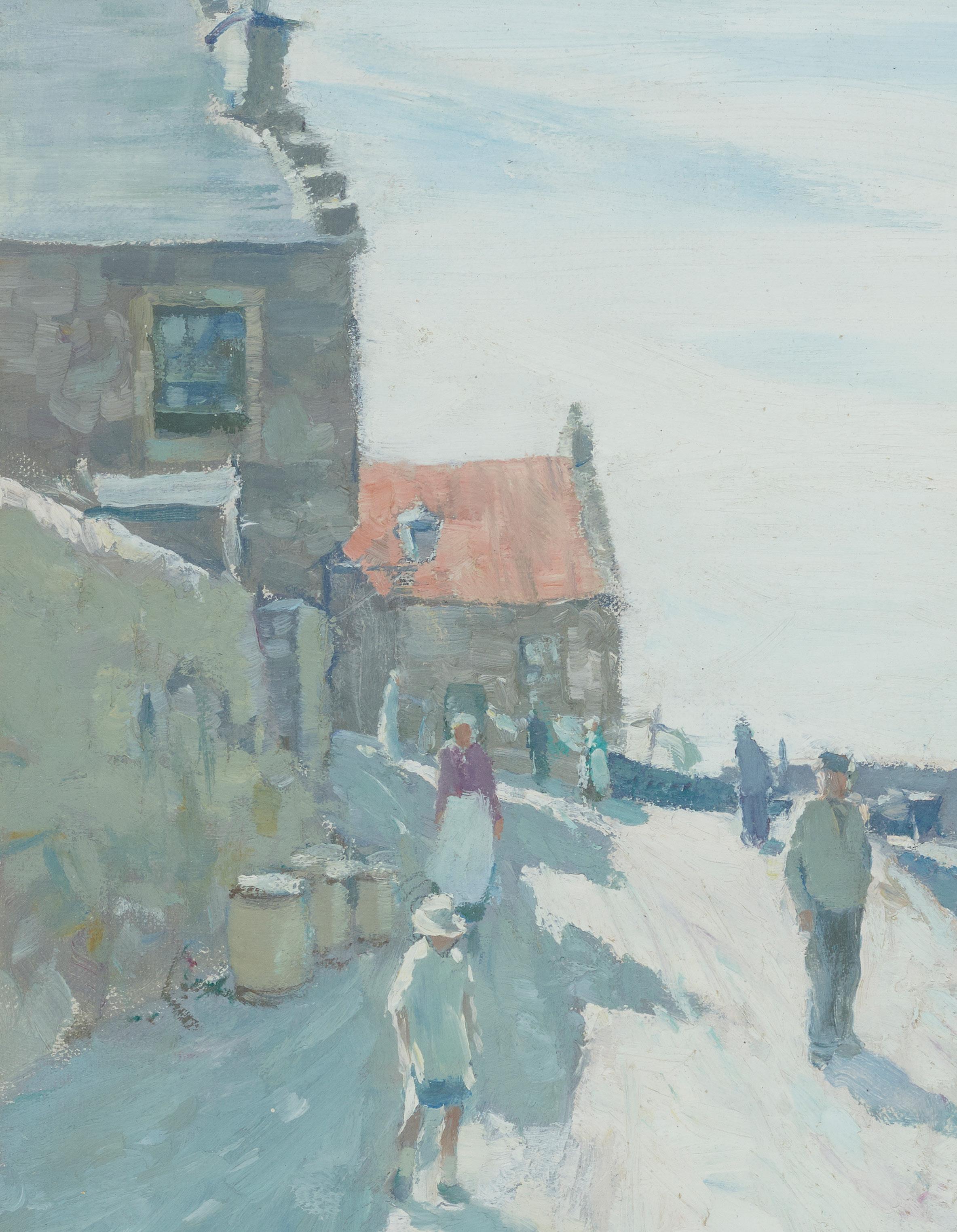
LOTS 1-91 AT 2PM & LOTS 92-180 AT 6PM
Sale Number LT738
VIEWING
Sunday 4th June 12noon - 4pm
Monday 5th June 10am - 5pm
Tuesday 6th June 10am - 5pm
Front Cover Lot 148
Inside Front Cover Lot 82 [detail]
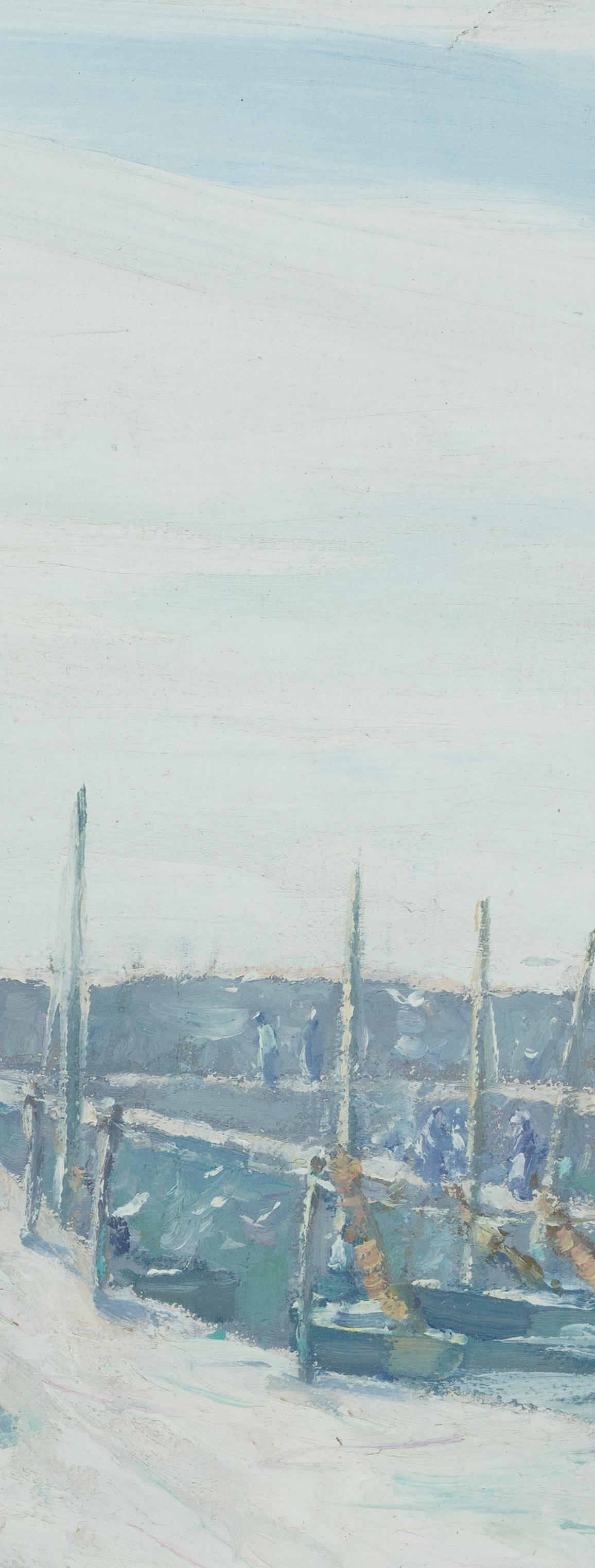
Lyon & Turnbull 33 Broughton Place EDINBURGH EH1 3RR CONTACT EDINBURGH +44 (0) 131 557 8844 LONDON +44 (0) 207 930 9115 info@lyonandturnbull.com
SCULPTURE
08 JUNE 2023
Wednesday 7th June 10am - 5pm Day of sale from 10am
SCOTTISH PAINTINGS &
THURSDAY
BUYER'S GUIDE
This sale is subject to our Standard Conditions of Sale (available at the back of every catalogue and on our website).
If you have not bought at auction before we will be delighted to help you.
BUYER’S PREMIUM
The buyer shall pay the hammer price together with a premium, at the following rate, thereon:
26% up to £20,000
25% from £20,001 to £500,000 20% thereafter.
VAT will be charged on the premium at the rate imposed by law (see our Conditions of Sale at the back of this catalogue).
ADDITIONAL VAT
† VAT at the standard rate payable on the hammer price
‡ Reduced rate of 5% import VAT payable on the hammer price
Ω Standard rate of import VAT on the hammer price
Lots affixed with ‡ or [Ω] symbols may be subject to further regulations upon export /import, please see Conditions of Sale for Buyers Section D.2.
No VAT is payable on the hammer price or premium for books bought at auction.
DROIT DE SUITE
§ indicates works which may be subject to the Droit de Suite or Artist’s Resale Right, a royalty payment for all qualifying works of art. Under new legislation which came into effect on 1st January 2012, this applies to living artists and artists who have died in the last 70 years. This royalty will be charged to the buyer on the hammer price and in addition to the buyer’s premium. It will not apply to works where the hammer price is less than €1,000 (euros). The charge for works of art sold at and above €1,000 (euros) and below €50,000 (euros) is 4%. For items selling above €50,000 (euros), charges are calculated on a sliding scale. More information on Droit de Suite is available at www.dacs.org.uk
REGISTRATION
All potential buyers must register prior to placing a bid. Registration information may be submitted in person at our registration desk, by email, or on our website. Please note that first-time bidders, and those returning after an extended period, will be asked to supply the following documents in order to facilitate registration:
1 – Government issued photo ID (Passport/Driving licence)
2 – Proof of address (utility bill/bank statement).
We may, at our option, also ask you to provide a bank reference and/ or deposit. (Particularly for bidding on lots marked by the high value lot symbol ) By registering for the sale, the buyer acknowledges that he or she has read, understood and accepted our Conditions of Sale (available at the back of every catalogue and on our website).
BIDDING & PAYMENT
For information on bidding options see our Guide to Bidding & Payment at the back of the catalogue.
REMOVAL OF PURCHASES
Responsibility for packing, shipping and insurance shall be exclusively that of the purchaser. See Collections & Storage section for more info specific to this particular auction.
CATALOGUE DESCRIPTIONS
All item descriptions, dimensions and estimates are provided for guidance only. It is the buyer’s responsibility to inspect all lots prior to bidding to ensure that the condition is to their satisfaction. Our specialists will be happy to prepare condition reports and additional images. These are for guidance only and all lots are sold ‘as found’, as per our Conditions of Sale.
IMPORT/EXPORT
Prospective buyers are advised that several countries prohibit the importation of property containing materials from endangered species, including but not limited to; rhino horn, ivory, coral and tortoiseshell. Accordingly, prospective buyers should familiarise themselves with all relevant customs regulations prior to bidding if they intend to import lots to another country. It is the buyer’s sole responsibility to obtain any relevant export or import licence. The denial of any licence or any delay in obtaining licences shall neither justify the recession of any sale nor any delay in making full payment for the lot.
ENDANGERED SPECIES
Please be aware that lots marked with the symbol Y contain material which may be subject to CITES regulations when exporting outside Great Britain. For more information visit http://www. defra.gov.uk/ahvla-en/imports-exports/ cites
COLLECTION OF PURCHASED LOTS
All collections will be by appointment only (this applies to both carriers and personal collections). To make an appointment call 0131 557 8844 or email info@lyonandturnbull.com.
Please ensure payment has been made prior to collection. This can be done by bank transfer, and debit/credit card online (powered by Opayo) - details will be shown on your invoice.
Please note we are unable to take payments over the phone.
22.3
2
MEET THE SPECIALISTS
At Lyon & Turnbull we want to make buying at auction as easy and enjoyable as possible. Our specialist team are on hand to assist you, whether you are looking for something in particular for your home or collection, require more detailed information about the history or condition of a lot, or just want to find out more about the auction process.
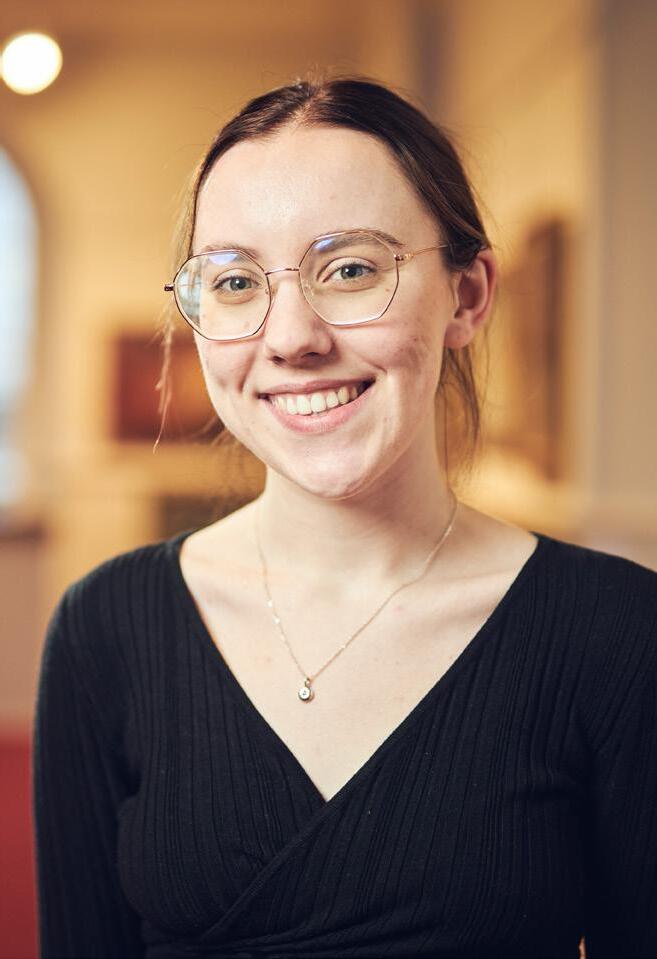



 Chantal de Prez Junior Specialist chantal.deprez@lyonandturnbull.com
Charlotte Cockburn Sale Administrator charlotte.cockburn@lyonandturnbull.com
Alice Strang Senior Specialist alice.strang@lyonandturnbull.com
Carly Shearer Specialist carly.shearer@lyonandturnbull.com
Chantal de Prez Junior Specialist chantal.deprez@lyonandturnbull.com
Charlotte Cockburn Sale Administrator charlotte.cockburn@lyonandturnbull.com
Alice Strang Senior Specialist alice.strang@lyonandturnbull.com
Carly Shearer Specialist carly.shearer@lyonandturnbull.com
3
Nick Curnow Head of Sale nick.curnow@lyonandturnbull.com
1
GEORGE HOUSTON
R.S.A, R.S.W., R.G.I. (SCOTTISH 1869-1947)
FISHING BOATS, NORTH SHORE, IONA
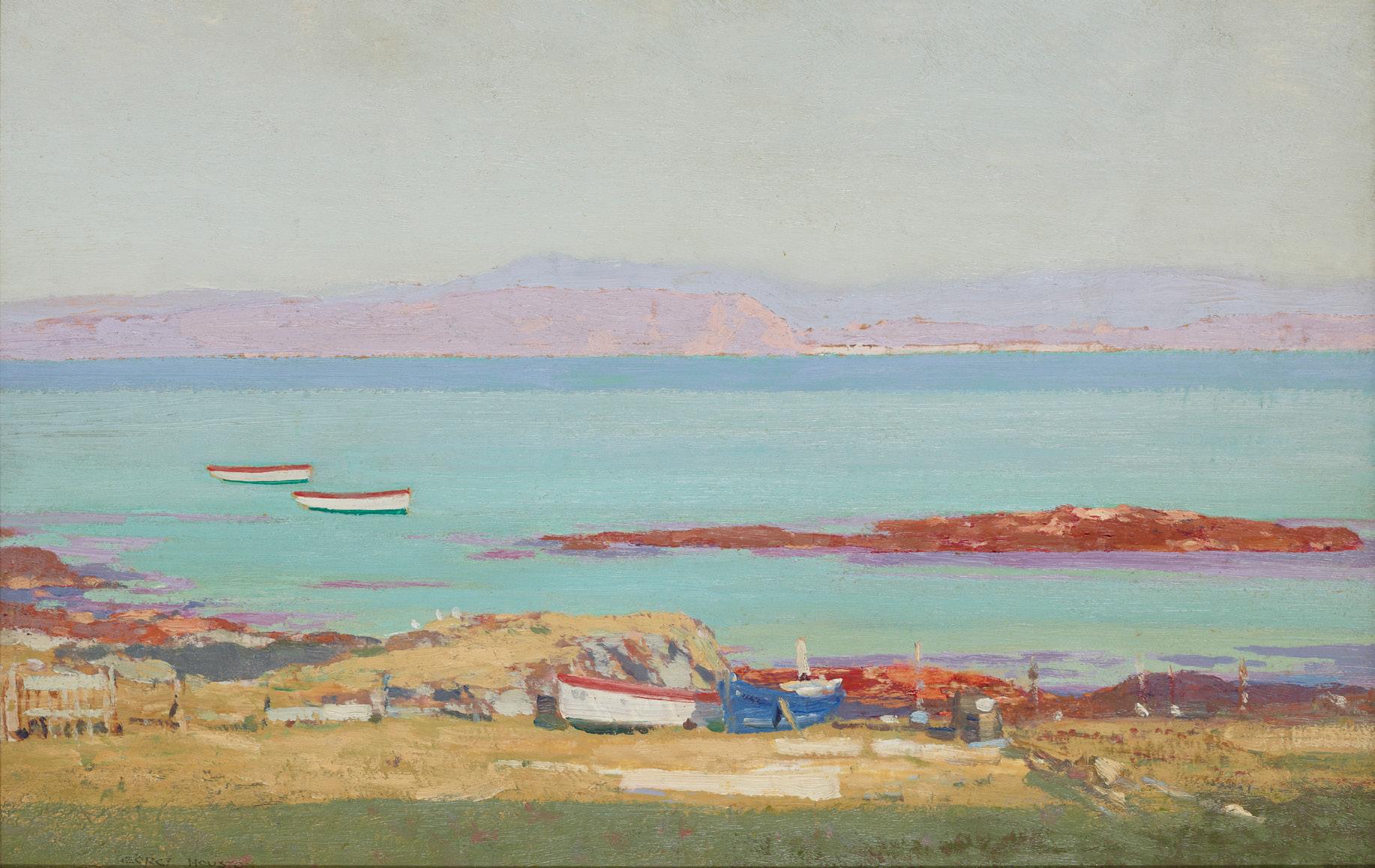
Signed, oil on board
31cm x 51cm (12in x 20in)
£600-800
2
WILLIAM BRADLEY
LAMOND R.B.A. (SCOTTISH 1857-1924) COLLECTING MUSSELS

Signed, oil on canvas
38cm x 46cm (15in x 18in)
£700-1,000
4 Other fees apply in addition to the hammer price: see the ‘Buyer’s Guide’ section on page 2
3 JOHN MCGHIE (SCOTTISH 1867-1952) ON THE HARBOUR QUAY

Signed, oil on canvas
30.5cm x 46cm (12in x 18in) £1,000-1,500
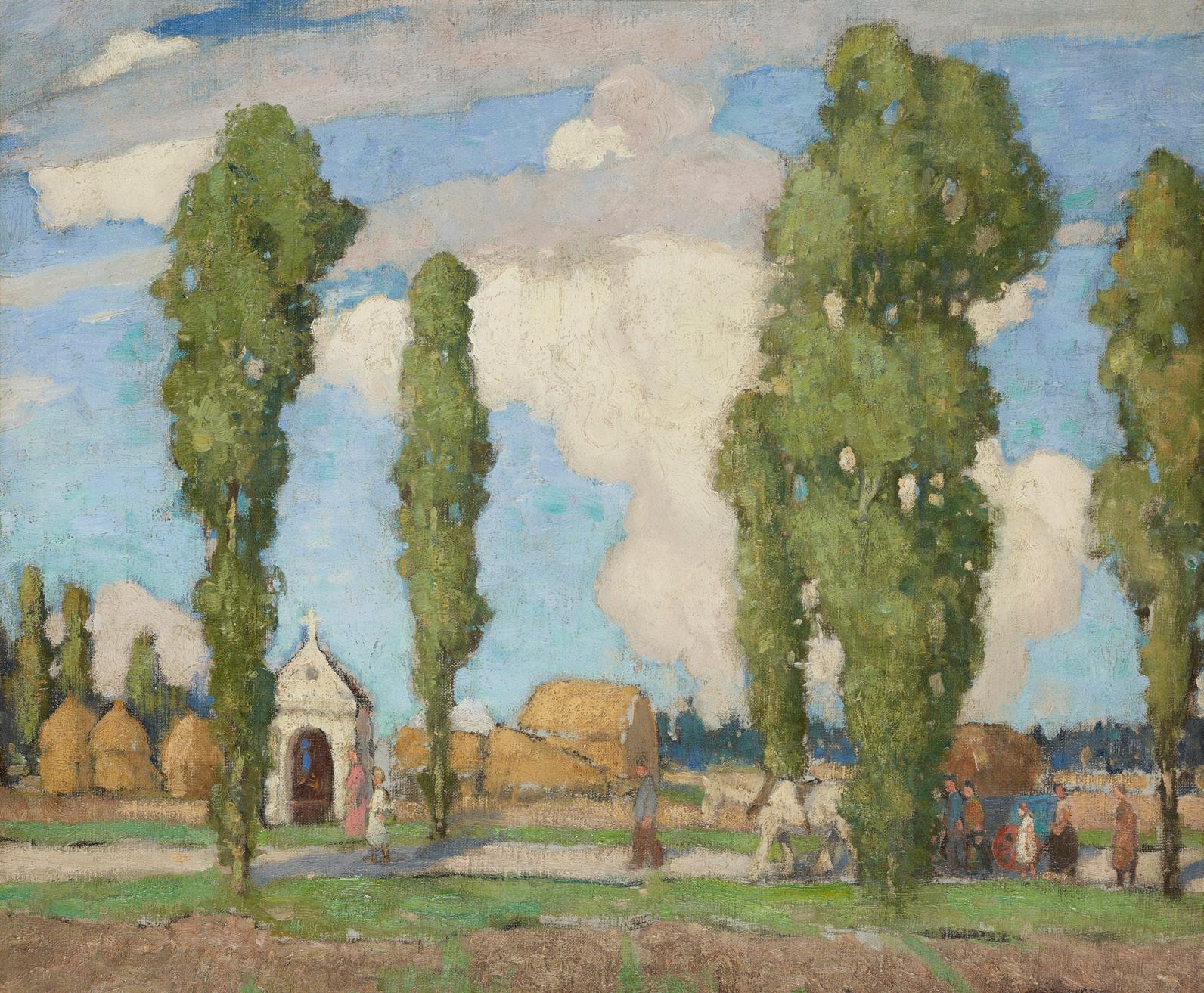
4 JAMES WRIGHT R.S.W. (SCOTTISH 1885-1947) RETURN FROM THE FIELDS
Signed, oil on board
54cm x 63.5cm (21.25in x 25in) £800-1,200
5
JOHN CAMPBELL MITCHELL
R.S.A (SCOTTISH 1862-1922)
SALMON FISHING OFF COCKERMOUTH
Signed and dated 1919, gouache

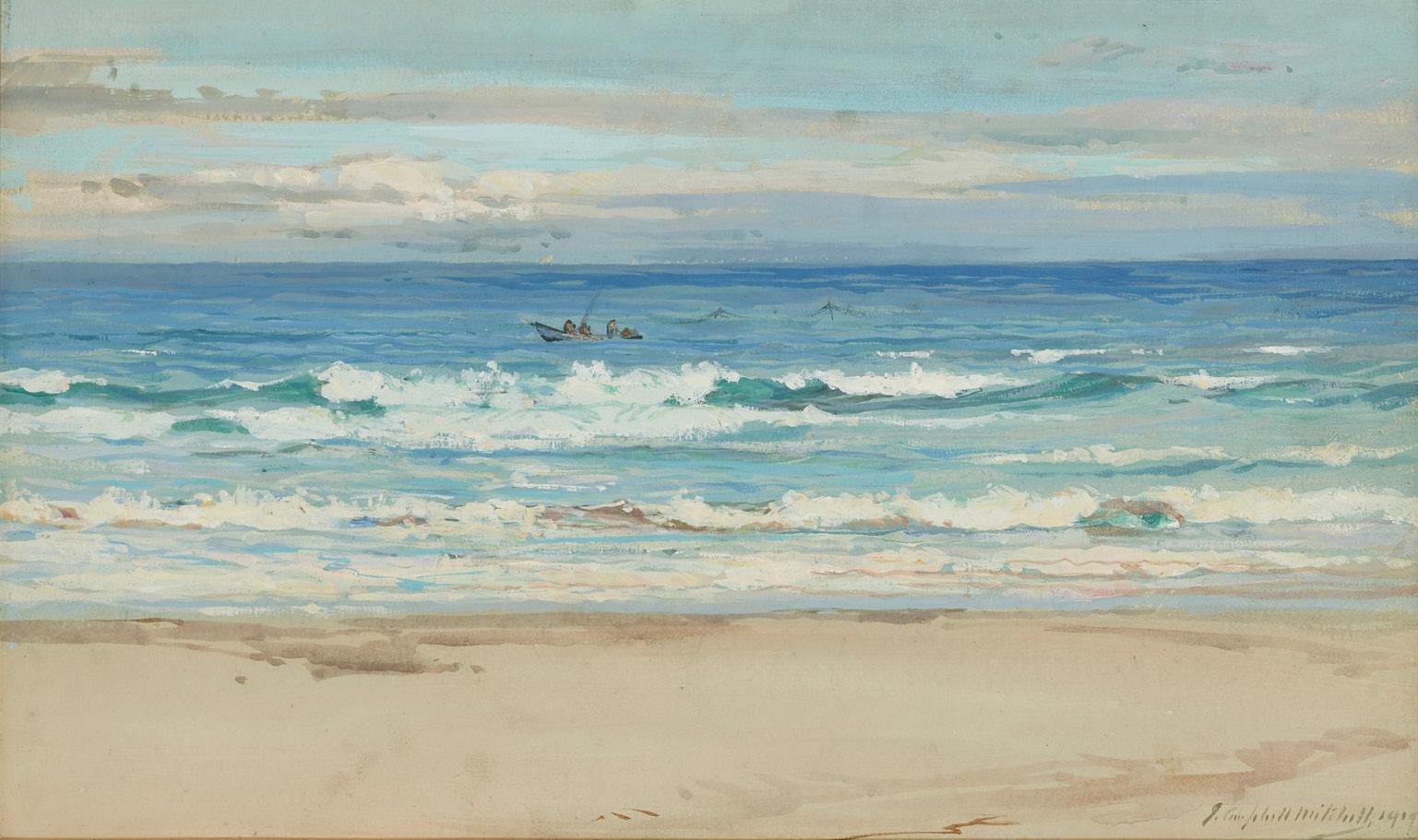
30.5cm x 51cm (12in x 20in)
£600-800
6
GEORGE HOUSTON
R.S.A, R.S.W., R.G.I. (SCOTTISH 1869-1947)
HEAD OF LOCH FYNE
Signed, oil on canvas
46cm x 61cm (18in x 24in)
£1,000-1,500
5
6 Other fees apply in addition to the hammer price: see the ‘Buyer’s Guide’ section on page 2
7 ANDREW BLACK R.S.W. (SCOTTISH 1850-1916) FROM THE NORTH SEA
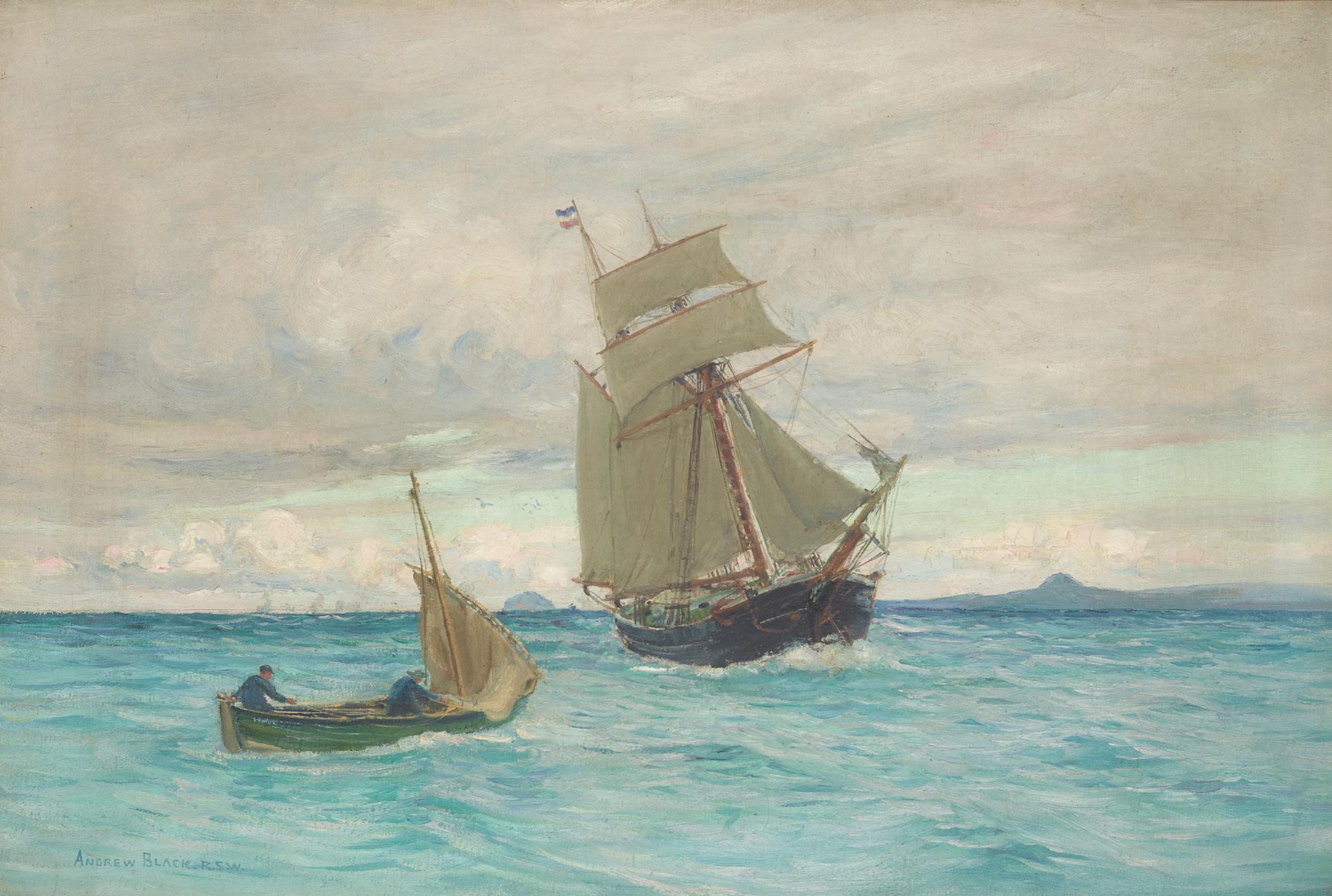
Signed, oil on canvas 61cm x 91cm (24in x 36in)
Exhibited: Kelvingrove Park, Glasgow, Scottish Exhibition of Natural History, Art and Industry, 2 May-4 November, 1911 £800-1,200
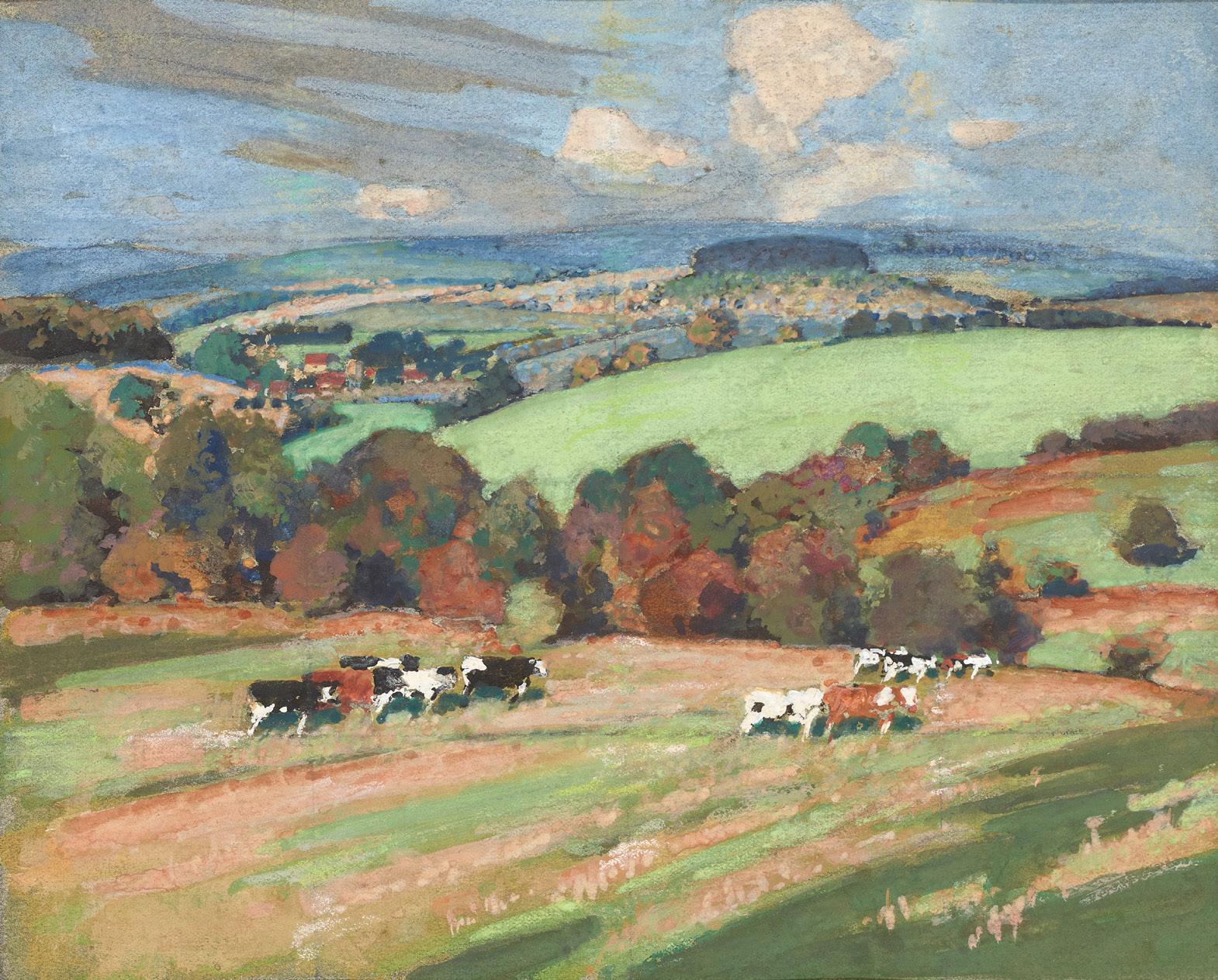
8 GEORGE HENRY R.A., R.S.A., R.S.W. (SCOTTISH 1858-1943) SUSSEX LANDSCAPE
With the Artist’s Trustees stamp verso, watercolour 20cm x 24.5cm (8in x 9.75in)
Exhibited: George Henry Memorial Exhibition, 1944 £1,500-2,000
7
9
ROBERT MCGOWN COVENTRY
A.R.S.A., R.S.A. (SCOTTISH 1855-1914)
MENDING THE CREEL
Signed, oil on canvas
30.5cm x 51cm (12in x 20in)
£800-1,200
MARGARET ISOBEL WRIGHT (SCOTTISH 1884-1957)
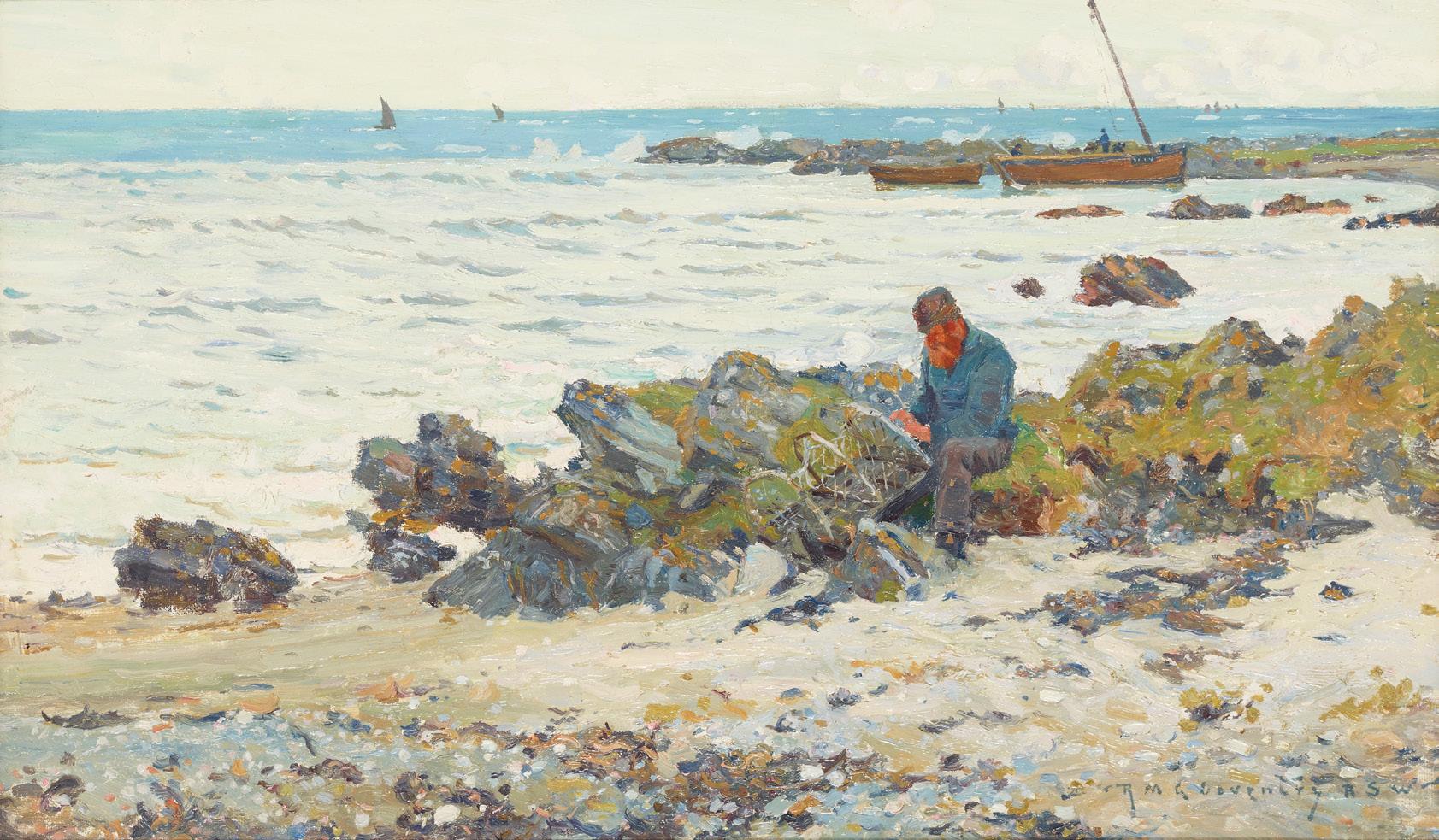
THE GOOSE GIRL
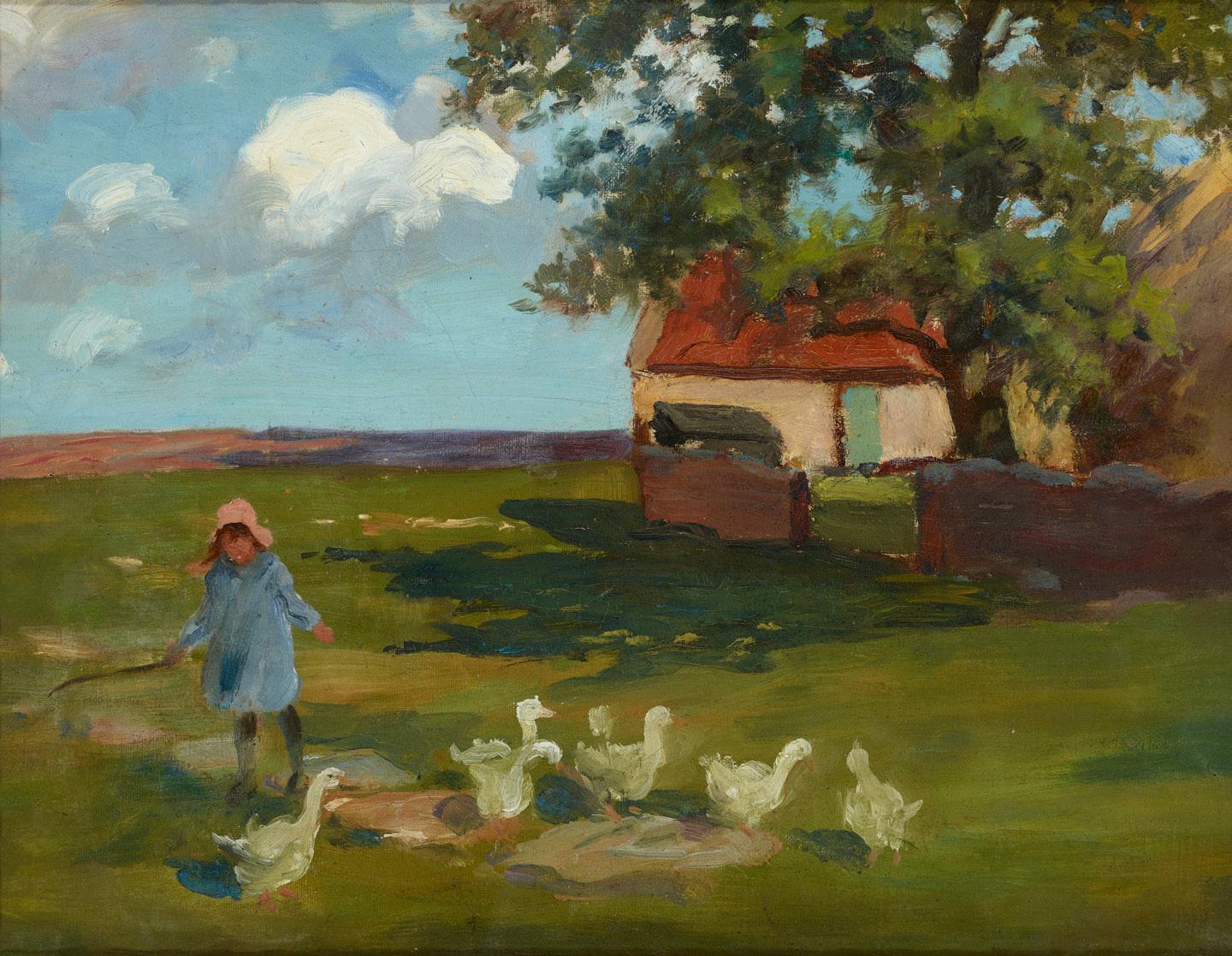
Inscribed verso, oil on canvas laid down on board
36cm x 46cm (14in x 18in)
£600-800
10 §
8
11
SAM BOUGH R.S.A, R.S.W. (SCOTTISH 1822-1878)
PEAT GATHERERS
Signed and dated 1867, watercolour heightened with gum arabic 57cm x 90cm (22.5in x 35.5in)
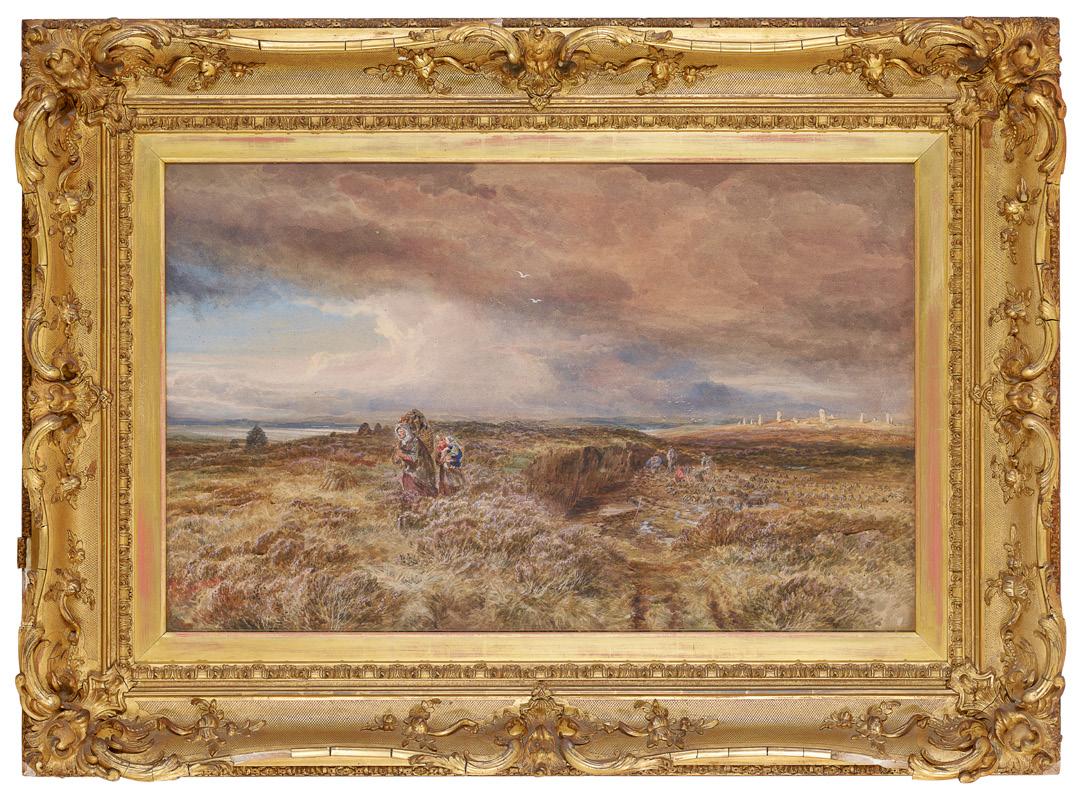
£3,000-5,000

9 Other fees apply in addition to the hammer price: see the ‘Buyer’s Guide’ section on page 2
CHARLES MARTIN HARDIE R.S.A. (SCOTTISH 1858-1916)
THE BLACK MANTILLA
Signed with initials and dated ‘91, oil on board
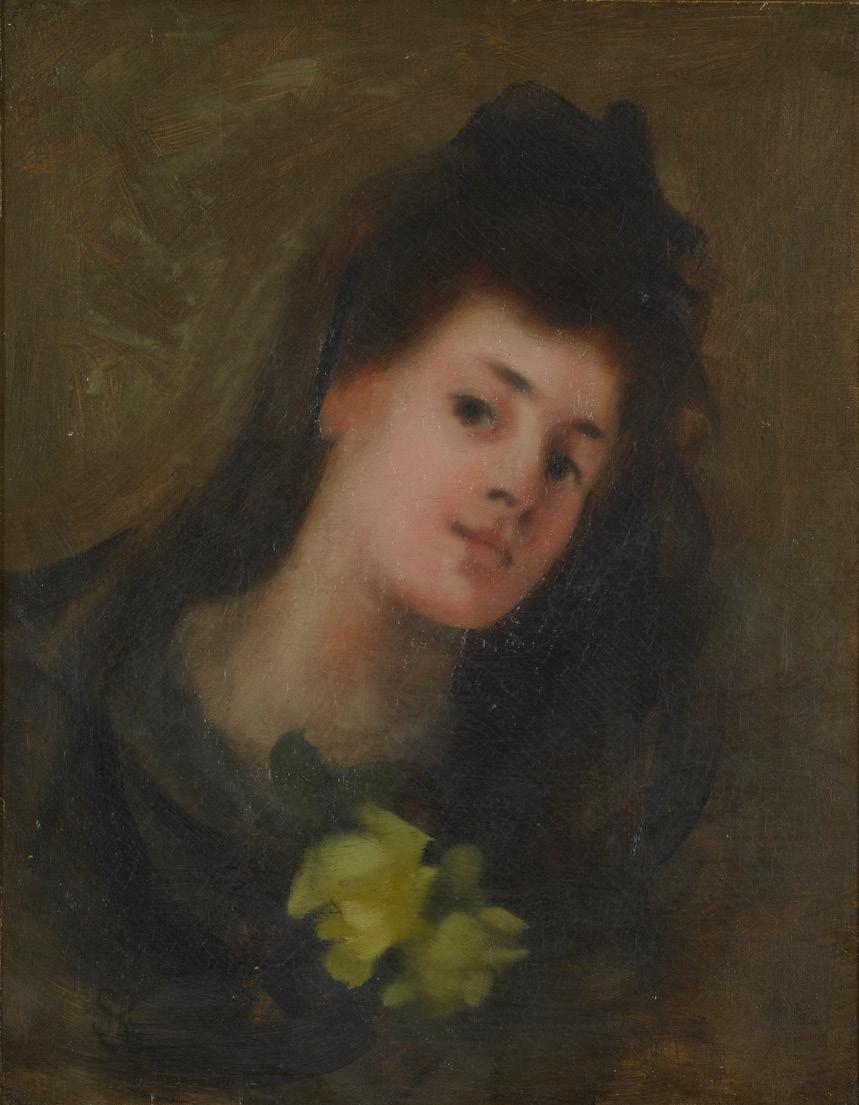
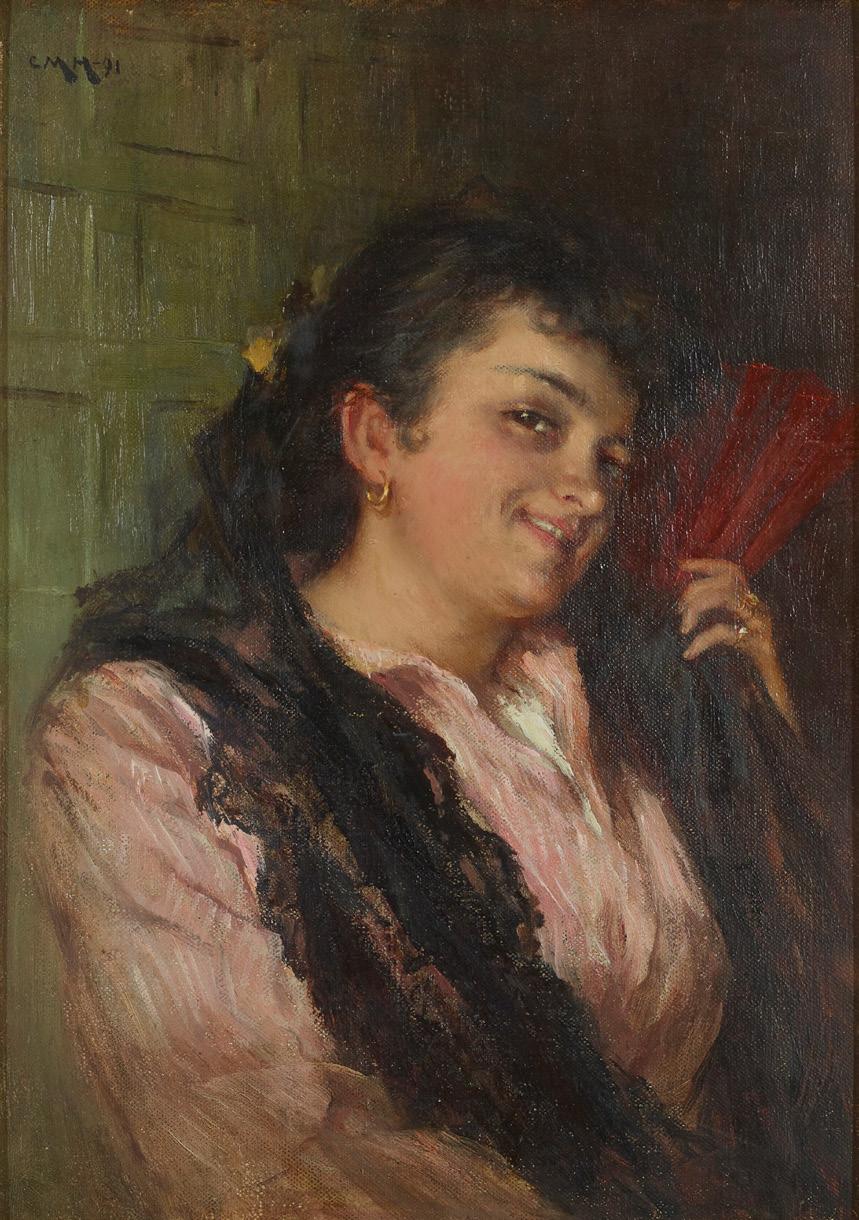
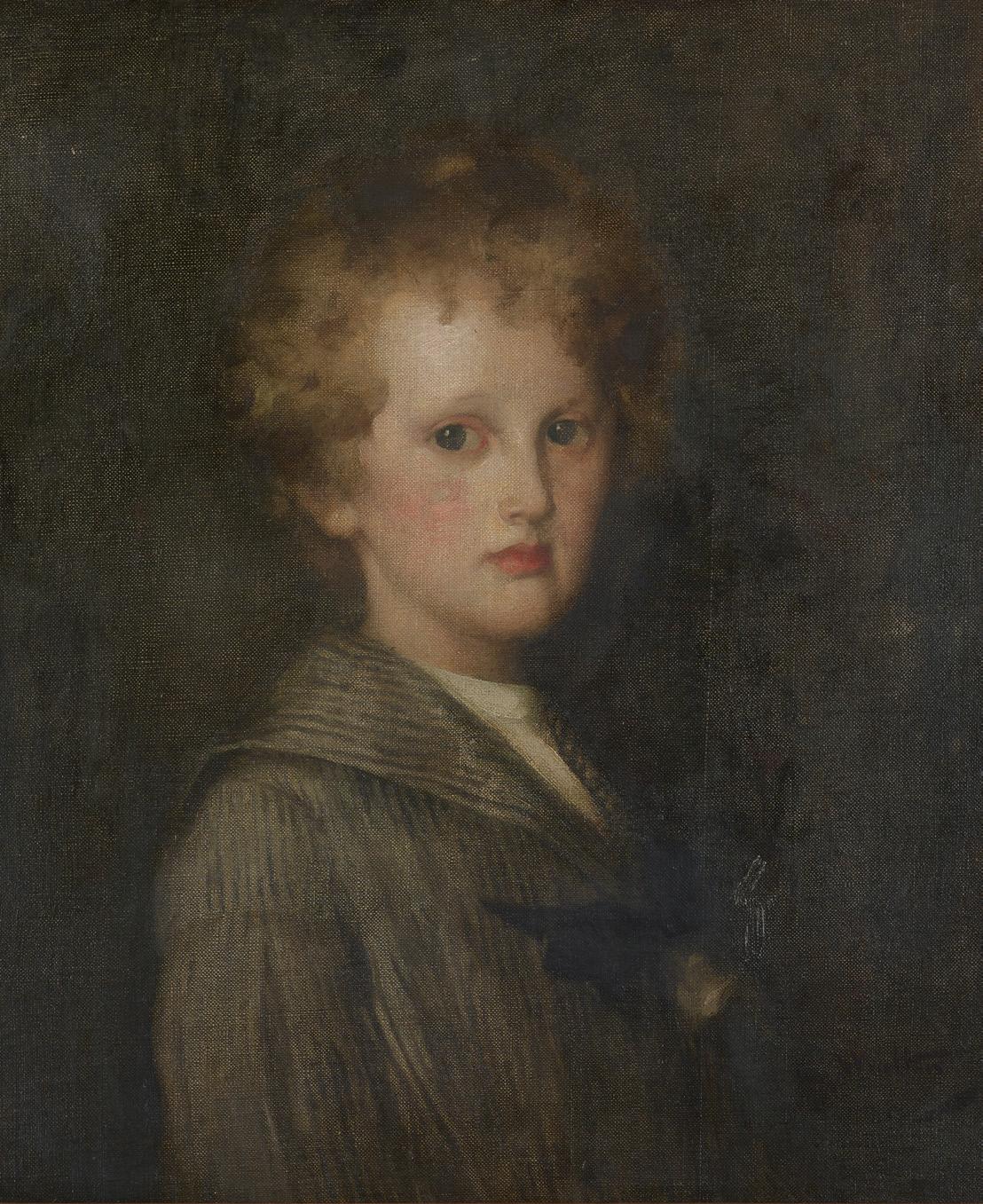
36cm x 25.5cm (14in x 10in)
£600-800
13
STUART PARK (SCOTTISH 1862-1933)
THE SPANISH GIRL
Signed with the monogram, oil on canvas
38cm x 30.5cm (15in x 12in)
£600-800
14
EDWARD ARTHUR WALTON
R.S.A., R.S.W., R.W.S. (SCOTTISH 1860-1922)
PORTRAIT STUDY
Signed, oil on canvas
51cm x 43.5cm (20in x 17in)
£1,500-2,000
15
JOHN MCGHIE (SCOTTISH 1867-1952)
THE RED NECK-TIE
Signed, oil on canvas
51cm x 41cm (20in x 16in)
Note: This is believed to be a portrait of the artist’s wife.
£1,500-2,000
12
10
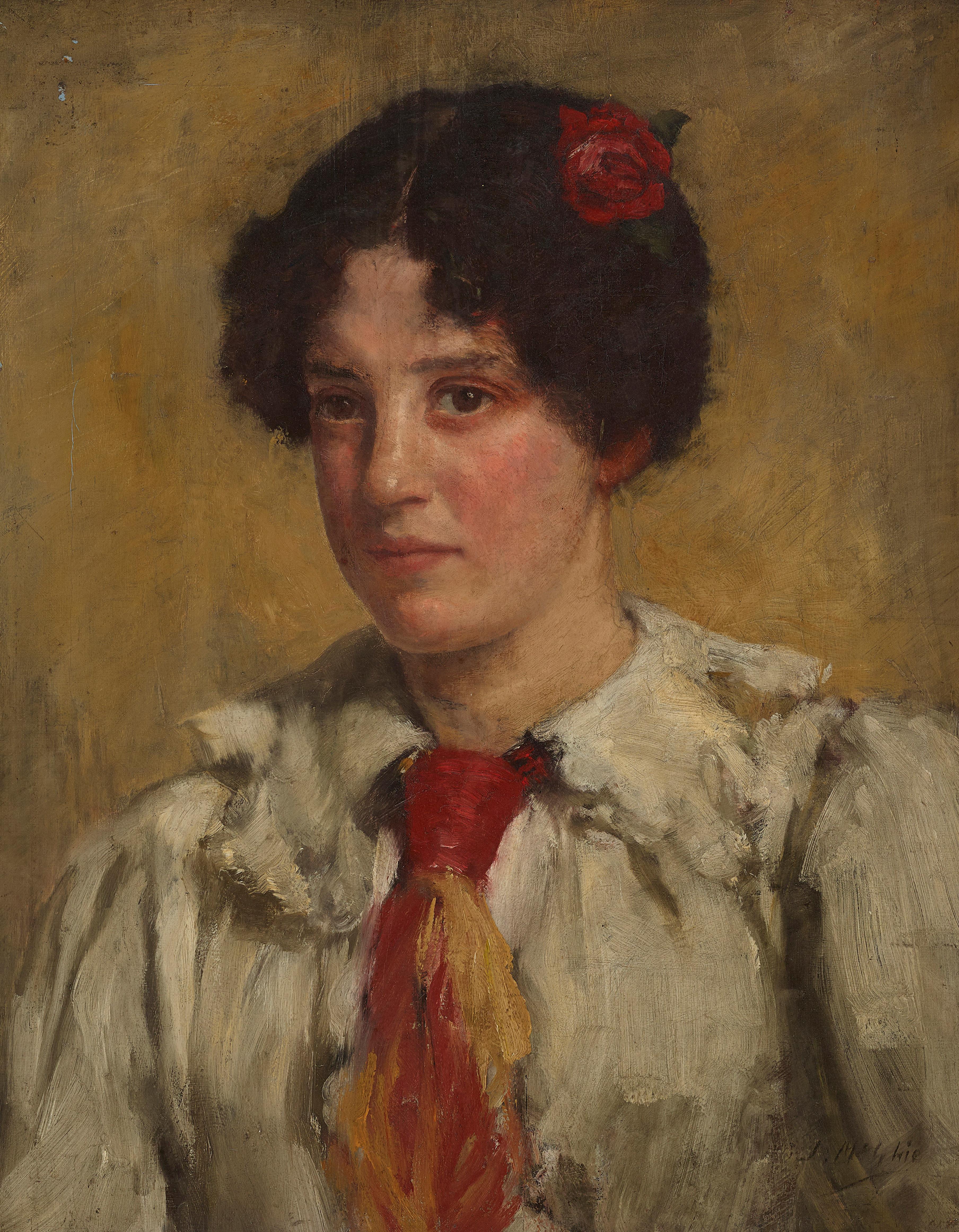
16 JAMES CAMPBELL NOBLE R.S.A. (SCOTTISH 1846-1913)
A RIVER LANDSCAPE WITH WINDMILLS AT SUNSET
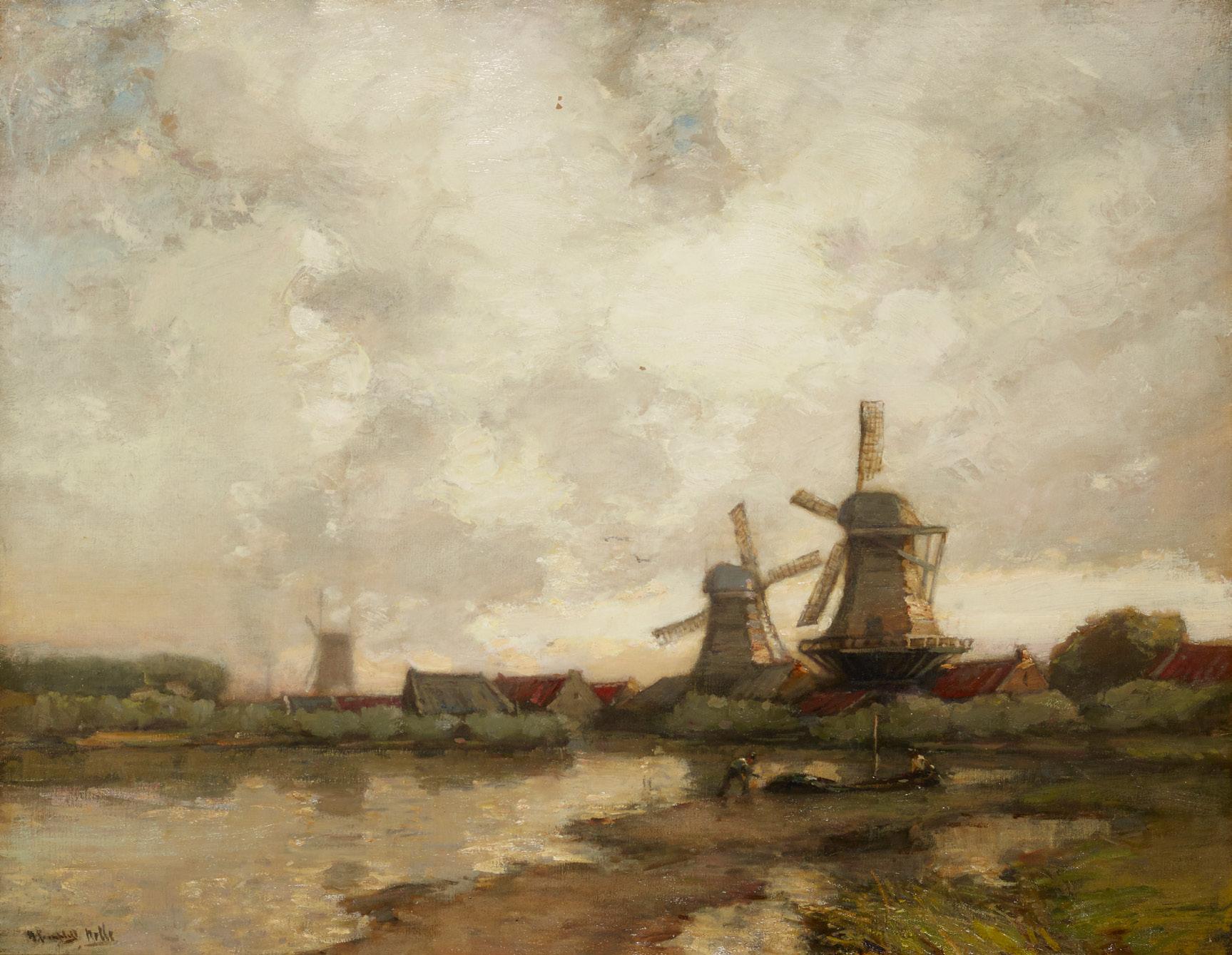
Signed, oil on canvas
71cm x 91cm (28in x 36in)
£800-1,200
17
WILLIAM MOUNCEY (SCOTTISH 1852-1901) ON THE DEE
Signed, oil on canvas
51cm x 61cm (20in x 24in)
£800-1,200
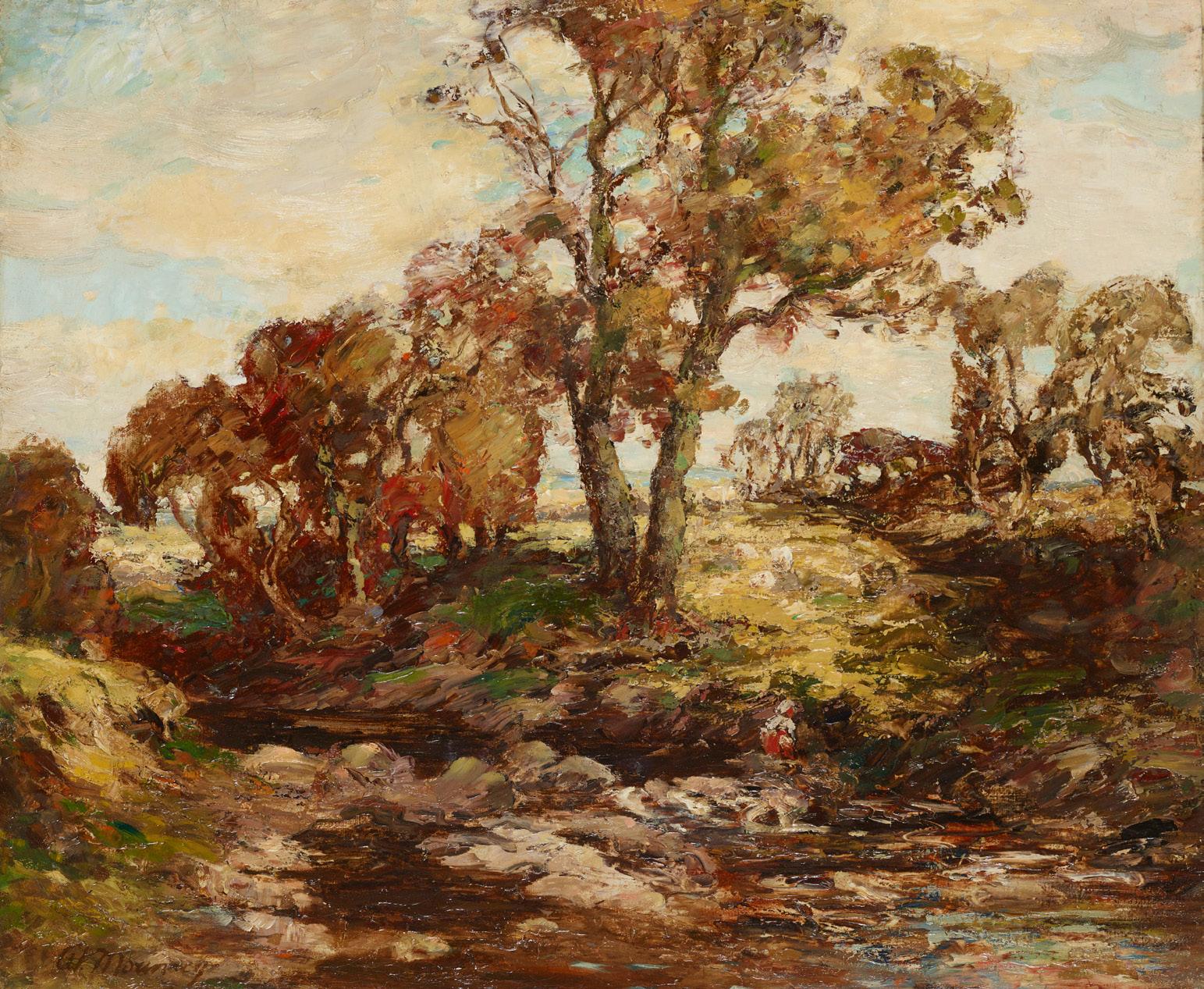
12
18
JAMES HALL CRANSTOUN (SCOTTISH 1821-1907)
A WOODED LANDSCAPE WITH DISTANT COUNTRY HOUSE
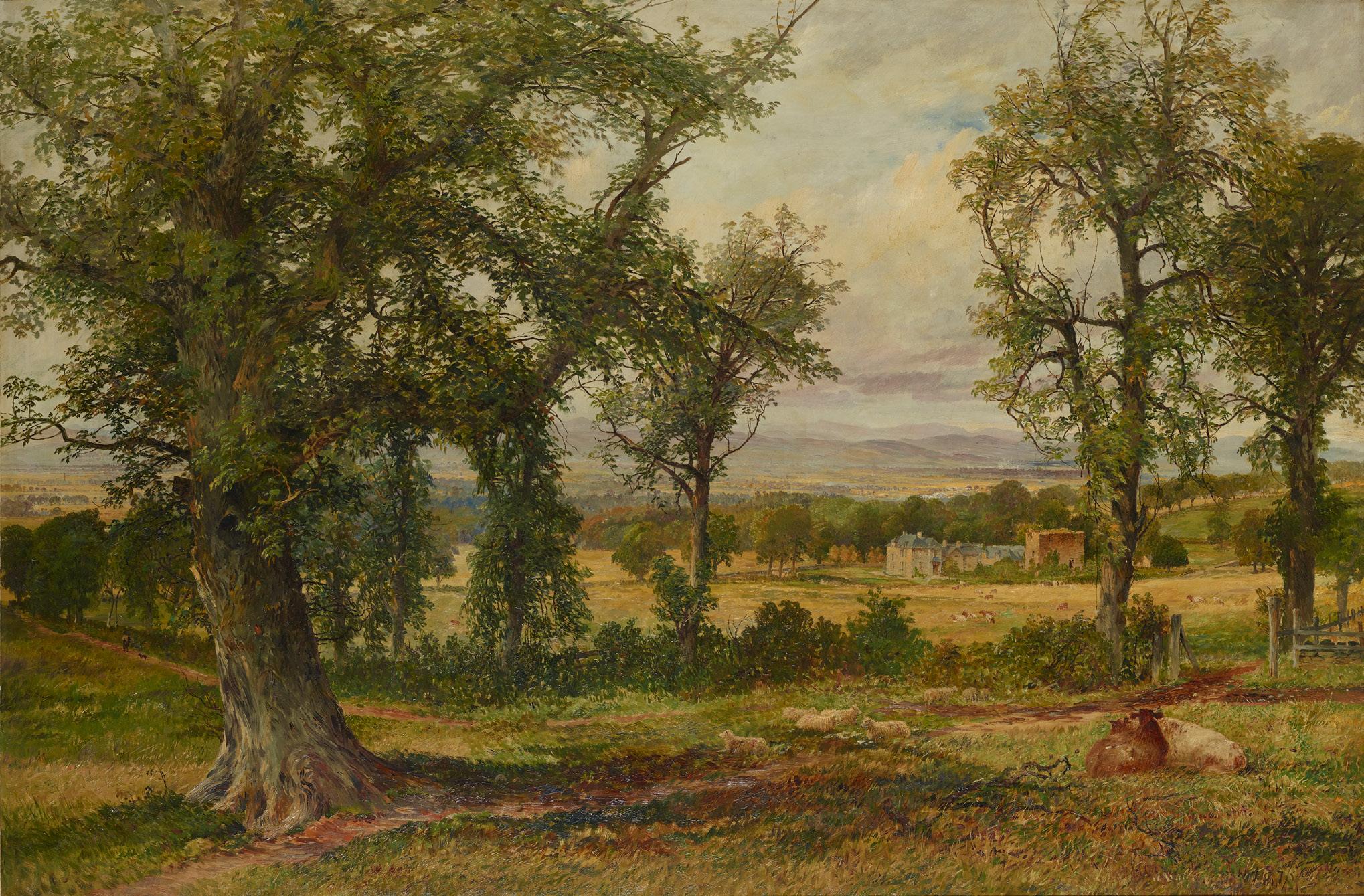
Signed with initials and dated 1870, oil on canvas
80cm x 120cm (31.5in x 47.25in)
£800-1,200
19
JAMES CASSIE R.S.A., R.S.W. (SCOTTISH 1819-1879)
MUSSEL GATHERERS AT SUNSET
Signed with the monogram and dated 1877, oil on canvas
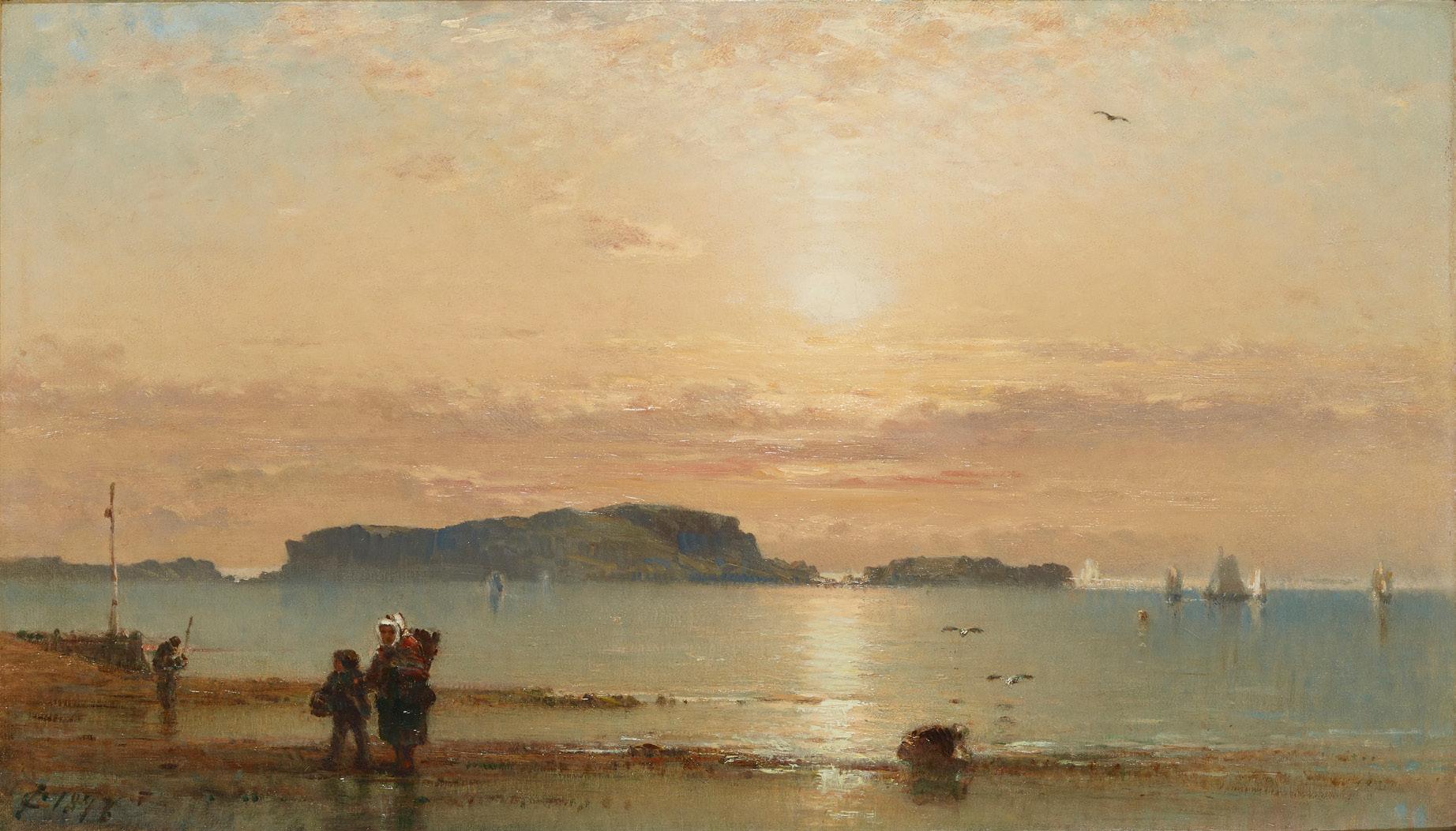
30.5cm x 53cm (12in x 21in)
£1,000-1,500
13 Other fees apply in addition to the hammer price: see the ‘Buyer’s Guide’ section on page 2
20
JOSEPH HENDERSON R.S.W. (SCOTTISH 1832-1908)
BATHING OFF THE AYRSHIRE COAST

Signed, oil on canvas
46cm x 76cm (18in x 30in)
£1,500-2,000
ROBERT GEMMELL HUTCHISON R.B.A., R.O.I., R.S.A., R.S.W. (SCOTTISH 1860-1936)
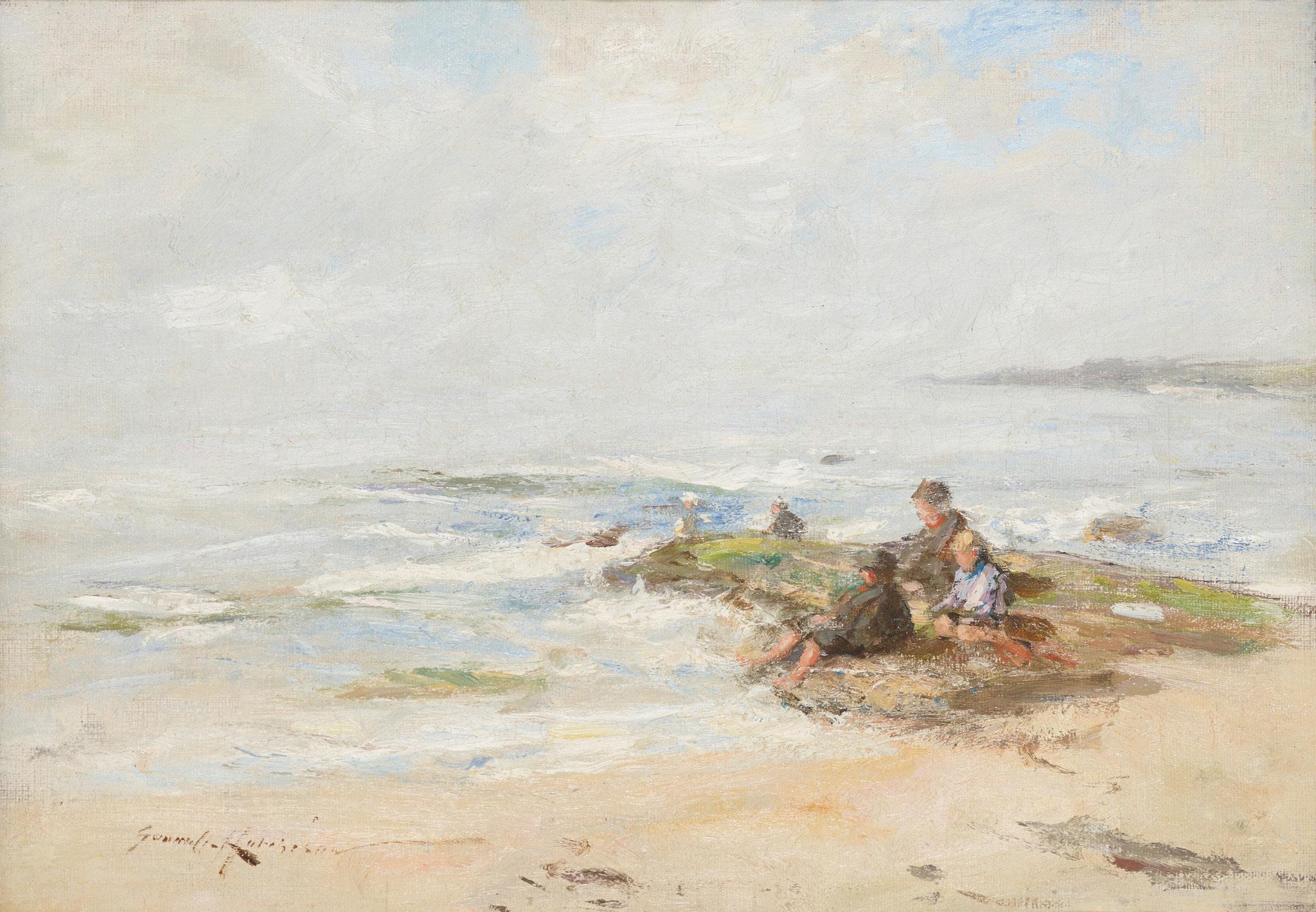
WATCHING THE WAVES
Signed, oil on canvas
25.5cm x 36cm (10in x 14in)
£1,500-2,000
21
14
22
WILLIAM MCTAGGART R.S.A., R.S.W. (SCOTTISH 1835-1910)
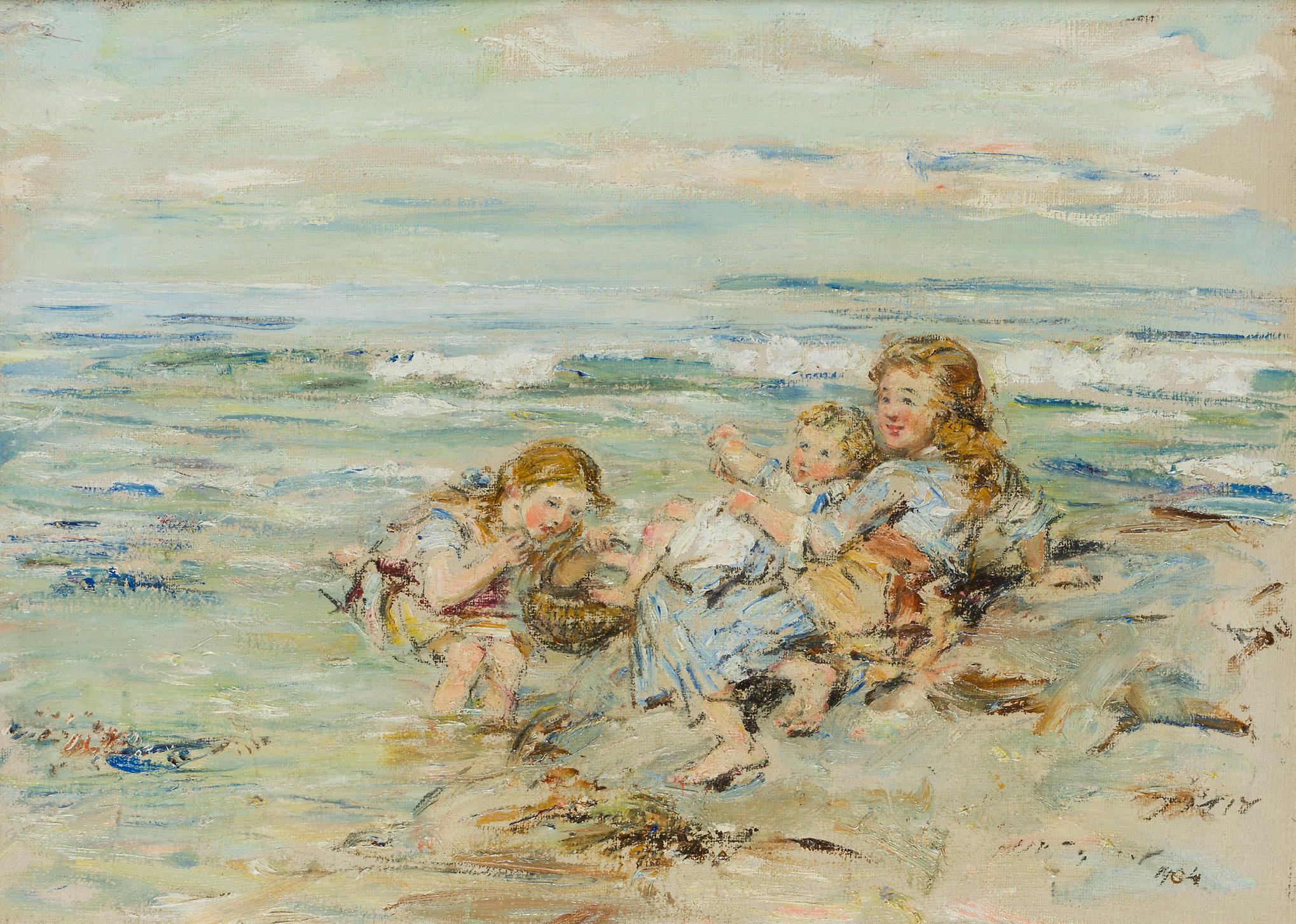
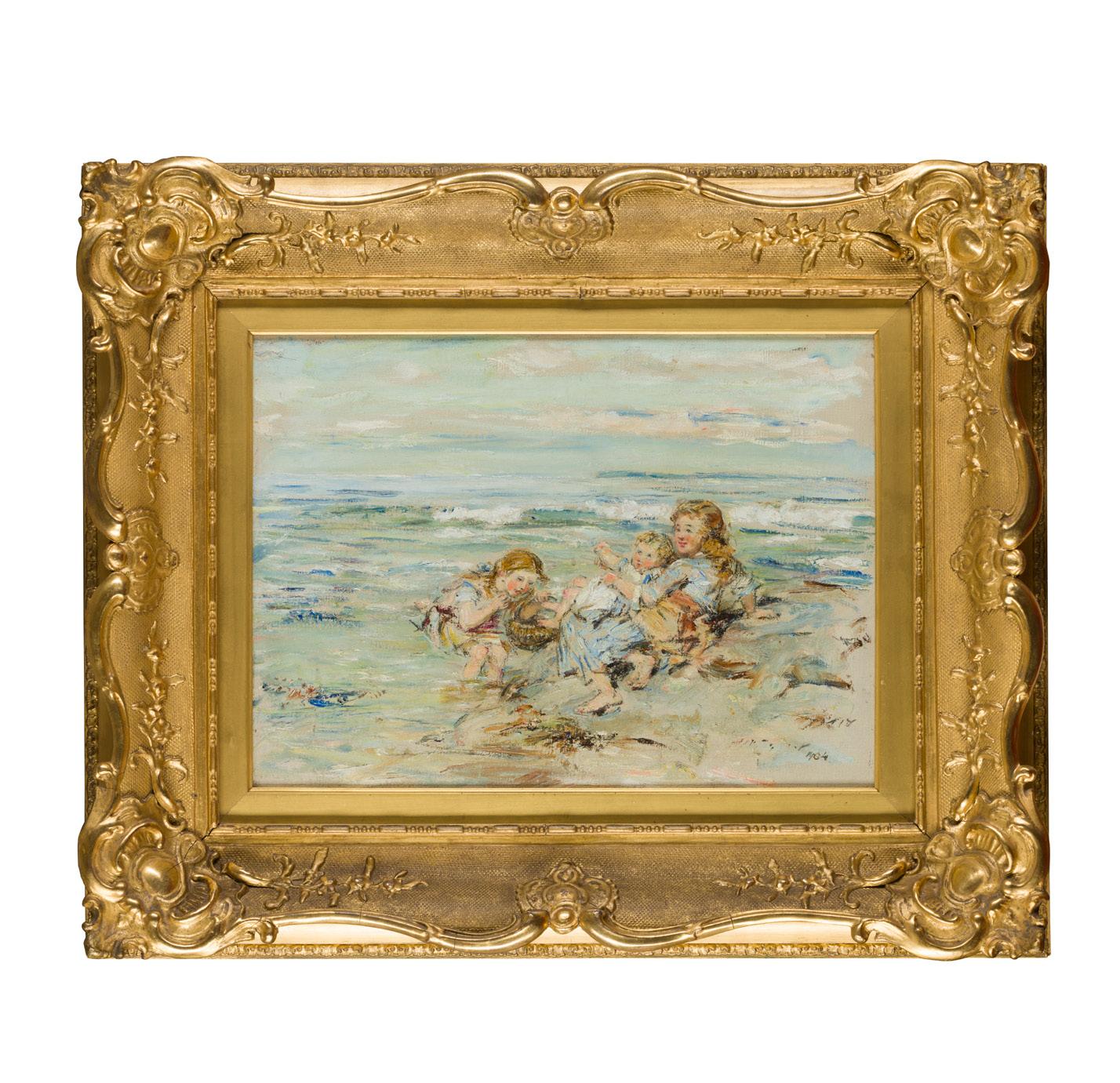
IDLE MOMENTS
Signed and dated 1904, oil on canvas 34cm x 47cm (13.5in x 18.5in)
Exhibited: Pretoria Art Museum, Pretoria
Note: A painting of this title, size and date is listed in J. L. Caw, William McTaggart RSA: A Biography and an Appreciation, James Maclehose and Sons, Glasgow 1917, p.276.
£3,000-5,000
15
23 §
JAMES MCINTOSH PATRICK
R.S.A., R.O.I., A.R.E., L.L.D. (SCOTTISH 1907-1998)
AT ASHLEY, HALIBURTON
Signed, signed, inscribed and dated 1986 in the artist’s hand on label verso, watercolour
53cm x 74cm (21in x 29in)
£1,500-2,000
24 §
JAMES MCINTOSH PATRICK

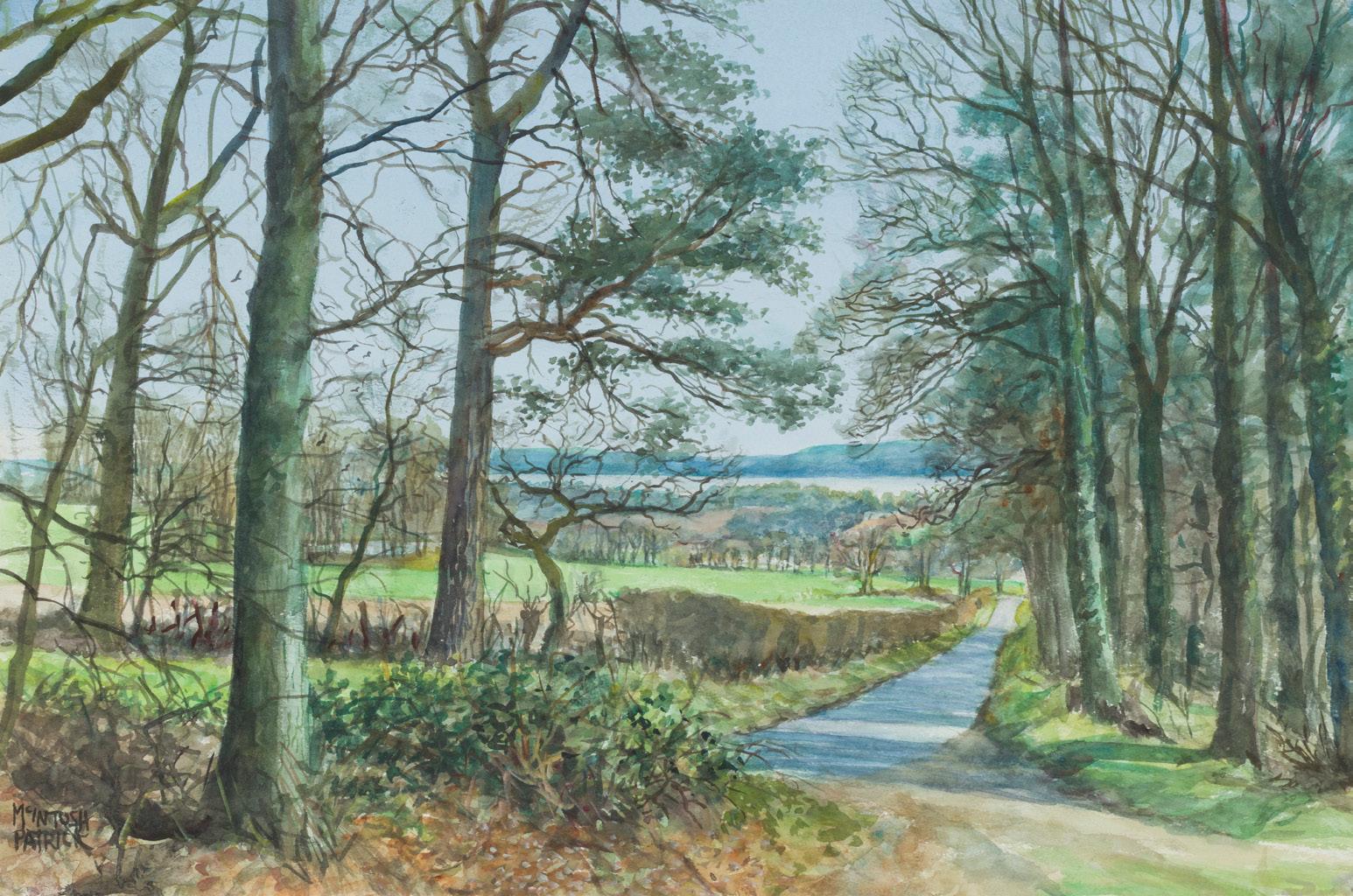
R.S.A., R.O.I., A.R.E., L.L.D. (SCOTTISH 1907-1998)
THE CARSE OF GOWRIE FROM ABOVE MILLHILL
Signed, signed, inscribed and dated 1991 on a letterhead verso, watercolour
38cm x 56cm (15in x 22in)
£1,500-2,000
16 Other fees apply in addition to the hammer price: see the ‘Buyer’s Guide’ section on page 2
25 §
WILLIAM MILLER FRAZER
R.S.A. (SCOTTISH 1864-1961)
A SUMMER’S DAY ON THE FARM

Signed, oil on canvas
51cm x 61cm (20in x 24in)
£1,000-1,500

17 Other fees apply in addition to the hammer price: see the ‘Buyer’s Guide’ section on page 2
27
JOHN MILNE DONALD (SCOTTISH 1819-1866) ON THE CLYDE, BOTHWELL CHURCH IN THE DISTANCE
Oil on canvas 48cm x 75cm (18.75in x 29.5in)
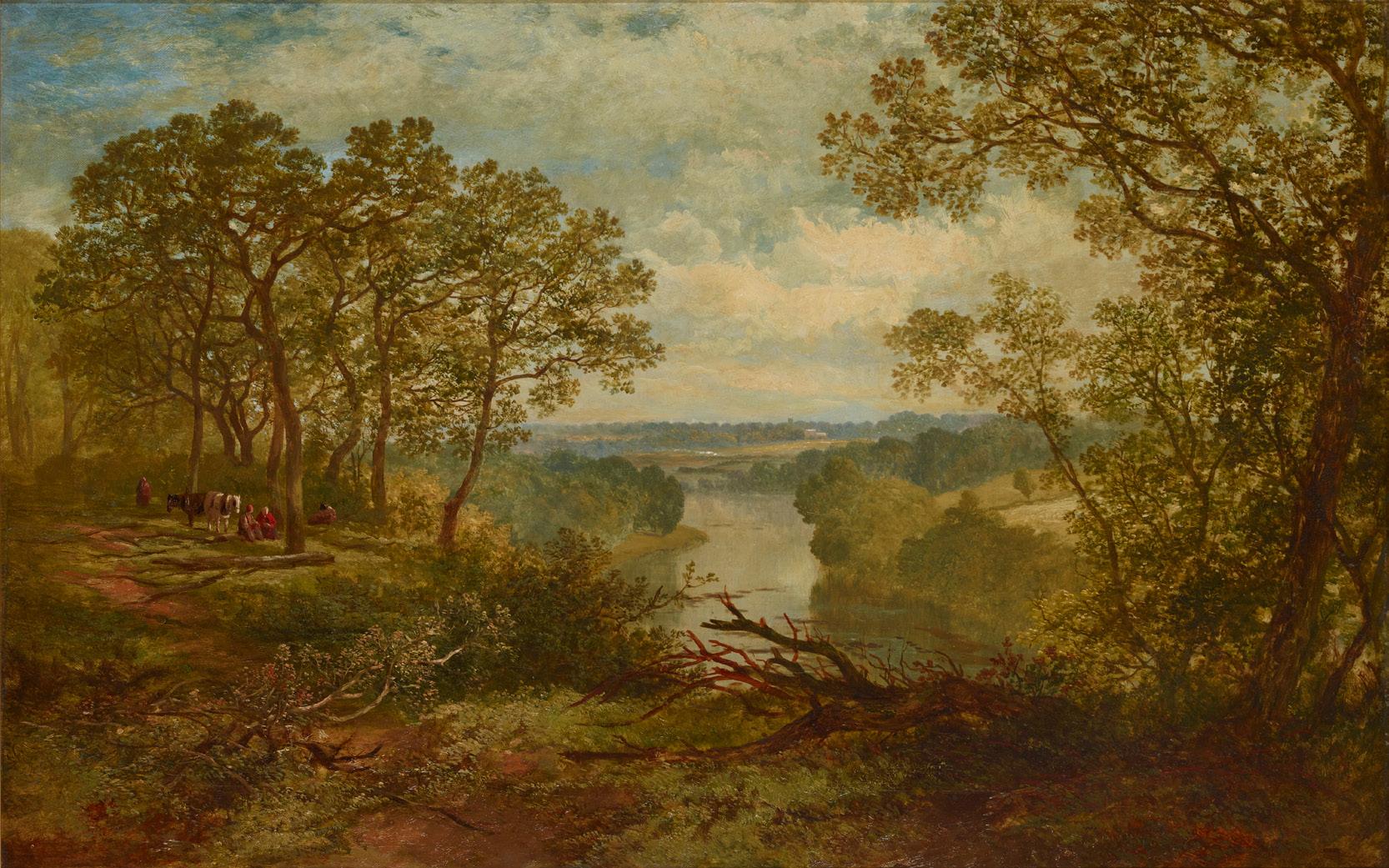
£1,000-1,500
26
CHARLES STUART
F.S.A. (SCOTTISH 1838-1907)
THE HEART OF THE DEER FOREST
Signed, inscribed with title on stretcher verso, oil on canvas 75cm x 126cm (30in x 50in)
£1,000-1,500
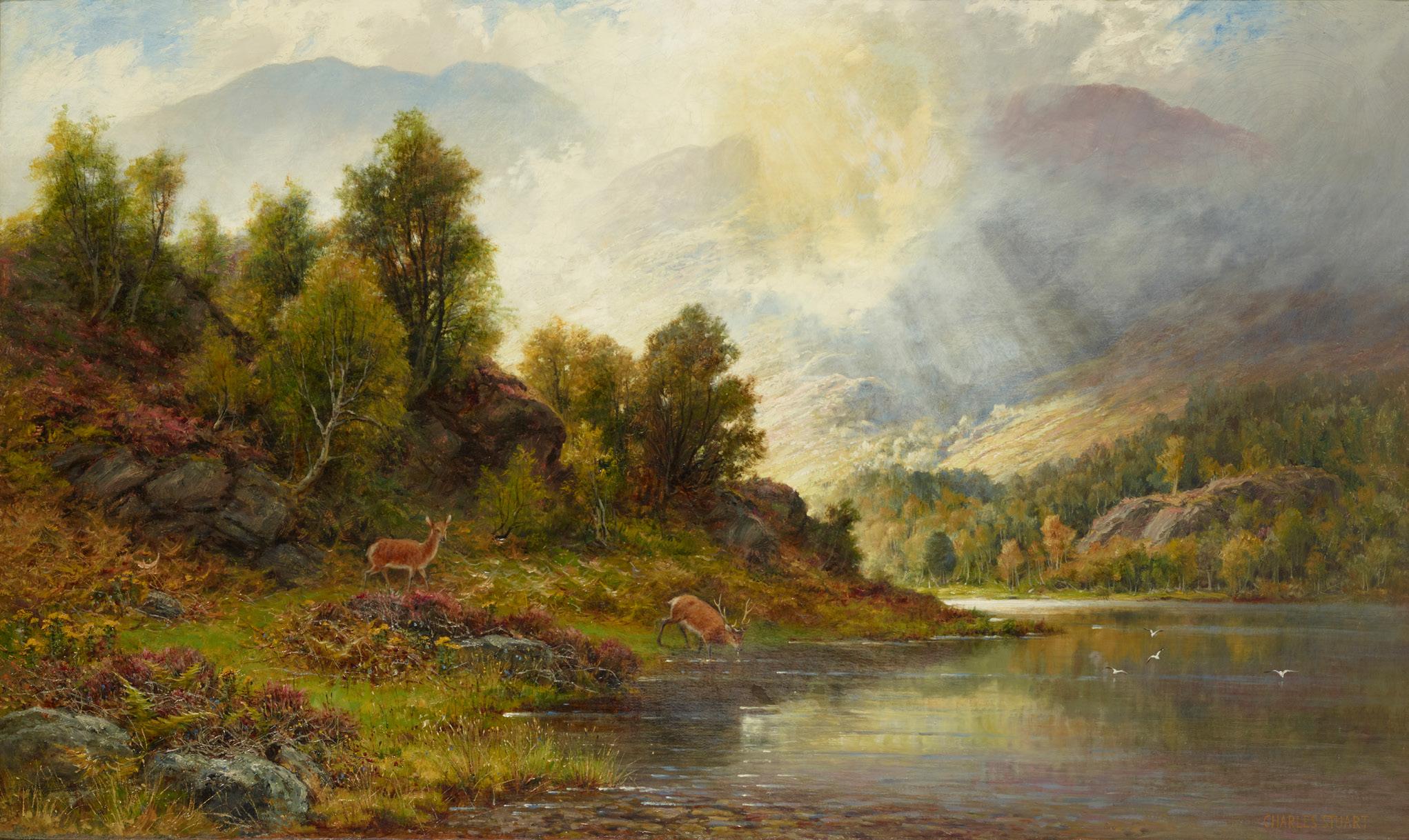
18 Other fees apply in addition to the hammer price: see the ‘Buyer’s Guide’ section on page 2
CHARLES CORDINER (SCOTTISH 1746-1794)
THE BRIDGE OF ALVAH, BANFF
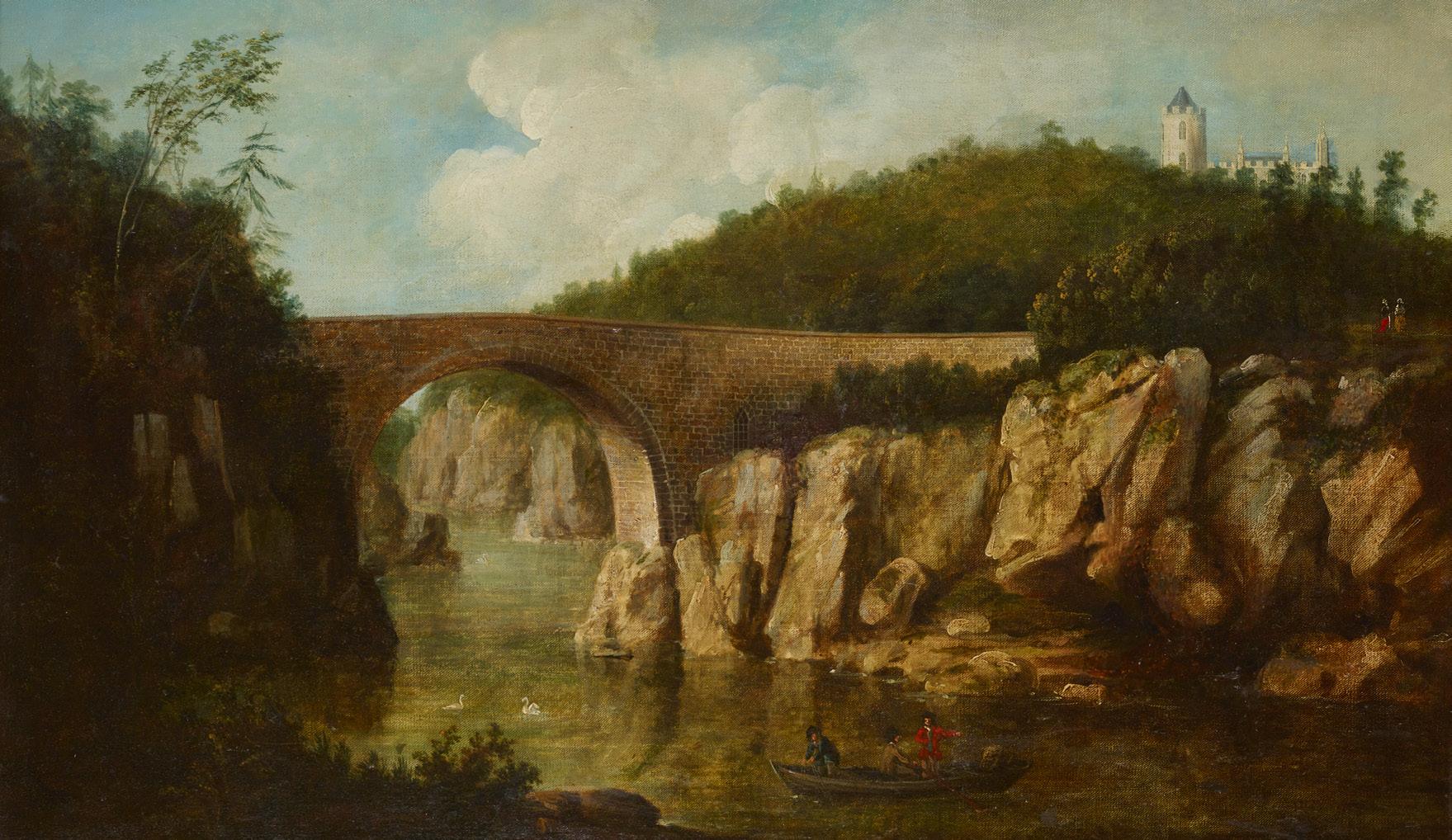
Oil on canvas
56cm x 94cm (22in x 37in)
£1,500-2,000
Cordiner studied at Foulis Academy in Glasgow between 1763 and 1766 before becoming a Episcopal minister in Banff. Whilst there Cordiner established a considerable reputation as an artist and received commissions to paint local views in oil and watercolour. This painting shows the grounds of Duff House owned by the Earl of Fife. He commissioned a gouache of the same subject which hung above the fireplace at Rothiemay, one of his homes, which is illustrated in Paul Harris and Julian Halsby, The Dictionary of Scottish Painters, Canongate, Edinburgh, 1990, p.37.
29
GEORGE BLACKIE STICKS (BRITISH 1843-1938)
A SUMMER DAY IN THE TROSSACHS
Signed and dated 1877, signed, inscribed and dated verso, oil on canvas, and a companion, ‘Eagle’s Glen’, a pair (2)
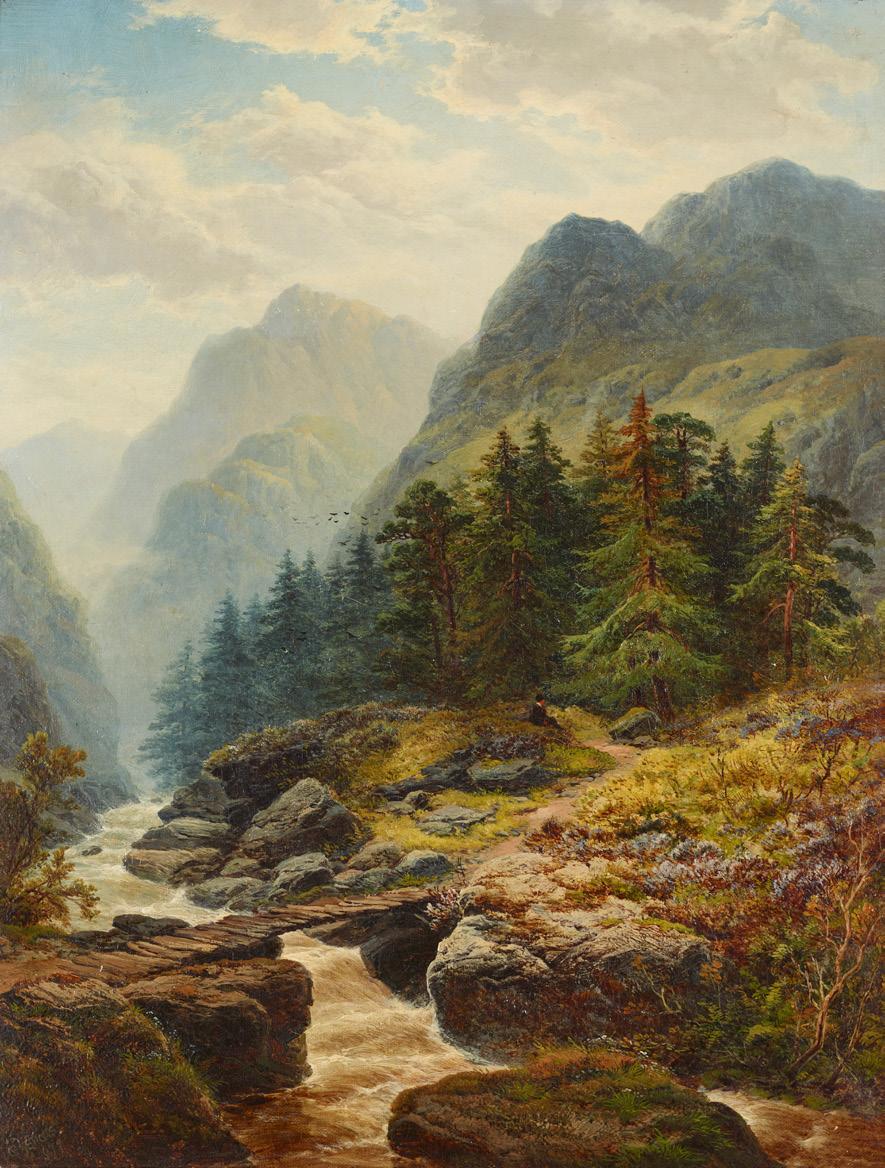
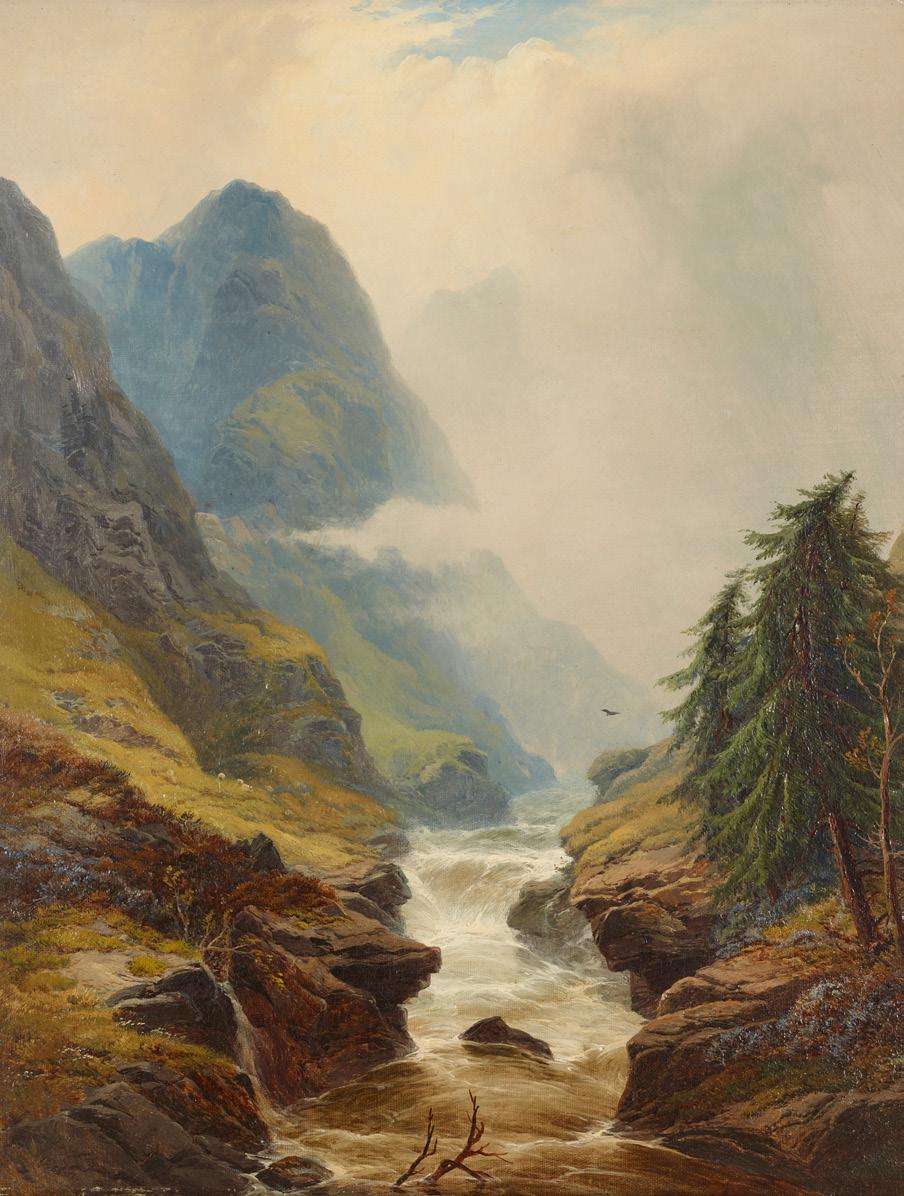
46cm x 36cm (18in x 14in)
£1,500-2,000
28
19
30
ROBERT WEIR ALLAN
R.S.A., R.S.W., R.W.S. (SCOTTISH 1852-1942)
SULTAN HASAN MOSQUE, CAIRO
Signed and inscribed ‘Cairo’, watercolour
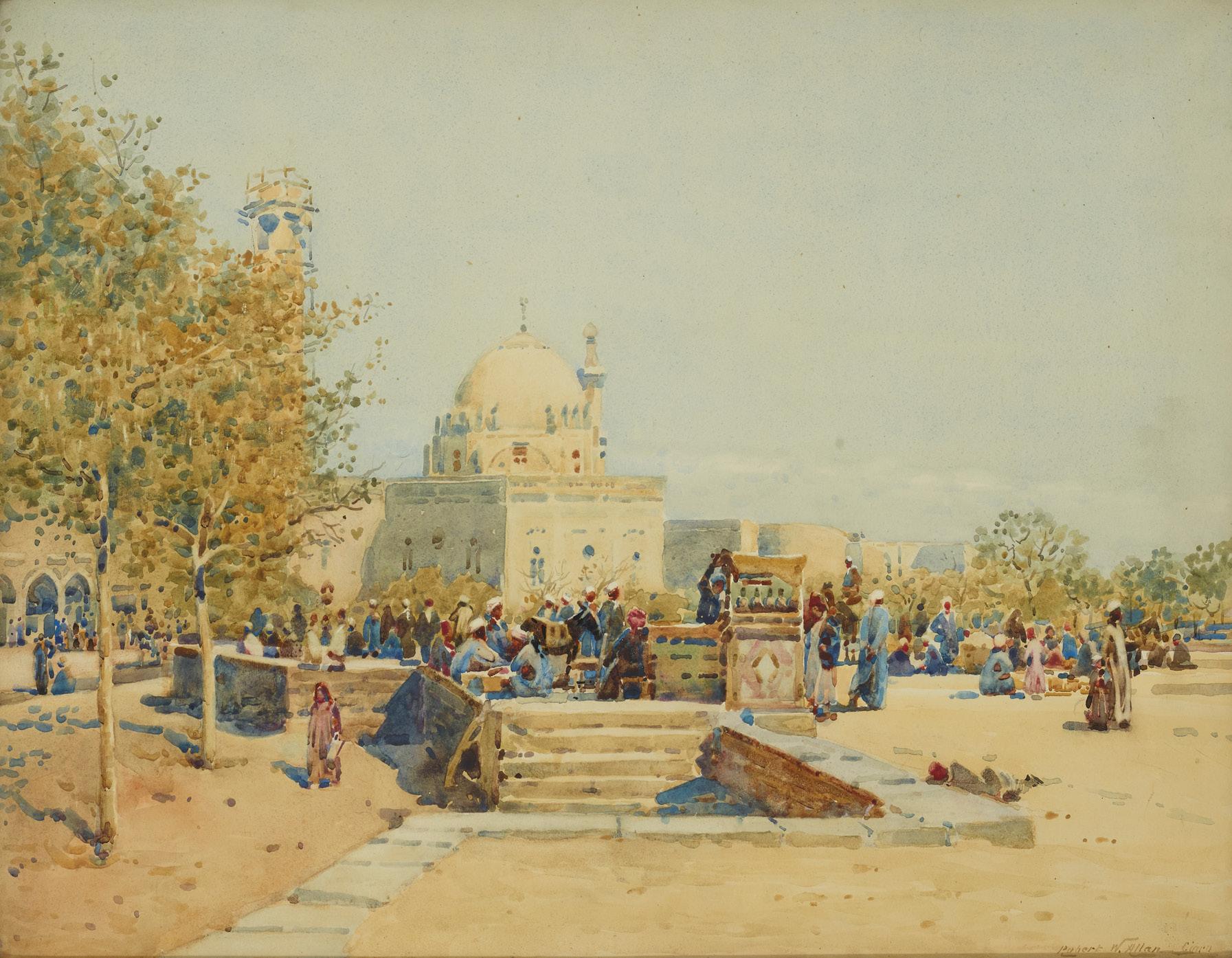
52cm x 75cm (20.5in x 29.5in)
£800-1,200
JAMES WATTERSTON HERALD (SCOTTISH 1859-1914)
HARBOUR SCENE AT DUSK
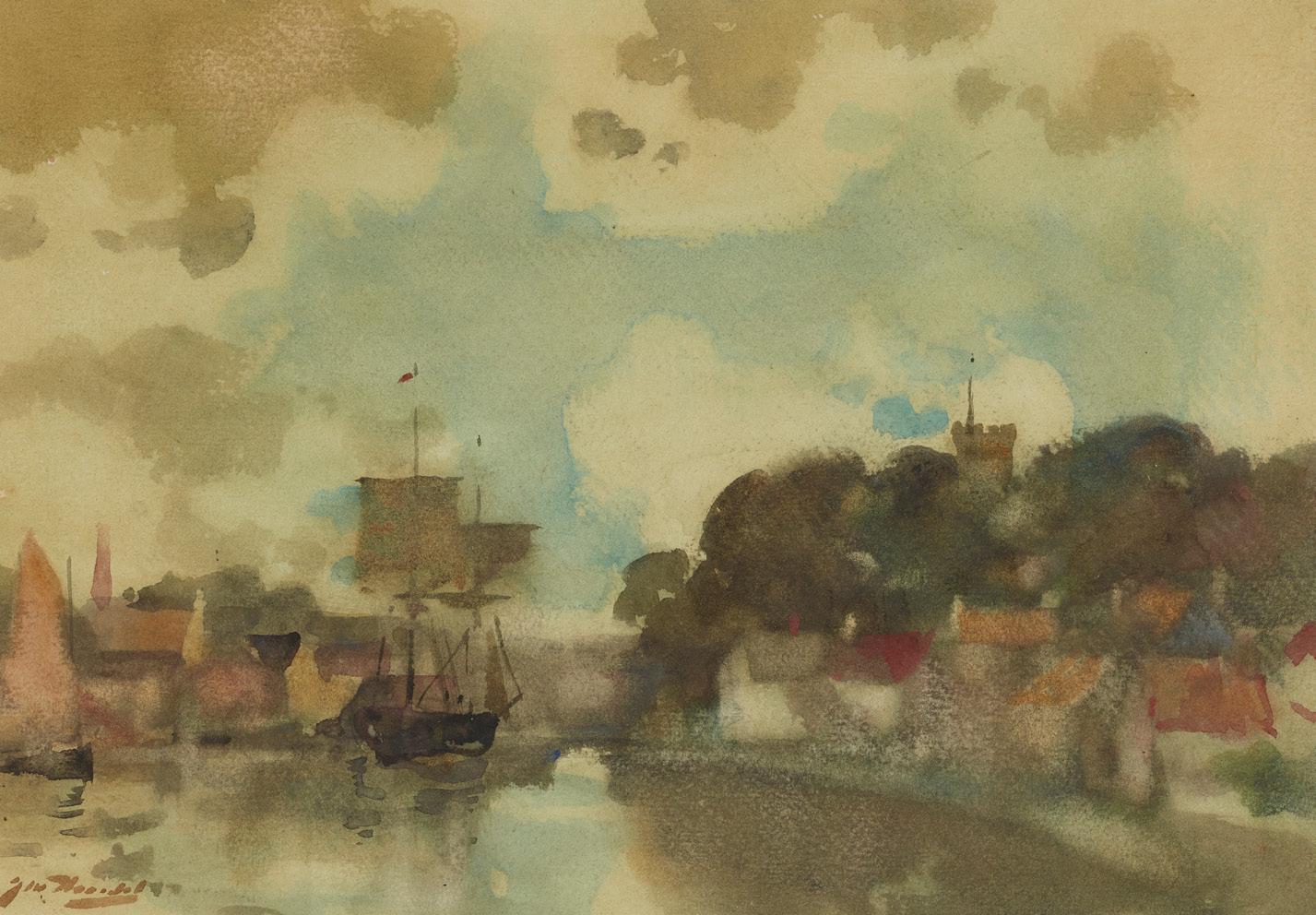
Signed, watercolour
21.5cm x 31cm (8.5in x 12in)
£800-1,200
31
20
32 §
ROBERT EADIE
R.S.W. (SCOTTISH 1877-1954)

EDINBURGH SKYLINE AT SUNSET

Signed, oil on canvas
71cm x 91cm (28in x 36in)
£2,000-3,000
21 Other fees apply in addition to the hammer price: see the ‘Buyer’s Guide’ section on page 2
STUART PARK (SCOTTISH 1862-1933)
A STILL LIFE OF RED AND WHITE GERANIUMS

Signed, oil on canvas
46cm x 30.5cm (18in x 12in)
£600-800
33
STUART PARK (SCOTTISH 1862-1933)
A STILL LIFE OF RED GERANIUMS

Signed, oil on canvas, oval
38cm x 48cm (15in x 18in)
£1,000-1,500
34
22
EDWARD ATKINSON HORNEL (SCOTTISH 1864-1933)
THE BUTTERFLY
Signed and dated 1919, oil on canvas

51cm x 61cm (20in x 24in)
£6,000-8,000
35
23 Other fees apply in addition to the hammer price: see the ‘Buyer’s Guide’ section on page 2
36
ARCHIBALD DAVID REID
A.R.S.A., R.S.W., R.O.I. (SCOTTISH 1844-1908)
FEEDING PIGEONS
Signed, inscribed with title on label verso, oil on canvas
61cm x 91cm (24in x 36in)
£1,000-1,500
37
JOHN REID MURRAY (SCOTTISH 1861-1906)
STOOKS IN SUMMER
Signed and dated 1898, oil on canvas

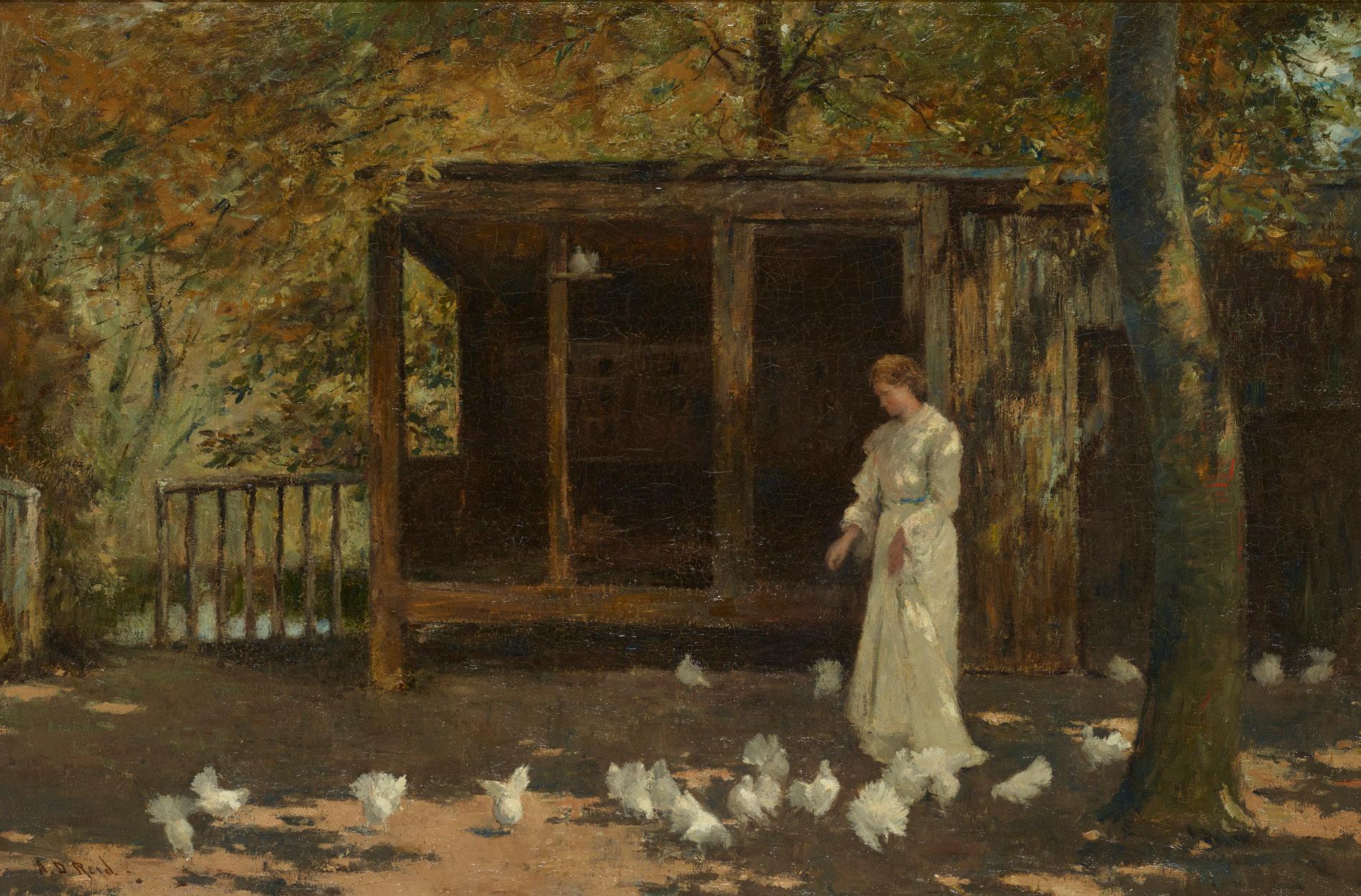
30.5cm x 55.5cm (12in x 21.75in)
£1,000-1,500
24 Other fees apply in addition to the hammer price: see the ‘Buyer’s Guide’ section on page 2
DAVID GAULD R.S.A.
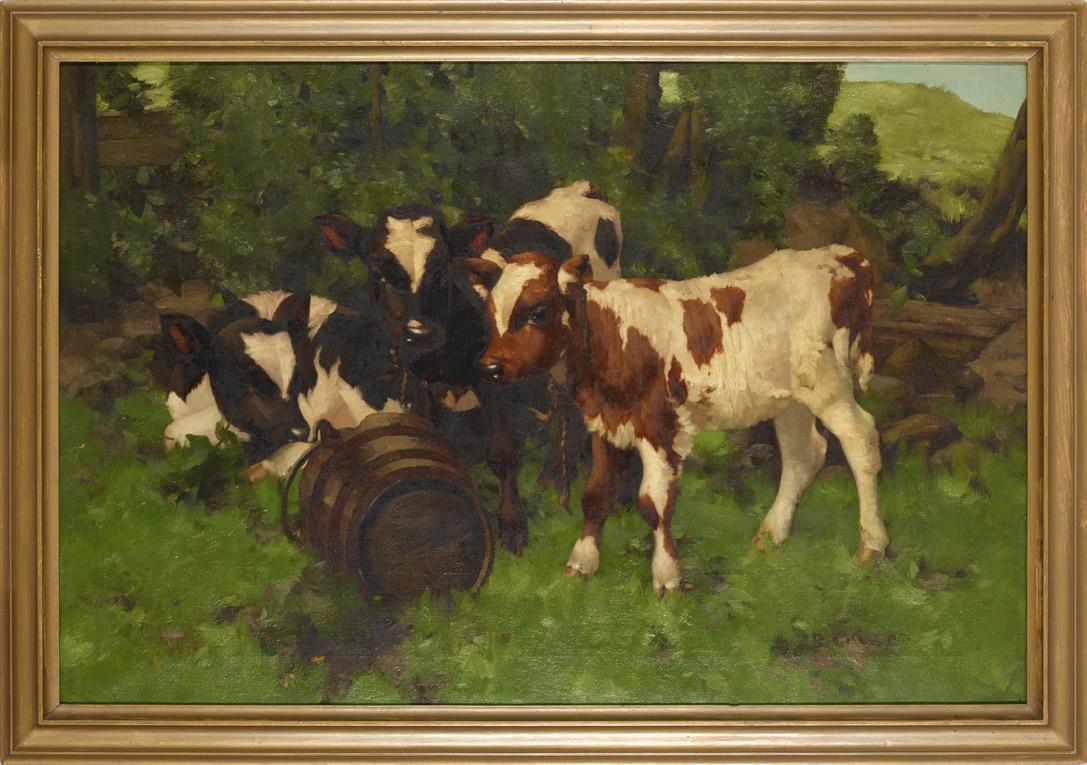
(SCOTTISH 1865-1936)
CALVES BY A WATERBUTT
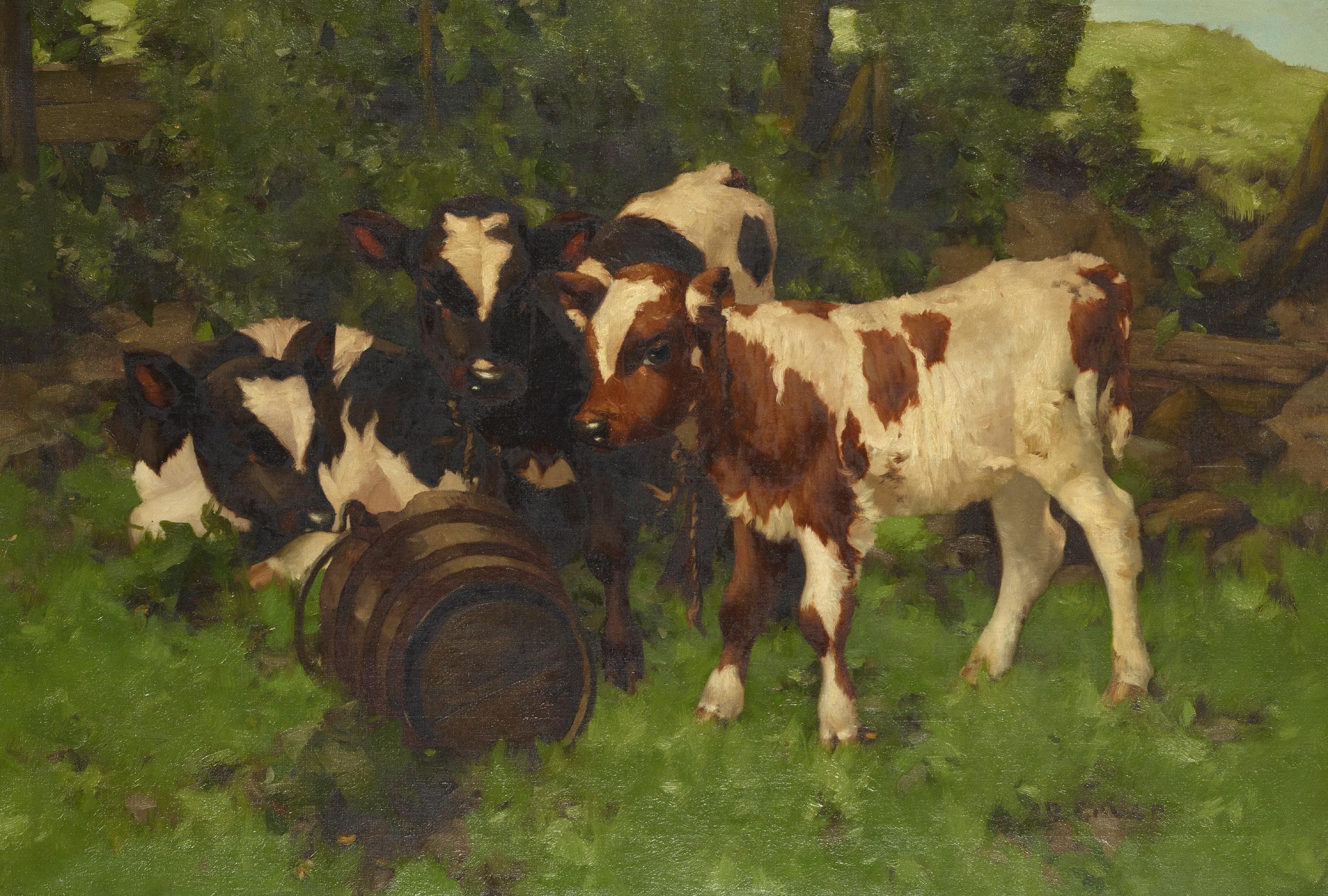
Signed, oil on canvas
76cm x 115cm (30cm x 45.25in)
£3,000-5,000
38
25
39
WILLIAM WATSON (SCOTTISH 1831-1921)

HIGHLAND CATTLE IN A MOUNTAIN GLEN
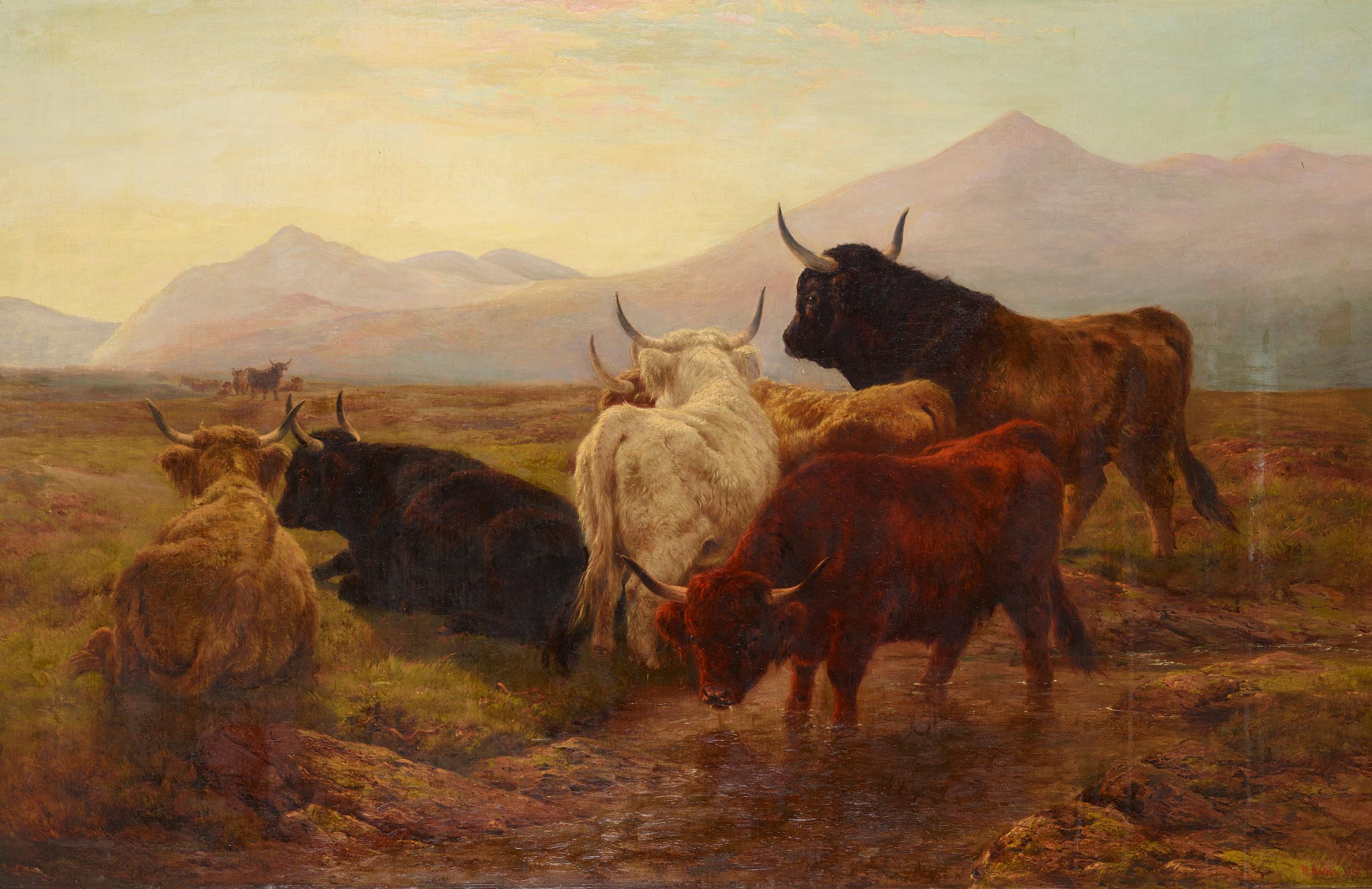
Signed and dated 1872, oil on canvas 91cm x 140cm (36in x 55in)
£2,000-3,000
40
JAMES GILES R.S.A. (SCOTTISH 1801-1870)
STARTLED DEER
Signed and dated 1842, inscribed with title on contemporary label verso, oil on panel 20cm x 61cm (8in x 24in), unframed
£1,500-2,000
26 Other fees apply in addition to the hammer price: see the ‘Buyer’s Guide’ section on page 2
R.S.A, R.S.W., R.G.I. (SCOTTISH 1869-1947)
A RIVER LANDSCAPE, AYRSHIRE
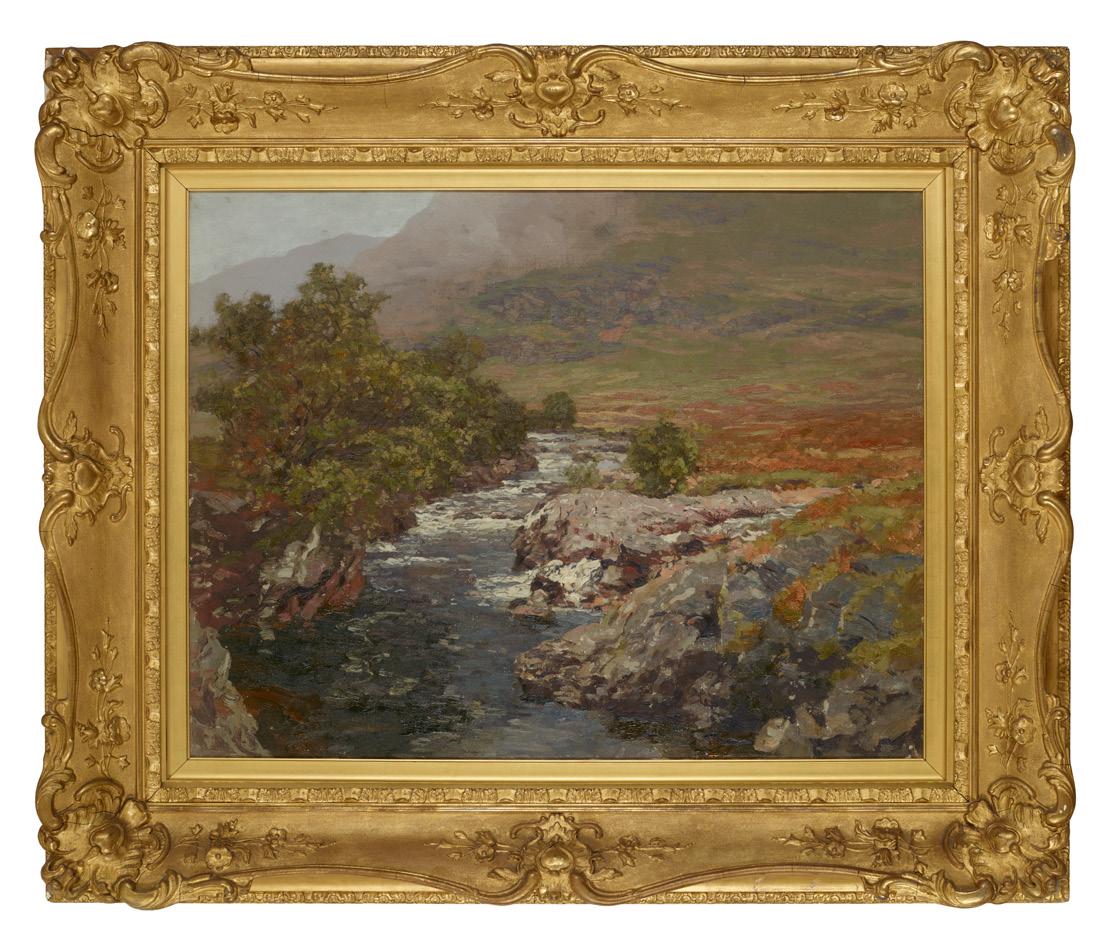
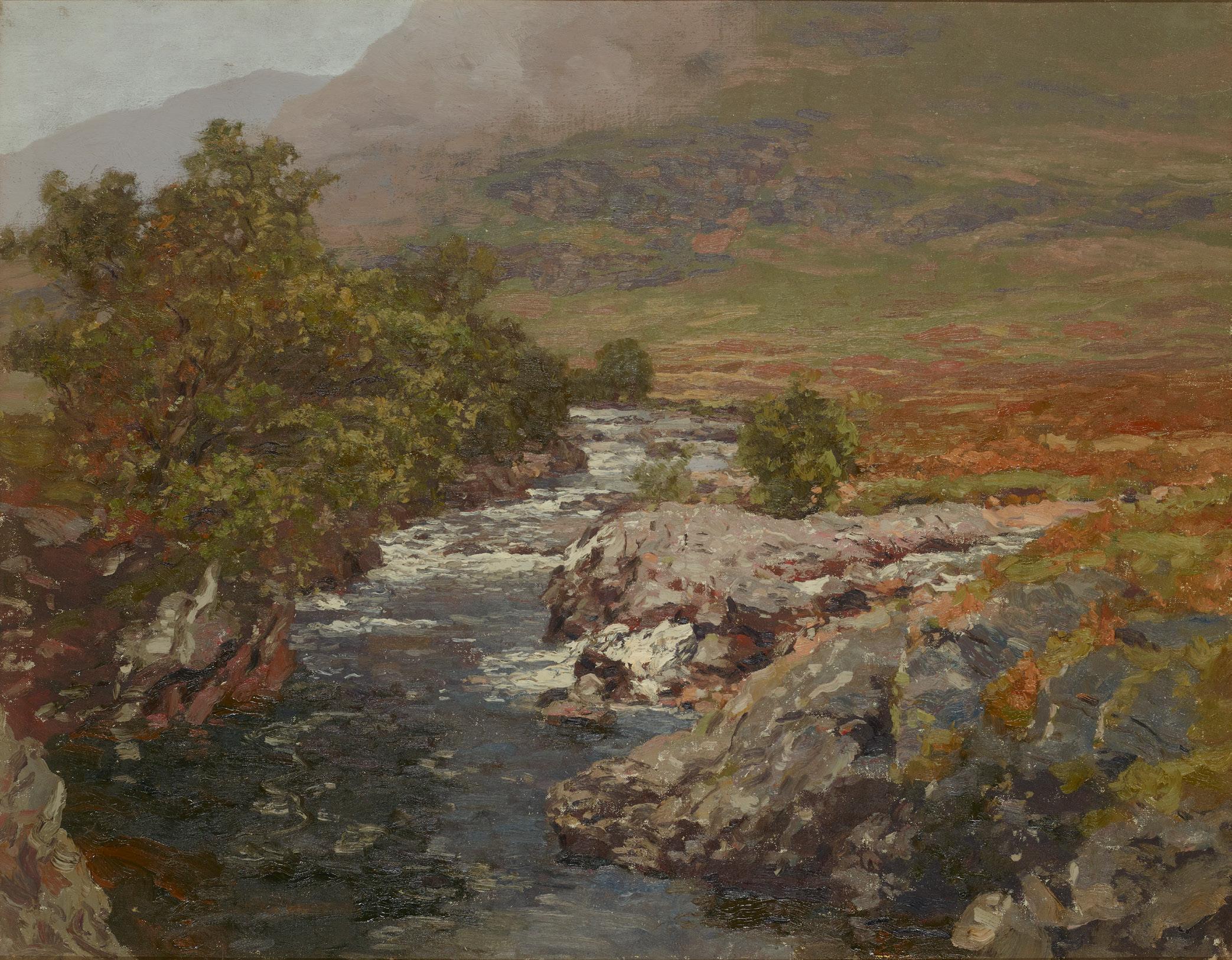
Signed, oil on canvas
71cm x 91cm (28in x 36in)
£2,000-3,000
41
GEORGE HOUSTON
27
ROBERT GEMMELL HUTCHISON
R.B.A., R.O.I., R.S.A., R.S.W. (SCOTTISH 1860-1936)
A THOUGHTFUL MOMENT
Signed, oil on canvas
46cm x 30.5cm (18in x 12in)
£3,000-5,000
42
ROBERT MCGREGOR
R.S.A. (SCOTTISH 1847-1922)
FEEDING TIME
Signed, oil on canvas
30.5cm x 23cm (12in x 9in)
£800-1,200
44
ROBERT GEMMELL HUTCHISON
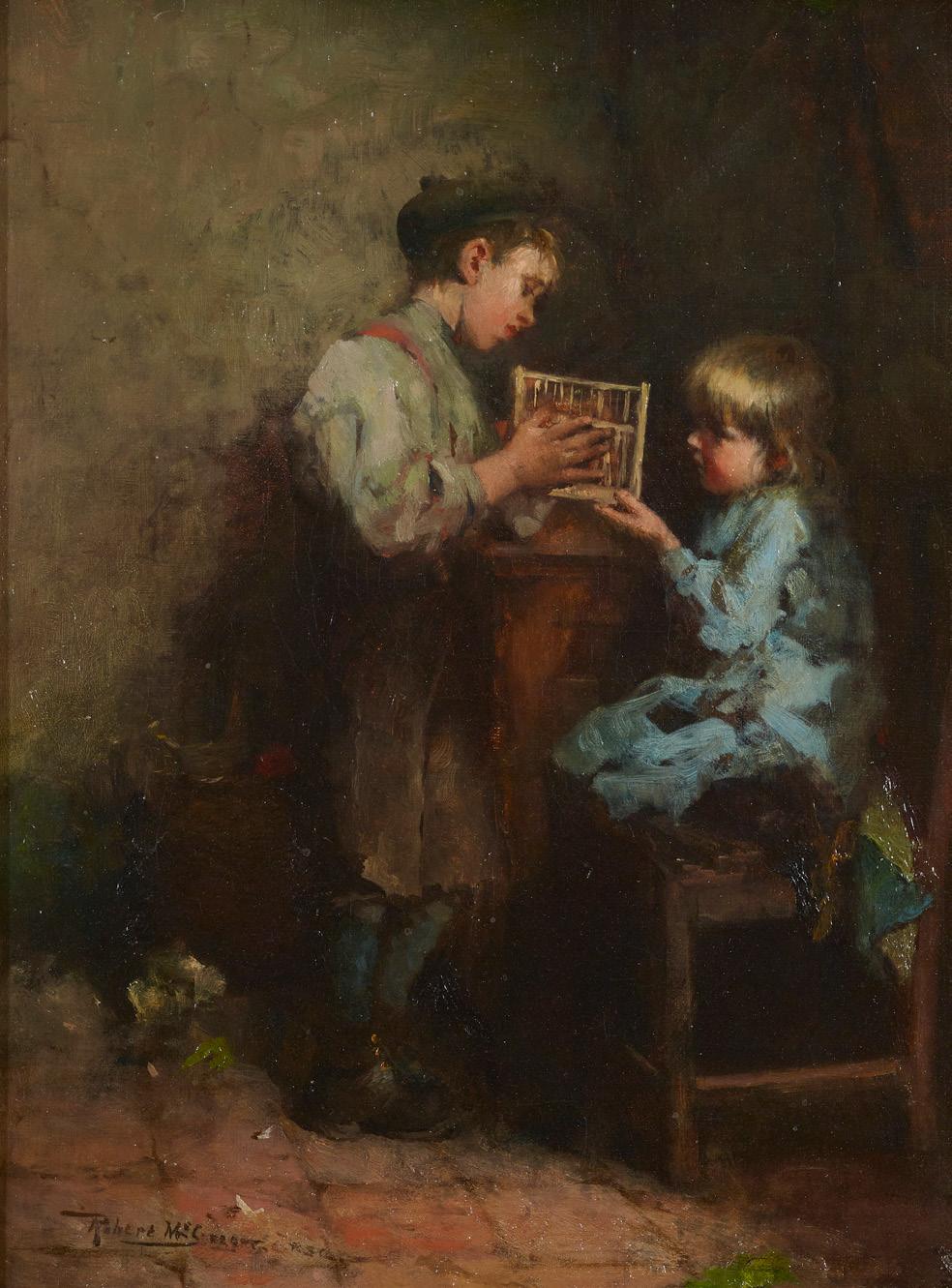
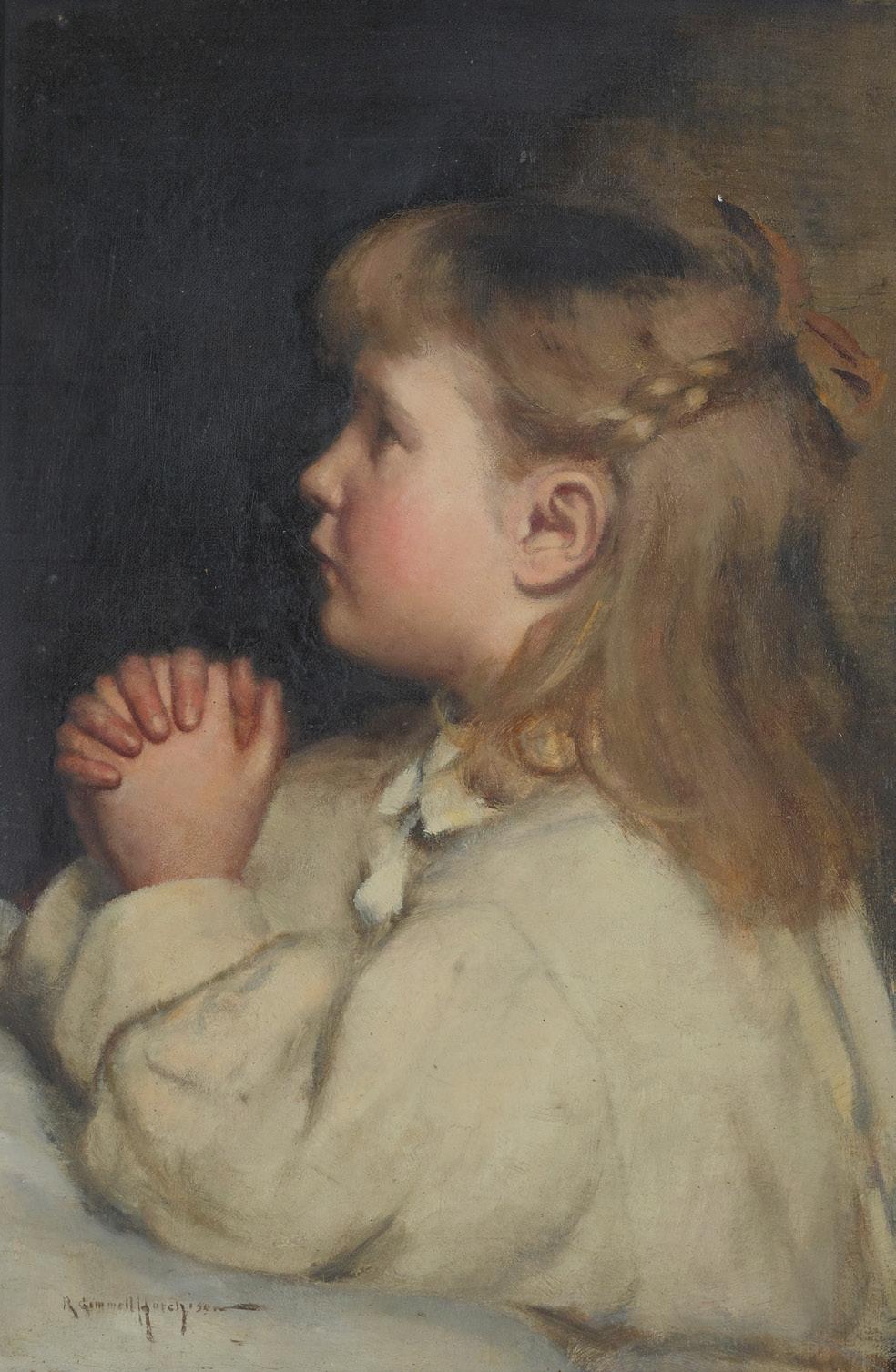
R.B.A., R.O.I., R.S.A., R.S.W. (SCOTTISH 1860-1936)
PEELING TATTIES
Signed, oil on canvas
61cm x 51cm (24in x 20in)
£5,000-7,000
43
28 Other fees apply in addition to the hammer price: see the ‘Buyer’s Guide’ section on page 2


JOHN KEPPIE (SCOTTISH 1862-1945)
SOUKKARIE GATE, CAIRO
Signed and inscribed, watercolour
69cm x 48.5cm (27.25in x 19in)
£1,500-2,000
46
SIR DAVID YOUNG
CAMERON R.A., R.S.A., R.W.S., R.S.W., R.E. (SCOTTISH 1865-1945)
TRAQUAIR HOUSE, PEEBLES
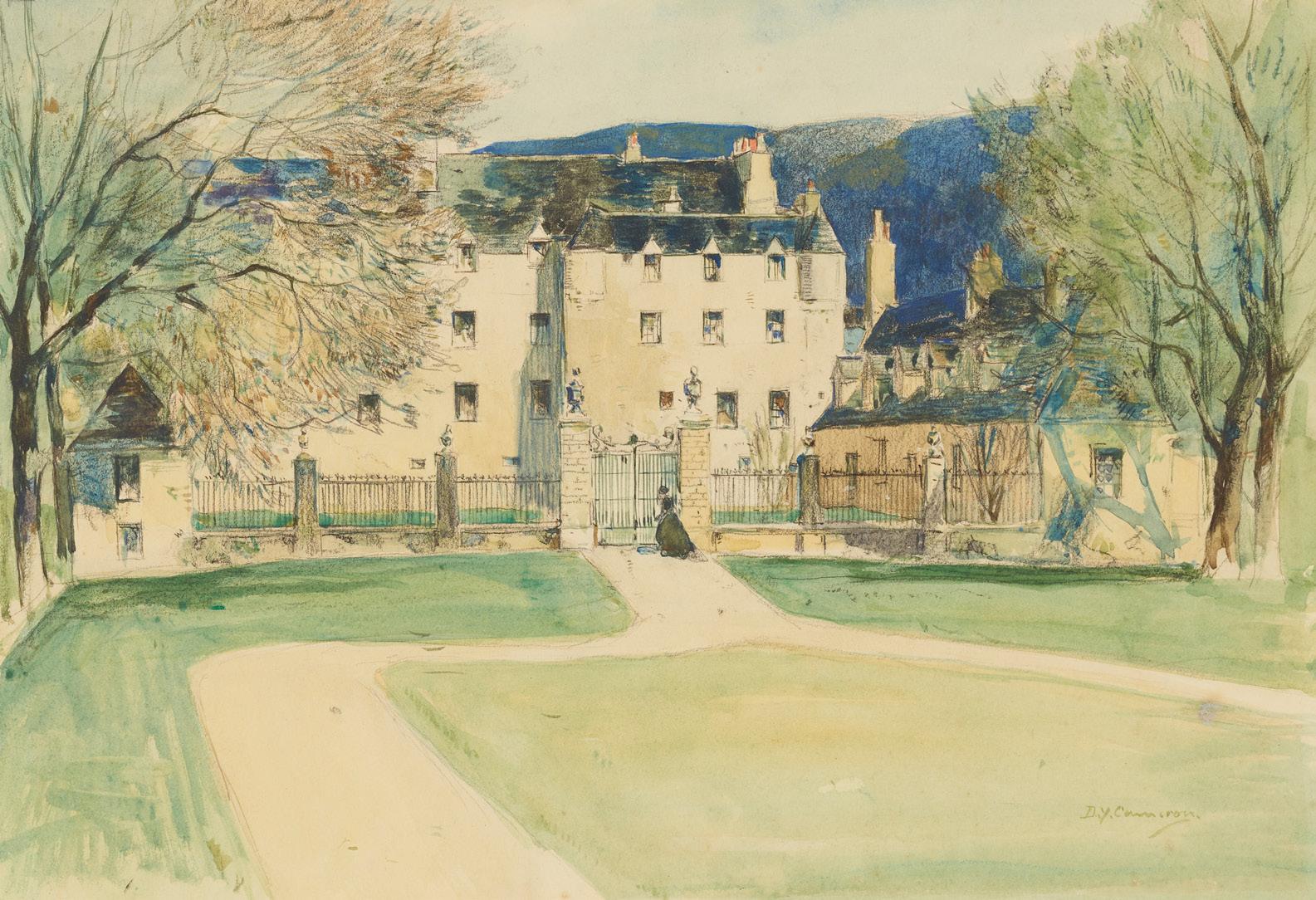
Signed, pen and ink and watercolour
25.5cm x 36cm (10in x 14in)
Provenance: The Fine Art Society Ltd, London, June 1970
£800-1,200
47
SIR DAVID YOUNG
CAMERON R.A., R.S.A., R.W.S., R.S.W., R.E. (SCOTTISH 1865-1945) THE OLD MUSEUM, BEAUVAIS
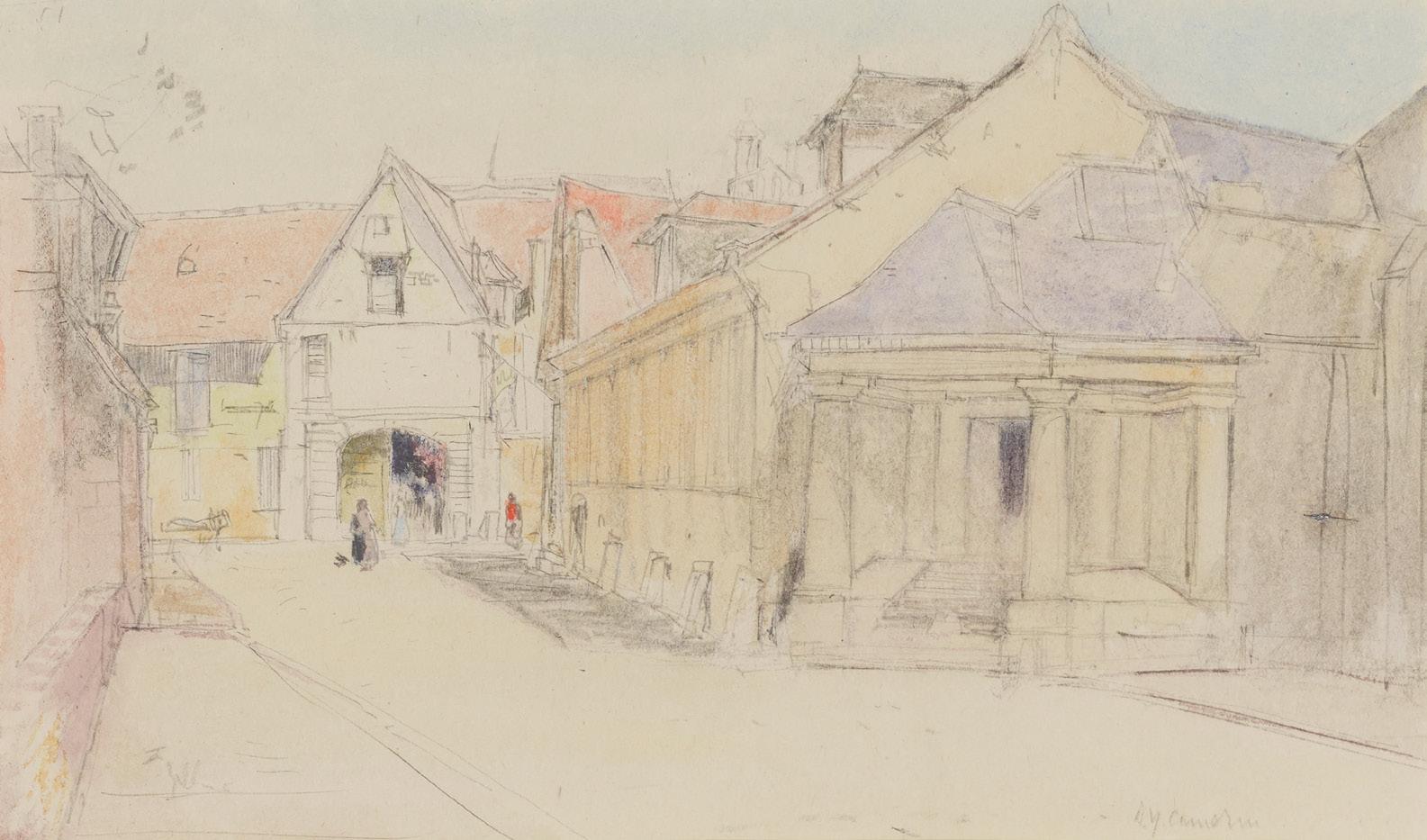
Signed, pencil and watercolour
17cm x 29cm (6.75in x 11.5in)
Provenance: Ewan Mundy Fine Art Ltd, Glasgow £600-800
45
31 Other fees apply in addition to the hammer price: see the ‘Buyer’s Guide’ section on page 2
48
TOM SCOTT R.S.A. (SCOTTISH 1854-1927)
THE BRAES OF YARROW
Signed and dated 1918, watercolour 58cm x 77cm (22.75in x 30.25in)
£1,500-2,000
49
WALLER HUGH
PATON R.S.A., R.S.W. (SCOTTISH 1828-1895)
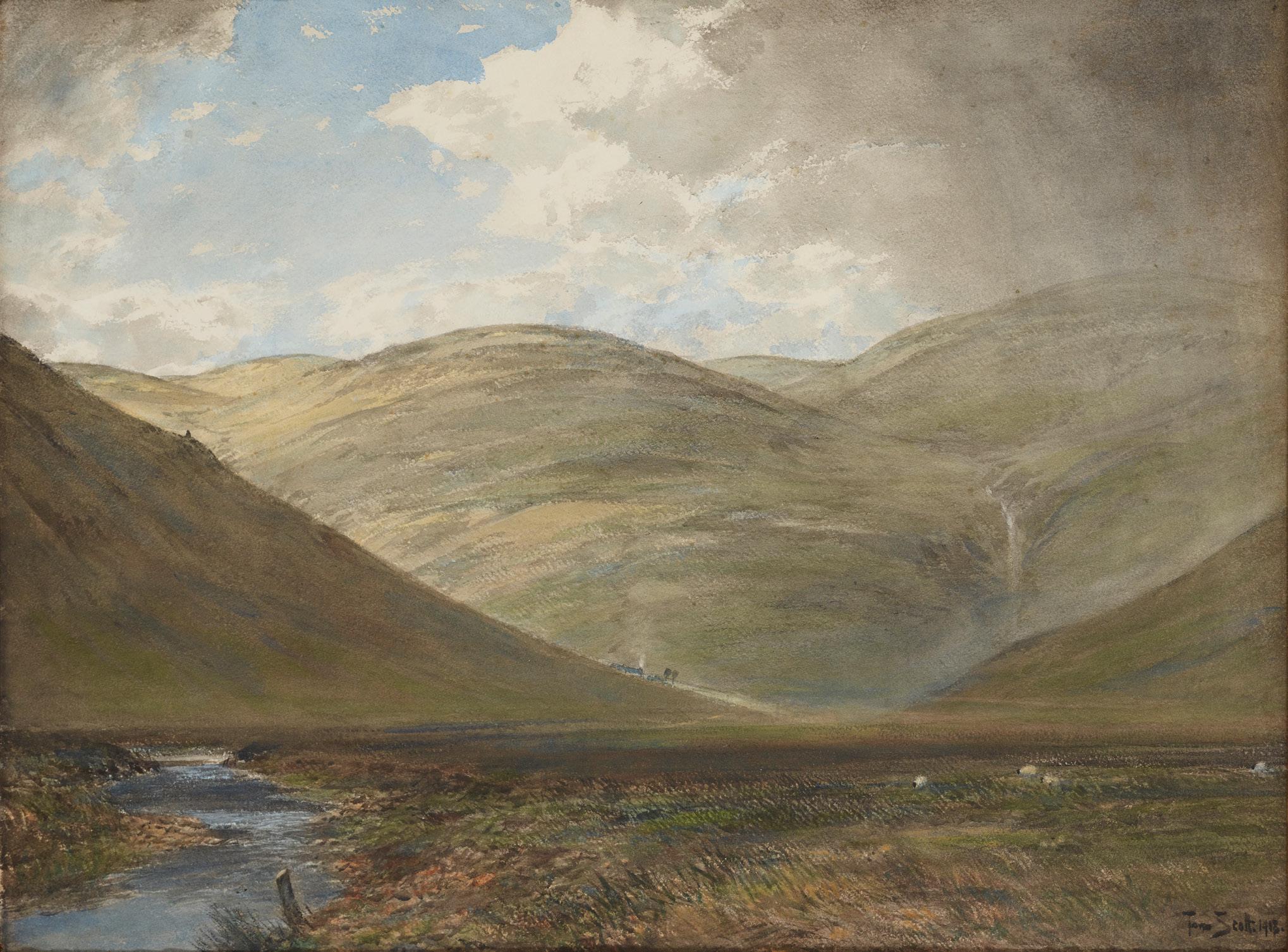
THE ISLAND OF GRAVES, SKYE
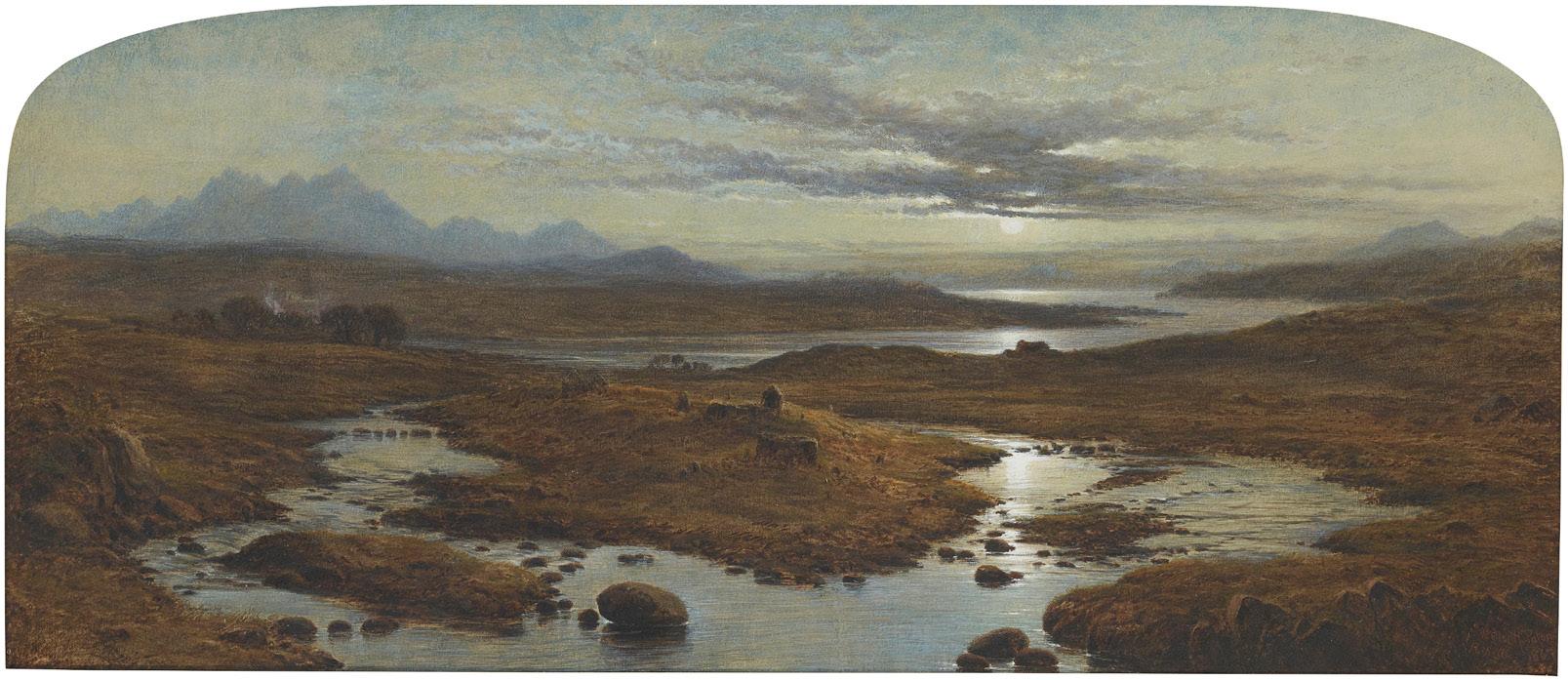
Signed and dated 1867, signed, inscribed and dated on the backboard, watercolour, arched top 23cm x 54cm (9in x 21.25in)
£1,000-1,500
32 Other fees apply in addition to the hammer price: see the ‘Buyer’s Guide’ section on page 2
50
GEORGE HOUSTON R.S.A, R.S.W., R.G.I. (SCOTTISH 1869-1947)
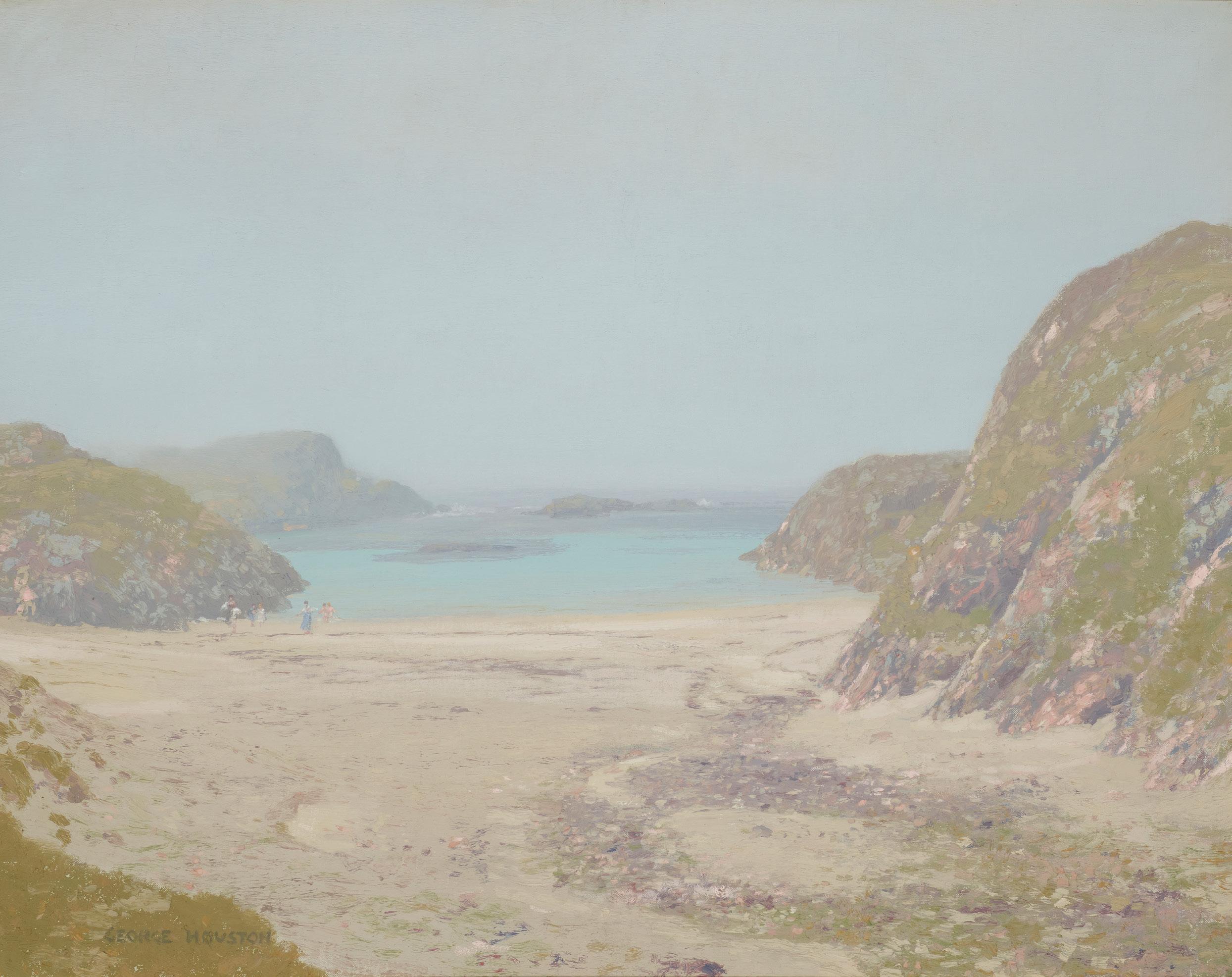
ON THE BEACH
Signed, oil on canvas
71cm x 91cm (28in x 36in)
£2,000-3,000
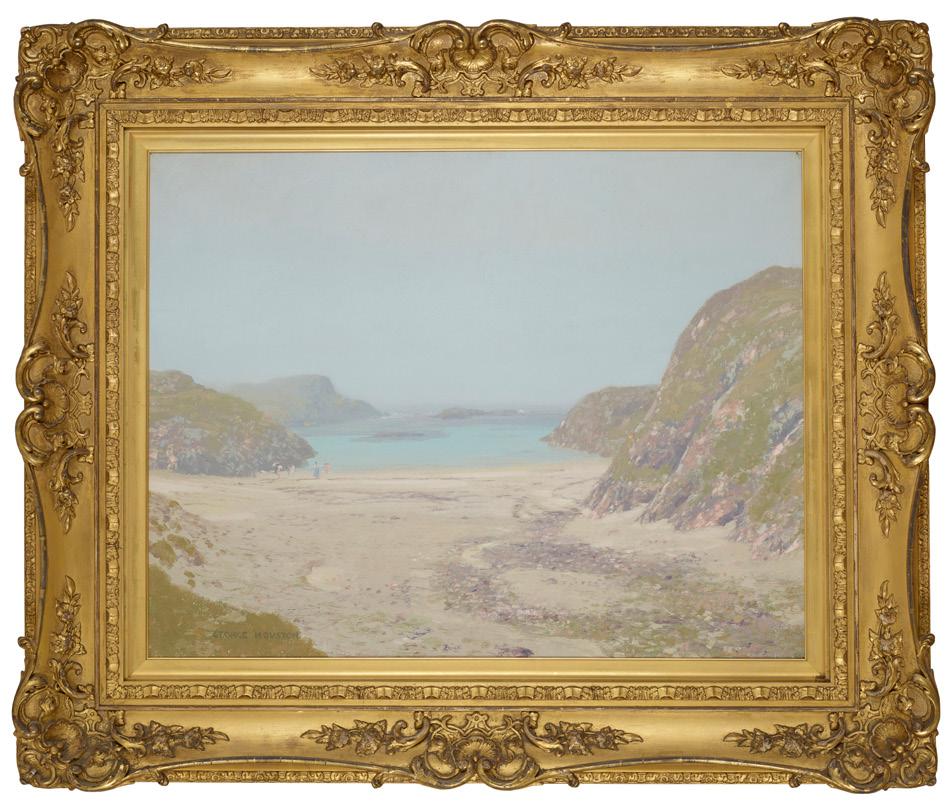
33
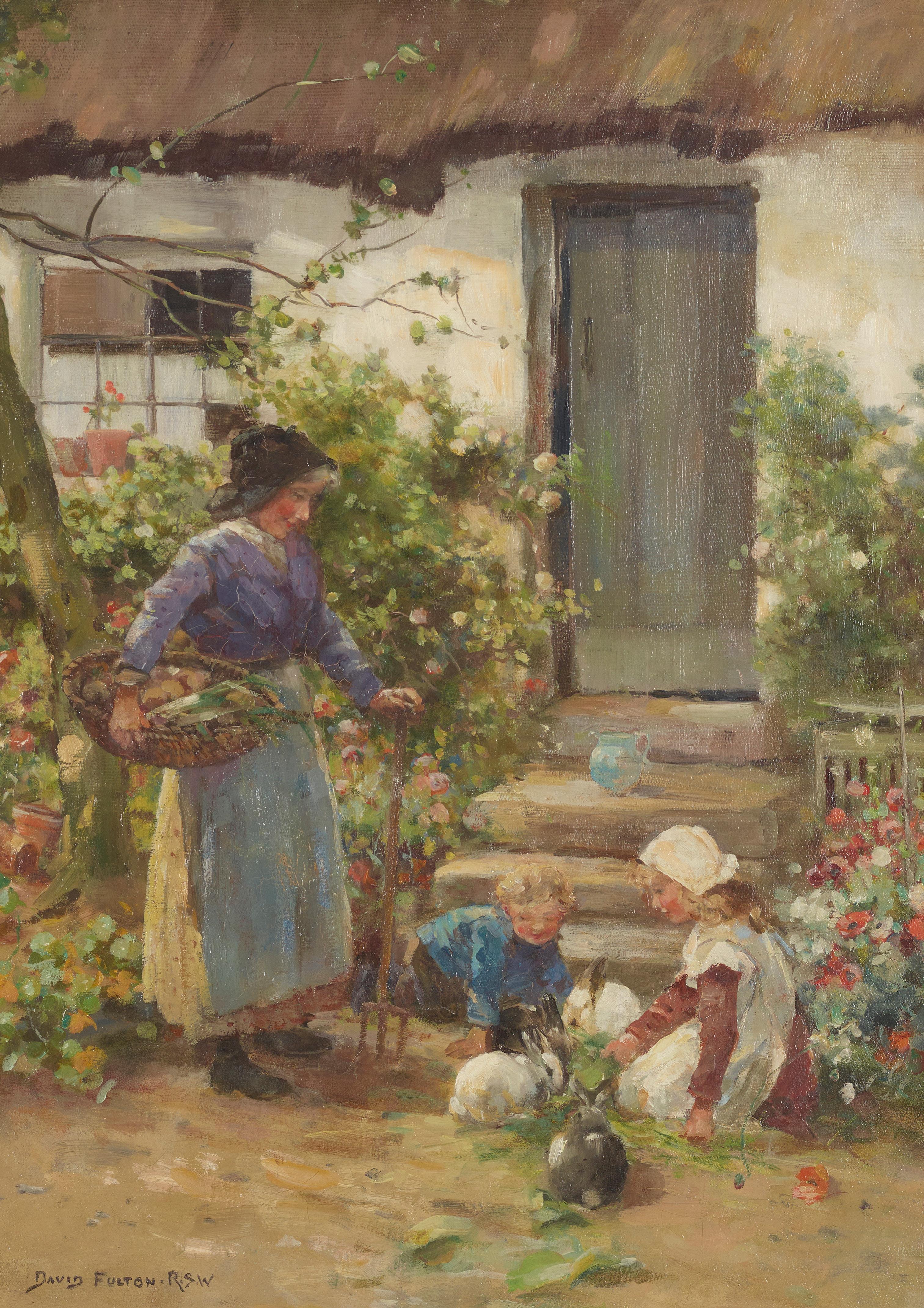
51
DAVID FULTON R.S.W. (SCOTTISH 1848-1930)
BUNNY’S BREAKFAST
Signed, oil on canvas
53.5cm x 38cm (21in x 18in)
Exhibited: Paisley Art Institute, Paisley £1,000-1,500
52
CHARLES HODGE MACKIE R.S.A., R.S.W., P.S.S.A. (SCOTTISH 1862-1920)
A STREET IN FRANCE
Signed, oil on canvas laid down to board
38cm x 38cm (15in x 15in)
£500-800
53
ROBERT GEMMELL HUTCHISON R.B.A., R.O.I., R.S.A., R.S.W. (SCOTTISH 1860-1936)
INDUSTRIOUS
Inscribed on label verso, pastel 47cm x 35cm (18.5in x 13.75in)
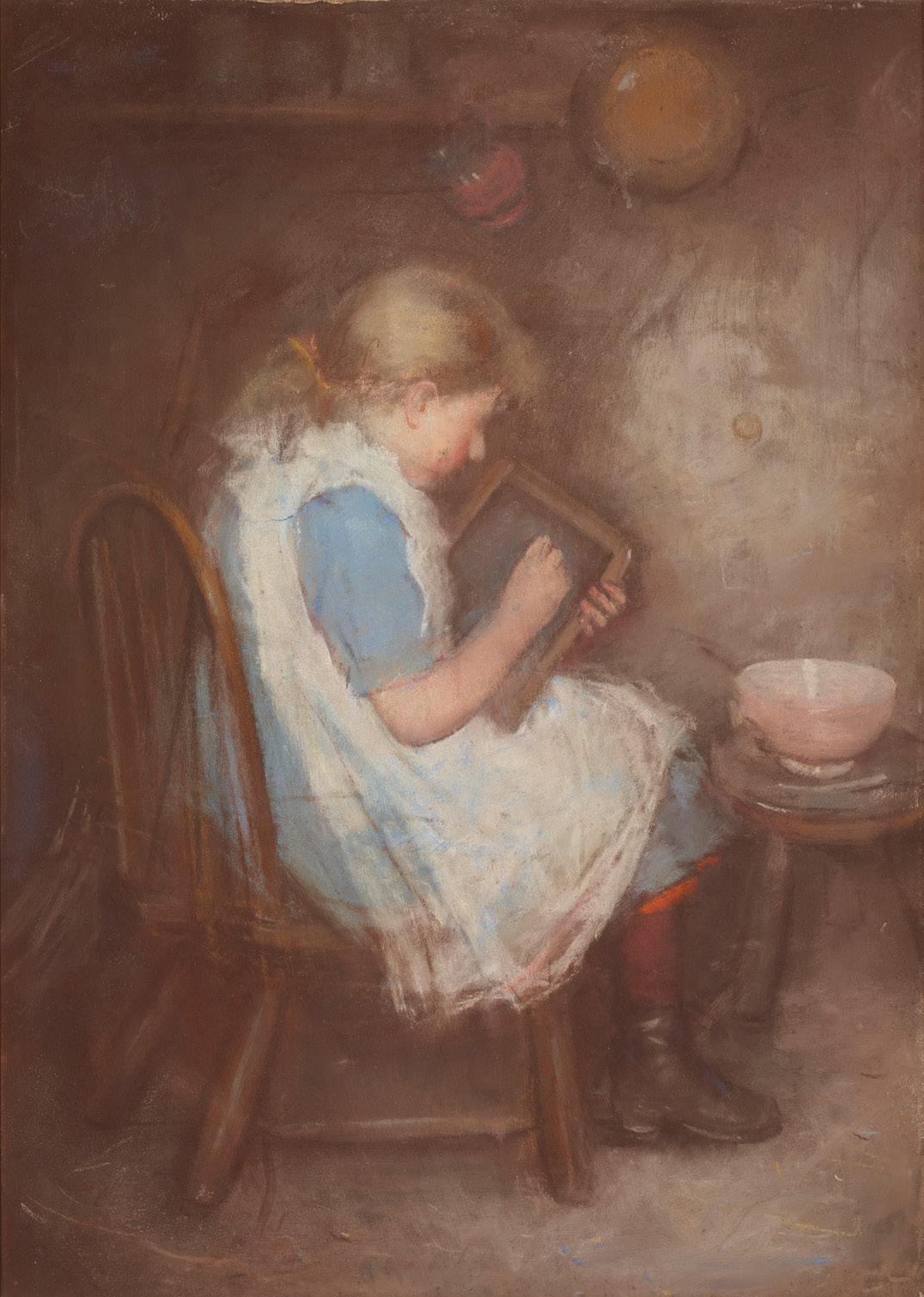
£800-1,200
54
THOMAS BROMLEY BLACKLOCK (SCOTTISH 1863-1903)
BY THE CAMP FIRE
Signed and dated 1900, oil on board 36cm x 46cm (14in x 18in)
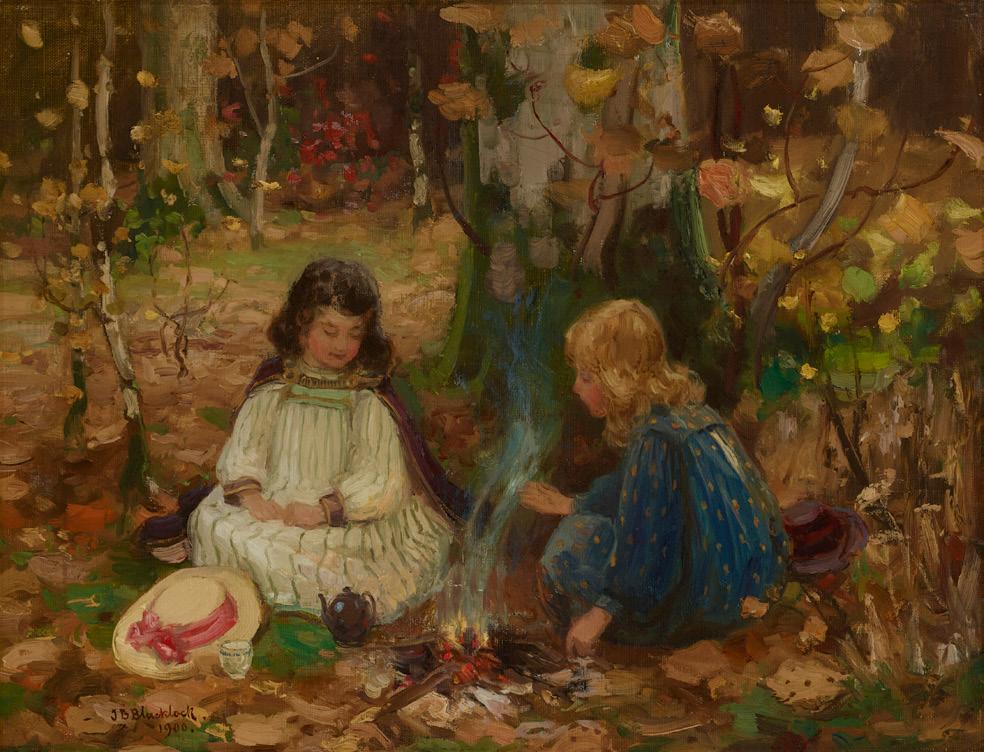
£600-800

35 Other fees apply in addition to the hammer price: see the ‘Buyer’s Guide’ section on page 2
55
TOM SCOTT R.S.A. (SCOTTISH 1854-1927) ON THE MAAS NEAR DORDRECHT, HOLLAND
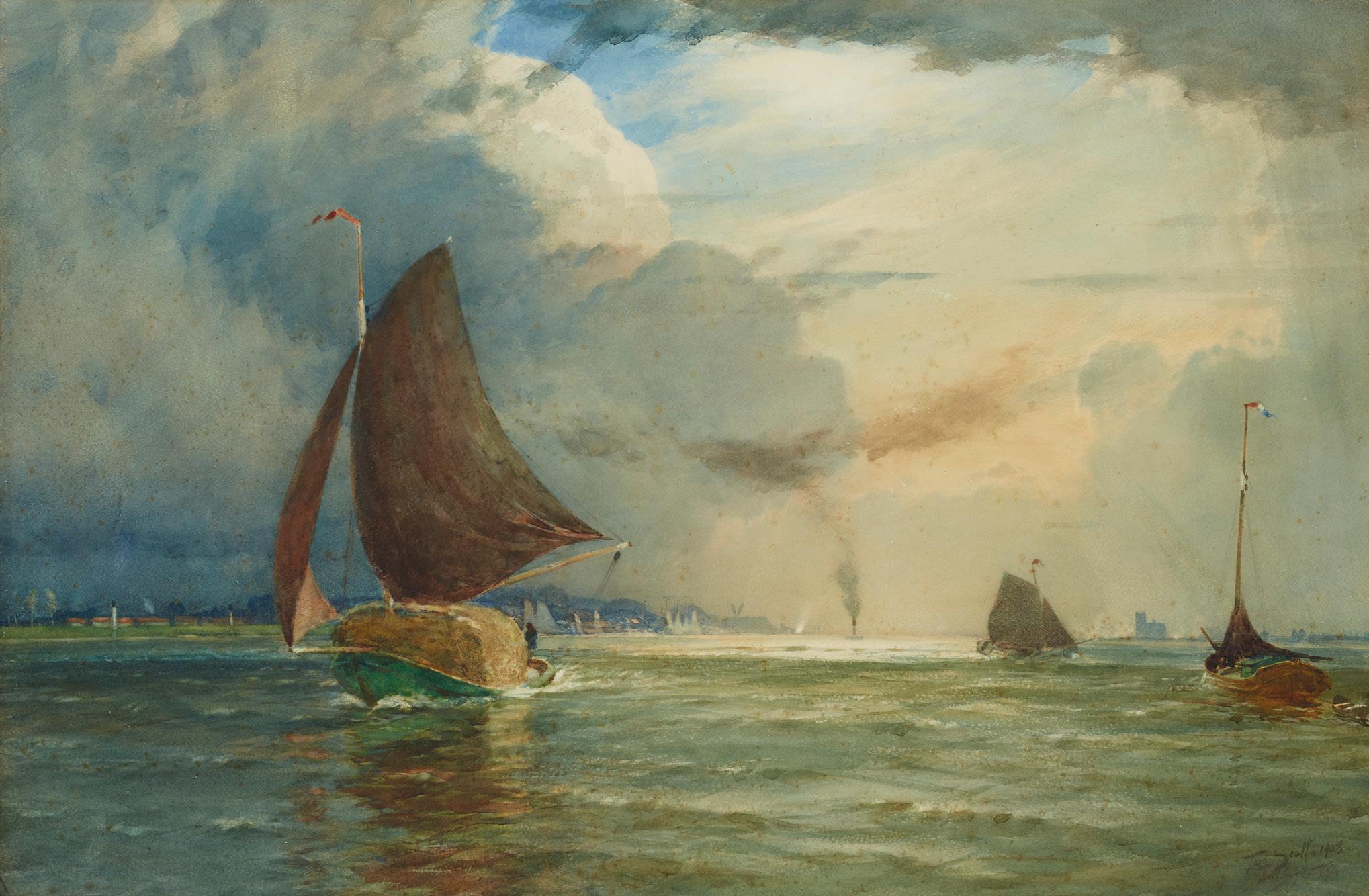
Signed and dated 1908, watercolour
61cm x 91cm (24in x 36in)
Provanance: Presented by the Artist to the Royal Scottish Academy’s Belgian Artists Relief Fund, 1915
£800-1,200
56 §
JAMES MCINTOSH PATRICK
R.S.A., R.O.I., A.R.E., L.L.D. (SCOTTISH 1907-1998)
KEITHOCK MILL, WOODSIDE

Signed, inscribed and dated 1991 on label verso, watercolour
51cm x 71cm (20in x 28in)
£1,000-1,500
36 Other fees apply in addition to the hammer price: see the ‘Buyer’s Guide’ section on page 2
57 §
JOHN MACLAUCHLAN MILNE R.S.A. (SCOTTISH 1885-1957)
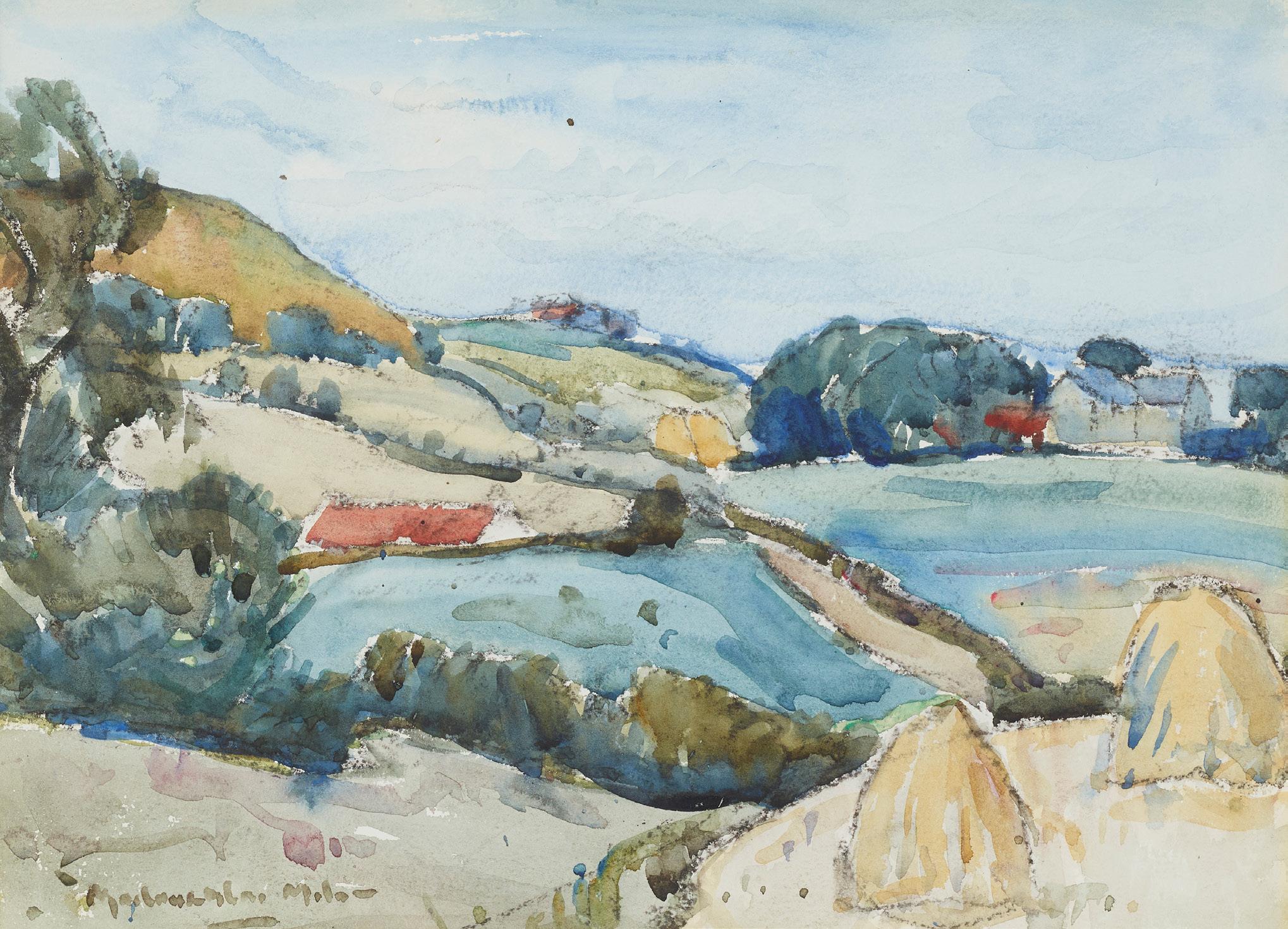
HARVEST TIME
Signed, watercolour
26.5cm x 37cm (10.5in x 14.5in)
£1,500-2,000
58
JAMES PATERSON R.S.A., R.S.W., R.W.S. (SCOTTISH 1854-1932)
VIEW TO THE CLIFFTOP
Signed and dated 1898, watercolour
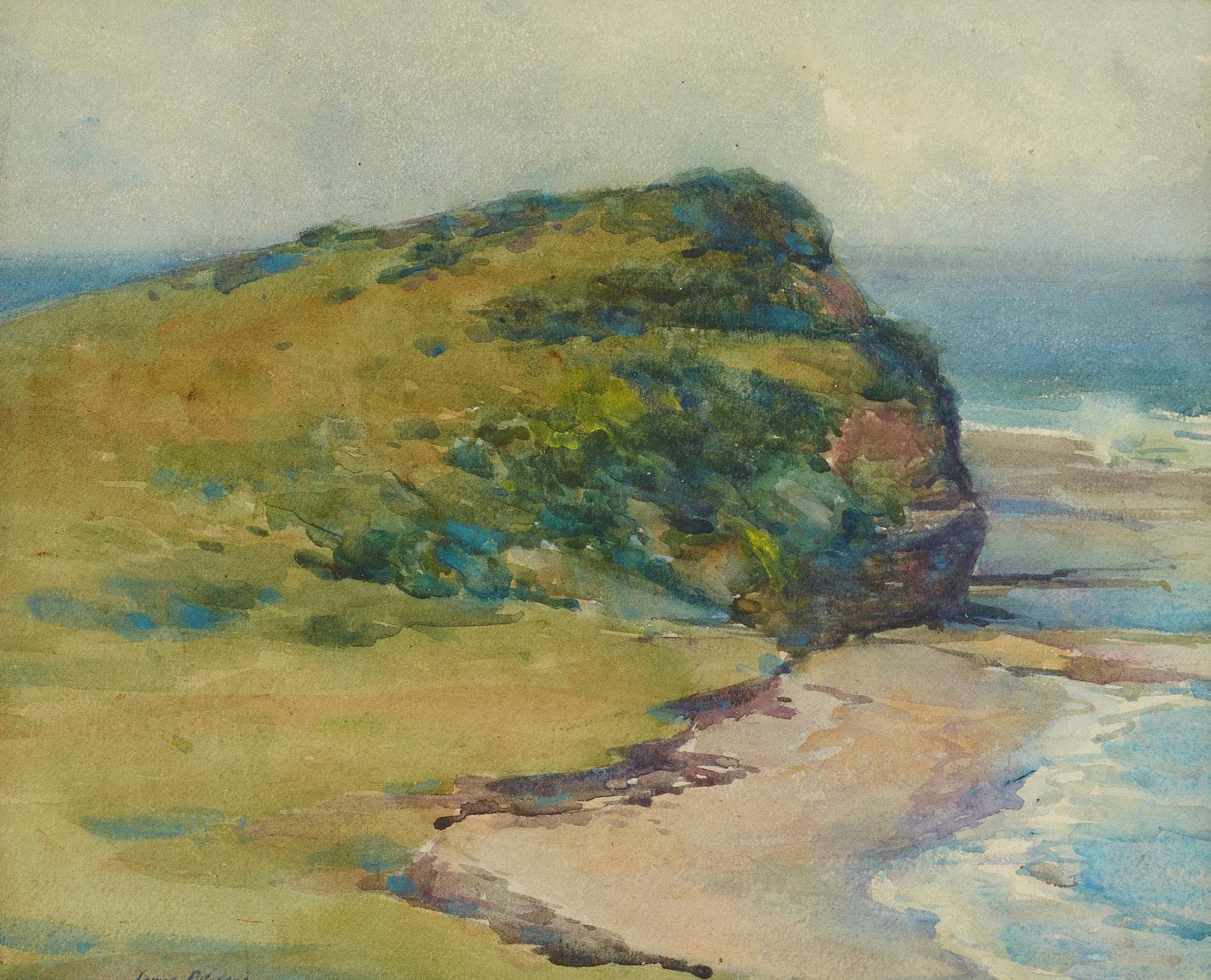
28cm x 33.5cm (11in x 13.25in)
£600-800
37
59 §
SIR WILLIAM RUSSELL FLINT P.R.A., P.R.W.S., R.S.W., R.O.I., R.E. (SCOTTISH 1880-1969)
A SUMMER’S DAY
Signed, watercolour
51cm x 67cm (20in x 26.5in)
Provenance: The Fine Art Society Ltd., 1950
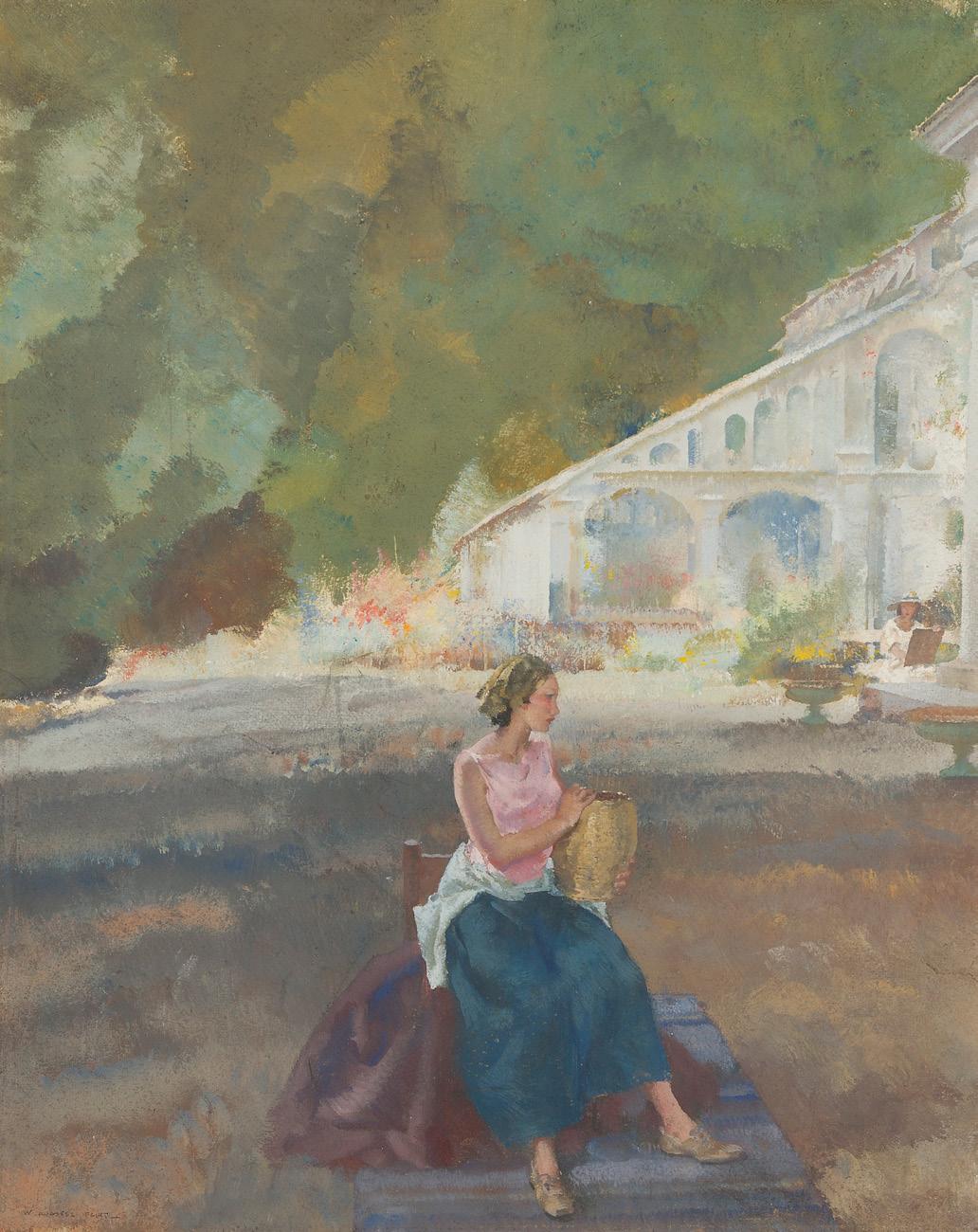
£4,000-6,000
60 §
SIR WILLIAM RUSSELL FLINT P.R.A., P.R.W.S., R.S.W., R.O.I., R.E. (SCOTTISH 1880-1969)
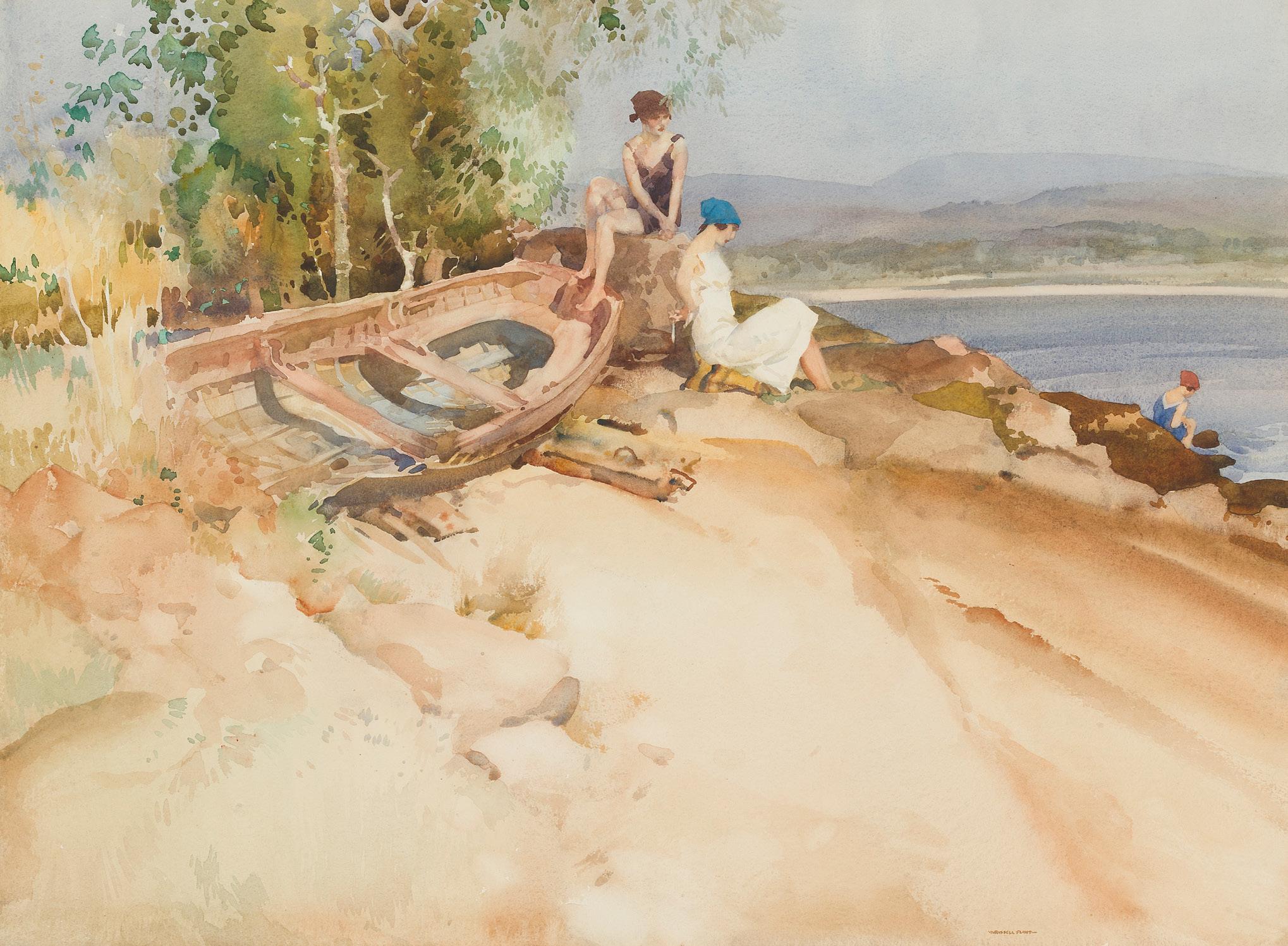
FLORA AT GREAT ENGLEBOURNE
Signed, mixed media
51cm x 41cm (20in x 16in)
£2,000-3,000
38 Other fees apply in addition to the hammer price: see the ‘Buyer’s Guide’ section on page 2
SIR WILLIAM RUSSELL FLINT P.R.A., P.R.W.S., R.S.W., R.O.I., R.E. (SCOTTISH 1880-1969)
SUNKEN BATHS
Signed, watercolour
68cm x 51cm (26.5in x 20in)
£4,000-6,000
62 §
SIR WILLIAM RUSSELL FLINT P.R.A., P.R.W.S., R.S.W., R.O.I., R.E. (SCOTTISH 1880-1969)
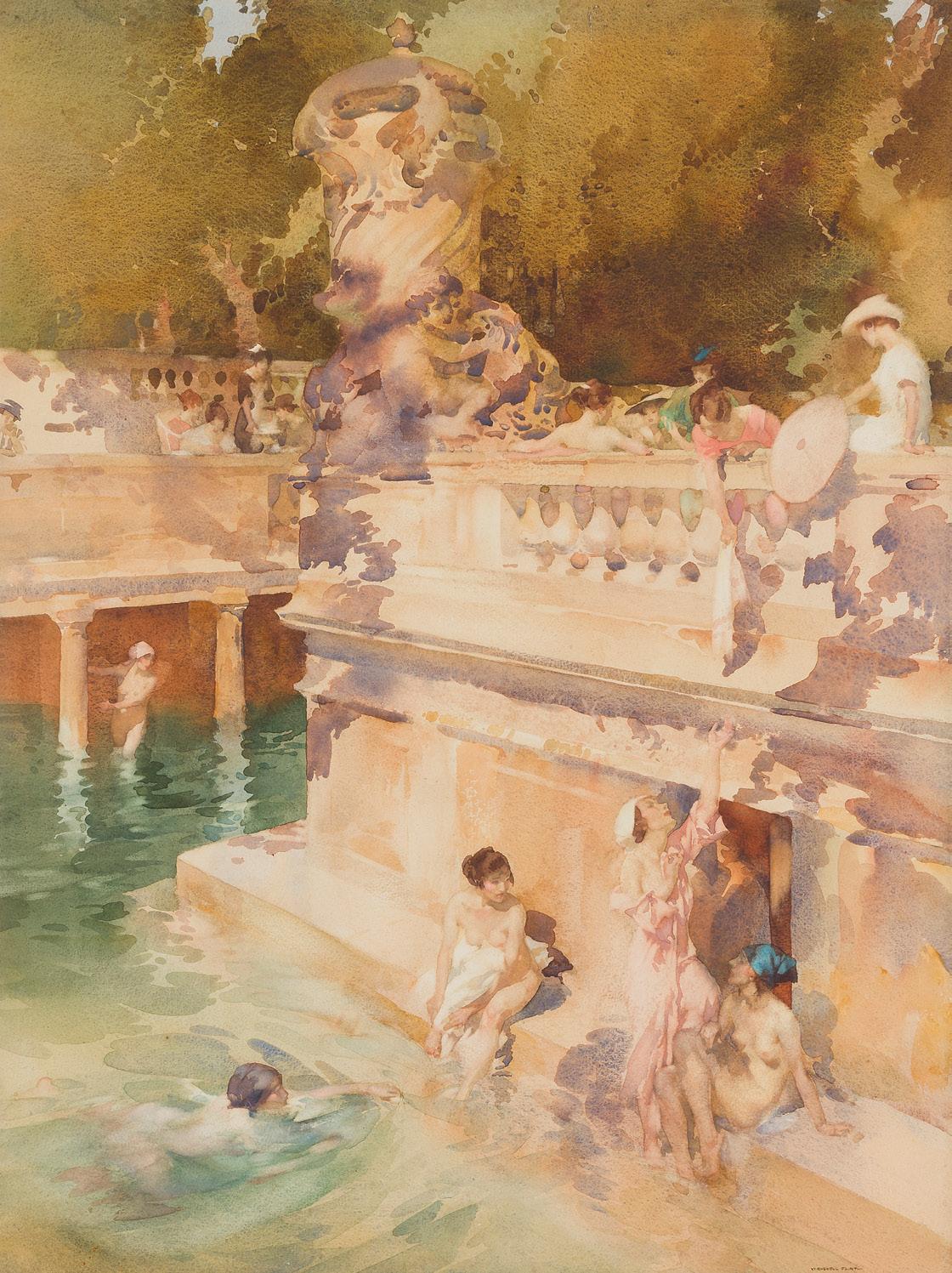
STREET CORNER, SOSPEL
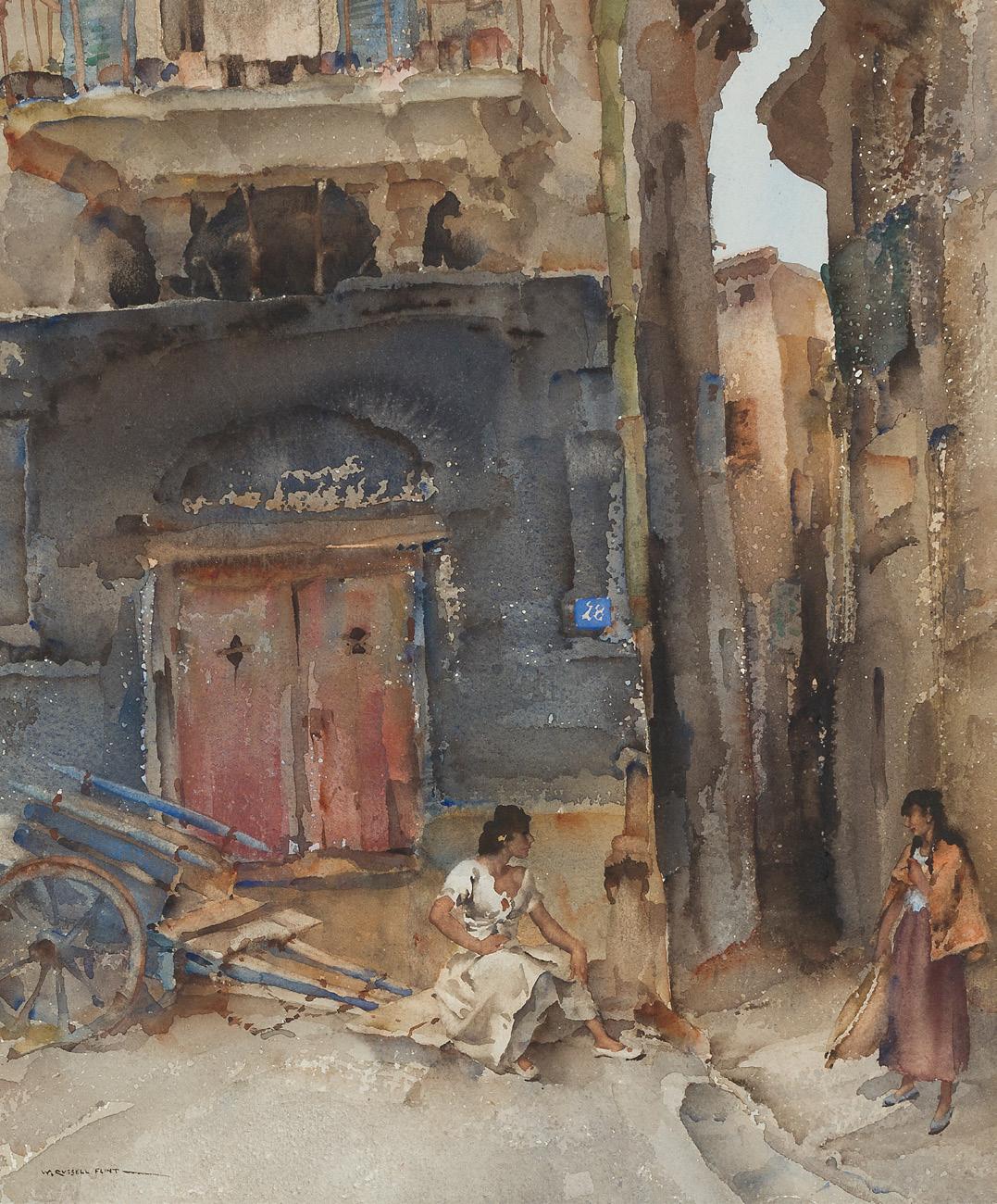
Signed, watercolour
37cm x 31cm (14.5in x 12.25in)
£2,000-3,000
61 §
39
ALFRED DE BREANSKI SENIOR (BRITISH 1852-1928)
LOCH KATRINE

Signed, signed and inscribed verso, oil on canvas, and a companion, ‘A Highland Landscape’, a pair (2)

30.5cm x 51cm (12in x 20in)
£5,000-7,000
63
40 Other fees apply in addition to the hammer price: see the ‘Buyer’s Guide’ section on page 2
64
GEORGE SMITH R.S.A. (SCOTTISH 1870-1934)
UNLOADING THE HAY
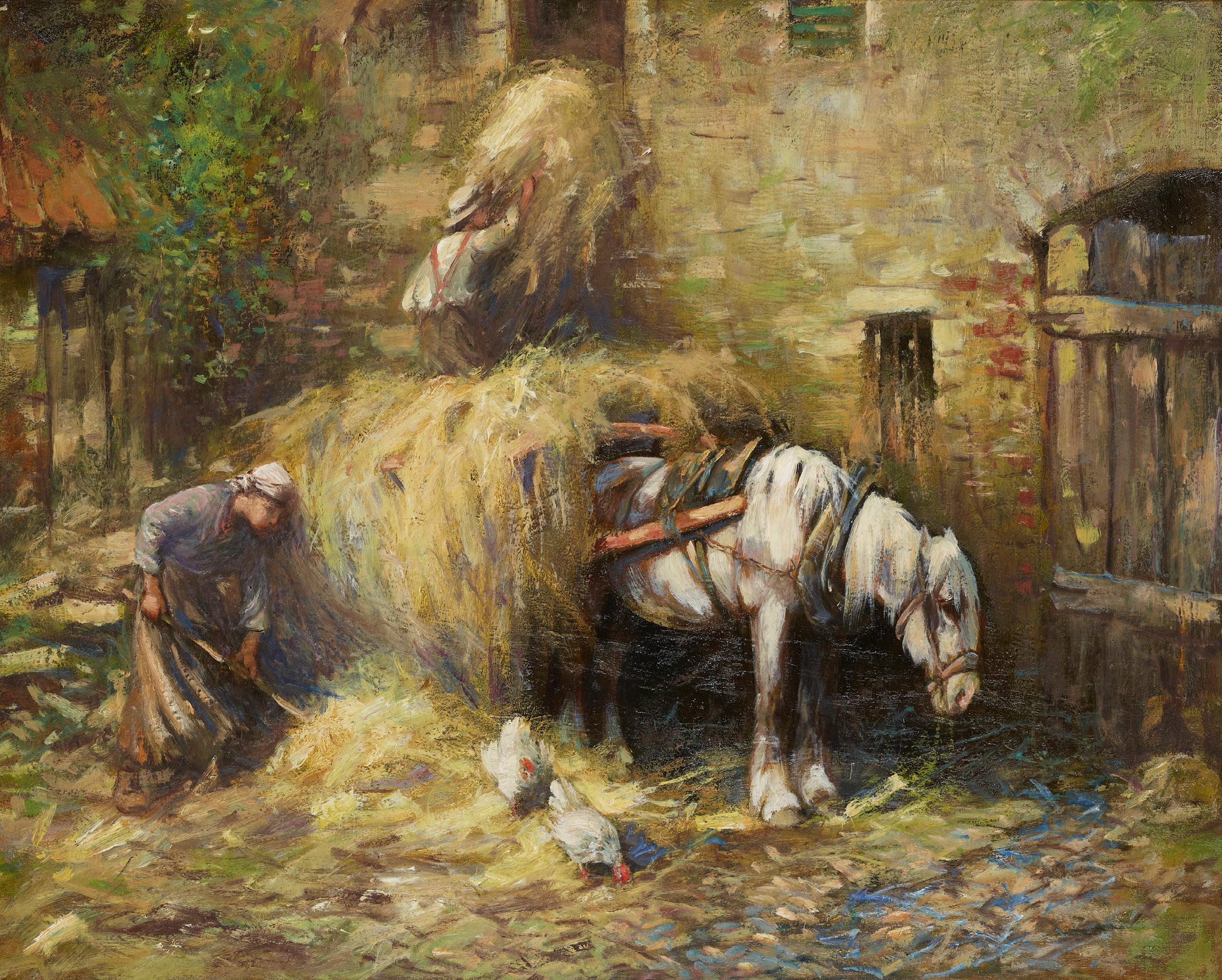
Oil on canvas
71cm x 91cm (28in x 36in)
Provenance: Private Collection, Scotland
£2,000-3,000
41
65
ALEXANDER
BROWNLIE DOCHARTY (SCOTTISH 1862-1940)
BY THE LOCH, AUTUMN

Signed, oil on canvas
86cm x 112cm (33.75in x 44in)
£1,000-1,500
66
SIR DAVID YOUNG
CAMERON R.A., R.S.A., R.W.S., R.S.W., R.E. (SCOTTISH 1865-1945)
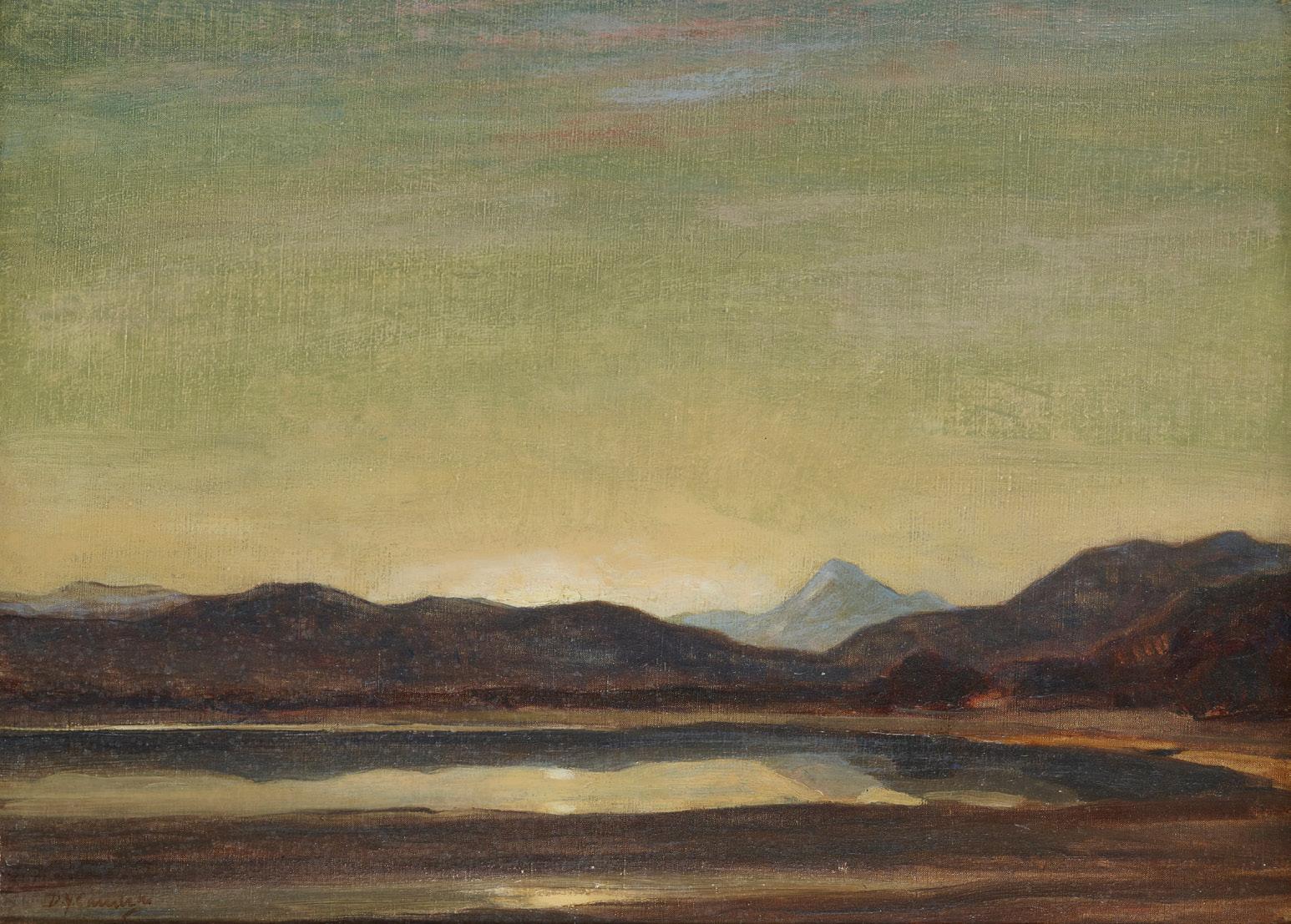
KENTALLEN
Signed, oil on canvas
28cm x 36cm (11in x 14in)
£1,200-1,800
42
67
JOSEPH MORRIS HENDERSON R.S.A. (SCOTTISH 1864-1936)
HARVEST TIME
Signed, oil on canvas 36cm x 53cm (14in x 21in)
£800-1,200
68
HORATIO MCCULLOCH R.S.A. (SCOTTISH 1805-1867)
A REST BY THE WAY
Signed, dated 1840 verso, oil on panel 29.5cm x 34.5cm (11.5in x 13.5in)
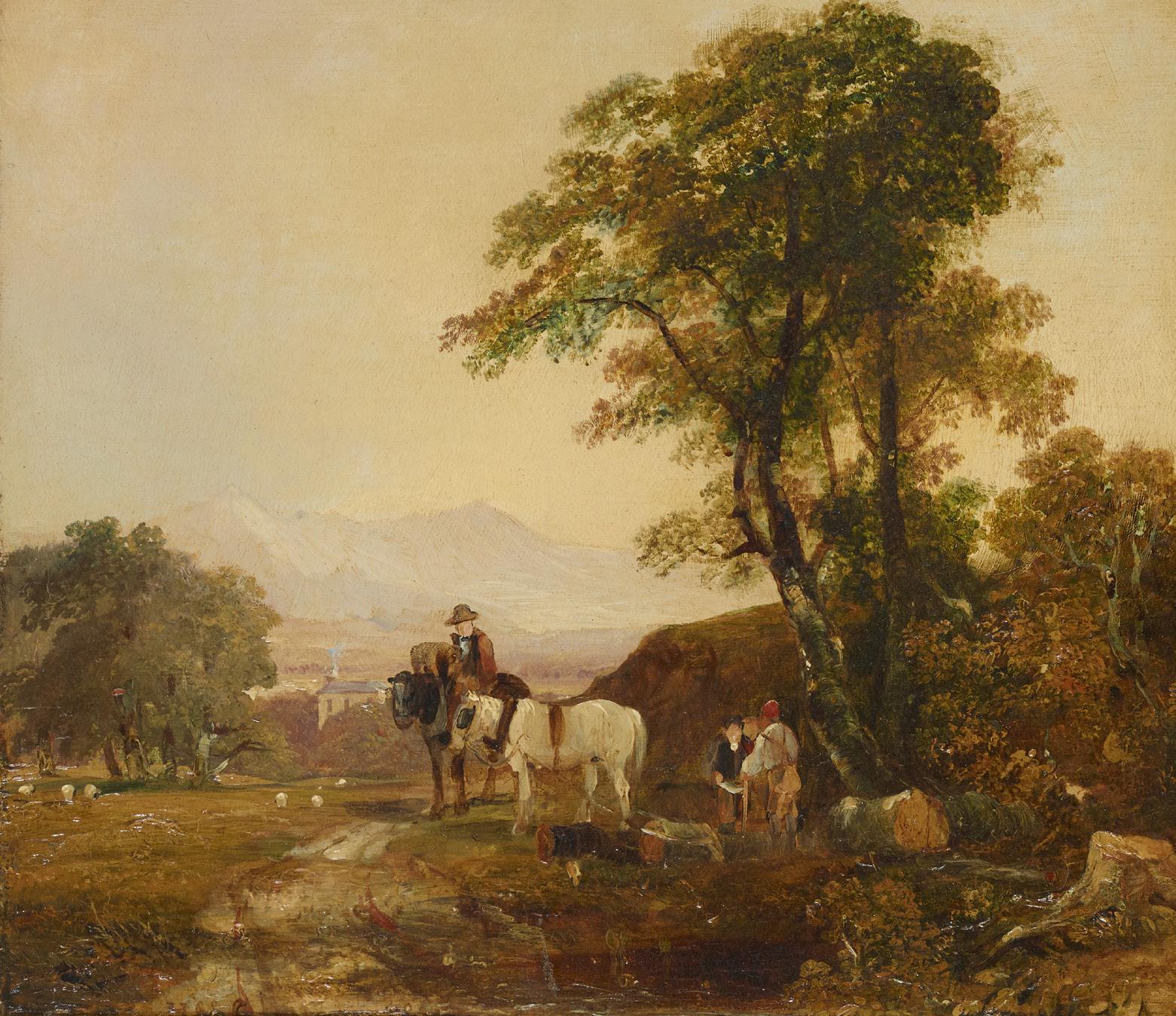
£800-1,200
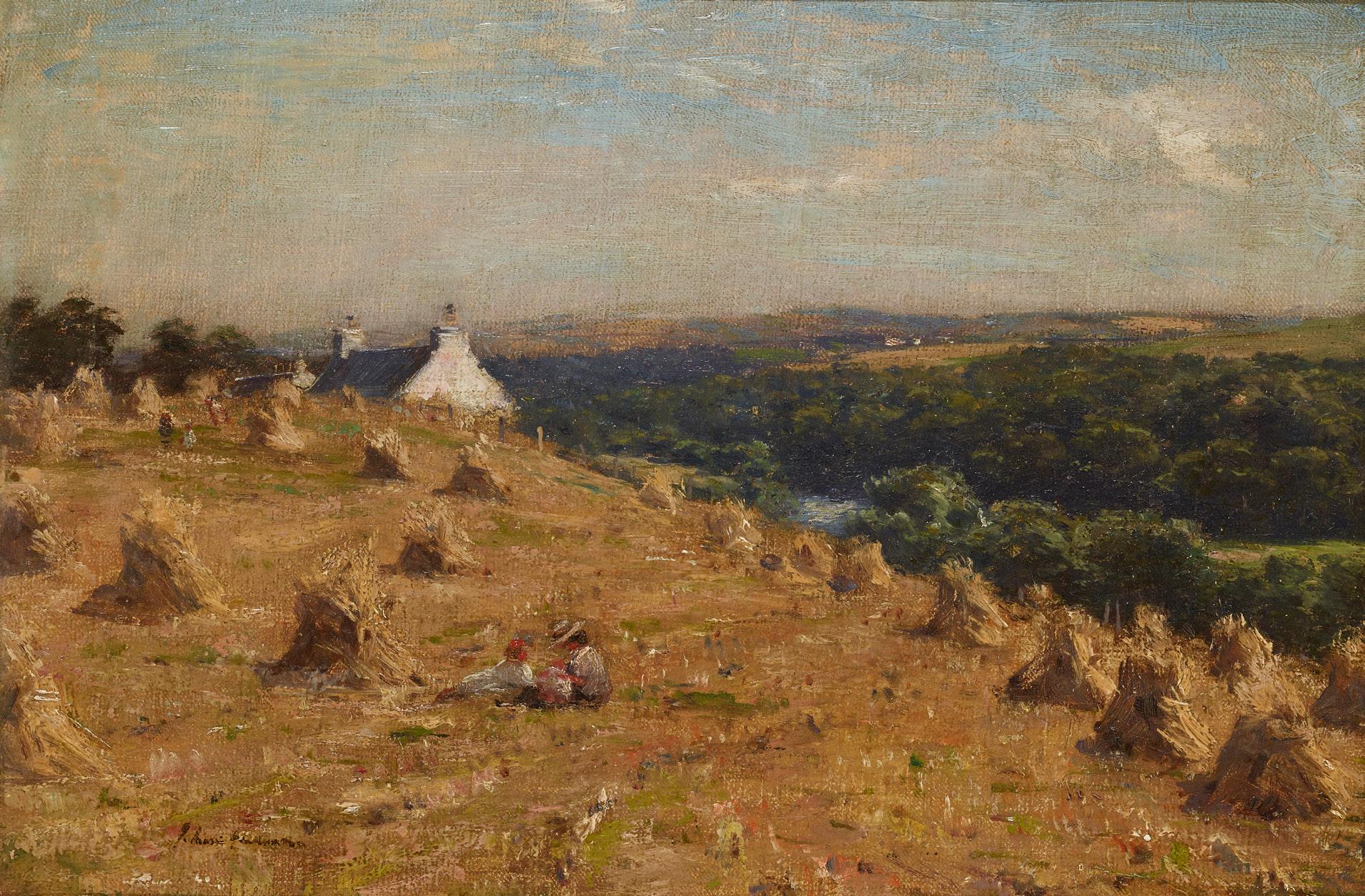
43 Other fees apply in addition to the hammer price: see the ‘Buyer’s Guide’ section on page 2
69
DAVID GAULD R.S.A. (SCOTTISH 1865-1936)
CALVES IN A BYRE
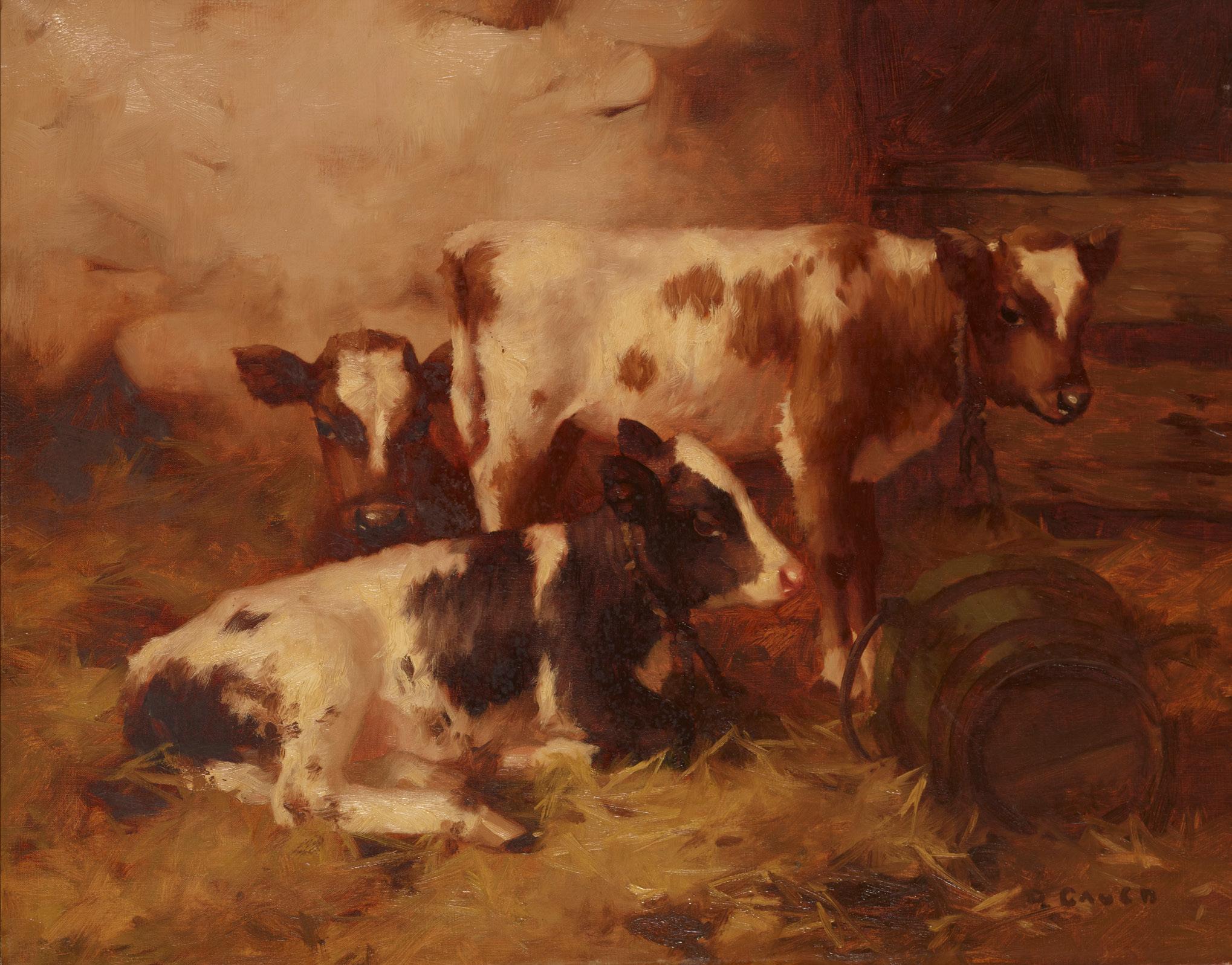
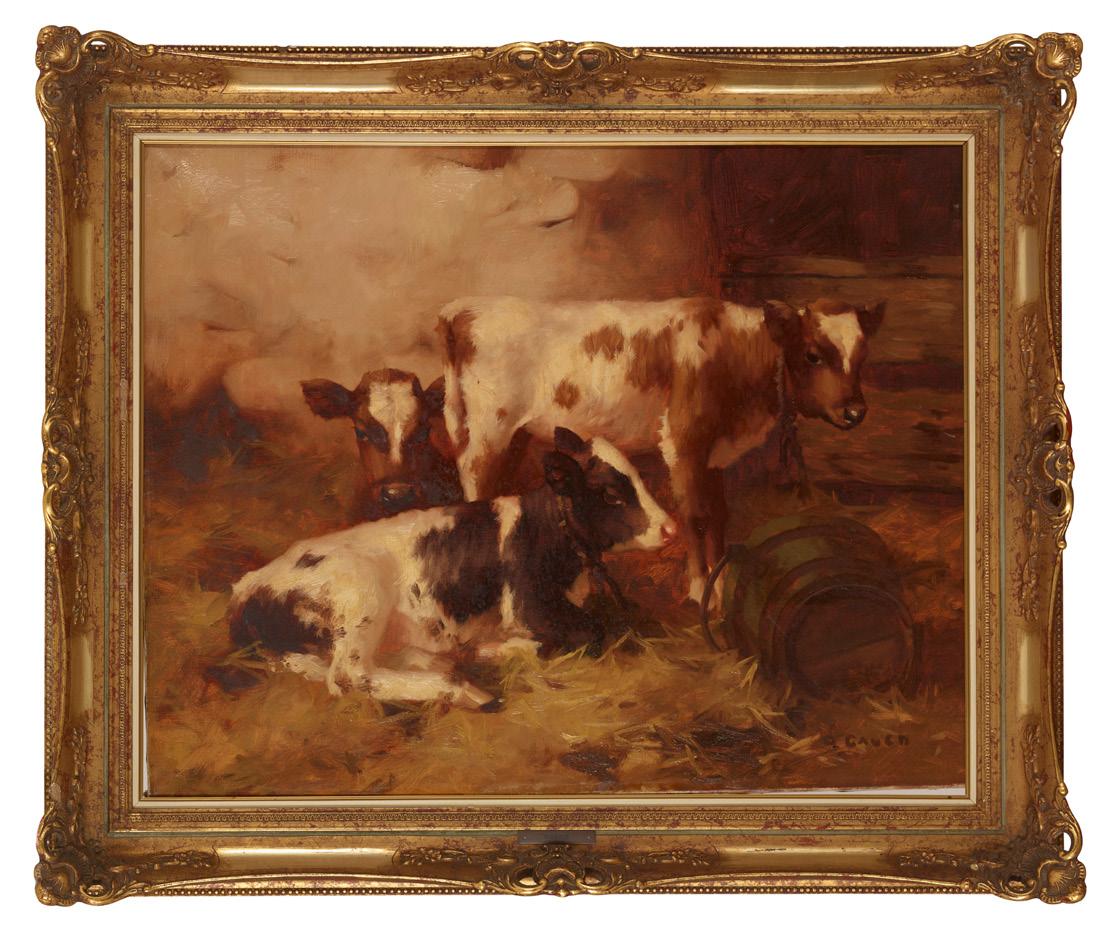 Signed, oil on canvas
61cm x 76cm (24in x 30in)
Signed, oil on canvas
61cm x 76cm (24in x 30in)
44 Other fees apply in addition to the hammer price: see the ‘Buyer’s Guide’ section on page 2
£3,000-5,000
ROAD
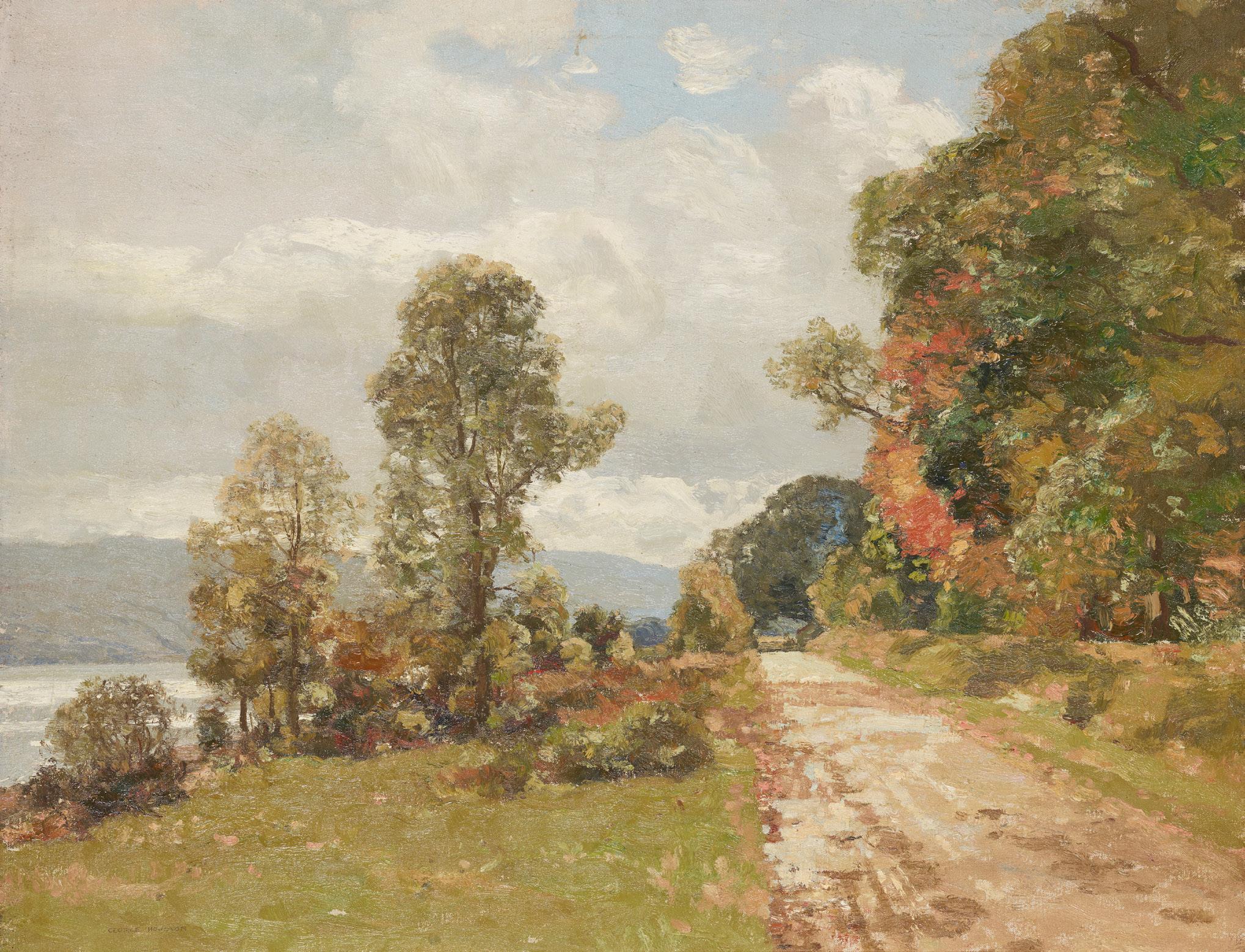
£1,500-2,000

70
GEORGE HOUSTON R.S.A, R.S.W., R.G.I. (SCOTTISH 1869-1947)
BY THE LOCH, AUTUMN Signed, oil on canvas 71cm x 91cm (28in x 36in)
45
71
GEORGE HOUSTON
R.S.A, R.S.W., R.G.I. (SCOTTISH 1869-1947)
BEACHED ROWING
BOAT, IONA
Signed, inscribed and dated ‘Iona 1901’, oil on canvas
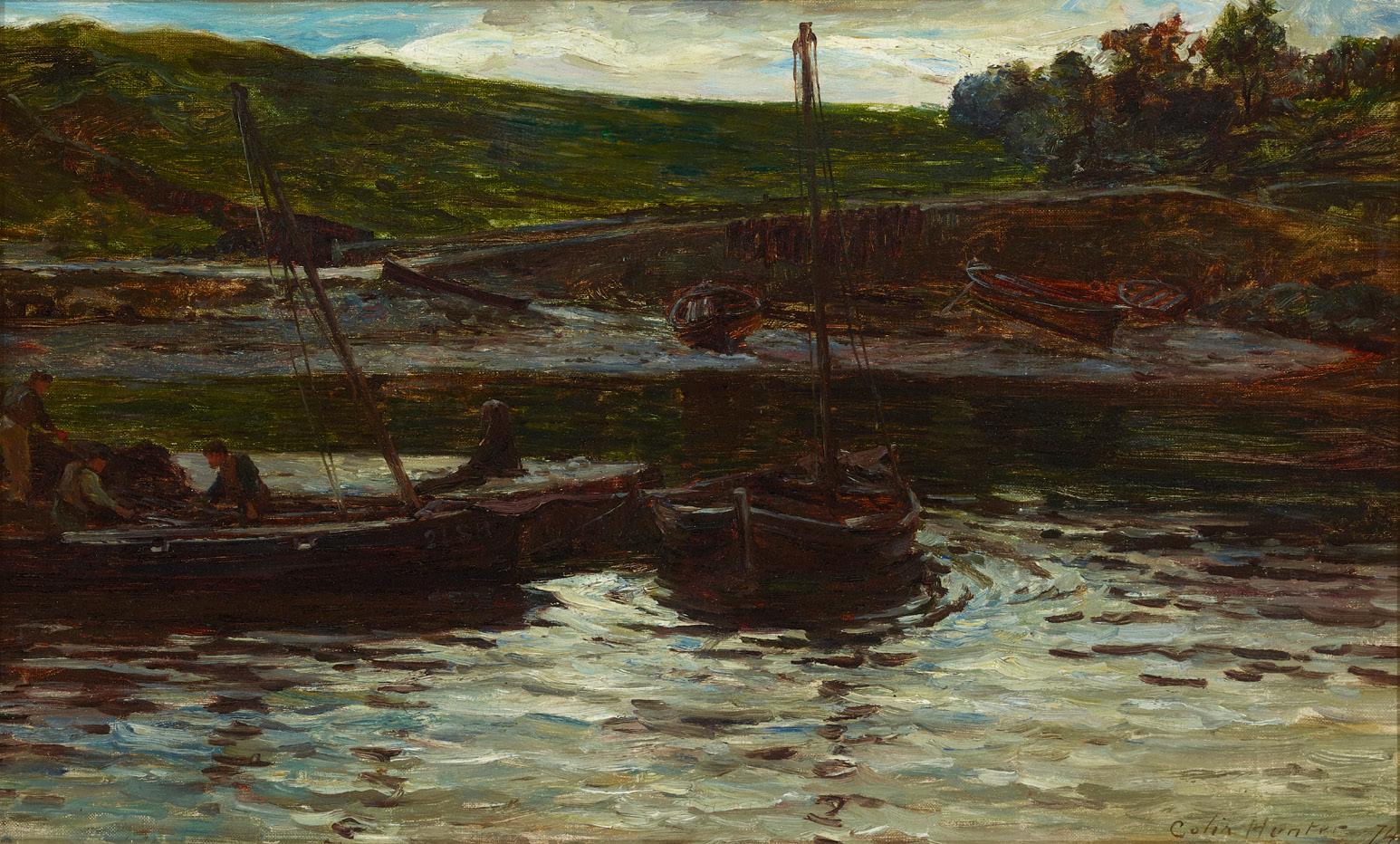

46cm x 66cm (18in x 26in)
£1,000-1,500
72
COLIN HUNTER
A.R.A., R.I., R.S.W., R.E. (SCOTTISH 1841-1904)
UNLOADING THE CATCH
Signed and dated ‘74, oil on canvas
36cm x 56cm (14in x 22in)
£600-800
46 Other fees apply in addition to the hammer price: see the ‘Buyer’s Guide’ section on page 2
WILLIAM PAGE
ATKINSON WELLS (SCOTTISH 1872-1923)
FISHERMEN NETTING IN AN ESTUARY Signed, oil on canvas
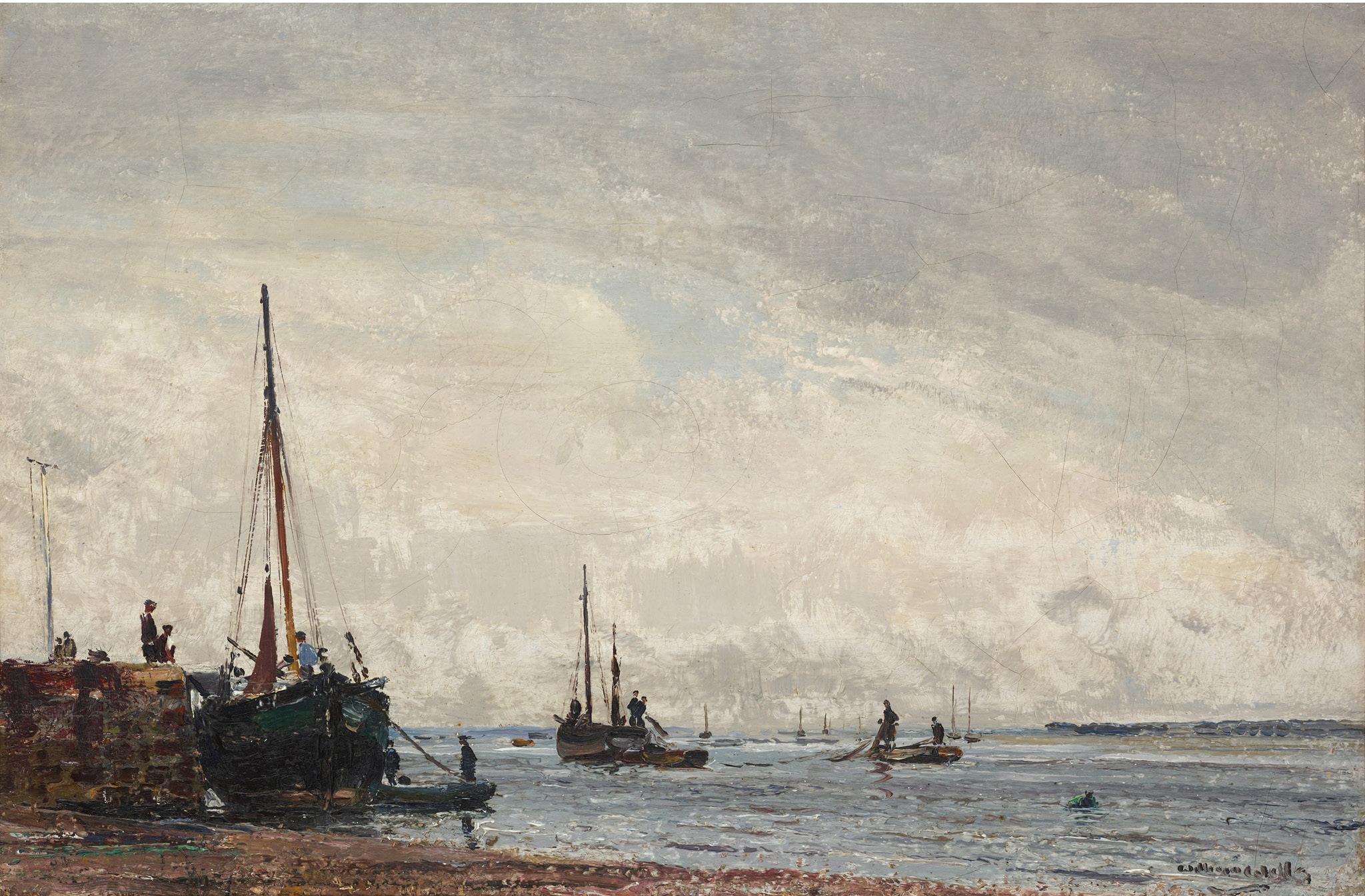
30.5cm x 46cm (12in x 18in)
£800-1,200
WILLIAM PAGE
ATKINSON WELLS (SCOTTISH 1872-1923)
DOWN TO THE BEACH Signed, oil on canvas
30.5cm x 46cm (12in x 18in)
£800-1,200
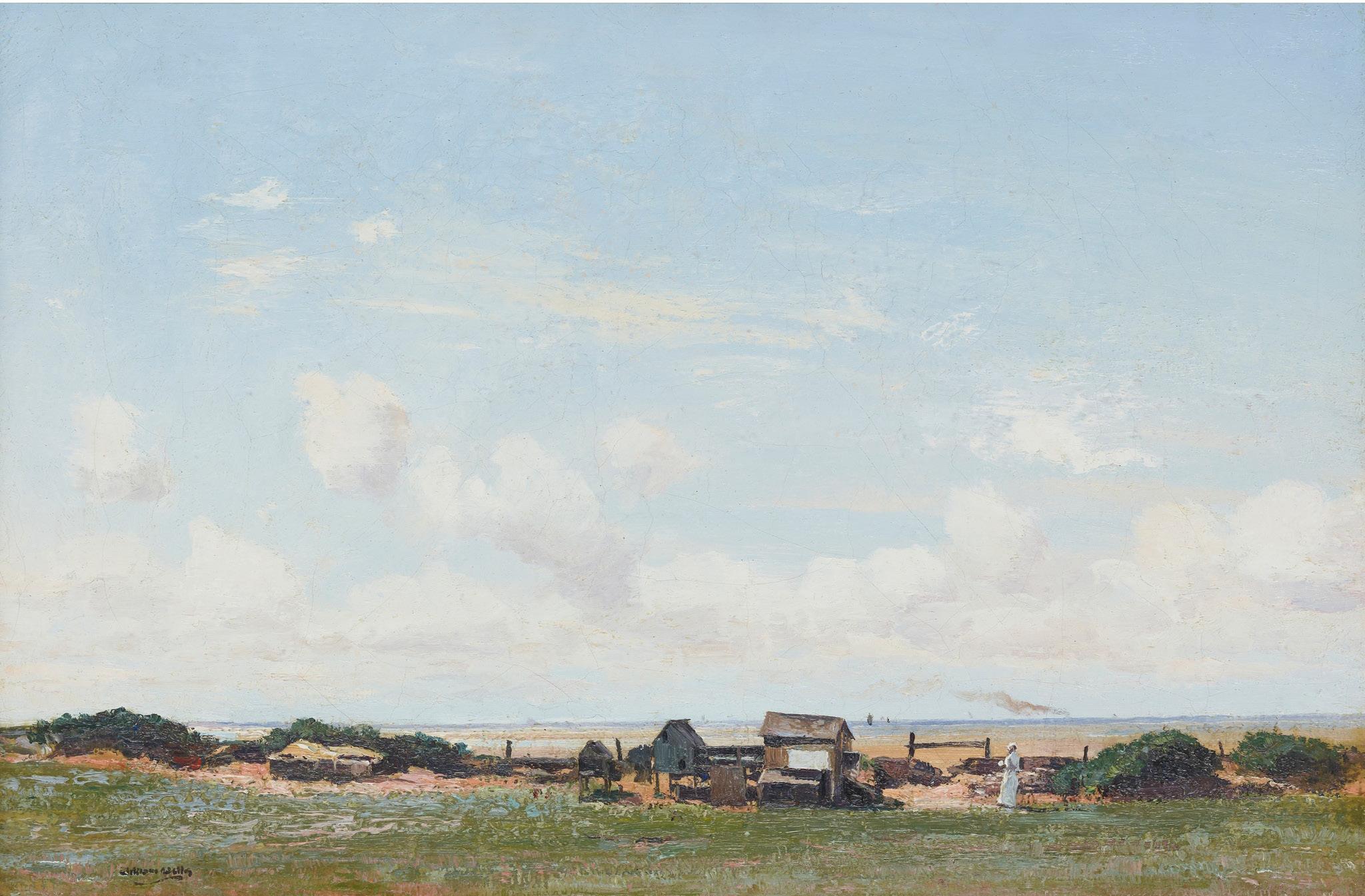 73
74
73
74
47
75
JAMES PATERSON
R.S.A., R.S.W., R.W.S. (SCOTTISH 1854-1932)
THE MILL
Signed, inscribed and dated ‘Moniaive 1890’, oil on canvas
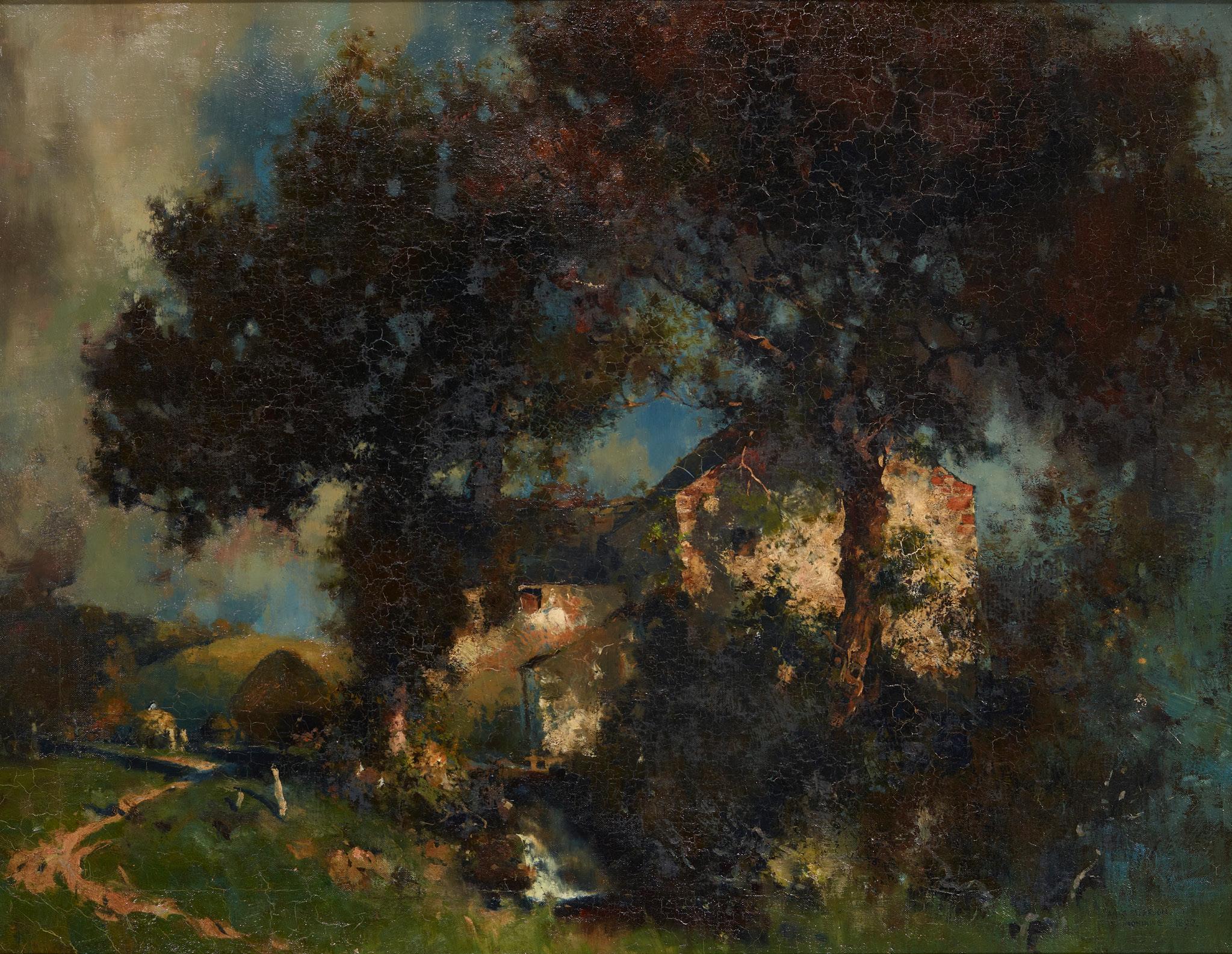

71cm x 91cm (28in x 36in)
Note: Paterson exhibited a painting entitled ‘The Mill’ at the Royal Scottish Academy, Edinburgh in 1892 (no. 453).
£2,000-3,000
48
JAMES PATERSON R.S.A., R.S.W., R.W.S. (SCOTTISH 1854-1932)
THE LAST OF THE INDOMITABLE, AMSTERDAM HARBOUR

Signed and dated 1910, oil on canvas 51cm x 61cm (20in x 24in) £5,000-7,000

76
49 Other fees apply in addition to the hammer price: see the ‘Buyer’s Guide’ section on page 2
77
JAMES
WATTERSTON
HERALD (SCOTTISH 1859-1914)
FIGURES IN THE CHURCH SQUARE Watercolour
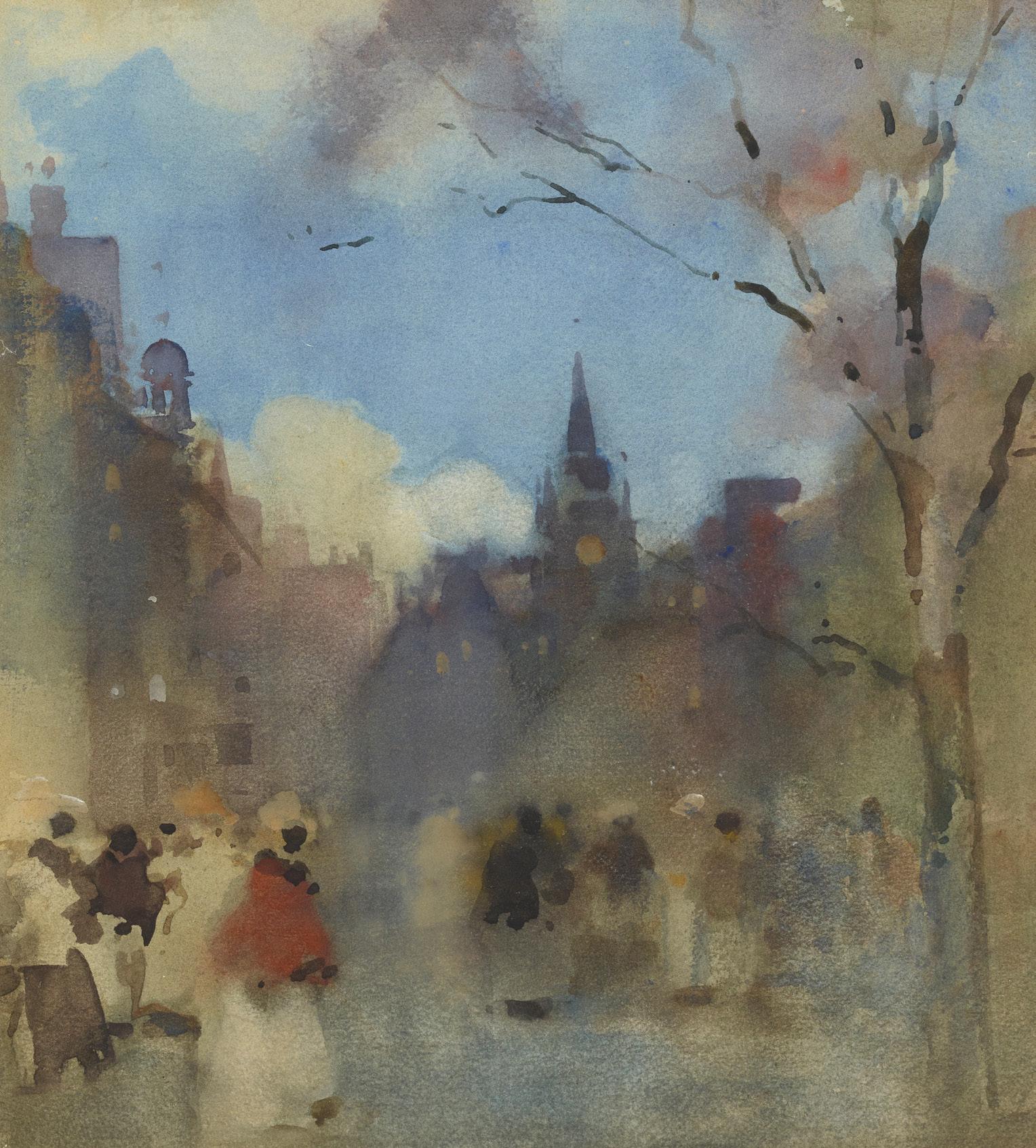
36cm x 32cm (14in x 12.5in) £1,000-1,500
78 §
JAMES COWIE R.S.A., L.L.D. (SCOTTISH 1886-1956) FARM BUILDINGS, HOSPITALFIELD

Mixed media
29cm x 32.5cm (11.5in x 12.75in)
Exhibited: Bourne Fine Art, London, James Cowie, December 1987
£600-800
50
79 §
CHRISTIAN JANE FERGUSSON (SCOTTISH 1876-1957)
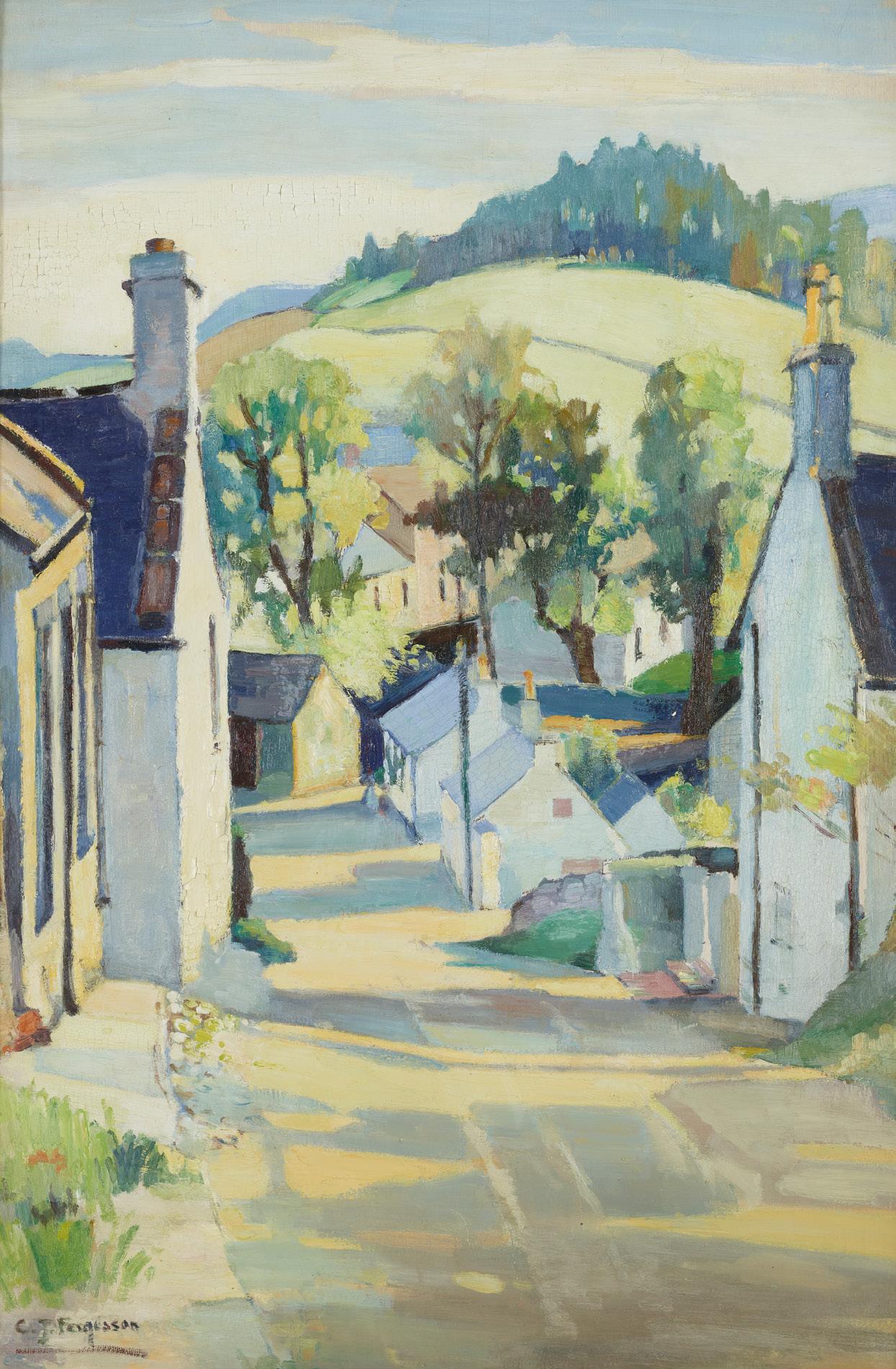
EARLY SUMMER, MONIAIVE Signed, oil on board
76cm x 51cm (30in x 20in)
Exhibited: Paisley Art Institute, Paisley, no.1 £1,000-1,500
80
JOSEPH CRAWHALL R.S.W (SCOTTISH 1861-1913)
ALAN WITH DEVIL’S TAIL
Watercolour with traces of inscription

17cm x 11cm (6.75in x 4.25in)
Provenance: Miss E. C. Challoner, the Artist’s niece
Note: A painting of the same title is listed in Adrian Bury, Joseph Crawhall: The Man and the Artist, Charles Skilton, London, 1958, p.232
£800-1,200
51 Other fees apply in addition to the hammer price: see the ‘Buyer’s Guide’ section on page 2
81 §
ERNEST ARCHIBALD TAYLOR (SCOTTISH 1874-1951)
BIRDS IN FLIGHT OVER FIRS
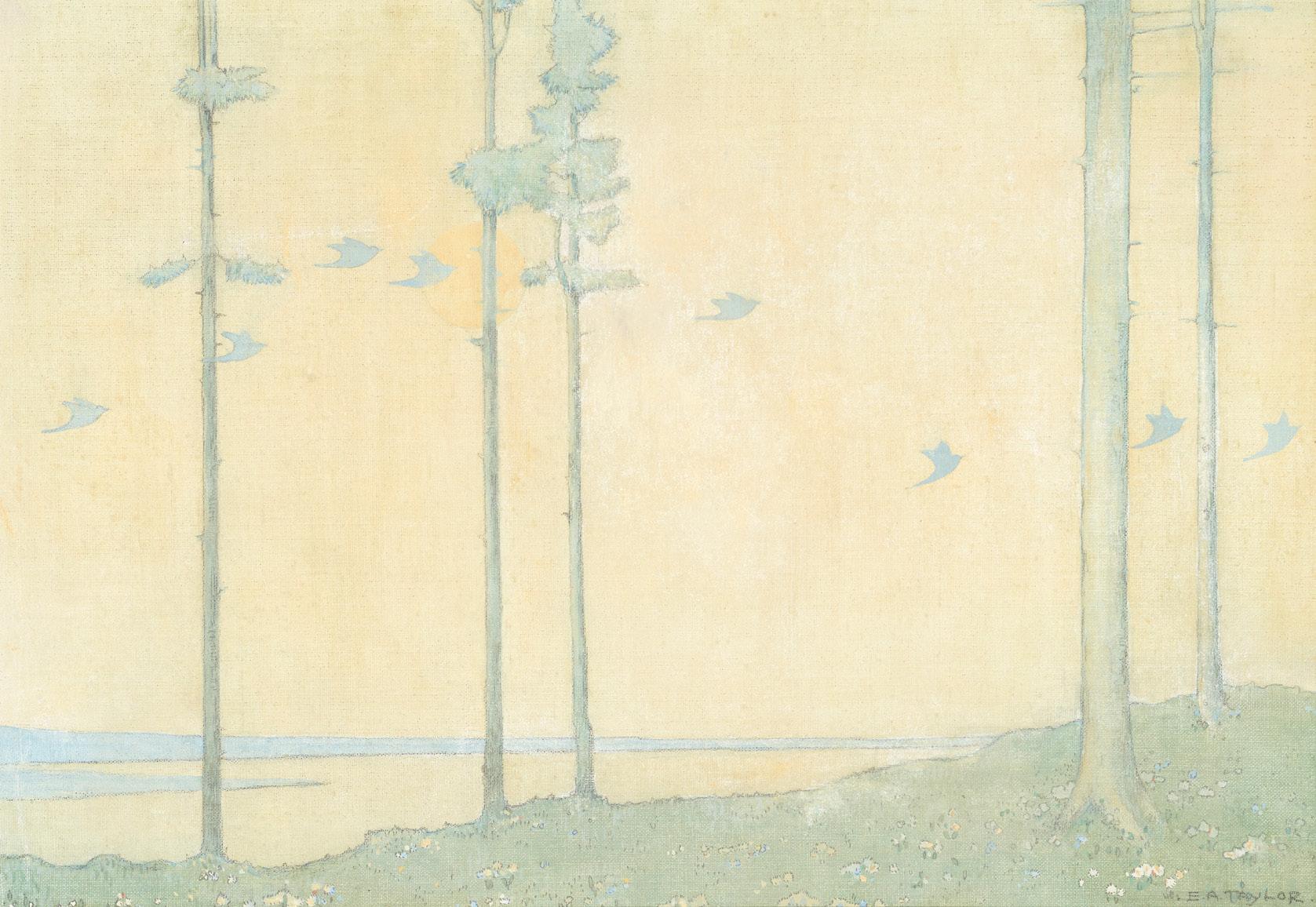
Signed, mixed media on linen
25.5cm x 38cm (10in x 15in)
£800-1,200
82
JOHN SMELLIE (SCOTTISH 1886-1925)
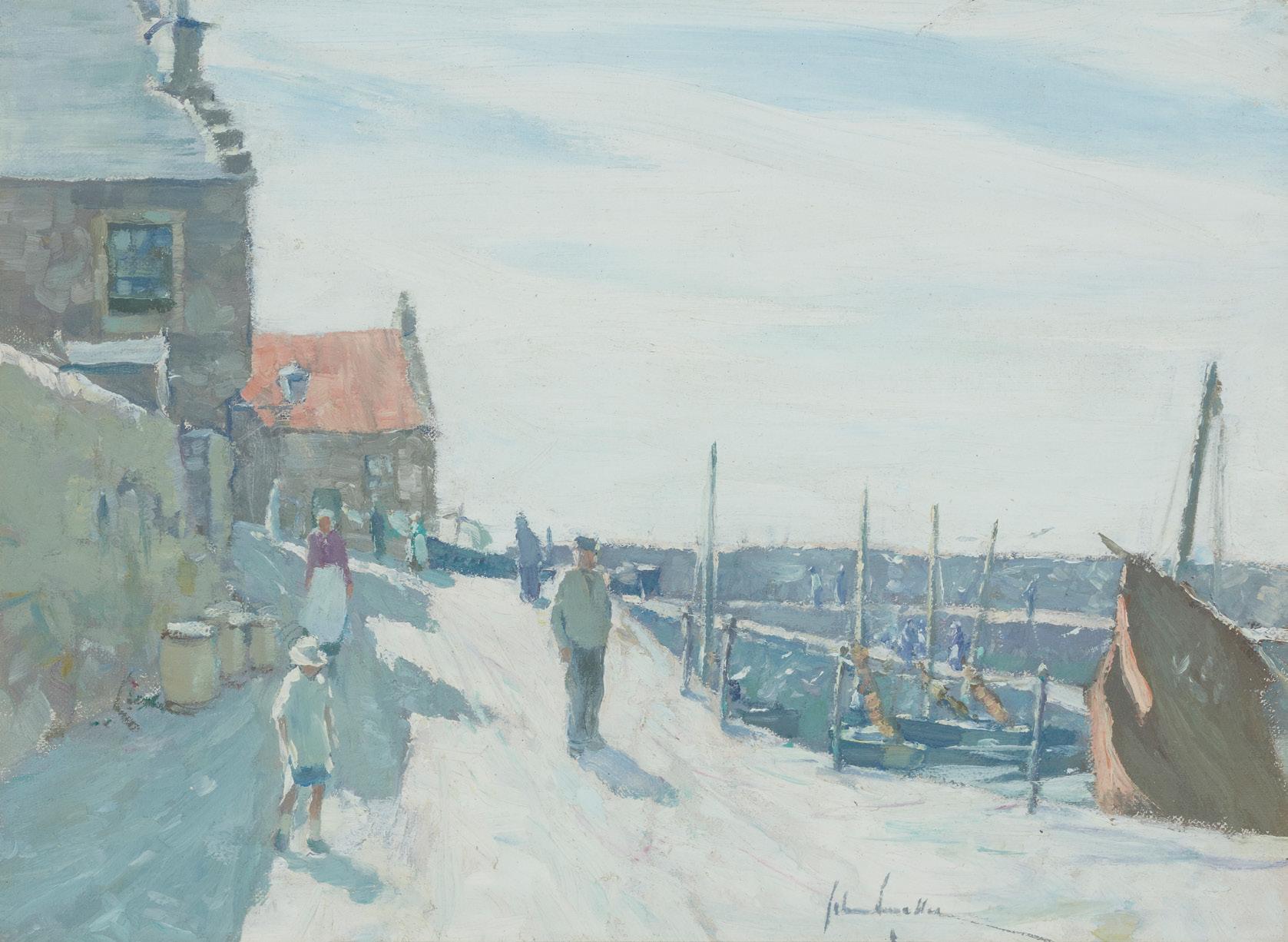
CRAIL
Signed, oil on board
23cm x 30.5cm (9in x 12in)
£600-800
52
83 §
DAVID MICHIE O.B.E., R.S.A., R.G.I., F.R.S.A (SCOTTISH 1928-2015)
HARBOUR SCENE

Signed, oil on canvas
56cm x 76cm (22in x 30in) £800-1,200
84
GEORGE LESLIE HUNTER (SCOTTISH 1877-1931)
PANTILED COTTAGE, FIFE

Signed, pen and ink and coloured chalk
29cm x 37cm (11.5in x 14.5in) £1,500-2,000
53 Other fees apply in addition to the hammer price: see the ‘Buyer’s Guide’ section on page 2
85 §
ANNE REDPATH O.B.E., R.S.A., A.R.A., L.L.D., A.R.W.S., R.O.I., R.B.A. (SCOTTISH 1895-1965) STILL LIFE
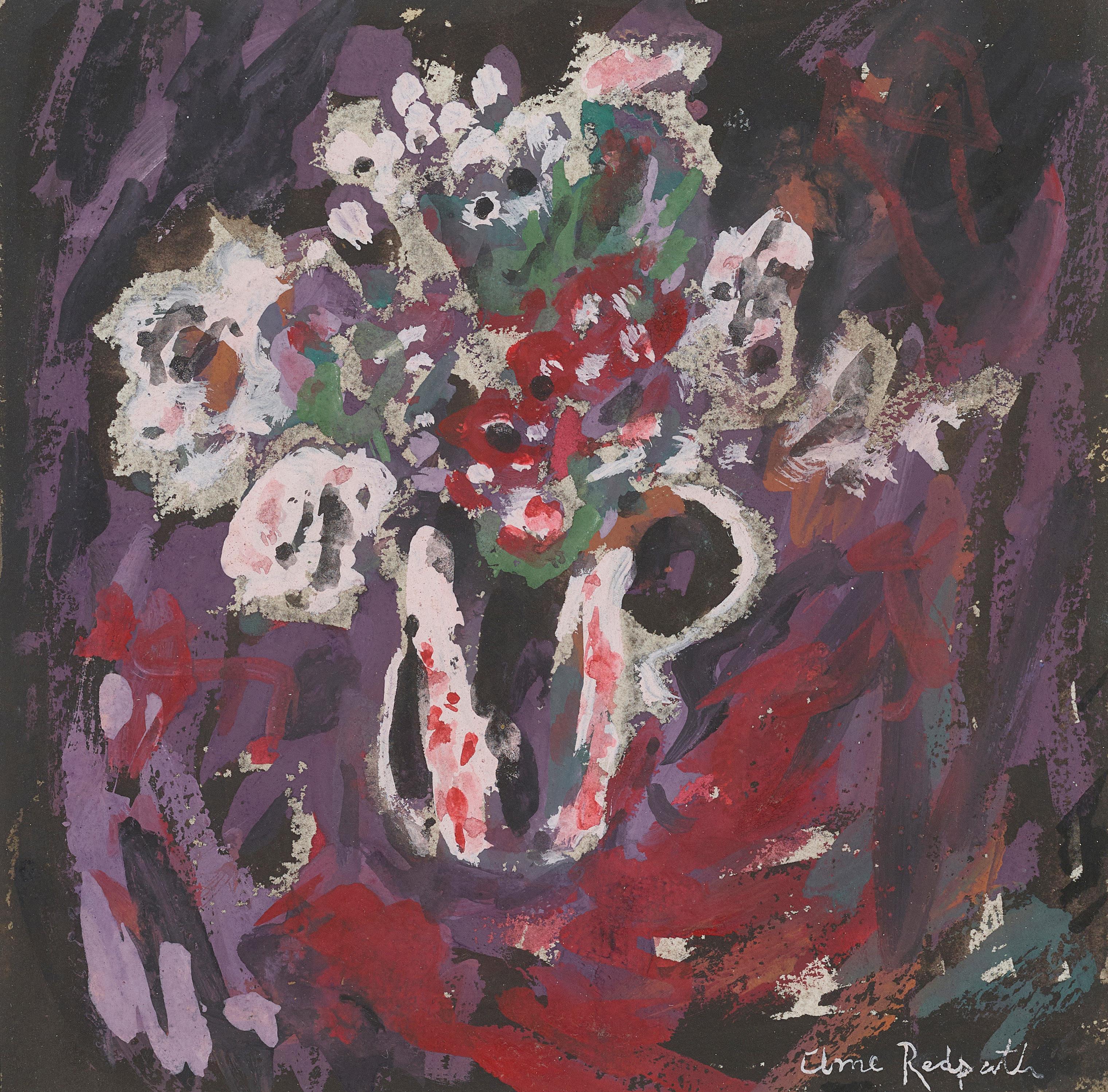
Signed, gouache
20cm x 20cm (8in x 8in)
£2,000-3,000
86 §
MARY NICOL NEILL ARMOUR R.S.A., R.S.W. (SCOTTISH 1902-2000)
FLOWERS WITH BLACK TULIPS
Signed, oil on board
76cm x 63.5cm (30in x 25in)
Provenance: Bonhams, Edinburgh, The Autumn Antique and Picture Sale, 29 October 2015, lot 343, where acquired by the present owner
£2,000-3,000
54 Other fees apply in addition to the hammer price: see the ‘Buyer’s Guide’ section on page 2
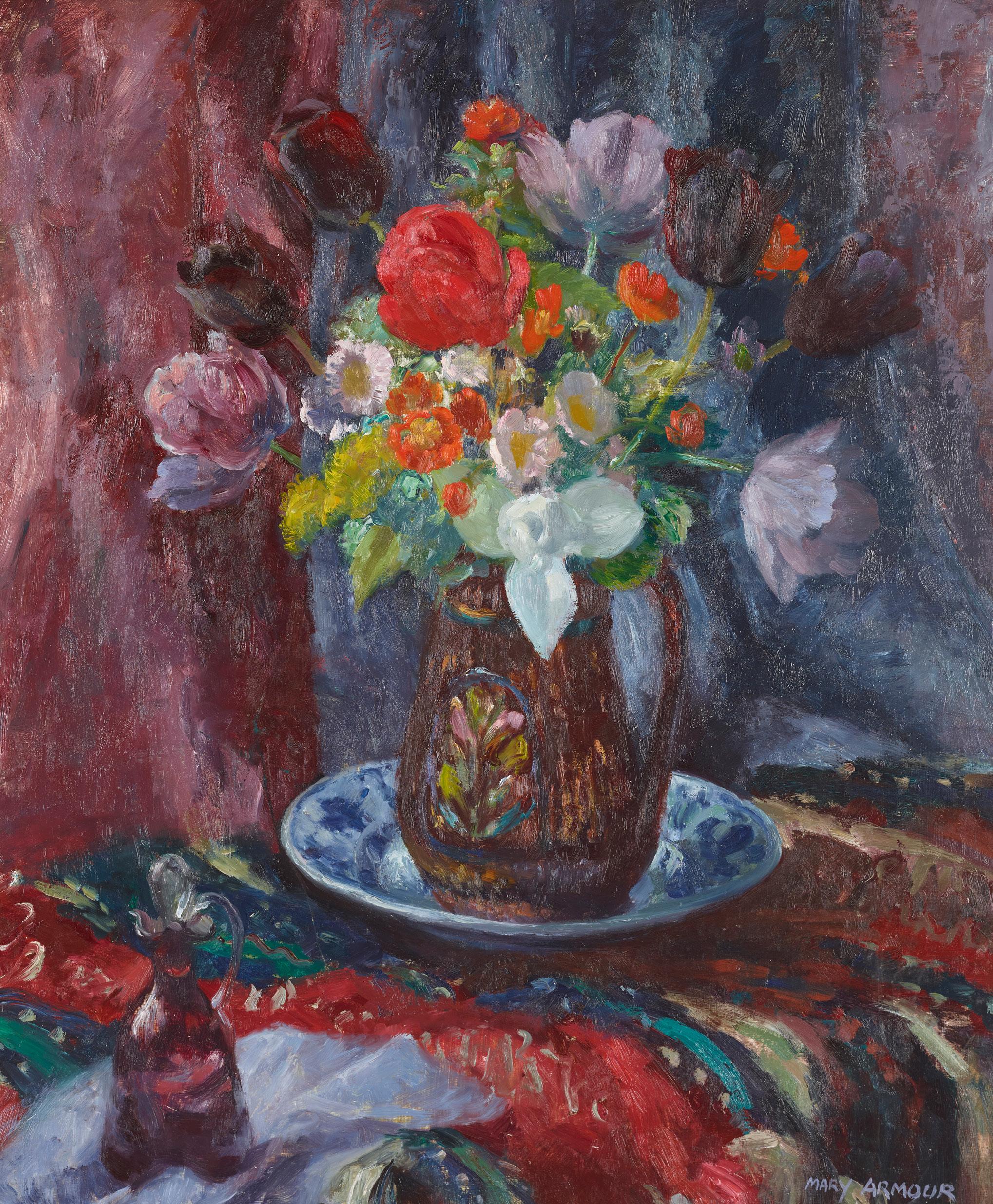
55
87 §
LEON MORROCCO
R.S.A., R.G.I. (SCOTTISH 1942-)
BOATHOUSE SIESTA
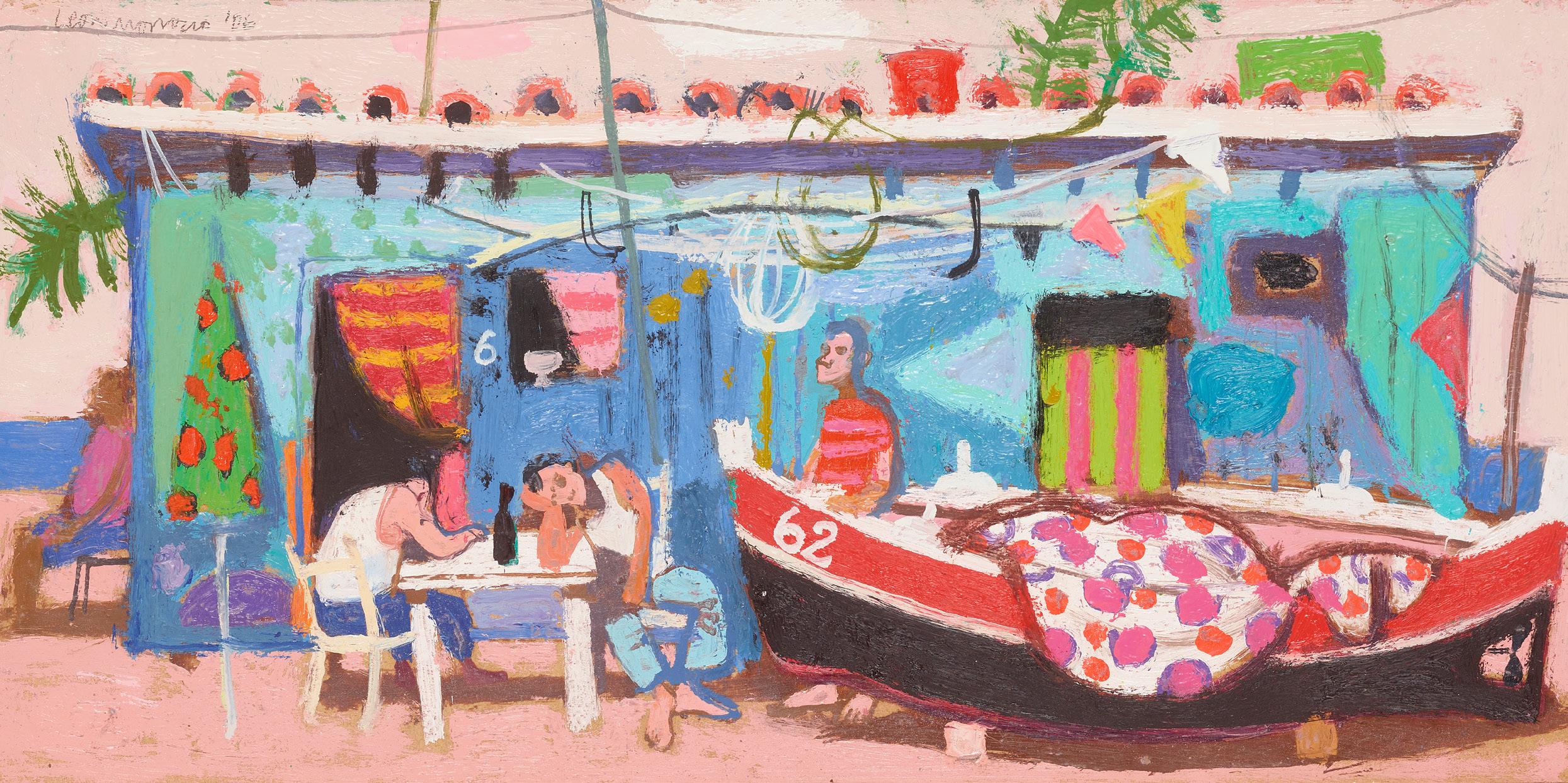
Signed and dated ‘06, oil on board 19cm x 40cm (7.5in x 15.75in)
Provenance: Open Eye Gallery, Edinburgh
£1,500-2,000
88 §
DONALD BAIN (SCOTTISH 1904-1979)
RUE XAVIER PRIVAS, PARIS

Signed, signed, inscribed and dated verso 1946, oil on canvasboard
30.5cm x 24cm (12in x 9.5in)
£600-800
56
89 §
JOHN HOUSTON
R.S.A., R.S.W., S.S.A. (SCOTTISH 1930-2008)
A STILL LIFE OF FRUIT
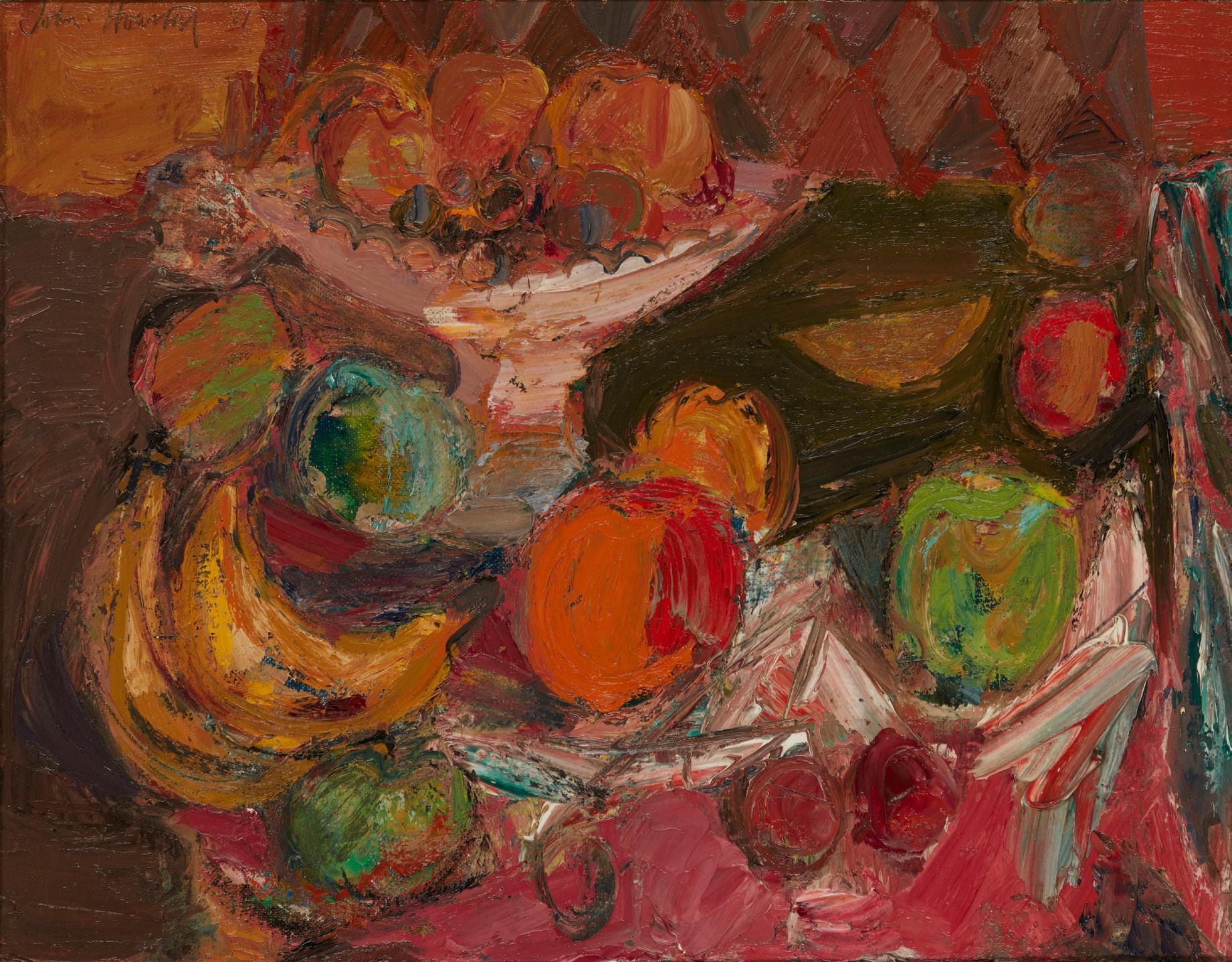
Signed and dated ‘57, oil on canvas
41cm x 51cm (16in x 20in)
Provenance: The Fine Art Society Ltd, Edinburgh Phillips, Edinburgh, The Fine Art Society Edinburgh, 26 May 1992, lot 675 where acquired by the present owner
Exhibited: The Scottish Gallery, Edinburgh, Recent Acquisitions, April-May 1977, no. 54 (as ‘Fruit’) £1,000-1,500
90 §
JOHN CUNNINGHAM (SCOTTISH 1927-2000) PEACHES
Signed, signed and inscribed on the artist’s label verso, oil on board 18cm x 29cm (7in x 11.5in) £1,000-1,500
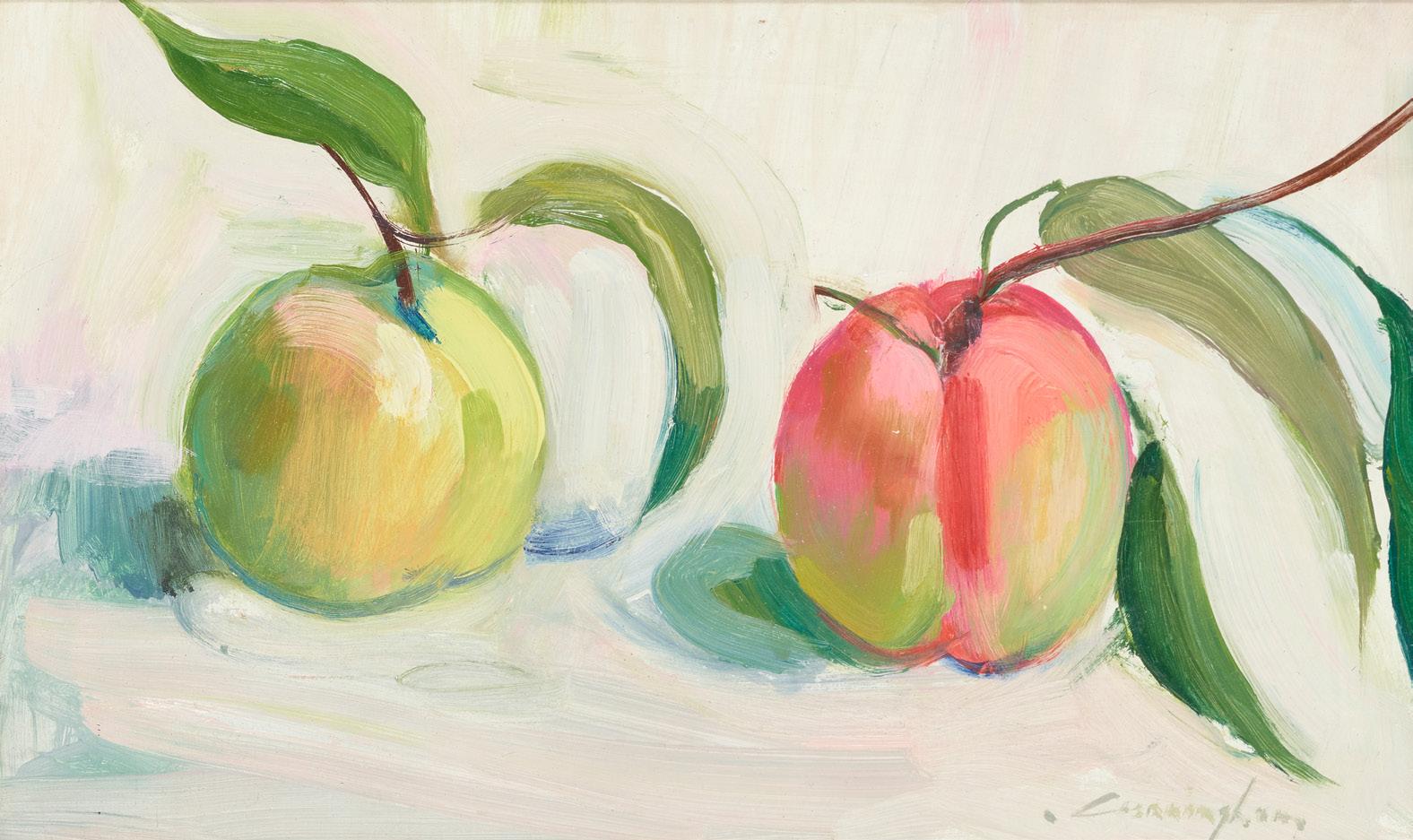
57 Other fees apply in addition to the hammer price: see the ‘Buyer’s Guide’ section on page 2
91 §
JAMES MORRISON R.S.A., R.S.W., L.L.D. (SCOTTISH 1932-2020)
DISTANT MOUNTAINS


Signed and dated 24.VII.2009, oil on board
41cm x 76cm (16in x 30in)
£3,000-5,000
[detail] 58 Other fees apply in addition to the hammer price: see the ‘Buyer’s Guide’ section on page 2
Right Lot 175
SCOTTISH PAINTINGS & SCULPTURE
PART II BEGINS AT 6PM

92
WILLIAM ALFRED GIBSON (SCOTTISH 1866-1931)
BARGES NEAR EDAM
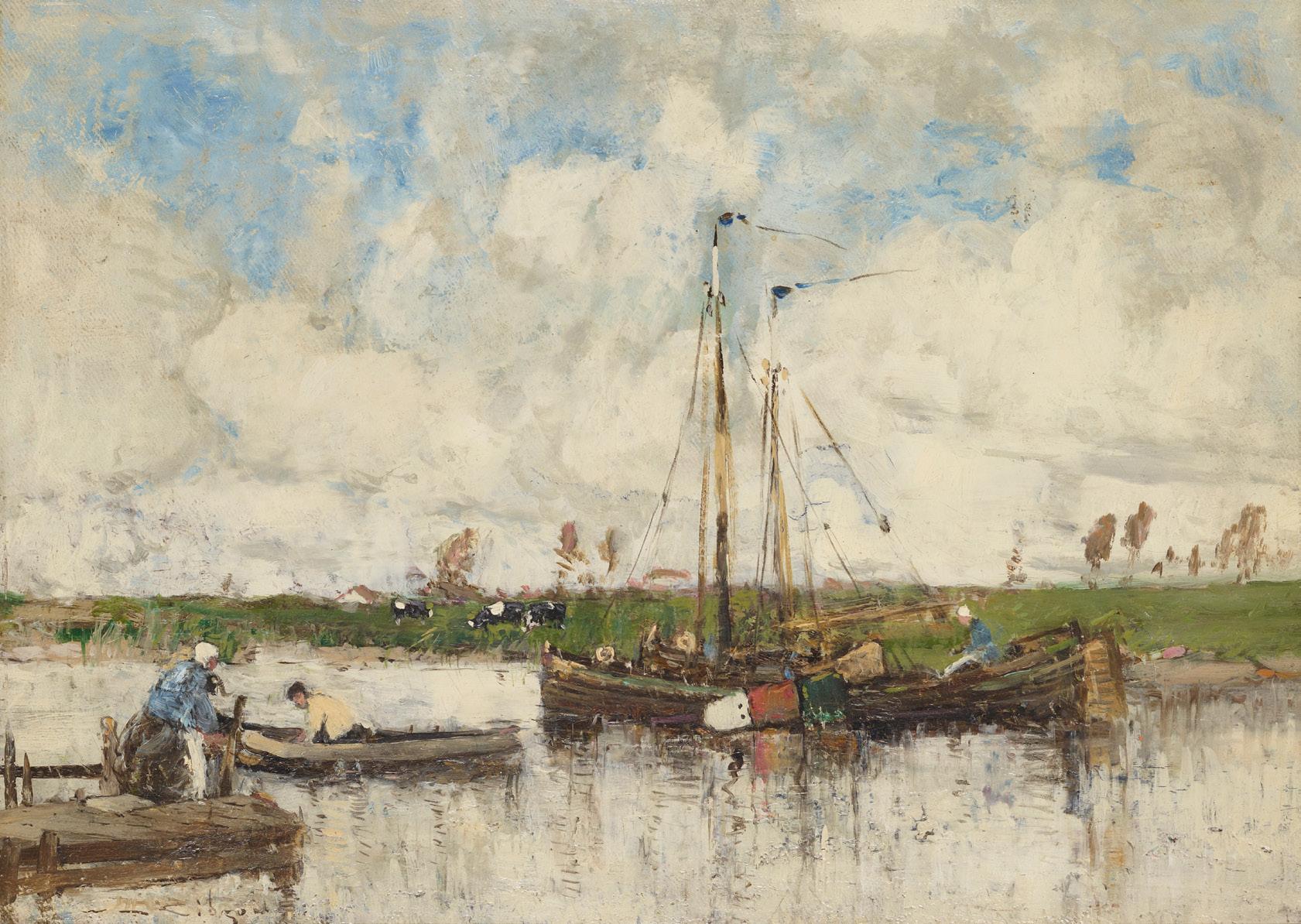
Signed, oil on canvasboard
25.5cm x 36cm (10in x 14in)
£1,000-1,500
93
JAMES CAMPBELL NOBLE R.S.A. (SCOTTISH 1846-1913)
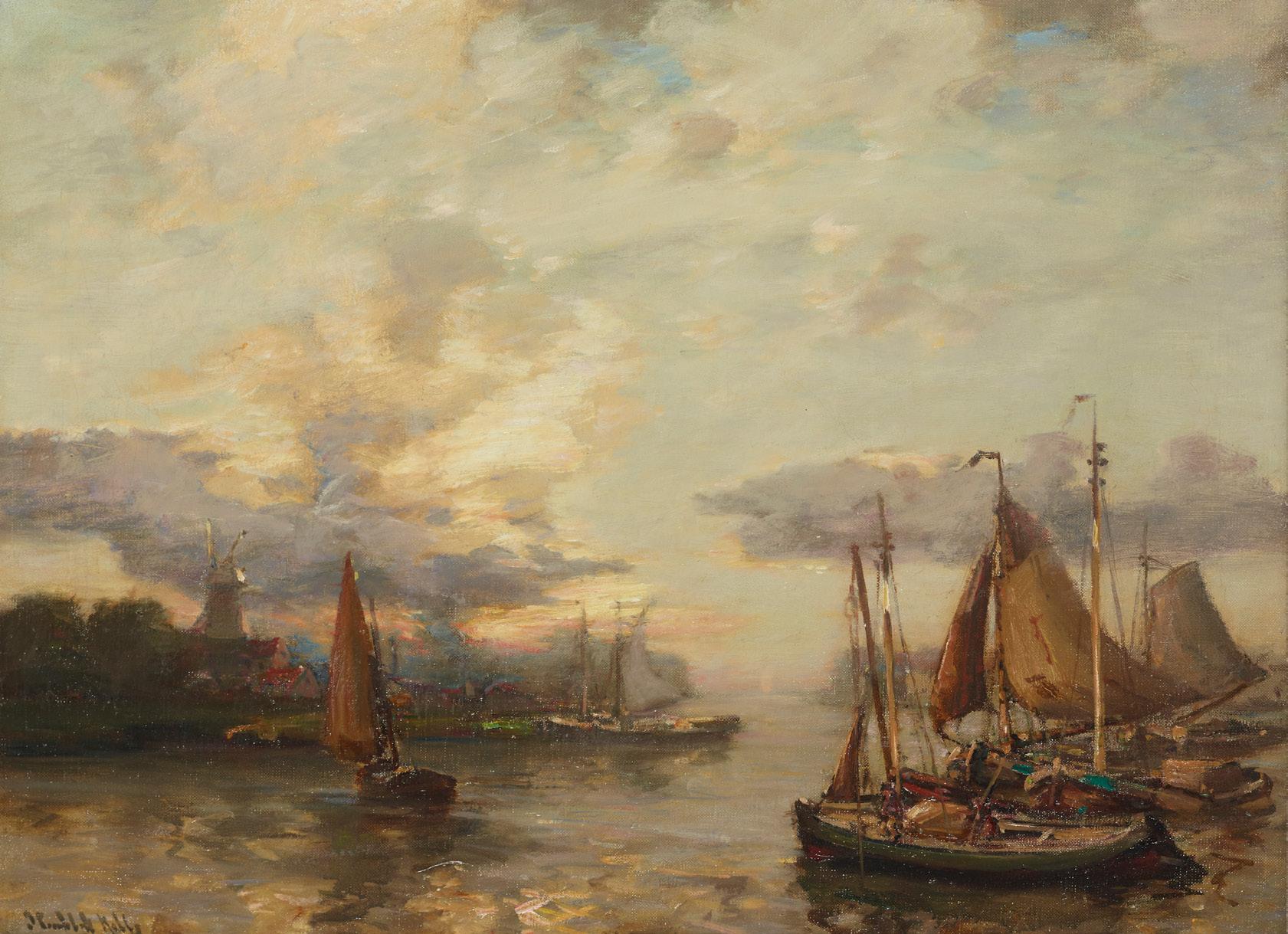
A BUSY DUTCH FISHING PORT
Signed, oil on canvas
46cm x 61cm (18in x 24in)
£800-1,200
60
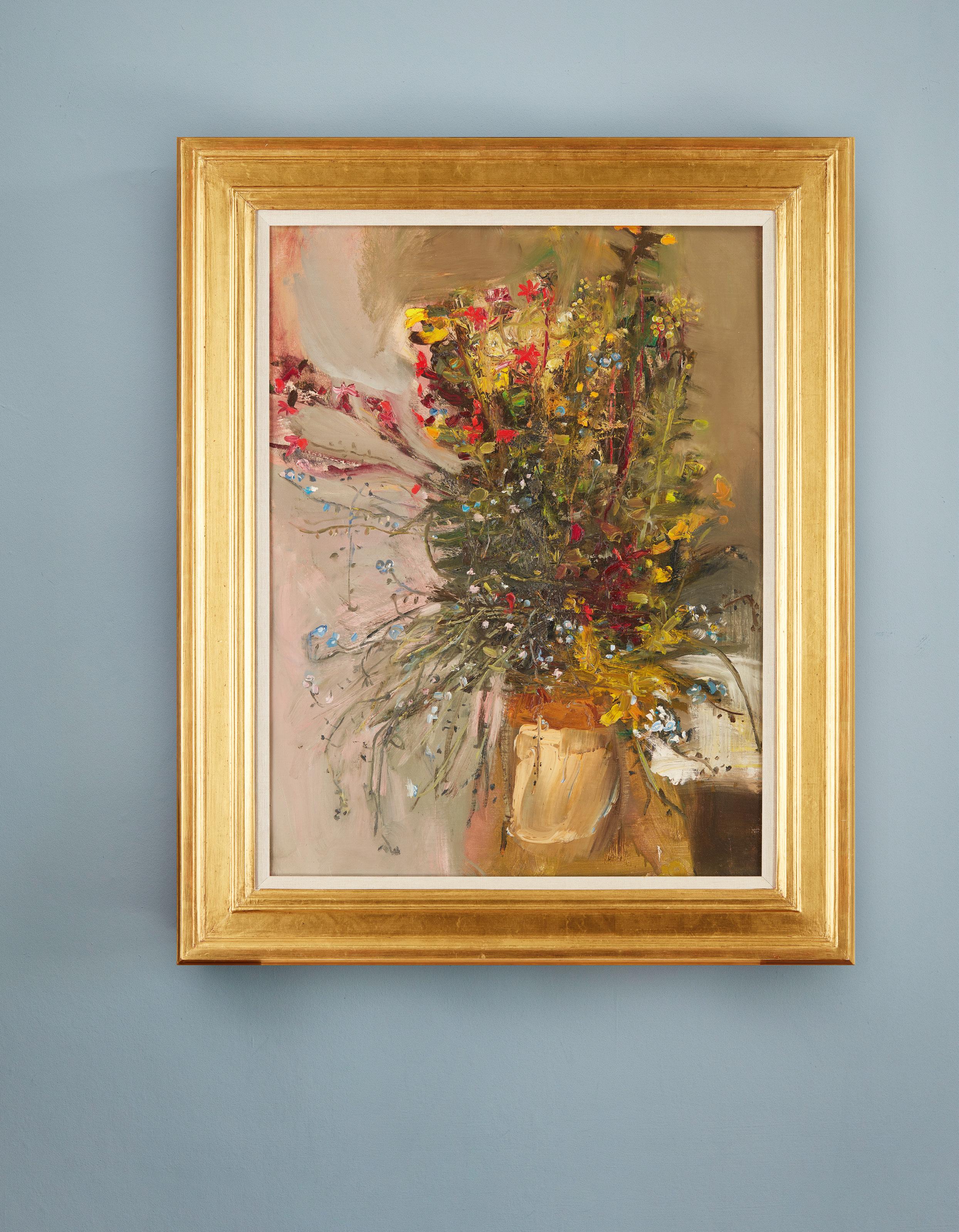
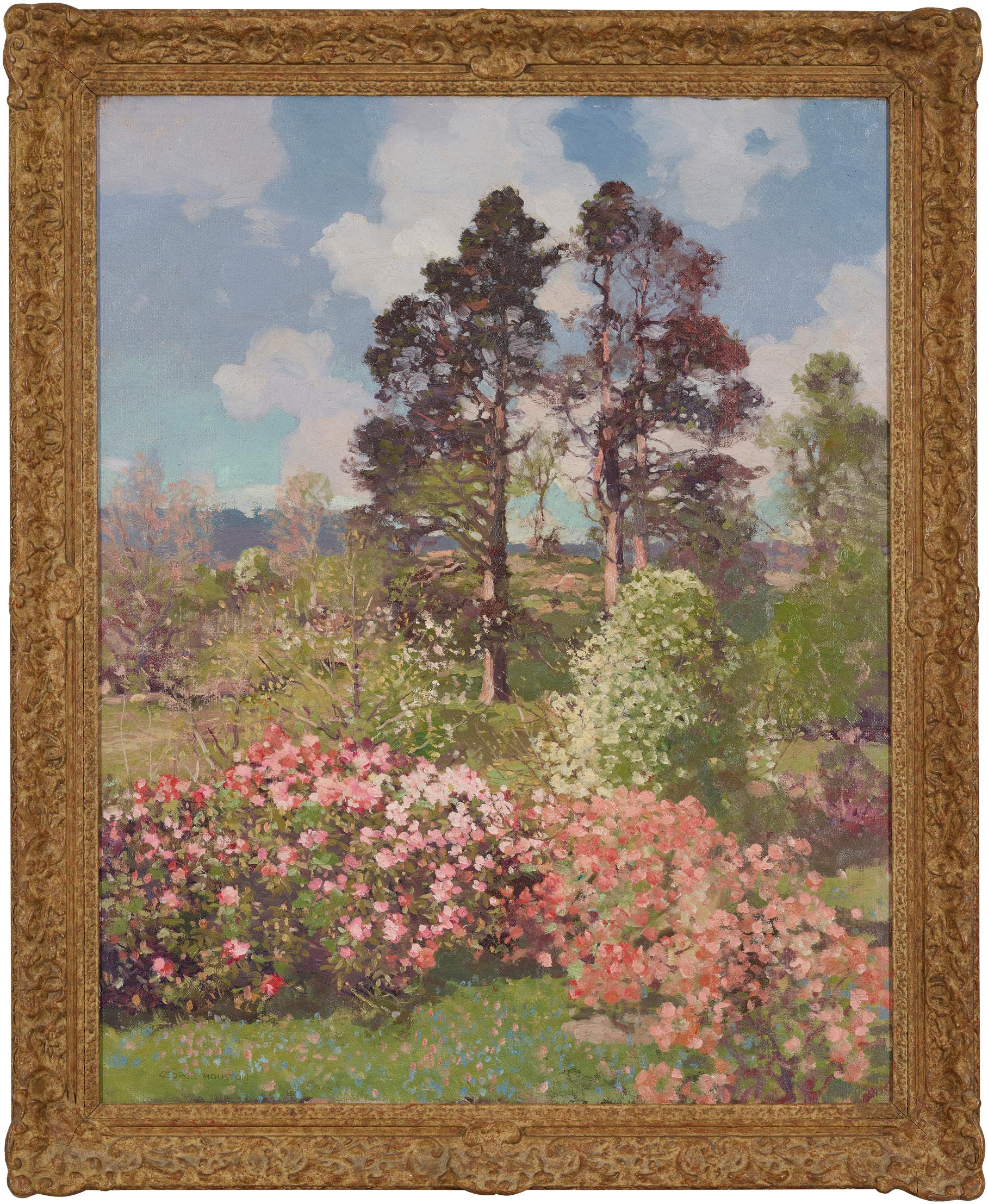
94
GEORGE HOUSTON R.S.A, R.S.W., R.G.I. (SCOTTISH 1869-1947)
oil on canvas 91cm
71cm
£2,000-3,000 61 Other fees apply in addition to the hammer price: see the ‘Buyer’s Guide’ section on page 2
BORDER IN BLOOM Signed,
x
(36in x 28in)
A RIVERSIDE TOWN, NORMANDY
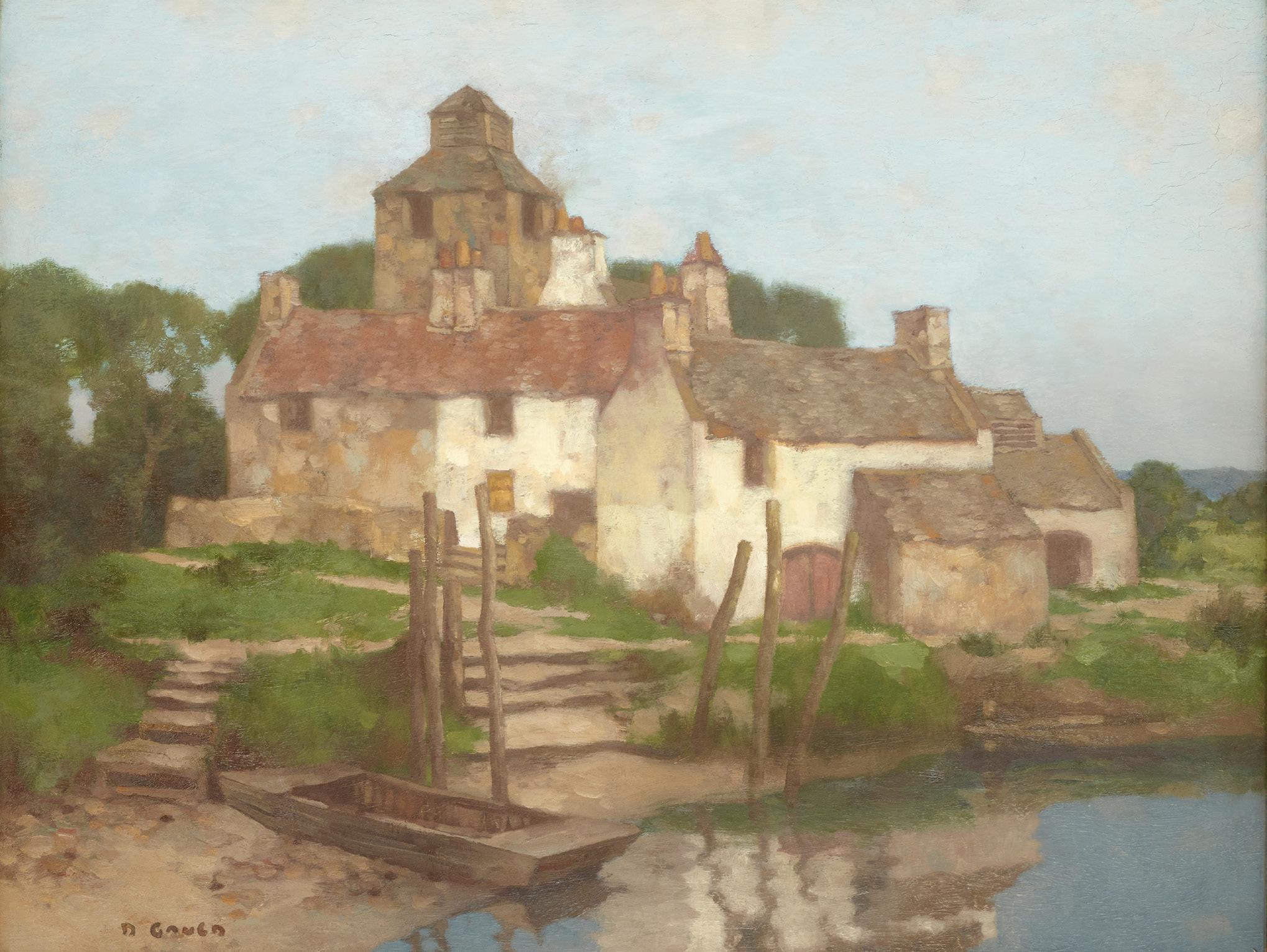

Signed, oil on canvas
71cm x 91cm (28in x 36in)
£3,000-5,000
95
DAVID GAULD R.S.A. (SCOTTISH 1865-1936)
62
96 §
JAMES MCINTOSH PATRICK
R.S.A., R.O.I., A.R.E., L.L.D. (SCOTTISH 1907-1998)
AUTUMN, CARSE OF GOWRIE FROM ABOVE MILLHILL Signed, oil on canvas
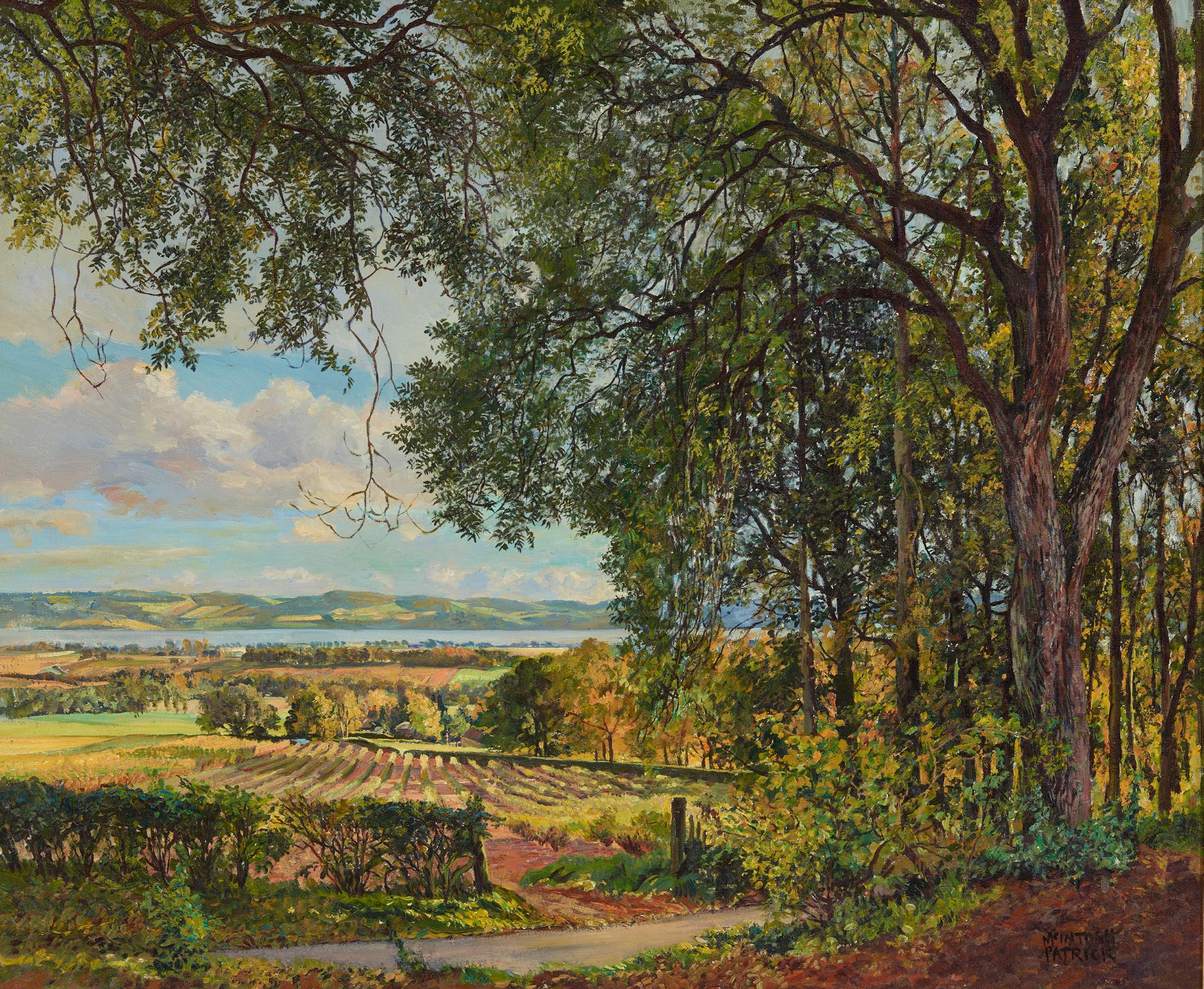
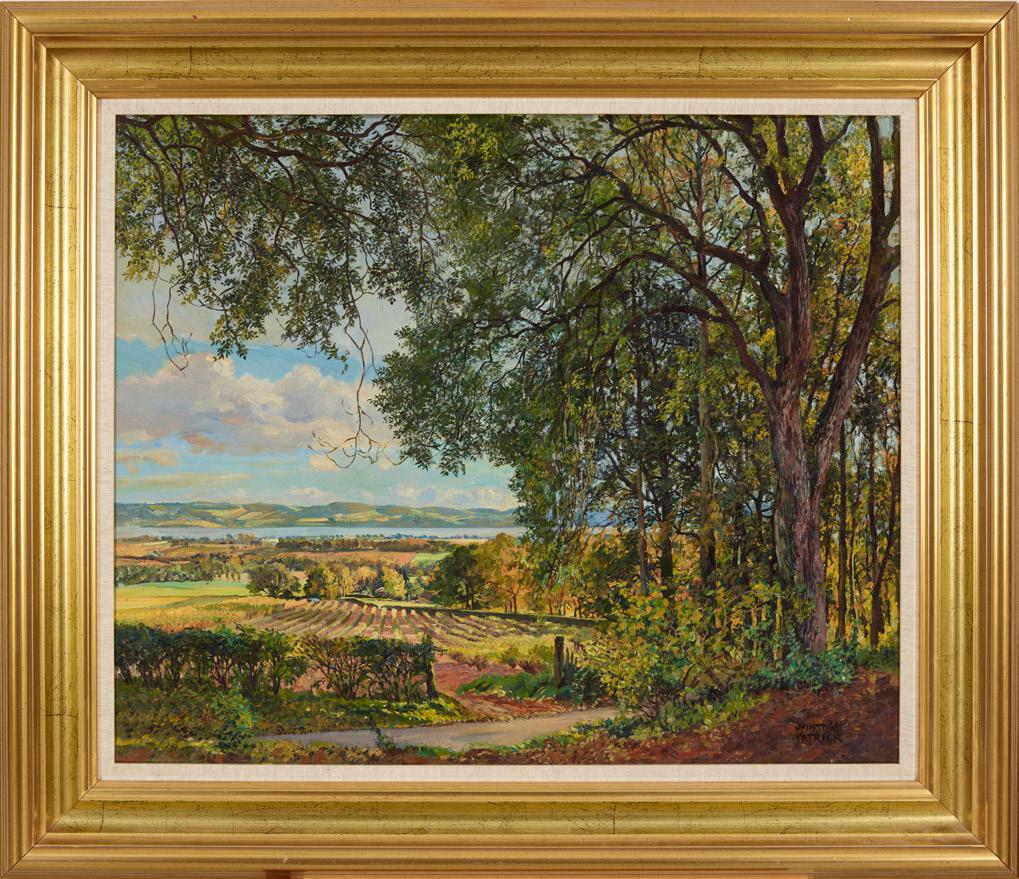
63.5cm x 76cm (25in x 30in)
£5,000-7,000
63 Other fees apply in addition to the hammer price: see the ‘Buyer’s Guide’ section on page 2
97
DAVID FULTON R.S.W. (SCOTTISH 1848-1930)
GOLDEN SUMMER
Signed, oil on canvas
41cm x 61cm (16in x 24in)
£2,000-3,000
98
ROBERT GEMMELL HUTCHISON R.B.A., R.O.I., R.S.A., R.S.W. (SCOTTISH 1860-1936)
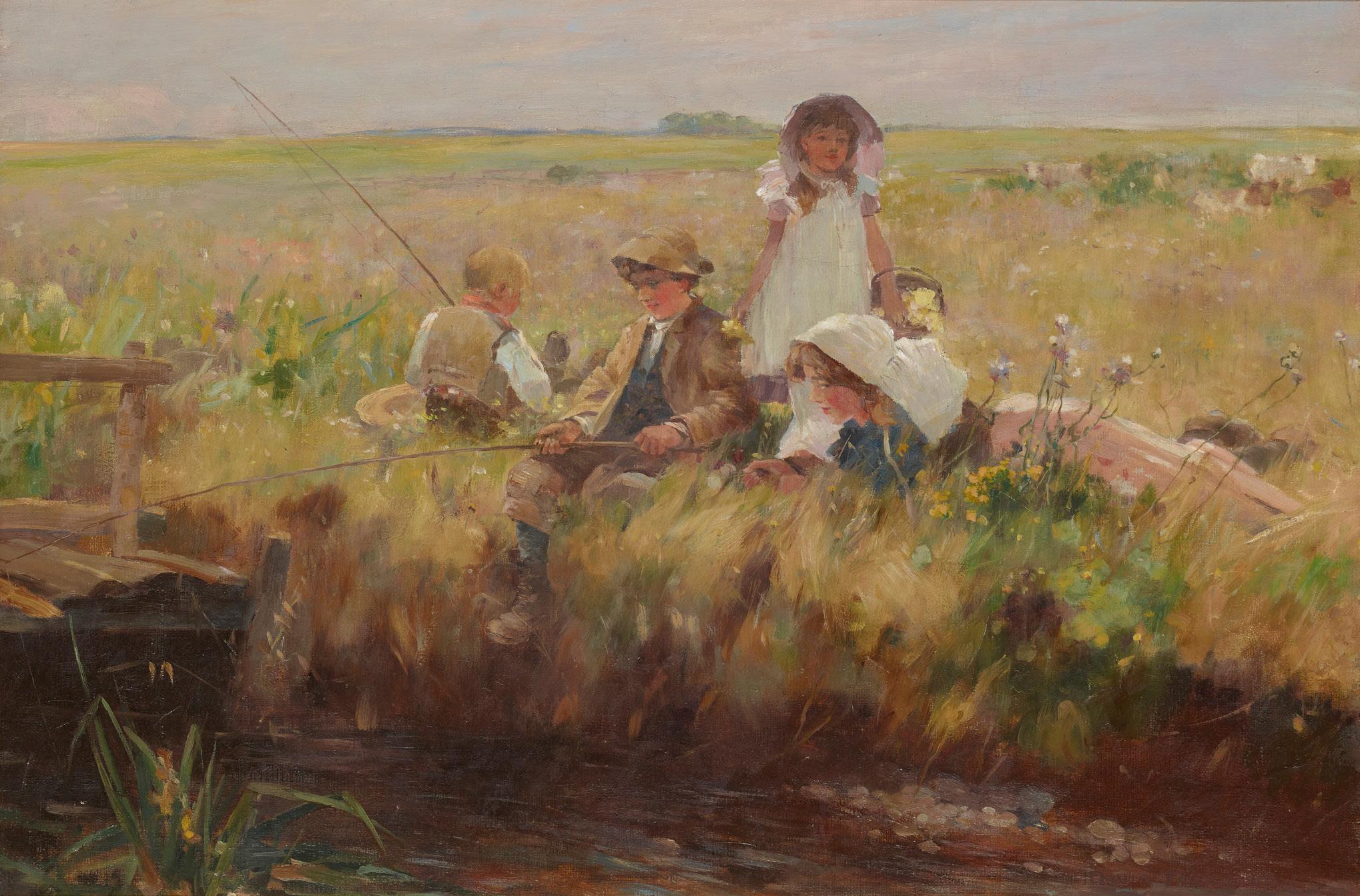
GIRL WITH BASKET
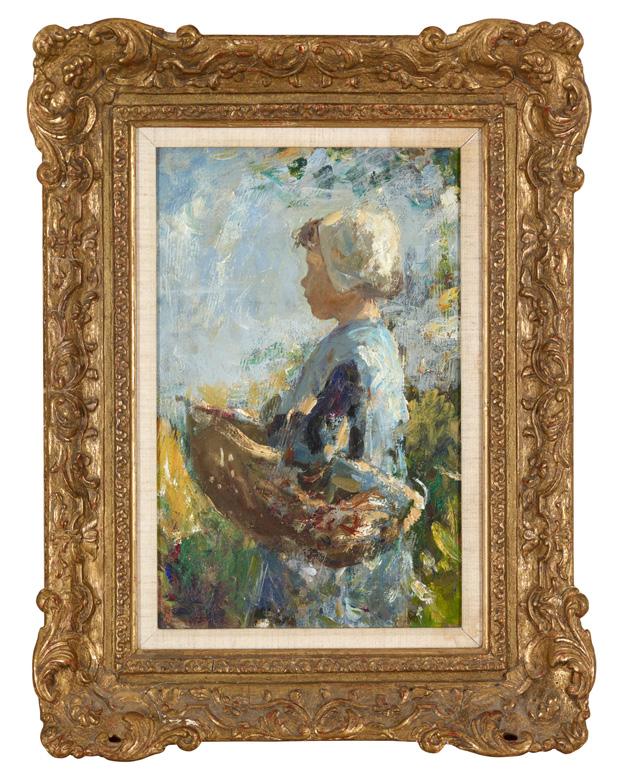
Oil on board
33cm x 20cm (13in x 8in)
Provenance: Mrs Laidlaw, the Artist’s daughter
Exhibited: The Fine Art Society Ltd, February 1975 (19/6377), lent by Mrs Laidlaw
£4,000-6,000
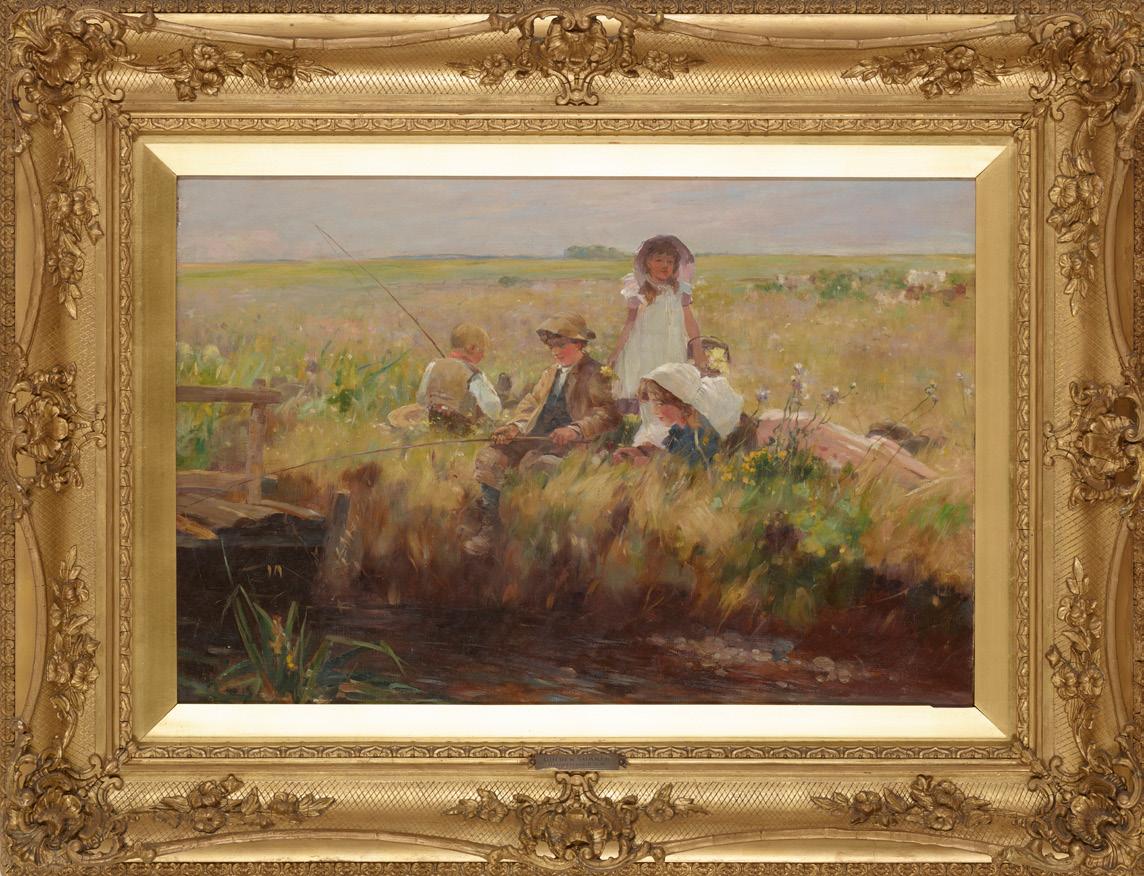
64 Other fees apply in addition to the hammer price: see the ‘Buyer’s Guide’ section on page 2
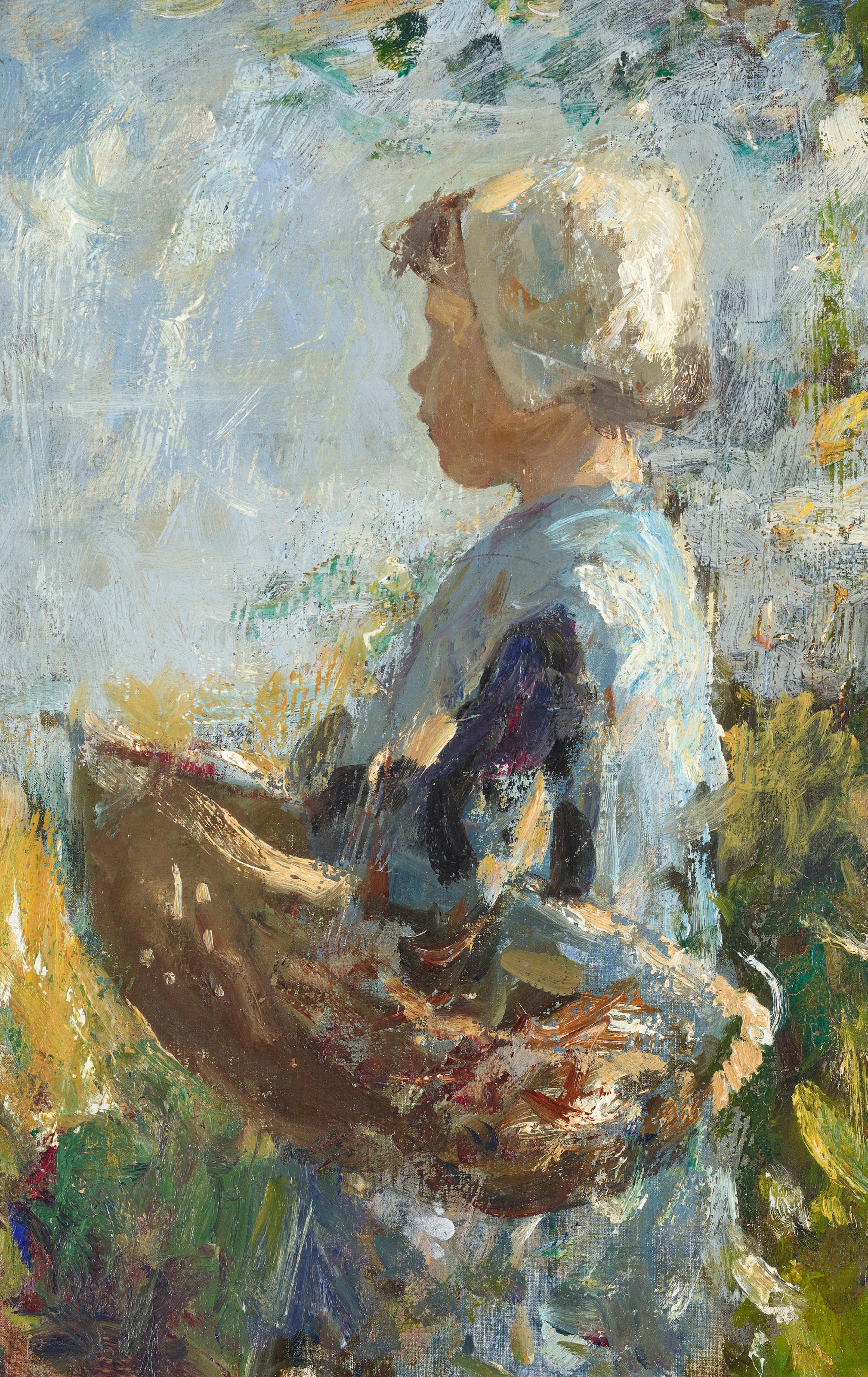
100 †
REV. JOHN THOMSON OF DUDDINGSTON H.R.S. (SCOTTISH 1778-1840) A WOODED RIVER LANDSCAPE WITH FISHERMAN
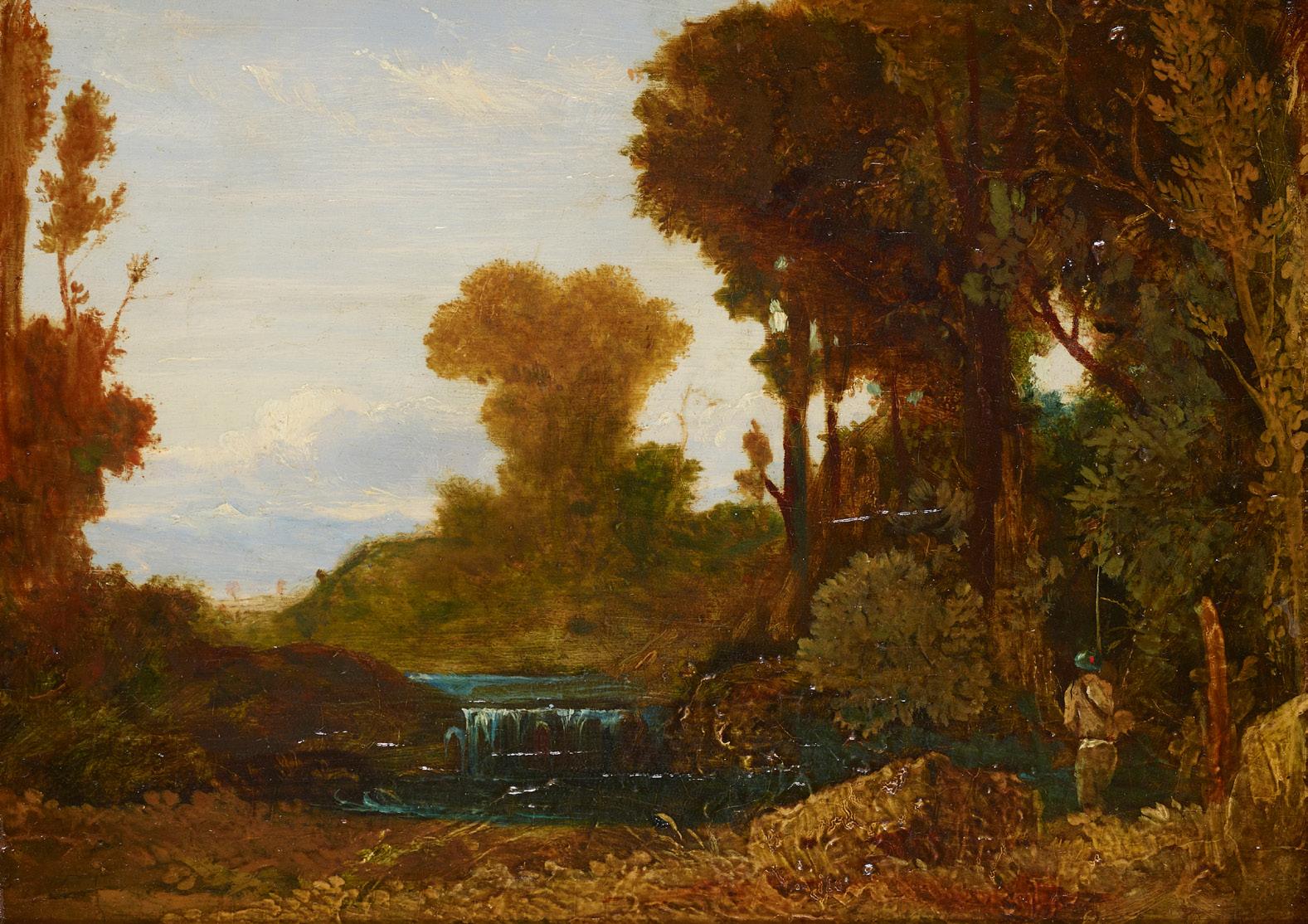
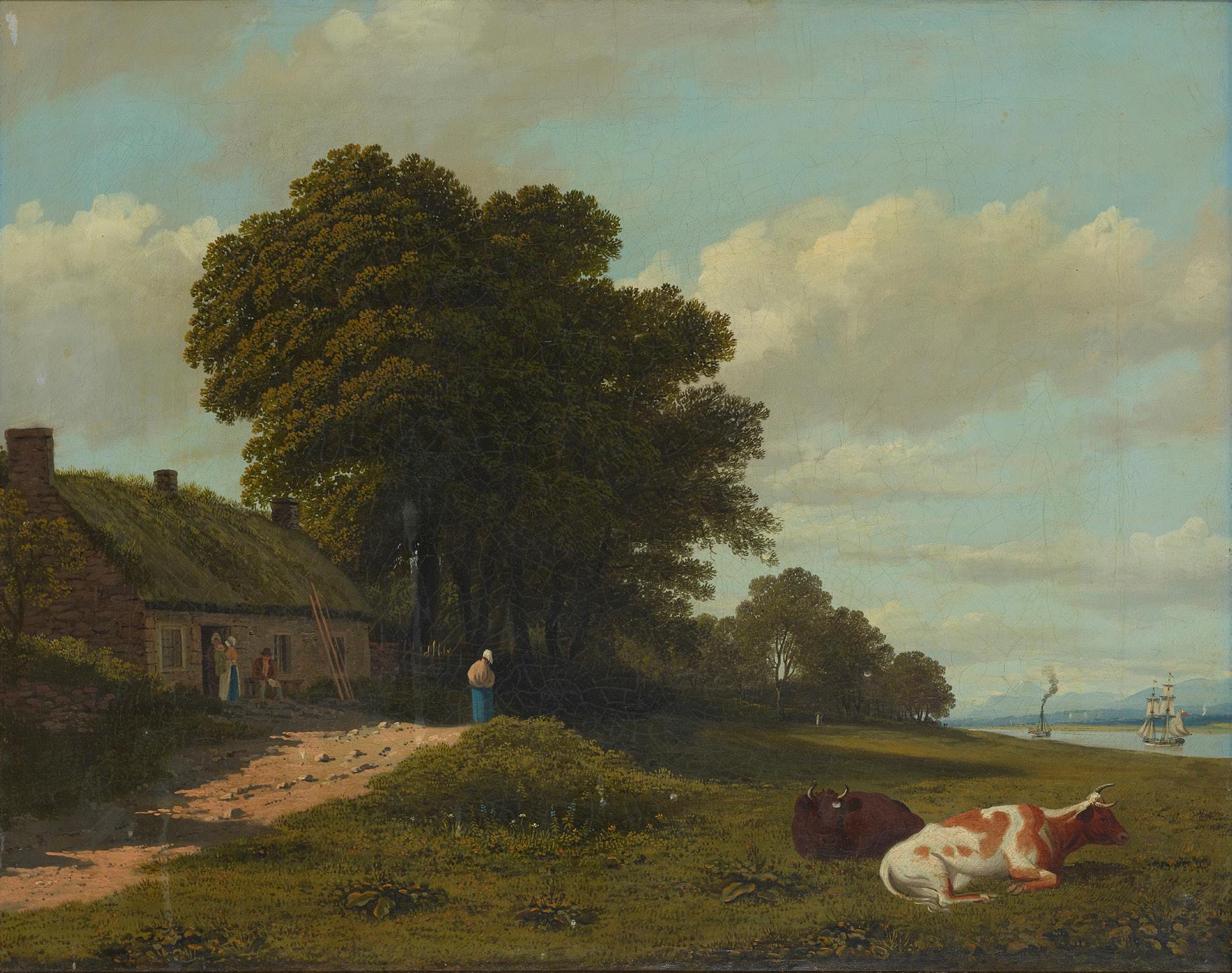
Inscribed verso, oil on panel 23cm x 30.5cm (9in x 12in)
Provenance: Dowdeswells, Edinburgh
The Fine Art Society, Edinburgh
Literature: Glasgow Herald, 5
June 1893
Morning Post, 7 June 1893
William Baird, John Thomson of Duddingston: Pastor and Painter. Andrew Eliot, Edinburgh, 1895, p.213
Robert W. Napier, John Thomson of Duddingston, Landscape Painter, Oliver and Boyd, Edinburgh, 1919
£1,000-1,500
99
JOHN KNOX (SCOTTISH 1778-1845)
ON THE CLYDE
Oil on canvas
56cm x 69cm (22in x 27in)
£2,000-3,000
66
101
HORATIO MCCULLOCH R.S.A. (SCOTTISH 1805-1867)
A HIGHLAND LANDSCAPE WITH TRAVELLERS BY A DISTANT CASTLE
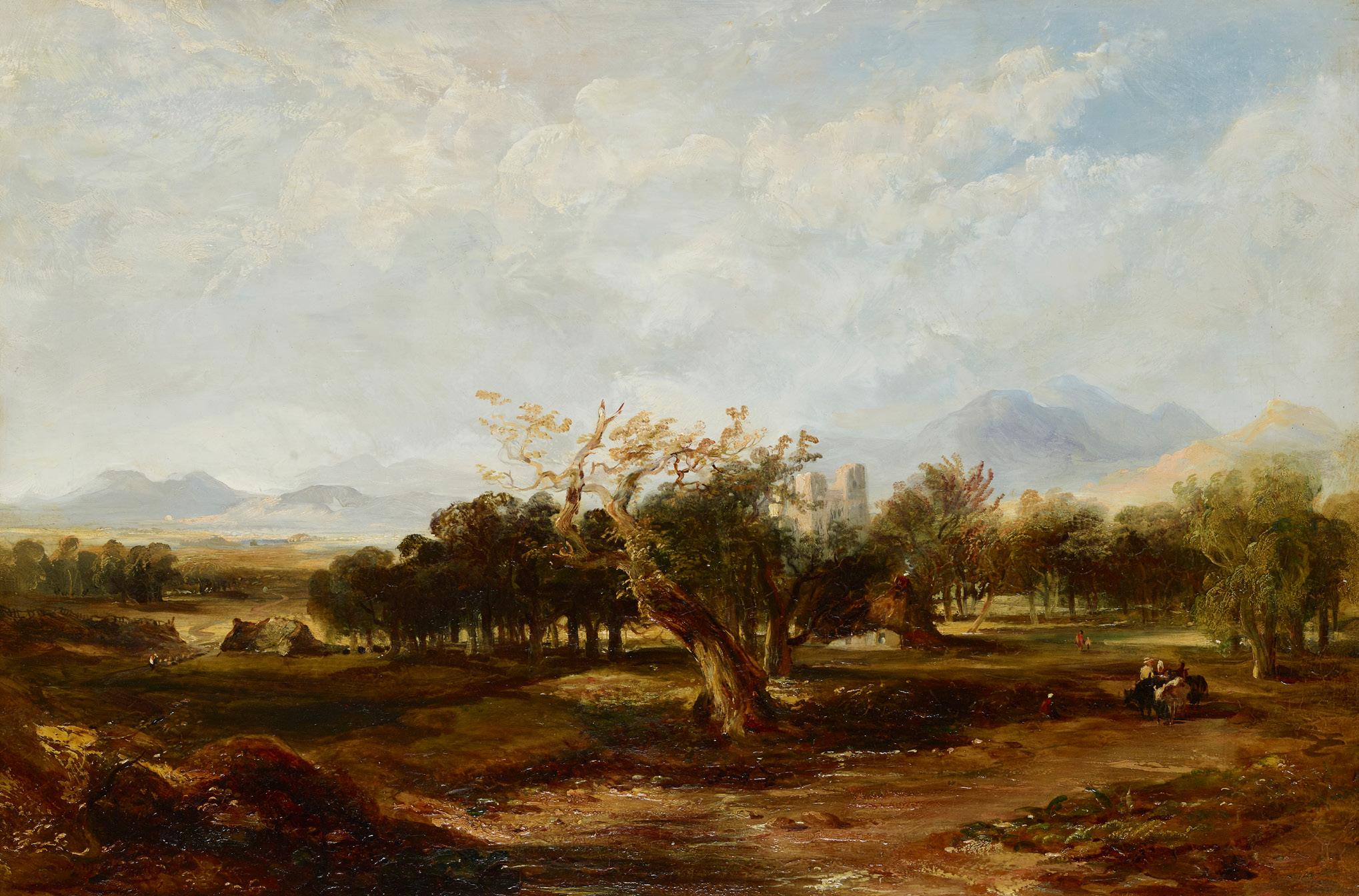
Signed, oil on canvas
61cm x 91cm (24in x 36in)
£3,000-5,000
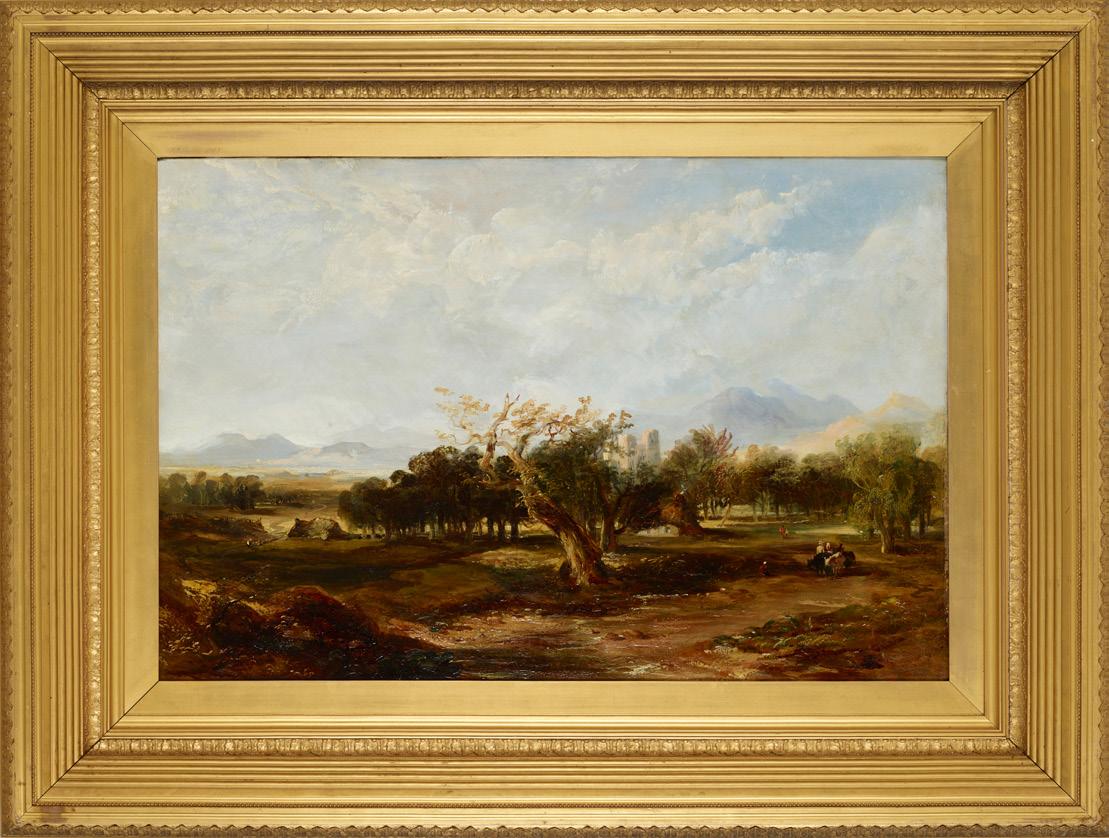
67 Other fees apply in addition to the hammer price: see the ‘Buyer’s Guide’ section on page 2
102
SIR DAVID WILKIE R.A. (SCOTTISH 1785-1841)
HALF-LENGTH PORTRAIT OF SIR WILLIAM WELLESLY KNIGHTON
2ND BARONET IN ACADEMIC ROBES
Signed and dated 1840, oil on canvas 76cm x 64cm (30in x 25in)
£8,000-12,000
Provenance: Sir William Wellesly
Knighton, 2nd Baronet, London and Bledworth Lodge
His Estate sale, Christie’s, London, 23 May 1885
Sotheby’s at Simpson’s, Toronto, 1 October 1967, lot 48, where purchased for a Private Collection Toronto
Literature: Lord Ronald Sutherland
Gower, Great Masters in Painting and Sculpture: Sir David Wilkie, George Bell & Sons, London, 1902, p.99
103
SIR DAVID WILKIE R.A. (SCOTTISH 1785-1841)

PRINCE AUGUSTUS FREDERICK, DUKE OF SUSSEX
Oil on canvas
61cm x 51cm (24in x 20in)
Provenance: Inherited from the Artist by his Executors and siblings Thomas Wilkie and Helen Wilkie
The Artist’s Estate sale, Christie’s London, 30 April 1942 (sixth day), lot 637, sold for 12 gns. to Basil Hall
Inherited from the above by his brother, James Hall (1800-1854)
His sale, Christie’s, London, 19 April 1855, lot 263, sold for 3 gns’ to ‘Anthony’
Anonymous sale, Robinson and Fisher, Bedford, 18 June 1913, lot 6, where acquired by Knoedler & Co., London
Acquired from the above by the Hon. Evan Charteris (1864-1940) in 1913
Inherited from the above by his step-daughter, the Hon. Rosemary Helen Dawnay (1918-1969)
With Thomas Agnew & Son, London, by 1978
With Spink & Son Ltd., London, 1978, from where acquired by the present owner
Exhibited: British Institution, London, David Wilkie Memorial Exhibition, 1842, no. 107
Burlington Fine Arts Club, London, Empire and Regency, 1929-1930, no 10
Thomas Agnew & Sons, London, Three Centuries of British Paintings, 9 March-28 April 1978, no. 42 Spink & Son Ltd, London, English Oil Paintings, 14 November-8 December 1978, no. 43
Literature: Oliver Millar, Later Georgian Pictures in the Collection of Her Majesty the Queen, Phaidon, London, 1969, vol.I, p. 143, under no. 1186
£15,000-20,000
68
Prince Augustus Frederick, Duke of Sussex, was the ninth child of King George III, and the only one of his sons who did not pursue a career in the Army or Navy. Instead, he was known for his liberal views; a staunch advocate for the abolition of the slave trade, Catholic emancipation and the removal of legal restrictions on Jewish people. Indeed, he was a man at the forefront of social change at the beginning of the nineteenth century. The present oil sketch was likely executed by Wilkie in early 1832, as a preliminary idea for his full-length portrait of the Prince in his capacity as Earl of Inverness, exhibited at the Royal Academy in 1833 and presented to Queen Victoria the same year (Royal Collection, Buckingham Palace, RCIN 405420). Wilkie had by this date developed a rough, painterly style for his life-sized works, which owed something to Rembrandt and a great deal to Reynolds and Raeburn. Between this sketch for the portrait and the final version a few changes were made; for instance, the sitter is shown holding rather than wearing his chieftain’s plumed bonnet. In both works the key note is the romance of Caledonian splendour, the fierce, proud
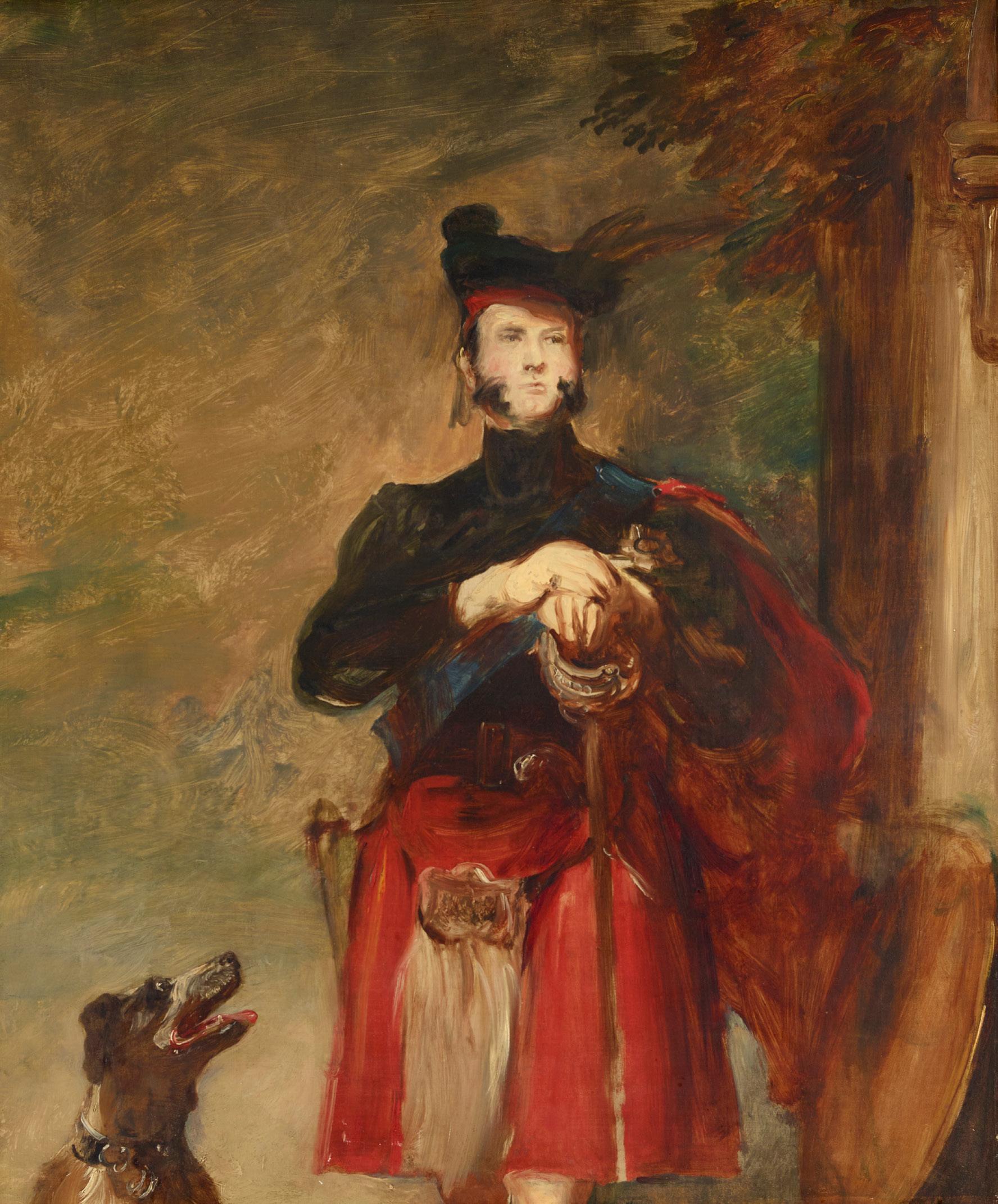
and independent spirit of the Highlander, something which entered the mainstream of European culture at this date.
Basil Hall (1788-1844), the purchaser of the sketch at Wilkie’s Estate Sale in 1842, was an officer in the Royal Navy and a noted traveller. As part of a diplomatic mission to China in 1813, he explored Java and undertook surveys of the west coast of Korea and the outlying Ryukyu Islands of Japan. In 1817 he was able to interview Napoleon, who had been an acquaintance of his father’s, during his exile on St. Helena. His final voyage before retirement from the Navy took him to the west coast of South America in 1820. On his return to England in 1823 Hall published his journal under the title Extracts from a Journal Written on the Coasts of Chile, Peru and Mexico. In addition to these far-flung adventures, the Edinburgh-born Hall was part of the circle that included Wilkie and the great writer Sir Walter Scott, a connection that led to his purchase of Wilkie’s portrait shortly before his own death in 1844.
69 Other fees apply in addition to the hammer price: see the ‘Buyer’s Guide’ section on page 2
104
GOURLAY STEELL R.S.A. (SCOTTISH 1819-1894)
GERTRUDE, BLOSSOM AND BOB
Signed and dated 1861, signed, inscribed and dated verso, oil on canvas, arched top
46cm x 66cm (18in x 22in)
Provenance: Sir William Gibson-Craig Bt
Exhibited: Royal Scottish Academy, Edinburgh, 1862, no.593 (lent by Sir William Gibson-Craig Bt)
Note: This painting depicts Gertrude Gibson-Craig (b.1856), the youngest of the six children of Sir William Gibson-Craig and his wife Elizabeth Vivian.

£2,000-3,000

70 Other fees apply in addition to the hammer price: see the ‘Buyer’s Guide’ section on page 2
105
JOHN FAED R.S.A. (SCOTTISH 1819-1902)
‘LOOK AFTER THE PENNIES’
Signed, oil on canvas
61cm x 76cm (24in x 30in)
Provenance: Private Collection, Scotland

£2,000-3,000
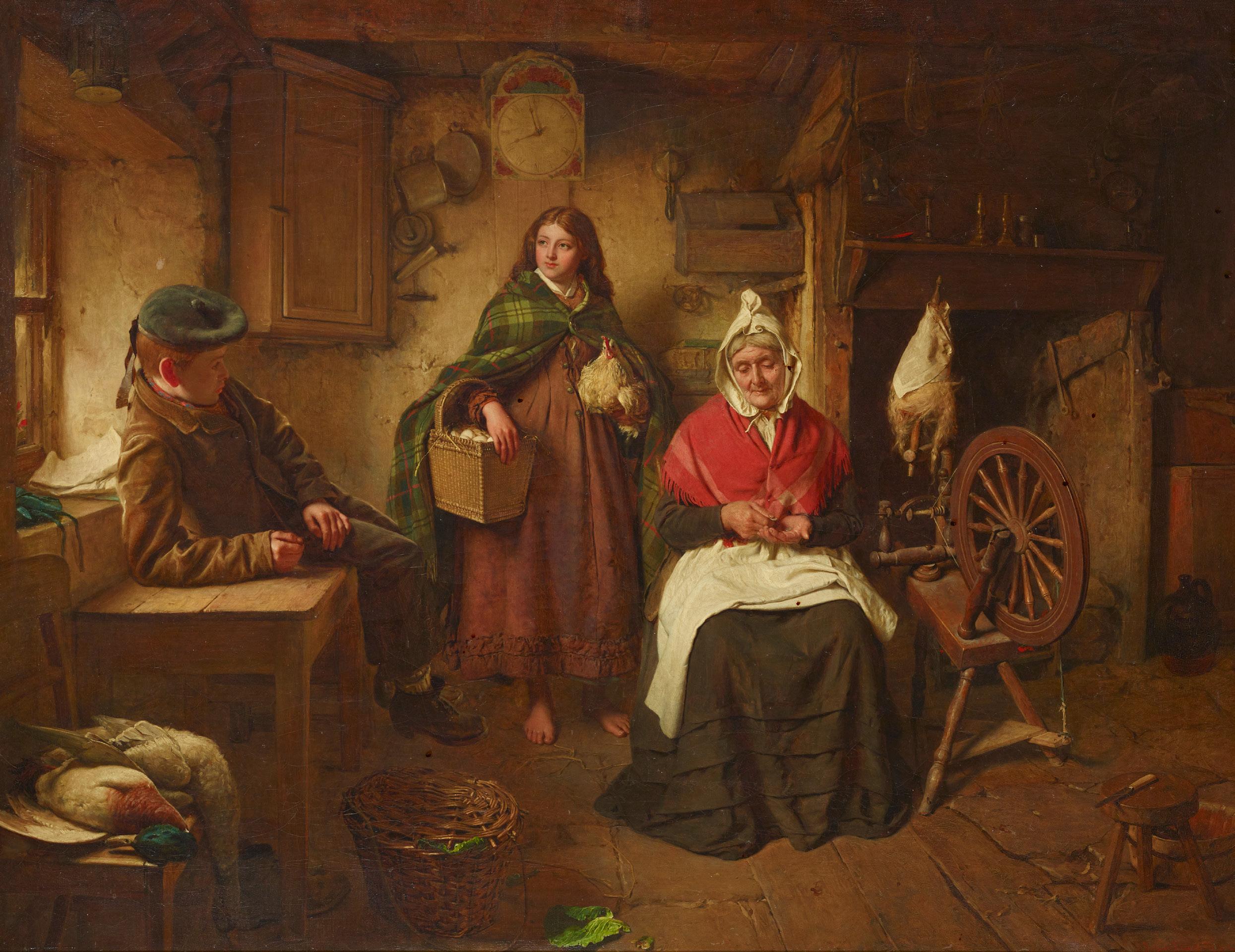
71
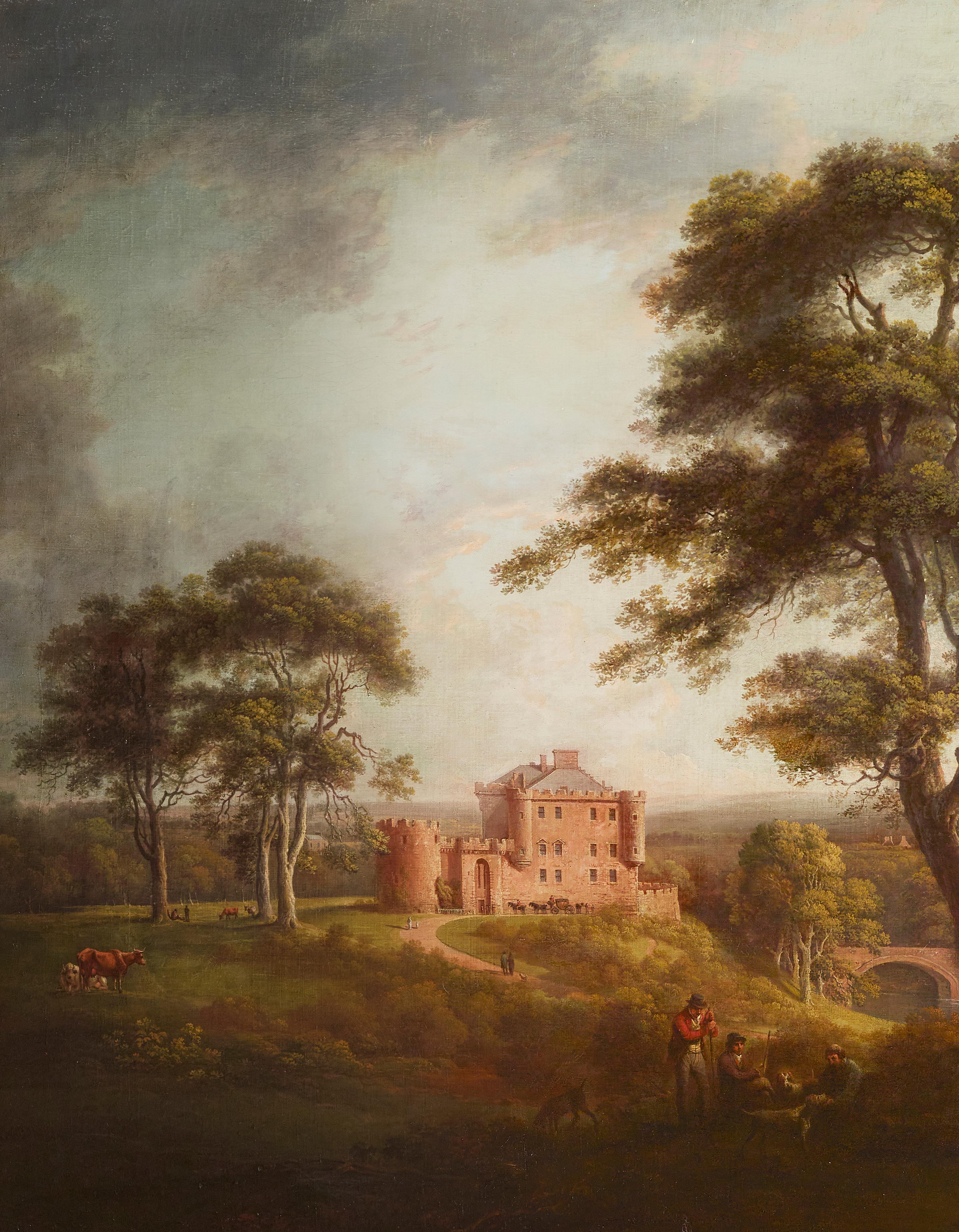

Alexander Nasmyth: Architetto-Pittore
This pair of Edinburgh scenes date to 1788 when Alexander Nasmyth is recorded as spending much time, and deriving much pleasure from, walking around his native city, often accompanied by his friend Robert Burns. His famous portrait of Burns (National Galleries of Scotland) was painted the previous year and was also executed on a small scale typical of Nasmyth’s early work. A 1788 Edinburgh directory describes his profession as ‘portrait and landscape painter’ but by the end of the decade Henry Raeburn’s nearmonopolisation of Edinburgh portraiture compelled Nasmyth to concentrate on landscapes. This proved an astute decision: he would go on to become known as ‘the founder of the Scottish landscape tradition.’
This fascinating pair of compositions capture the artist at a formative period in his career when his distinctive style was being cultivated. A View Near Edinburgh portrays figures crossing a bridge near a smart cottage, with an imposing Edinburgh Castle just visible through the trees behind; its companion piece portrays a peasant family by a roadside in front of a dilapidated cottage. It is possible the pair were conceived to convey a moralising message; equally, they
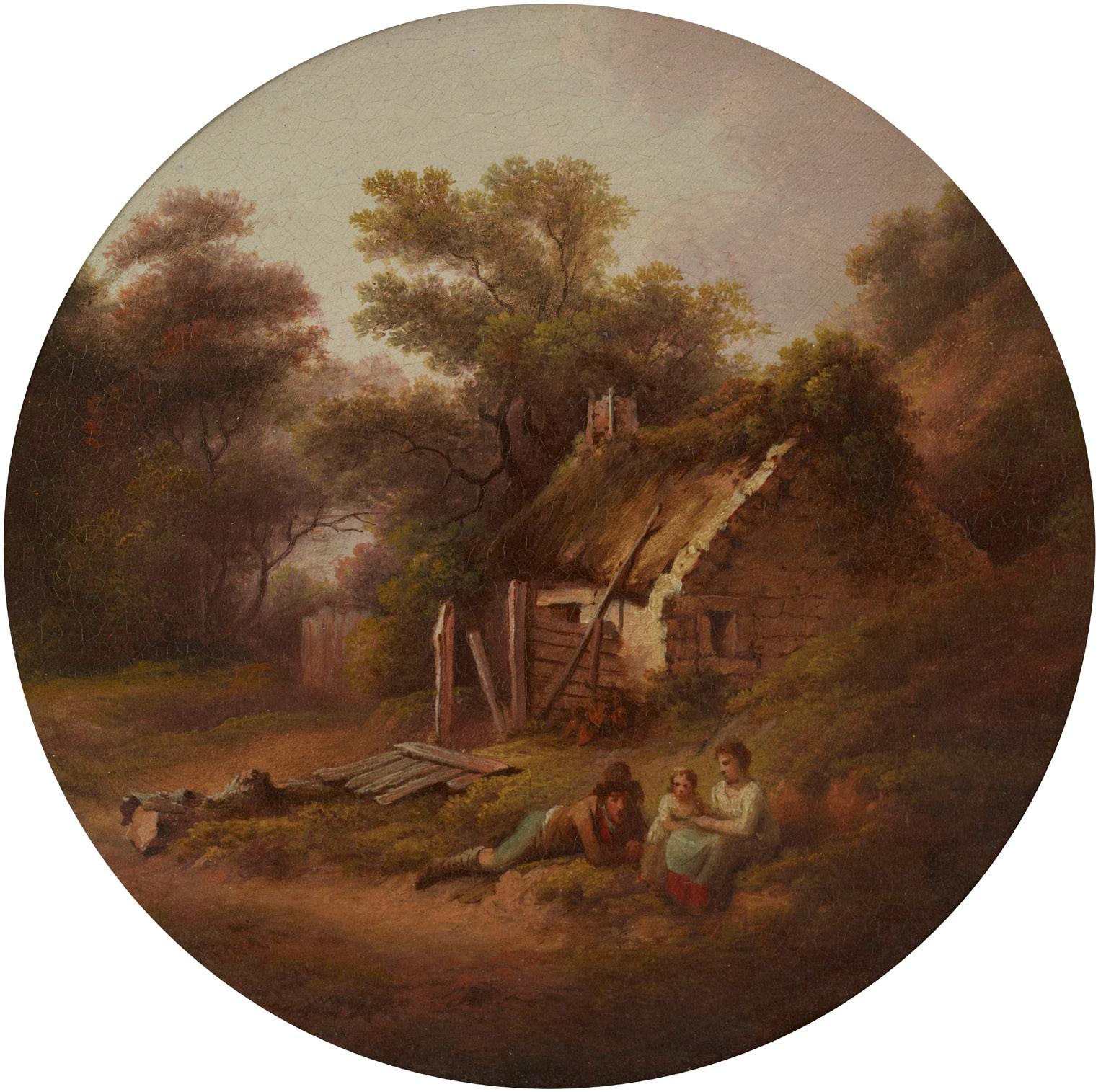
may have been intended as charming conversation pieces evoking the ‘haves’ and ‘have-nots’ of Edinburgh society. The close attention Nasmyth paid to Northern Old Masters is evident, particularly in the restrained and earthy palette and the interest in portraying scenes of day-to-day life with intense detail. Nasmyth’s son and biographer James recorded that his father admired Hobbema, Wynants and Ruysdael in particular, and the British Museum holds a collection of Nasmyth etchings that demonstrate his awareness of early Northern artists including Nicholaes Berchem (one such etching dates to 1771, when Nasmyth was only thirteen).
By the 1800s his skill as a landscape painter was such that he was confident working on an ambitious scale, yet due to the numerous demands on his time relatively few pictures survive from this period. Between 1790 and 1810 he was remarkably industrious: in addition to supporting his large young family, he was setting up an art school where he taught classes and was also working on an ever-expanding portfolio of theatrical, engineering and landscape design projects. Nasmyth came from a line of architect-builders, and as a youth had been trained to take over the family business by
74
his father but opted to pursue painting instead. It was not until later in life that he began to take on architectural and landscape-design commissions, embodying the Italian ideal of the architetto-pittore.
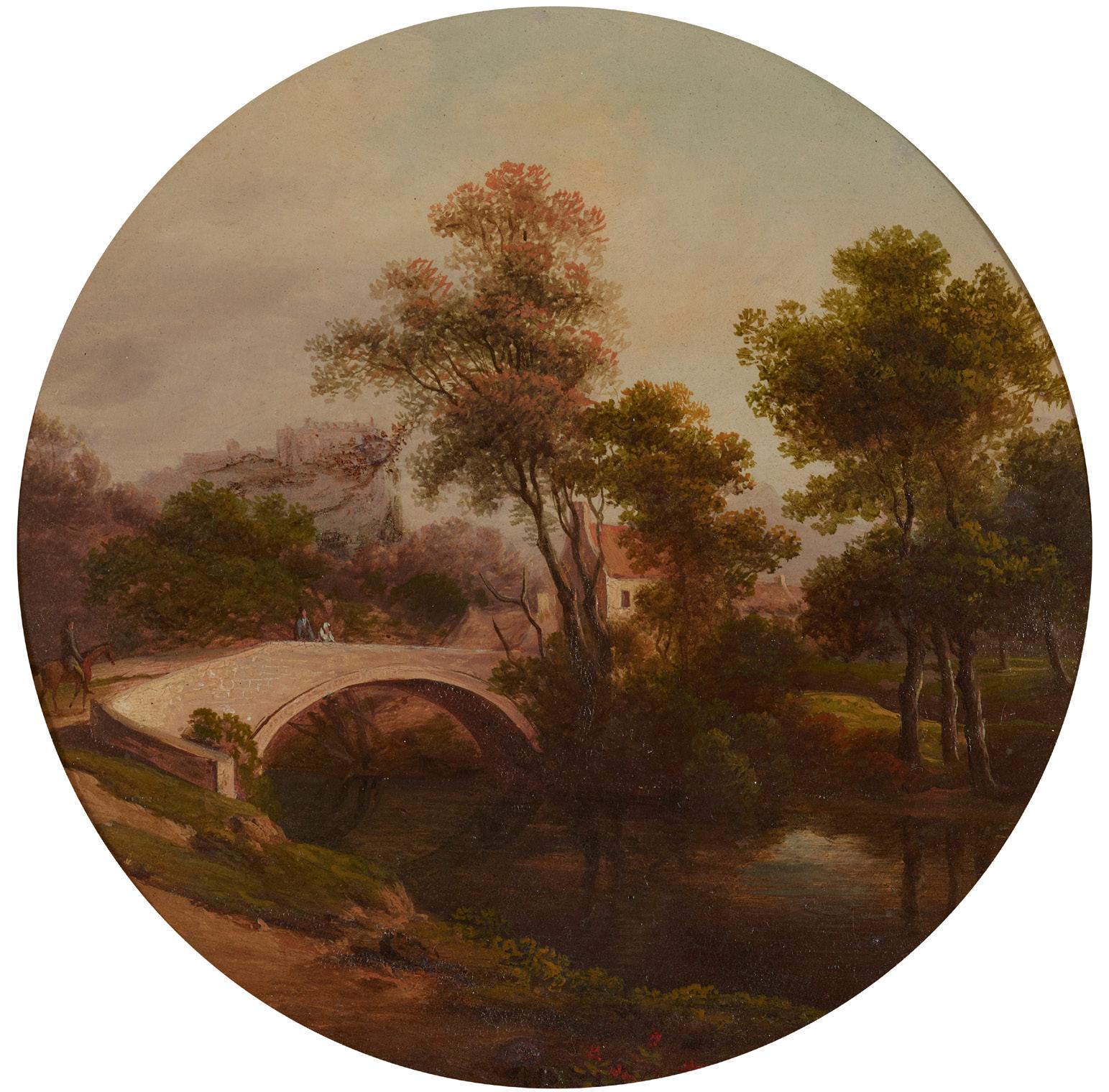
James Nasmyth wrote: ‘My father was much employed in assisting the noblemen and landed gentry in improving the landscape appearance of their estates, especially when seen from their mansion windows. His fine taste, and his love of natural scenery gave him great advantages in this respect… he designed alterations of the old buildings so as to preserve their romantic features, and at the same time to fit them for all the requirements of modern domestic life.’ (ed. S. Smiles James Nasmyth, Engineer: An Autobiography, London, 1883, pp.36-37)
Nasmyth often presented his clients with artworks which illustrated his proposed improvements to their estates, and it is possible that it was in this architetto-pittore capacity that Nasmyth painted Dalhousie Castle in Cockpen, Midlothian. (J. C. Loudon, An Encyclopaedia of Gardening, London, 1822, p.1250, no.2218) The sweeping landscape incorporates views of the thirteenth-century redstone castle and its
strategic vantage point over the River Esk, all set against rolling hills stretching into the distance. The pleasures of the grounds are demonstrated by several figural vignettes: hunters and their dogs rest in the foreground; a pair fish by the Esk; animals graze throughout. Particular attention is drawn to the dramatic views enjoyed on the approach to Dalhousie, with various figures accompanied by dogs walking up the gently curving path, and a waiting horse and carriage outside the Castle.
Dalhousie Castle affords the viewer an interesting insight into Nasmyth’s practice during a period when he produced few paintings, and is of exceptionally fine quality. It possesses all the hallmarks of the artist’s hand, including the distinctive ‘Nasmyth-style’ craggy trees, meticulous detail, a soft, golden light, and the use of dark framing devices around the edges of the picture to enhance its sense of depth and theatricality. The result is a highly evocative bucolic vision realised on a monumental scale.
75
106
ALEXANDER NASMYTH (SCOTTISH 1758-1840)
DALHOUSIE CASTLE
Oil on canvas
112cm x 167cm (44in x 66in)
Literature: J. C. B. Cooksey, Alexander Nasmyth HRSA, 1758-1840: A Man of the Scottish Renaissance, Haddington, 1991, p.100, ill.Q5
£30,000-50,000
107
ALEXANDER NASMYTH (SCOTTISH 1758-1840)
A VIEW NEAR EDINBURGH
Inscribed and dated on the backboard ‘A view near Edinburgh taken by Mr Nasmyth Senr. for John Cockburn 1788’, oil on copper, circular, and a companion, a pair, similarly inscribed (2) 18cm (7in) diameter

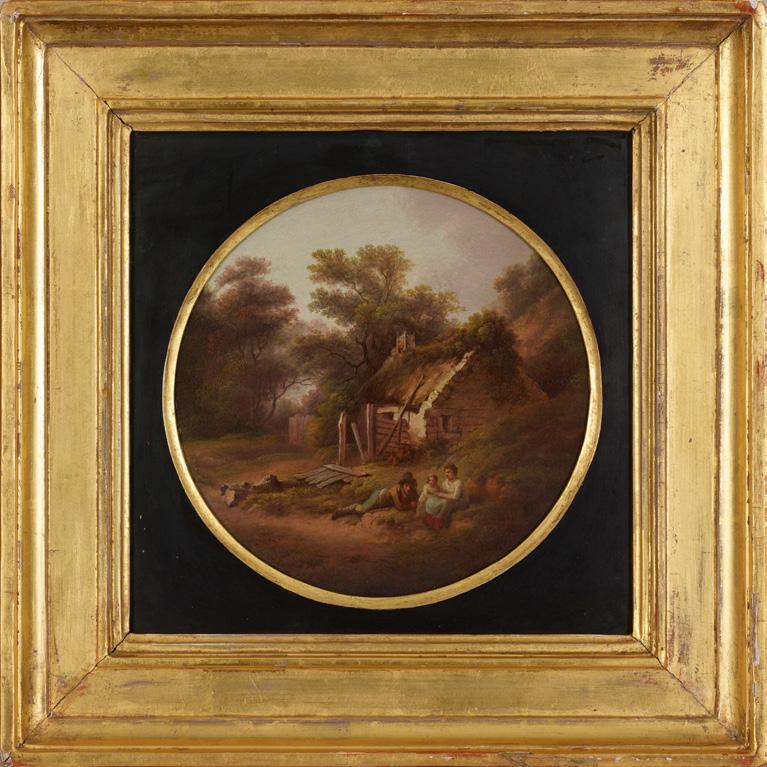
£8,000-12,000
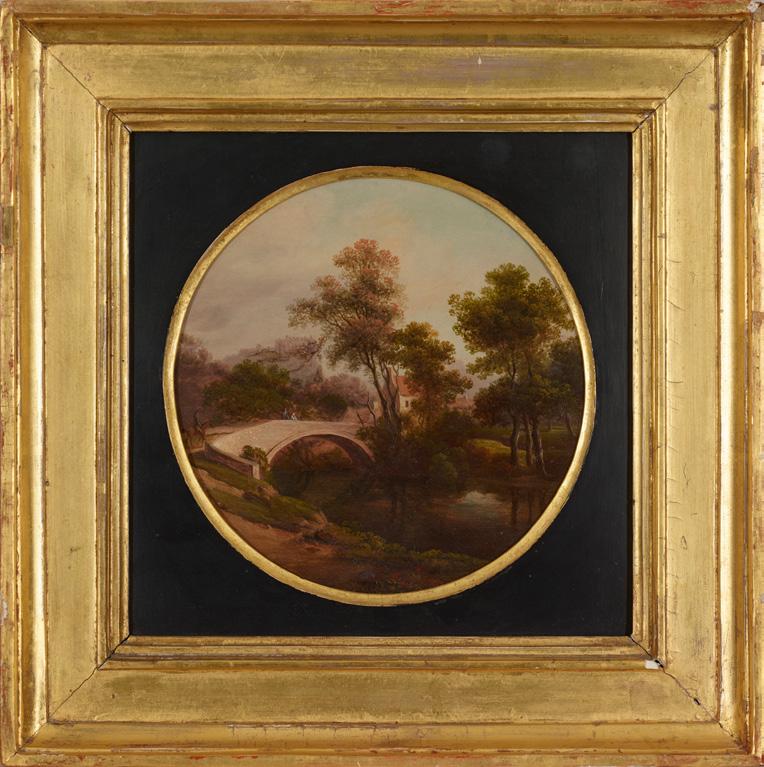
76
108
SAM BOUGH R.S.A, R.S.W. (SCOTTISH 1822-1878)
THE BEACH AT SUNSET
Signed and dated 1871, oil on canvas
110cm x 140cm (43.25in x 55in)
Note: A painting of this title was exhibited at the Royal Scottish Academy, Edinburgh, 1871, no.233. £6,000-8,000
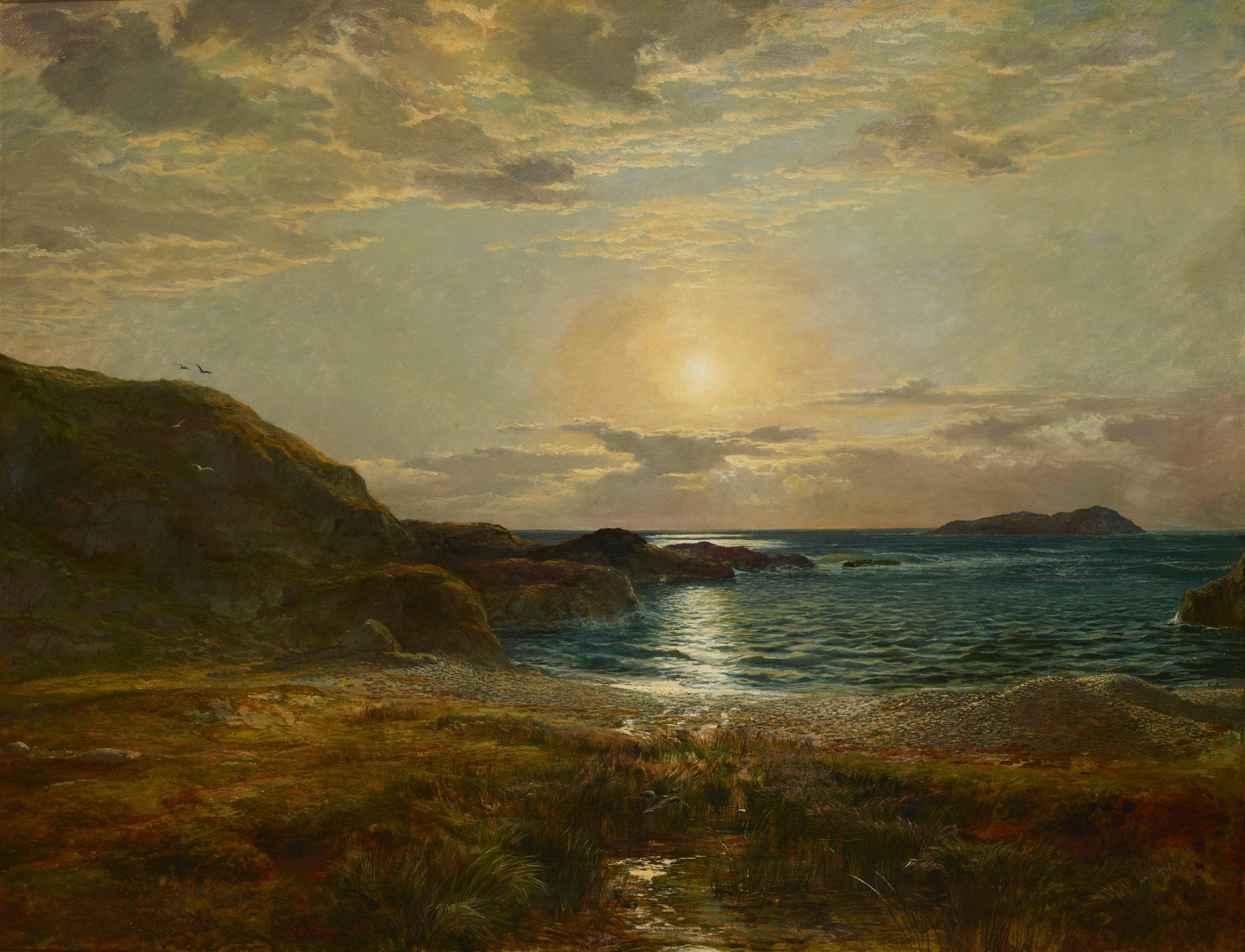

77 Other fees apply in addition to the hammer price: see the ‘Buyer’s Guide’ section on page 2
109
GEORGE WILLIAM HORLOR (BRITISH 1823-1895)
GUNDOGS ON A ROCKY OUTCROP

Signed and dated 1866, oil on canvas 86cm x 111cm (33.75in x 43.75in)
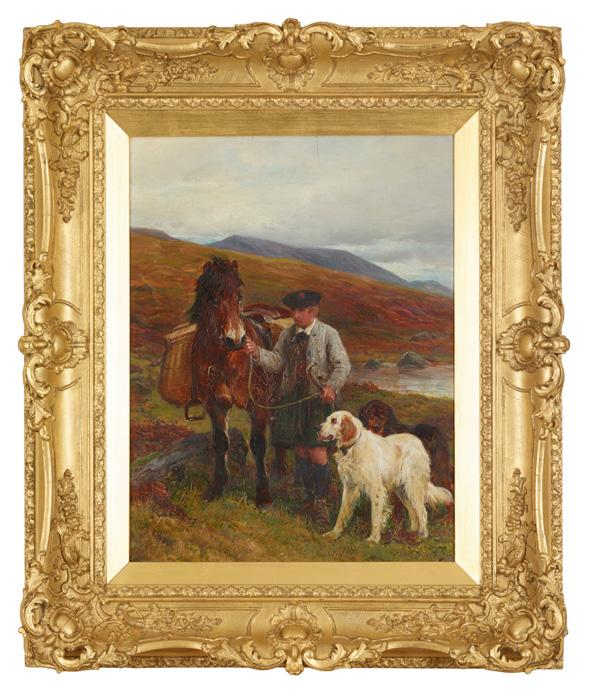

£3,000-5,000
110
JOHN SARGEANT
NOBLE R.B.A. (BRITISH 1848-1896)
THE YOUNG GAMEKEEPER
Signed, oil on panel 46cm x 36cm (18in x 14in)
£2,000-3,000
78 Other fees apply in addition to the hammer price: see the ‘Buyer’s Guide’ section on page 2
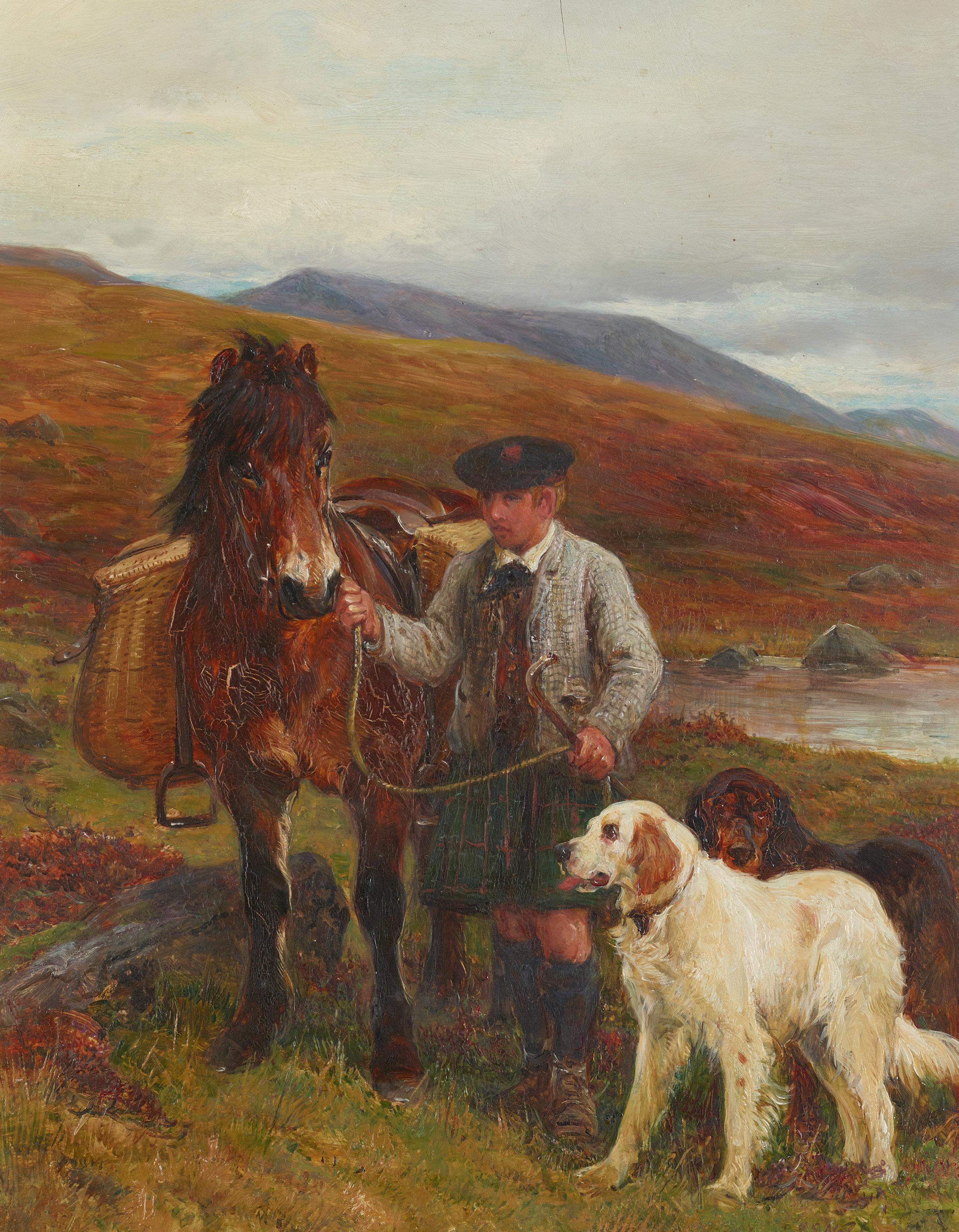
111
JOSEPH DENOVAN ADAM R.S.A., R.S.W. (SCOTTISH 1842-1896)
HIGHLAND CATTLE ON THE DROVE ROAD
Signed and dated 1876, oil on canvas
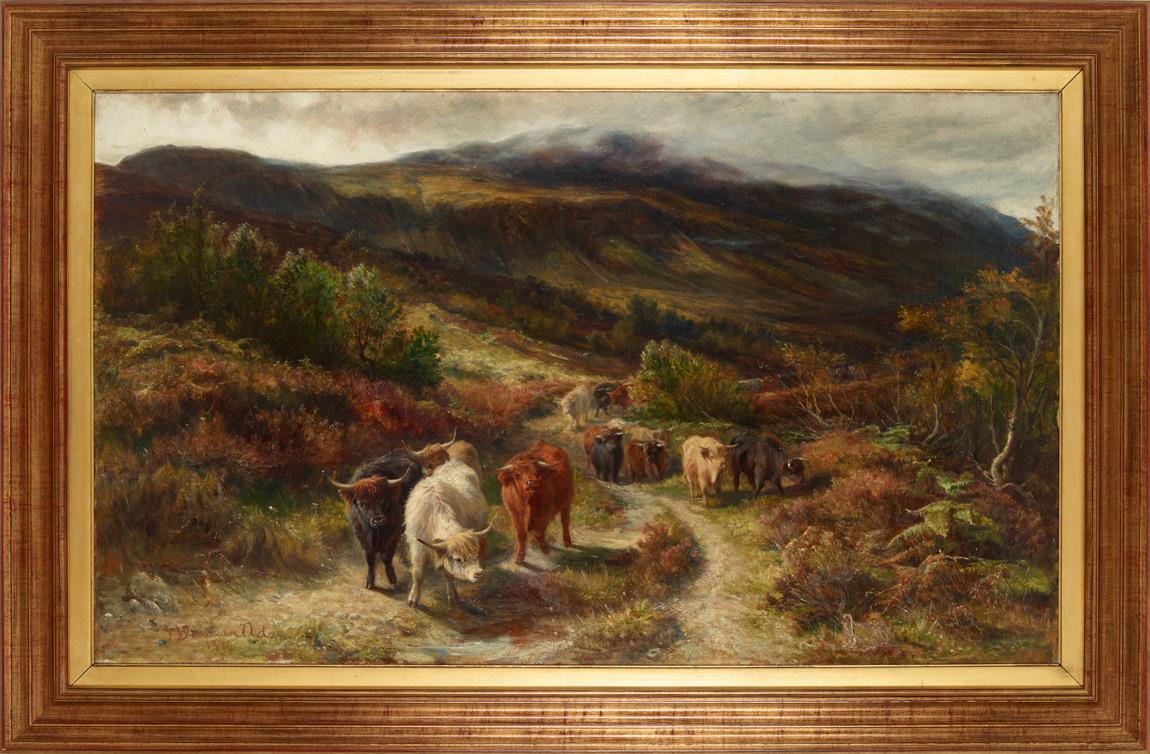

76cm x 127cm (30in x 50in)
£2,000-3,000
80 Other fees apply in addition to the hammer price: see the ‘Buyer’s Guide’ section on page 2
112
JOSEPH DENOVAN ADAM R.S.A., R.S.W. (SCOTTISH 1842-1896)
HOMEWARD BOUND
Signed and dated 1876, oil on canvas 80cm x 131cm (31.5in x 51.5in)

£2,000-3,000
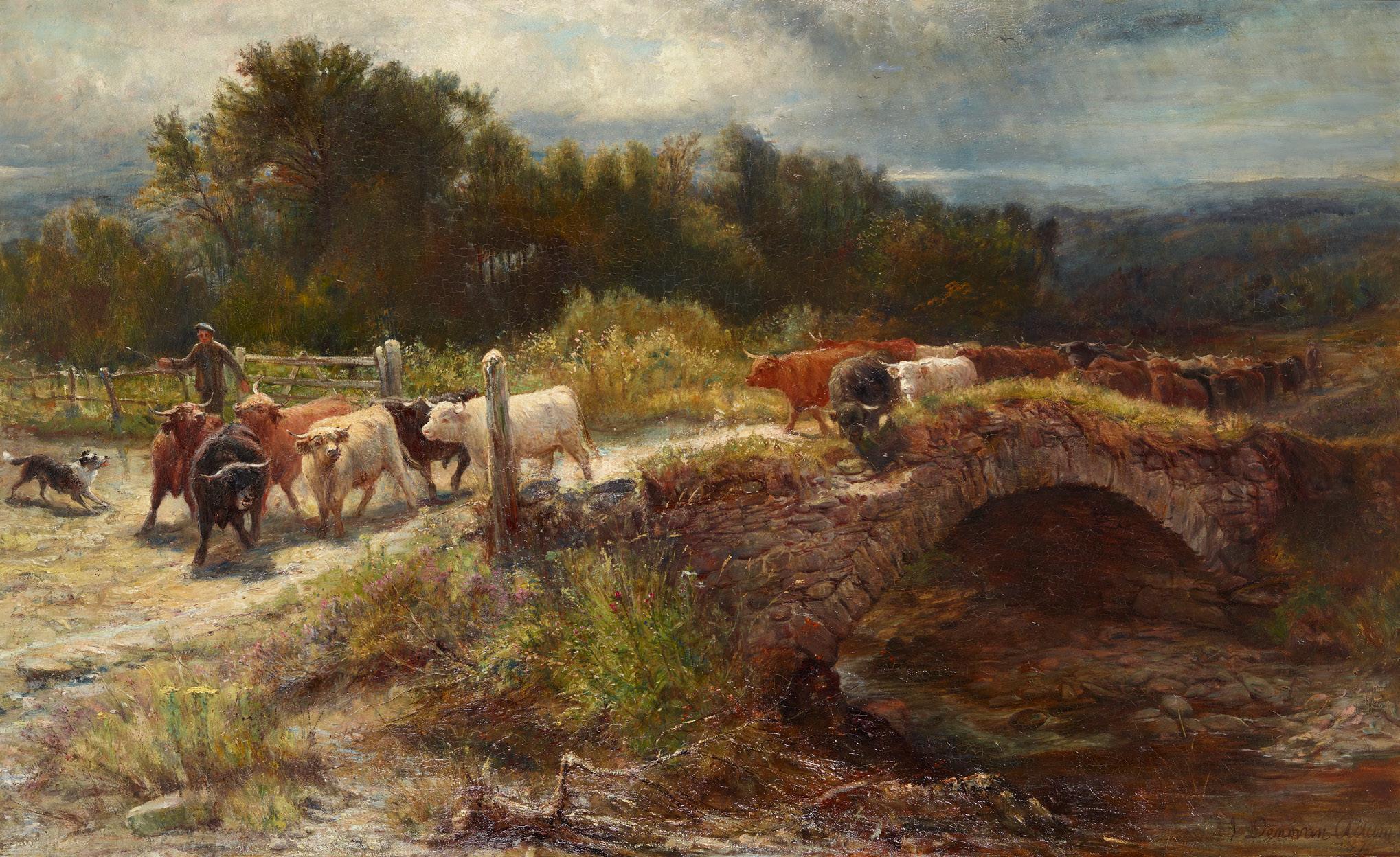
81
While holidaying in Saltcoats around 1871, Joseph Henderson met William McTaggart, who heartily encouraged him to paint landscapes. Henderson had formerly painted figurative genre scenes, but was so inspired by the Saltcoats coast, and by McTaggart’s example, that he henceforth became a painter of seascapes. His work from this period is characterised by free brushwork and a clear, light palette.
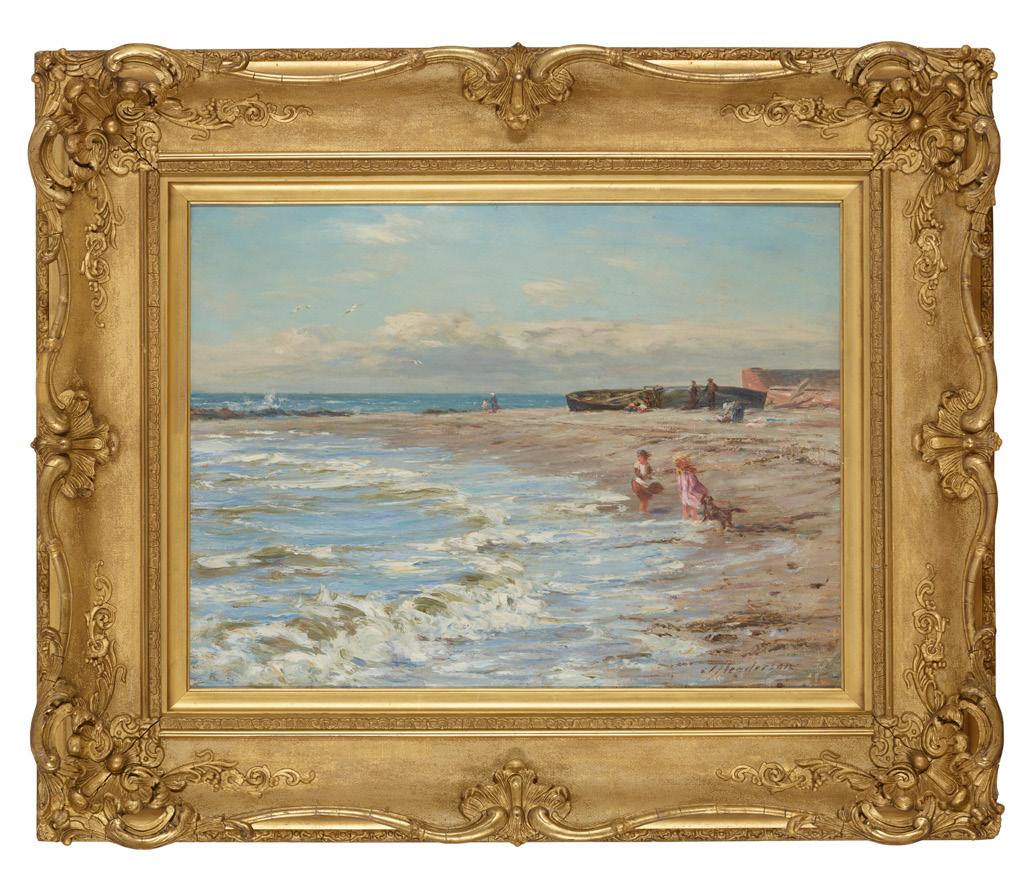
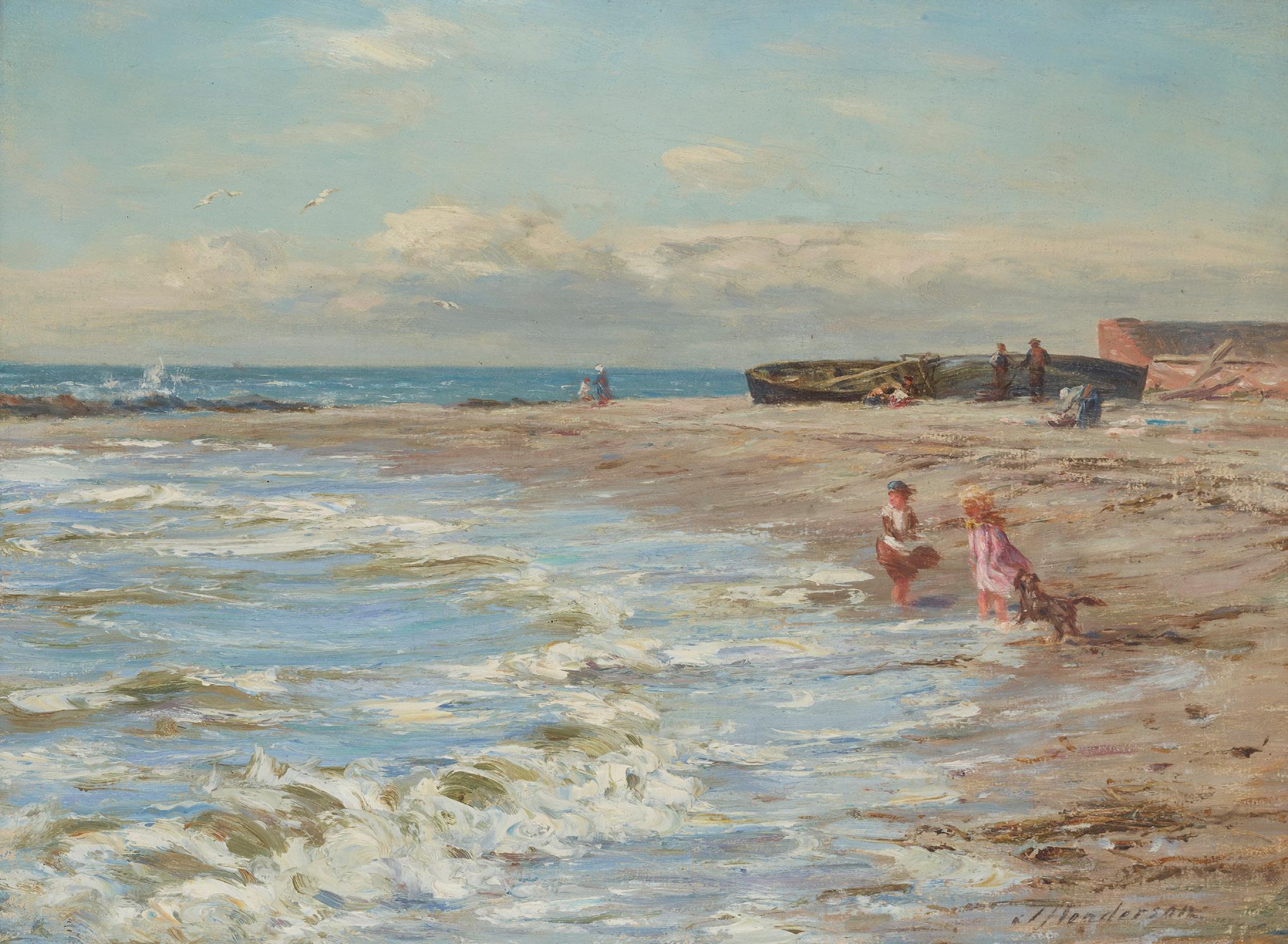
JOSEPH HENDERSON R.S.W. (SCOTTISH 1832-1908) ON THE BEACH
Signed, oil on canvas
46cm x 61cm (18in x 24in)
£3,000-5,000
113
82 Other fees apply in addition to the hammer price: see the ‘Buyer’s Guide’ section on page 2
They incorporate figurative components (usually holiday-makers or fishermen), but these are treated pragmatically and integrated within the scenery so that the landscape remains of primary importance. It is perhaps for this reason that Henderson’s seascapes evade sentimentality. His ability to capture an airy coastal atmosphere, from the roiling dynamism of waves to a salty breeze, is particularly of note, as evidenced by these exceptionally fine examples.
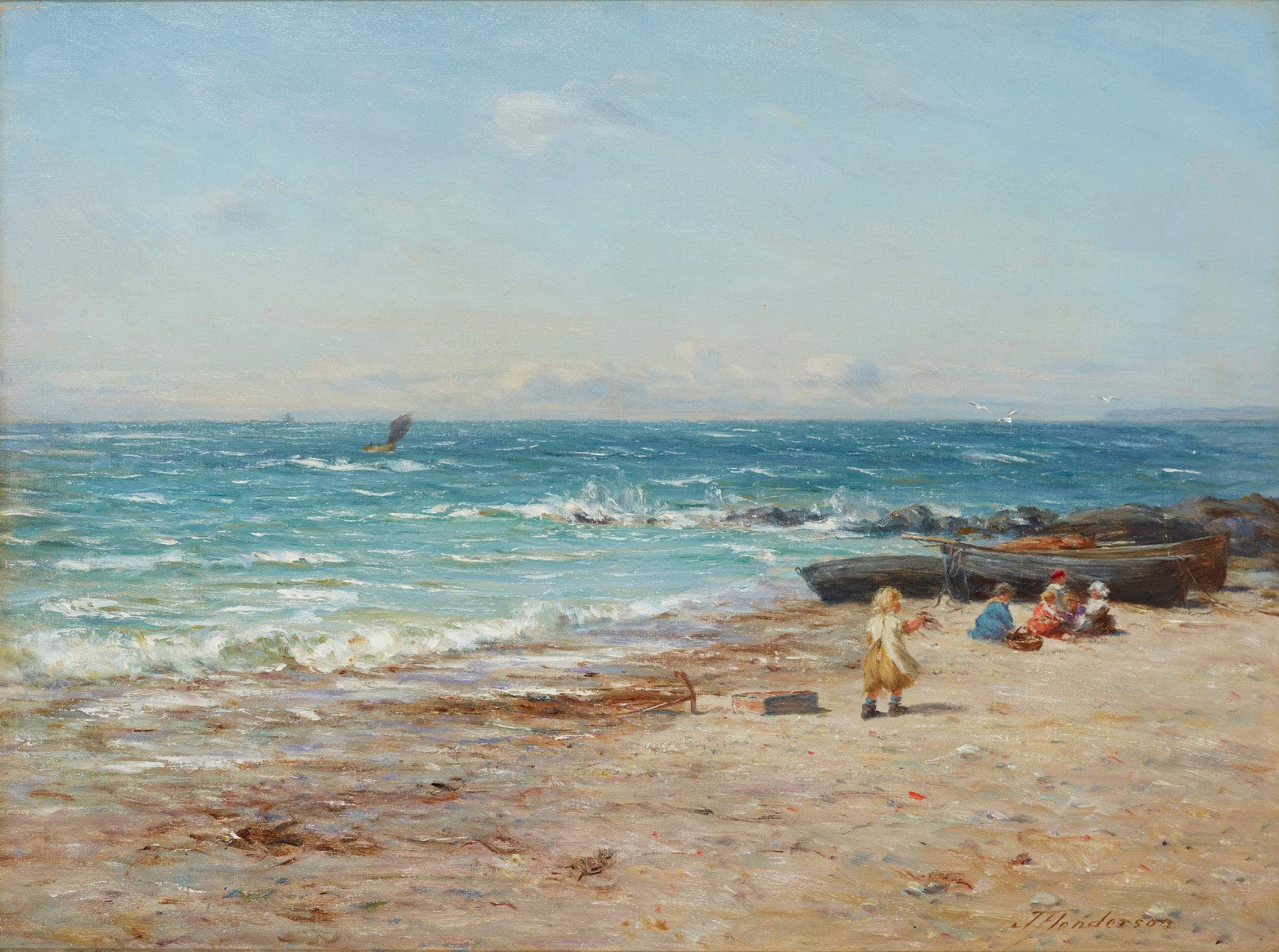

JOSEPH HENDERSON R.S.W. (SCOTTISH 1832-1908)
CHILDREN ON AN AYRSHIRE BEACH
Signed, oil on canvas
46cm x 61cm (18in x 24in)
£2,000-3,000
114
83
115
JOSEPH HENDERSON R.S.W. (SCOTTISH 1832-1908)

MENDING THE NETS
Signed, oil on canvas
78cm x 112cm (28in x 44in) £3,000-5,000

84 Other fees apply in addition to the hammer price: see the ‘Buyer’s Guide’ section on page 2
116
DAVID GAULD R.S.A. (SCOTTISH 1865-1936)
CALVES IN A BYRE

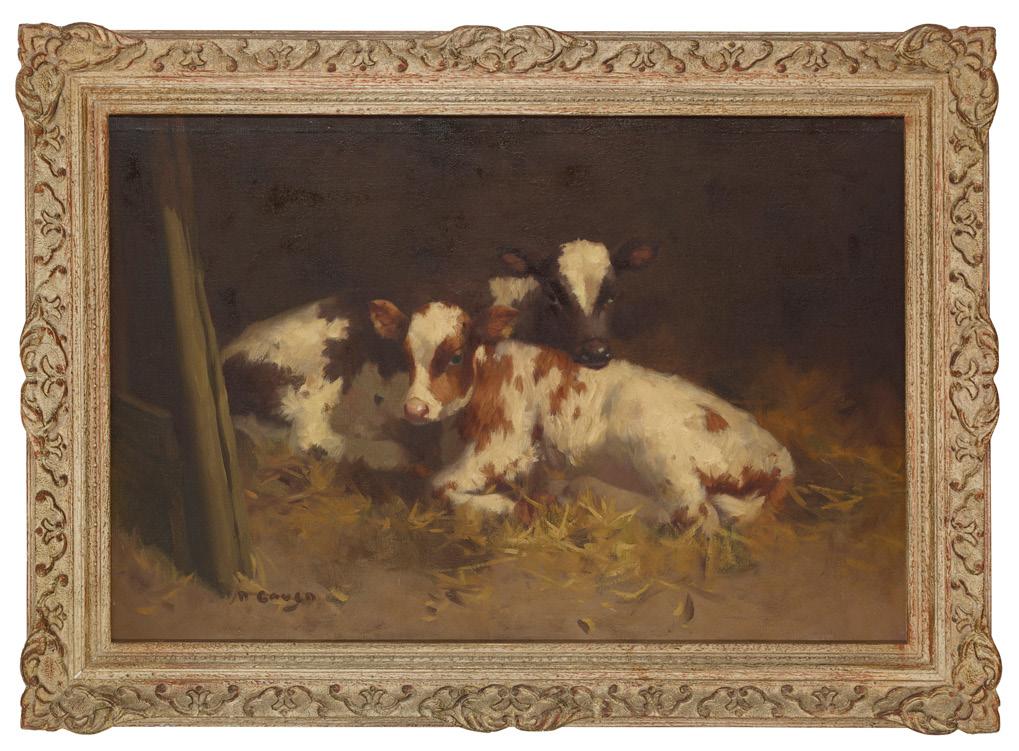
Signed, oil on canvas
51cm x 76cm (20in x 30in)
£2,000-3,000
85
117
118
In Arcady exemplifies the success of the ‘Glasgow Boys’, including James Paterson, in progressive art circles in Germany in the late 1890s. The ‘Boys’ first came to international notice when their work was shown to great acclaim at the Grosvenor Gallery, London in 1890. As Roger Billcliffe has explained:
Their exhibition was the final show at the Grosvenor Gallery and so attracted much press attention. This in turn caught the eyes of several of the new exhibiting bodies in Europe, principally secessionist, where naturalism was becoming accepted as a logical compromise between academic painting and the avant-garde work of the Impressionists.
The Grosvenor Gallery exhibition was taken to Munich and from there the Boys began to exhibit throughout Europe and beyond…The Boys also began individually to send their work to the Paris Salon and similar institutions in Europe. (Roger Billcliffe, Glasgow Boys, Oxford Dictionary of National Biography, on-line edition accessed 9 May 2023)
Illustrating this positive reception to Paterson’s work on the Continent, In Arcady was accepted for inclusion in the sixth exhibition of the Munich Secession in 1899. This forward-looking artists society was founded in 1892, as an alternative to the conservative Munich Artists Association.
Such was the appreciation of the Boys in Munich that, as Henry Prais has written:
A WOODED MOONLIT RIVER LANDSCAPE
Signed, oil on canvas
110cm x 61cm (43.25in x 24in)
£2,000-3,000
JAMES PATERSON R.S.A., R.S.W., R.W.S. (SCOTTISH 1854-1932)
IN ARCADY
Signed and dated 1897, signed and inscribed verso, oil on canvas 91cm x 71cm (36in x 28in)
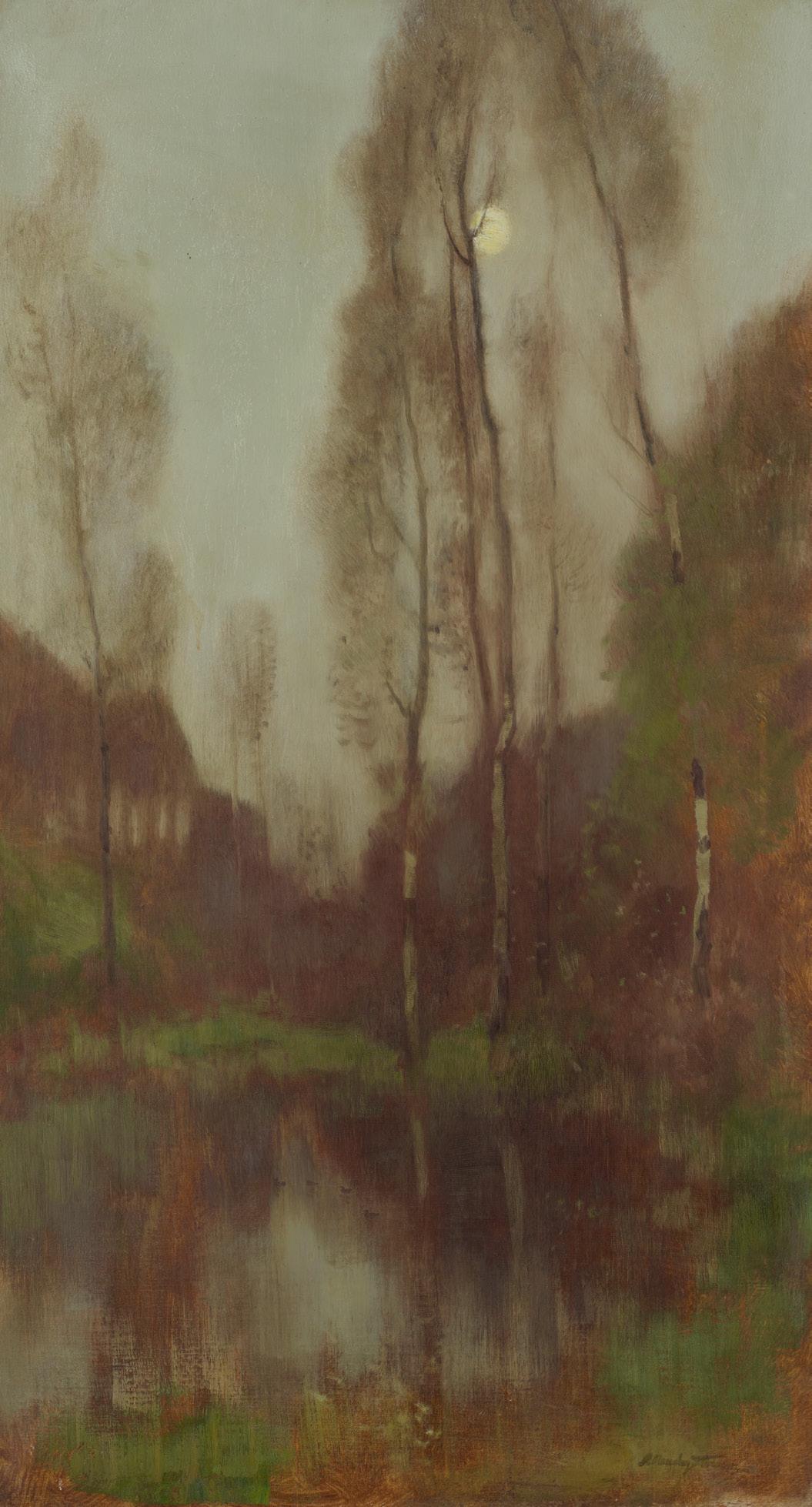
Provenance: Bruno and Paul Cassirer, Berlin
Exhibited: VI Internationale KunstAusstellung der Münchener Secession, Munich, 1899, no. 27 (lent by the Artist)
£4,000-6,000
In the course of the next decade the Boys showed in Munich alone, between the exhibitions of the Munich Art Society in the Glaspalaste and those of the Secession in the Prinzregentenstrasse, more than six hundred of their works…It is scarcely surprising then that Sir William Rothenstein in his Men and Memories…should remark: ‘I used to say of the Glasgow school, so much admired in Munich and Dresden, that their reputation was made in Germany!’ (Henry Prais, ‘The Boys Abroad: On the Continent’, The Glasgow Boys, Scottish Arts Council, 1971, p.69)
Moreover, In Arcady was acquired by the cousins Bruno and Paul Cassirer who established a gallery and publishing house in Berlin in 1898. They were key champions of modern and contemporary art and were, for example, founding secretaries of the Berlin Secession, also in 1898.
ROBERT MACAULAY STEVENSON R.S.W. (BRITISH 1854-1952)
Other fees apply in addition to the hammer price: see the ‘Buyer’s Guide’ section on page 2

119
JOSEPH FARQUHARSON
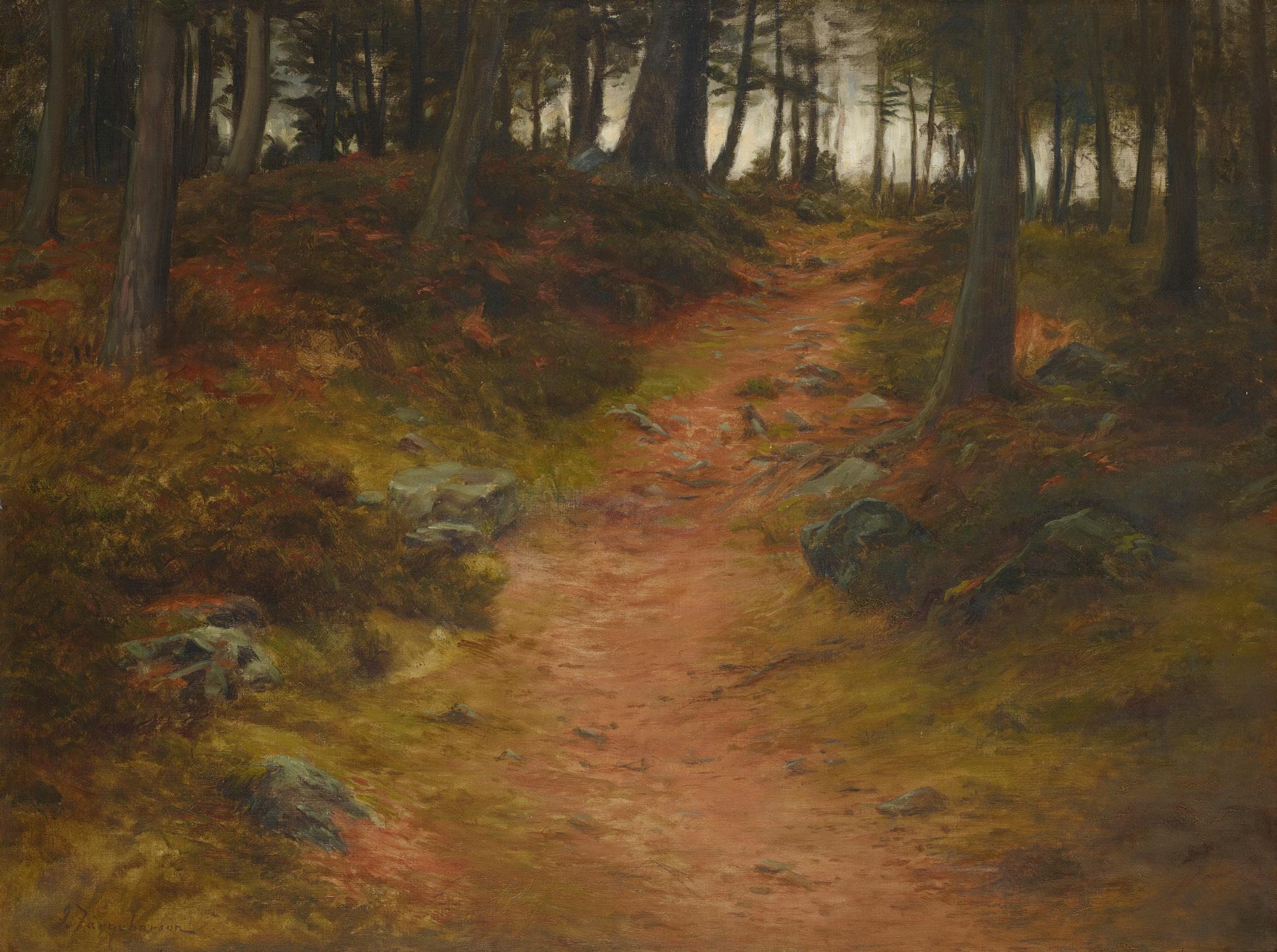
R.A. (SCOTTISH 1846-1935)
PATH THROUGH THE WOODS

Signed, oil on canvas
76cm x 102cm (30in x 40in)
£6,000-8,000
88
120
ALFRED DE BREANSKI
SENIOR (BRITISH 1852-1928)
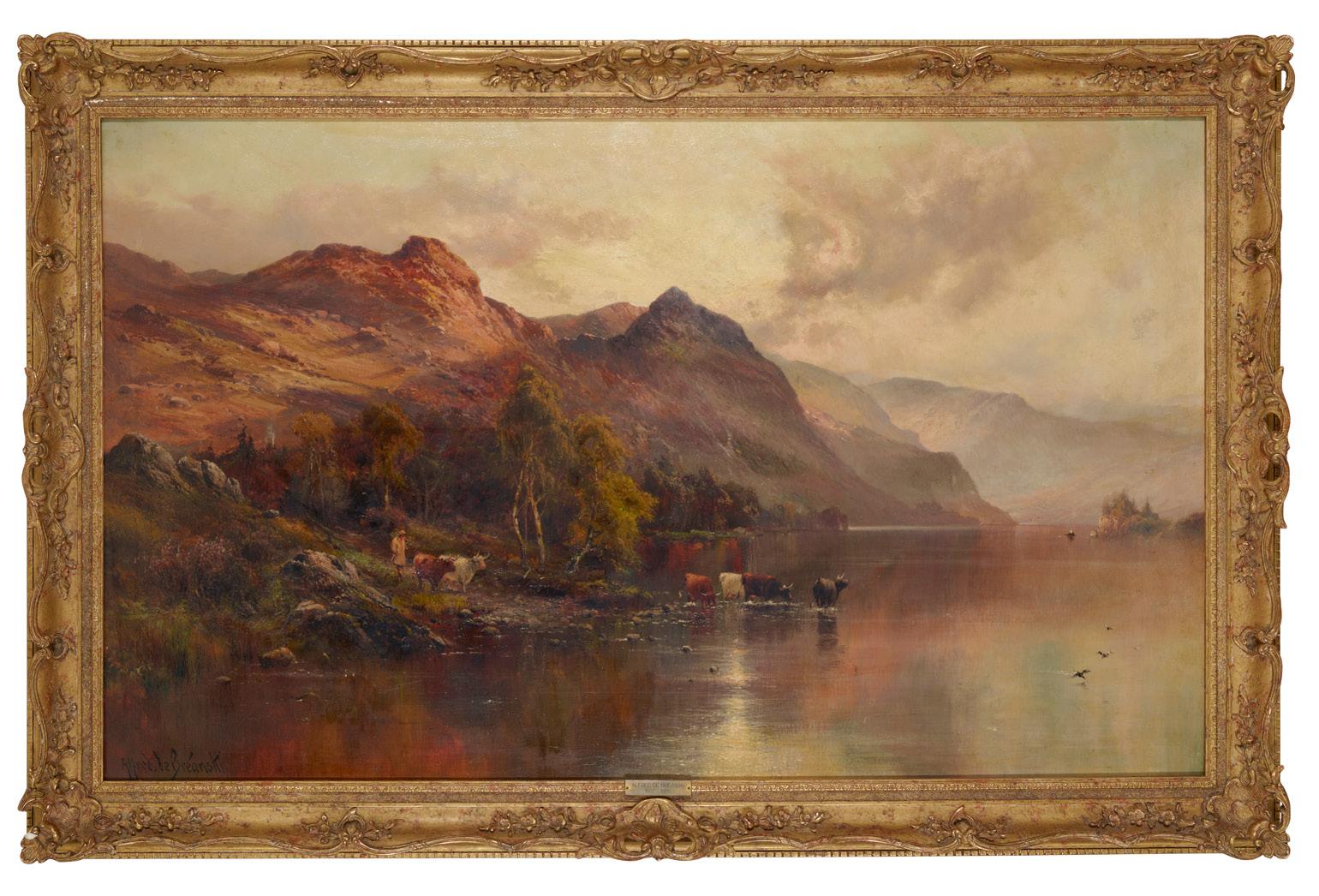
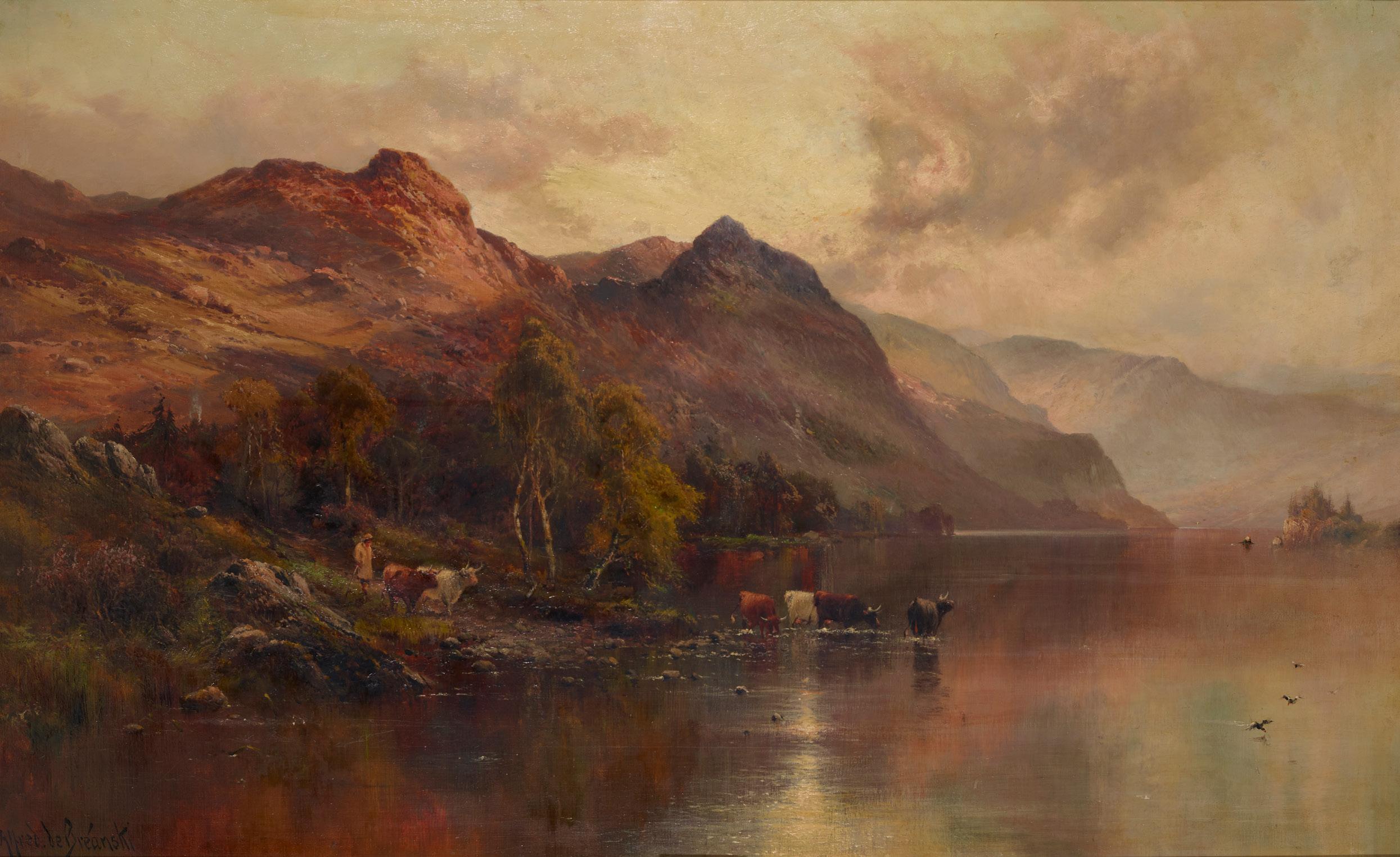
AT GRANGE, CUMBERLAND
Signed, signed and inscribed verso, oil on canvas
76cm x 127cm (30in x 50in)
£8,000-12,000
89 Other fees apply in addition to the hammer price: see the ‘Buyer’s Guide’ section on page 2
121
DAVID FARQUHARSON

A.R.A., A.R.S.A., R.S.W., R.O.I. (SCOTTISH 1840-1907)
LANGDALE, CUMBERLAND
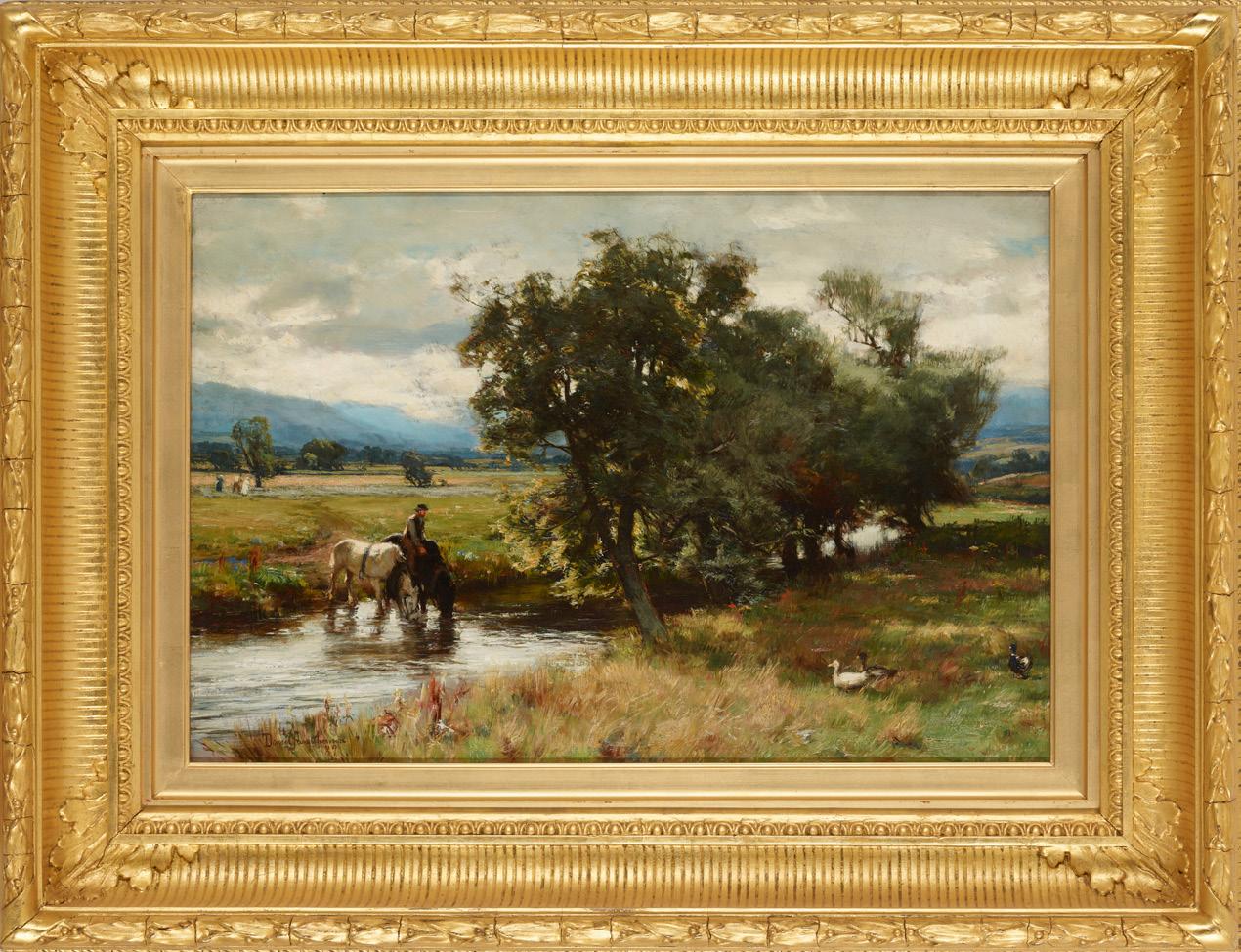
Signed and dated ‘89, signed with initials and inscribed verso, oil on canvas 41cm x 61cm (16in x 24in)
£2,000-3,000
90 Other fees apply in addition to the hammer price: see the ‘Buyer’s Guide’ section on page 2
Like many nineteenth-century artists, David Farquharson’s career started as a trade apprentice. Whilst a youth he trained as a painter-decorator in Blairgowrie and upon completion of his apprenticeship he worked around Ireland and the south of Scotland, ultimately going into business with his brother. In his spare time he painted landscapes. Farquharson was entirely self-taught and his work demonstrates a continual improvement in quality, with later works (such as the present lots) being amongst his finest. His palette was inspired by the early work of Corot, as well as that of the Hague school, whose works were popular and widely-collected in Scotland at the time. Farquharson was an accomplished painter of changing light and weather, aided by loose and confident brushwork. His preferred subjects combined topographical components with social studies of locals around Scotland, northern England and Cornwall.
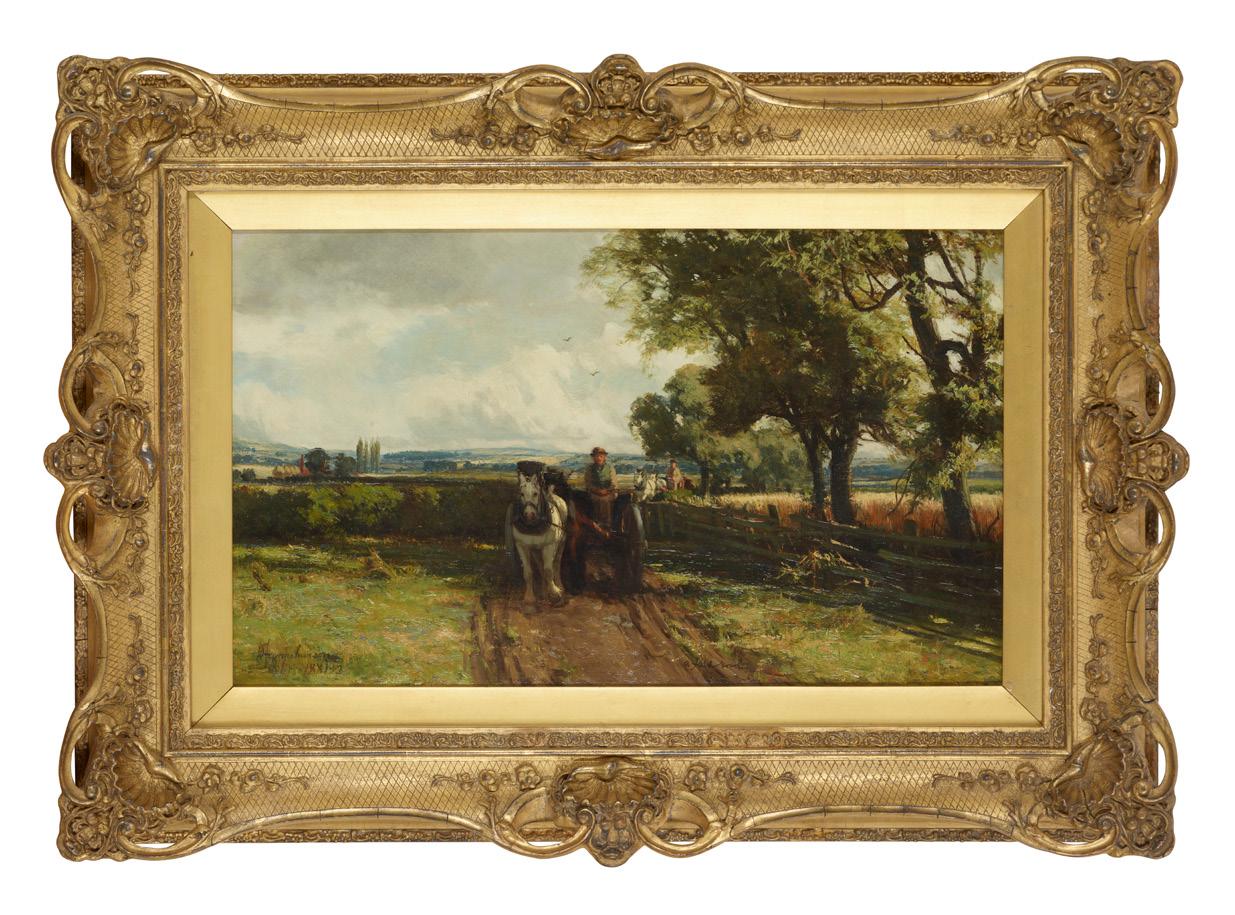
£2,000-3,000

122
DAVID FARQUHARSON
A.R.A., A.R.S.A., R.S.W., R.O.I. (SCOTTISH 1840-1907)
OFF TO MARKET
Signed, inscribed ‘A Field Road’ and dated 1881-2, oil on canvas
30.5cm x 51cm (12in x 20in)
91
£1,500-2,000
ODALISQUE
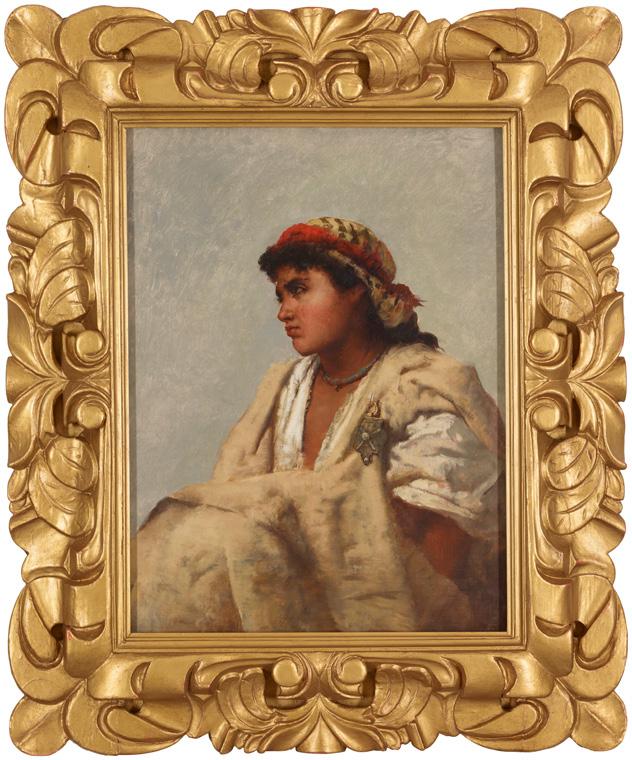
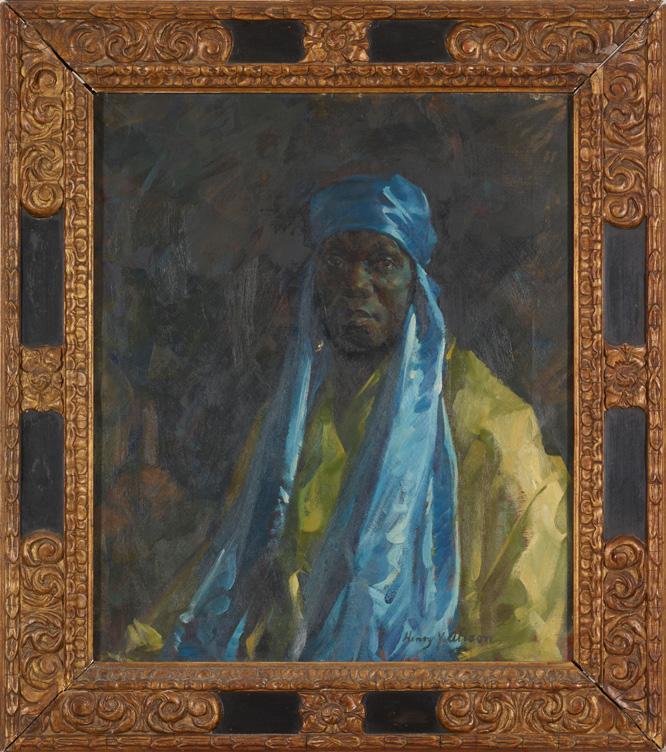
£3,000-5,000
 123 § HENRY YOUNG ALISON (SCOTTISH 1889-1972)
THE BLUE HEADDRESS Signed, oil on canvas 76cm x 63.5cm (30in x 25in)
124 † ROBERT GAVIN R.S.A. (SCOTTISH 1827-1883)
With the Artist’s Trustees stamp verso, oil on canvas 61cm x 46cm (24in x 18in)
123 § HENRY YOUNG ALISON (SCOTTISH 1889-1972)
THE BLUE HEADDRESS Signed, oil on canvas 76cm x 63.5cm (30in x 25in)
124 † ROBERT GAVIN R.S.A. (SCOTTISH 1827-1883)
With the Artist’s Trustees stamp verso, oil on canvas 61cm x 46cm (24in x 18in)
92 Other fees apply in addition to the hammer price: see the ‘Buyer’s Guide’ section on page 2

125 § †
WILLIAM OLIPHANT HUTCHISON
P.R.S.A., R.P. (SCOTTISH 1889-1970)
EARLY SUMMER
Signed and dated 1919, oil on canvas

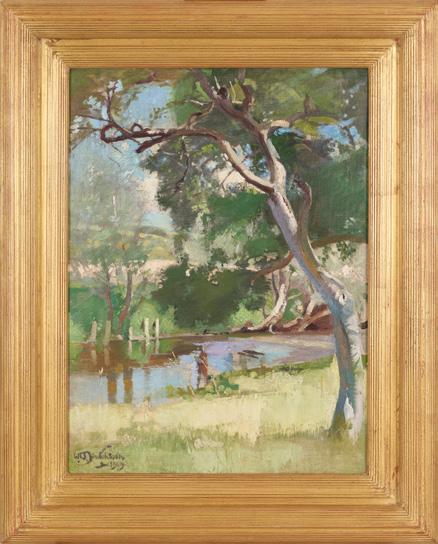
61cm x 46cm (24in x 18in)
£2,000-3,000
94
126
PATRICK WILLIAM ADAM
R.S.A. (SCOTTISH 1854-1929)
A GRACEFUL INTERIOR
Signed, oil on canvas
51cm x 48cm (20in x 18in)
Provenance: Phillips, Edinburgh, 2 December 1988, lot 22
Richard Green, London (RH 1273)
Exhibited: The Goupil Gallery Salon, London, 1912, no.165

£5,000-7,000

95 Other fees apply in addition to the hammer price: see the ‘Buyer’s Guide’ section on page 2
DAVID GAULD
R.S.A. (SCOTTISH 1865-1936)
ELEGANT FIGURES IN THE STREET, CHELTENHAM
Signed and inscribed, pen and ink and watercolour
35cm x 25cm (13.75in x 9.75in)
Provenance: The Glasgow Art Club
£8,000-12,000
David Gauld is best known for his depictions of sun-dappled cattle in byres or Ayrshire fields. However, in his early career Gauld was an innovator within the radical group of artists known as the Glasgow Boys. Gauld trained at the Glasgow School of Art between 1882 and 1885. In the late 1880s he made a name for himself as an illustrator for The Glasgow Weekly Citizen. It was during his time sharing a studio with fellow artist Harrington Mann (1864-1937) and then at 351 Renfrew Street that he honed his painting. As an artist he was immersed in the city’s artistic community - an apprenticeship with Stephen Adam taught him skills in stained glass and later a close friendship with Charles Rennie Mackintosh (1868-1928) linked him with the applied arts. In the late 1930s he was appointed Director of Design at the Glasgow School of Art.
Elegant Figures in the Street, Cheltenham is an extremely rare work showing both the artist’s ability in watercolour and his skilled draughtsmanship at the turn of the century. Gauld was familiar with figurative work, during the 1890s he painted stylised portraits with exuberant paint handling and strong use of colour (see The New Bonnet sold by Lyon & Turnbull on 31 May 2012, lot 133).
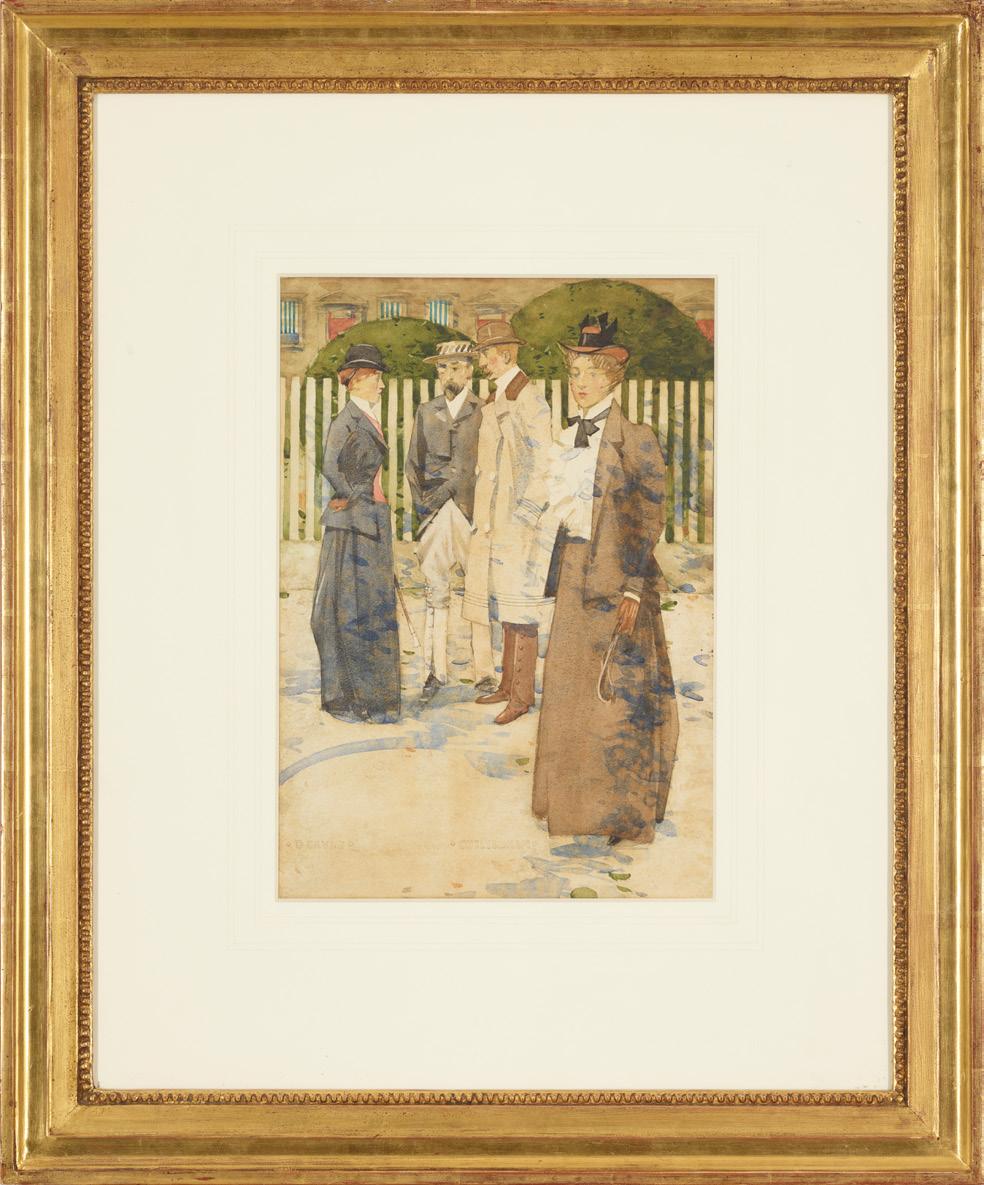
Although the figures in Elegant Figures in the Street, Cheltenham are not identified they may well be friends of the artist and members of the art world. A companion work Broadway (National Galleries of Scotland, PG2704) depicts the artist couple Robert Macaulay Stevenson and Stansmore Macaulay Stevenson (née Dean), alongside Margaret Gauld (née Paterson). Much like Gauld’s figurative stained glass and early work in oil painting, this watercolour has a strong narrative comparable to the social reflection done by other members of the Glasgow School – notably the figurative work by E. A. Walton and Sir John Lavery of the Helensburgh bourgeoisie in the late 1880s. The Eastern influence in the flat composition and the opacity of colour draws from the highly fashionable Japanese print at the end of the nineteenth century. The work can also be closely associated with the artist’s own preparatory cartoons for stained glass window designs.
Gauld enjoyed membership of the illustrious Glasgow Art Club and it is thought that the work was gifted by his widow to the Club on this death.
127
96 Other fees apply in addition to the hammer price: see the ‘Buyer’s Guide’ section on page 2
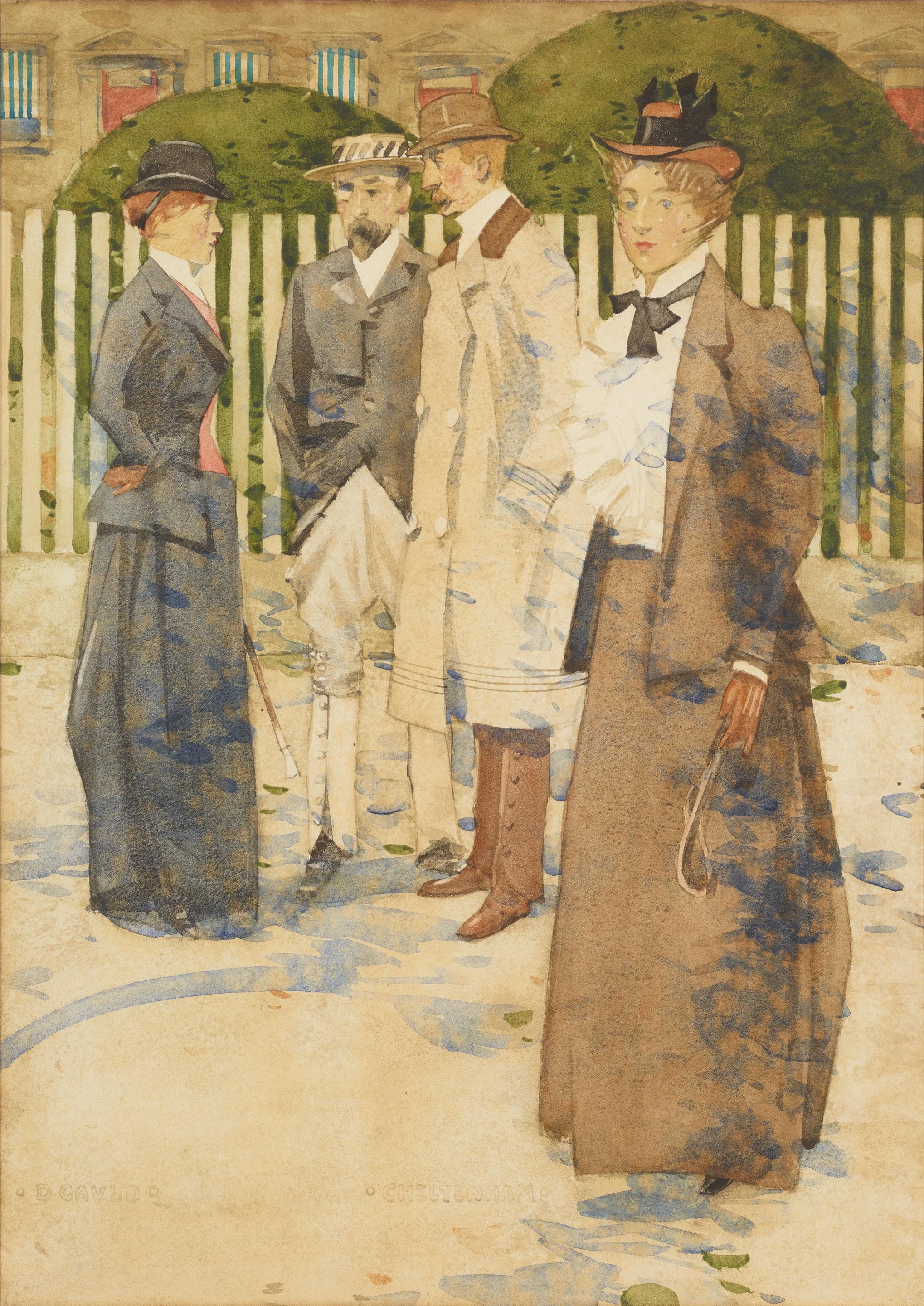
Artist Friends: Eric Robertson & Anne Finlay
Anne Finlay (1898-1963) trained at Edinburgh College of Art where she became friends with her teacher Dorothy Johnstone and thus Johnstone’s fellow members of the Edinburgh Group exhibiting society, including Eric Robertson and his wife Cecile Walton.
1920 was a key year for the artists, with the Group’s second post-war exhibition in the New Gallery, Shandwick Place and Robertson’s solo exhibition at The Petit Salon on South Castle Street. Of the former, the critic Frederic Quinton exclaimed:
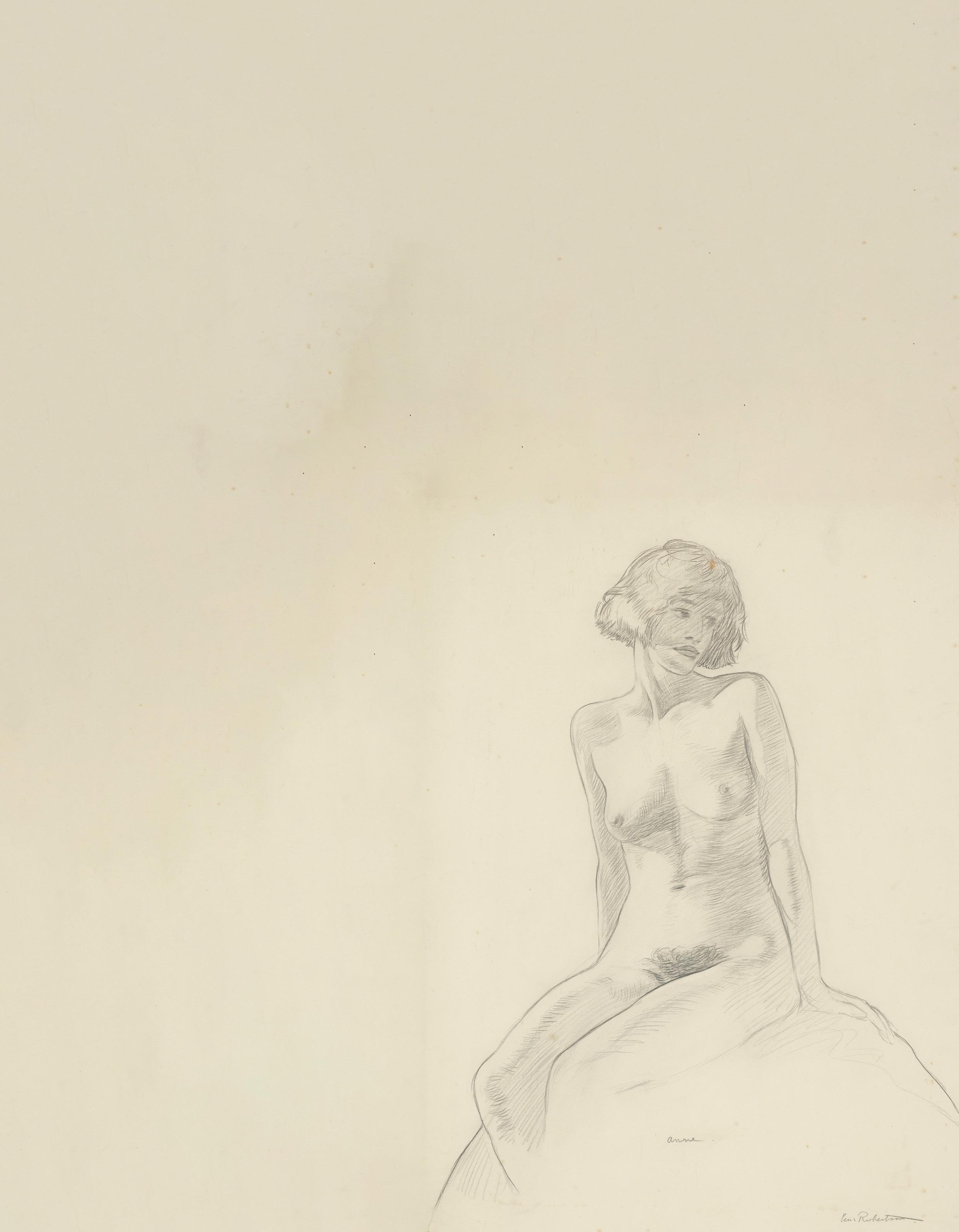
Usually people look to the Edinburgh Group, as we know them, for something unique rather than universal: for something of pagan brazenness rather than parlour propriety. Half of Edinburgh goes to Shandwick Place secretly desiring to be righteously shocked and the other half goes feeling deliciously uncertain it may be disappointed by not finding anything sufficiently shocking. And so these young and talented artists are primarily expected to provide entertainment rather than enlightenment. Hence so much splendid achievement goes unnoticed. (Frederic Quinton, The National Outlook, November 1920, pp.102-103)
In his turn, the critic of The Scots Pictorial declared of Robertson:
[He did]…much to lend spice and variety to the show. He is nothing if not alive! Vitality is the very essence of his art. Mr Robertson ranks as the vital unit of the group. In landscape he deals with the eternal aspect of mountains…and in quite another mood paints portraits and figure subjects of rare imaginative quality. (As quoted in John Kemplay, The Two Companions: The Story of Two Scottish Artists – Eric Robertson and Cecile Walton, Ronald Crowhurst & Co., Edinburgh, 1991, p.88)
Furthermore, 1920 was a significant year for the group’s friendships, as John Kemplay has recounted:
[Cecile]…had made a new friend in Anne Finlay, a very attractive and vivacious student…Eric used her more and more to model for him and when he and Cecile rented a house at Crianlarich in Perthshire for May and June of 1920, Anne Finlay was invited to join them for part of the time. Behind the house, there was a waterfall leading to a pool where Eric, Cecile, Anne Finlay and others would bath in the nude together; and it was this setting which figured in a number of paintings and drawings he completed during the two months they spent there. (John Kemplay, op.cit., pp.89-90)
By the Rock Pool and Anne Finlay were both made during this happy, carefree and somewhat daring holiday and reveal the sitter’s plentiful attractions. She moved to London in 1922, where she held various teaching posts before becoming Registrar of the City & Guilds of London Art School. Throughout, she maintained her own practice, exhibiting regularly at the Royal Academy of Arts, with the Society of Women Artists and the Royal Scottish Academy; she was elected a member of the New English Art Club in 1953.
We are grateful to John Kemplay for his help in researching these works
128
ERIC HARALD MACBETH ROBERTSON (SCOTTISH 1887-1941)
BY THE ROCK POOL
Oil on canvas
44cm x 59cm (17.25in x 23.25in)
Provenance: The Artist’s Estate Kemplay & Robertson, Edinburgh (AK 1064)
Bonhams Edinburgh, The Scottish Sale, 25 August 2006, lot 1091, where acquired by the present owner £5,000-7,000

99 Other fees apply in addition to the hammer price: see the ‘Buyer’s Guide’ section on page 2
129
ERIC HARALD MACBETH ROBERTSON (SCOTTISH 1887-1941)
THE GRAMPIANS
Signed and dated 1913, inscribed verso, oil on canvas 81cm x 117cm (32in x 46in)
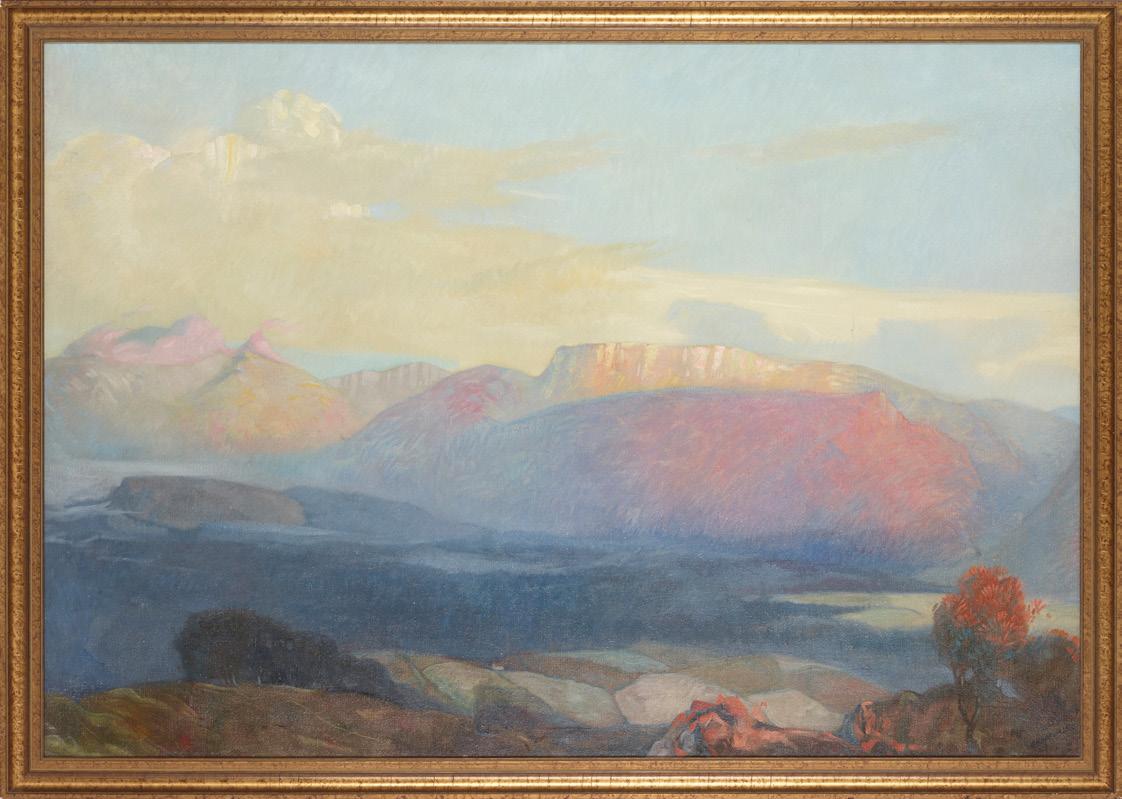
Provenance: By descent from the Artist to the present owner £4,000-6,000
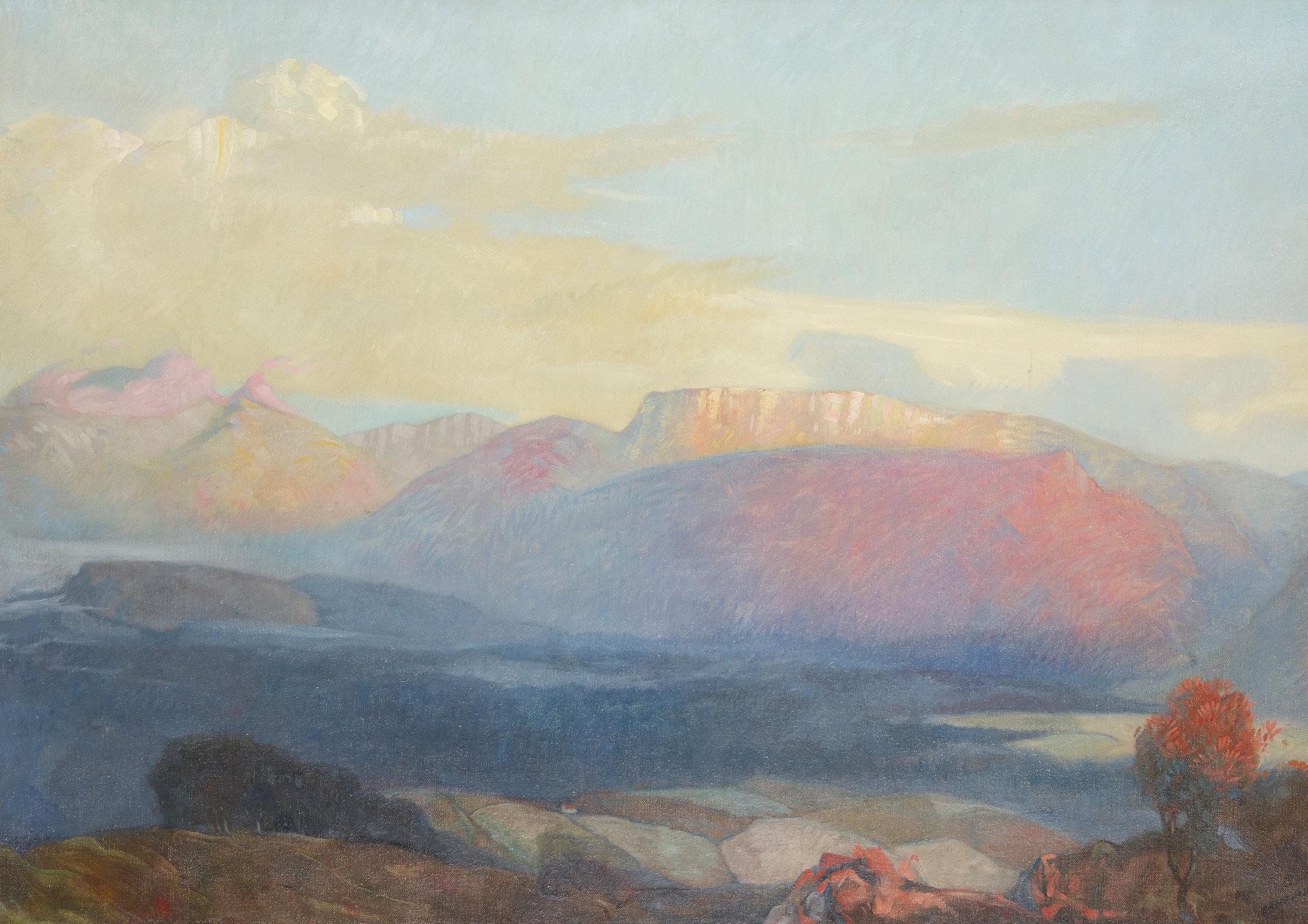
ERIC HARALD MACBETH ROBERTSON (SCOTTISH 1887-1941)
ANNE FINLAY
Signed and inscribed, pencil
47cm x 36cm (18.5in x 14.25in)
Provenance: Kemplay & Robertson, Edinburgh (AK 1135)
£700-1,000
131 §
WILLIAM MCCANCE (SCOTTISH 1894-1970)
CROUCHING FIGURE
Signed and dated 1925, charcoal, and a companion by the same hand, ‘Back of Nude’ (2)

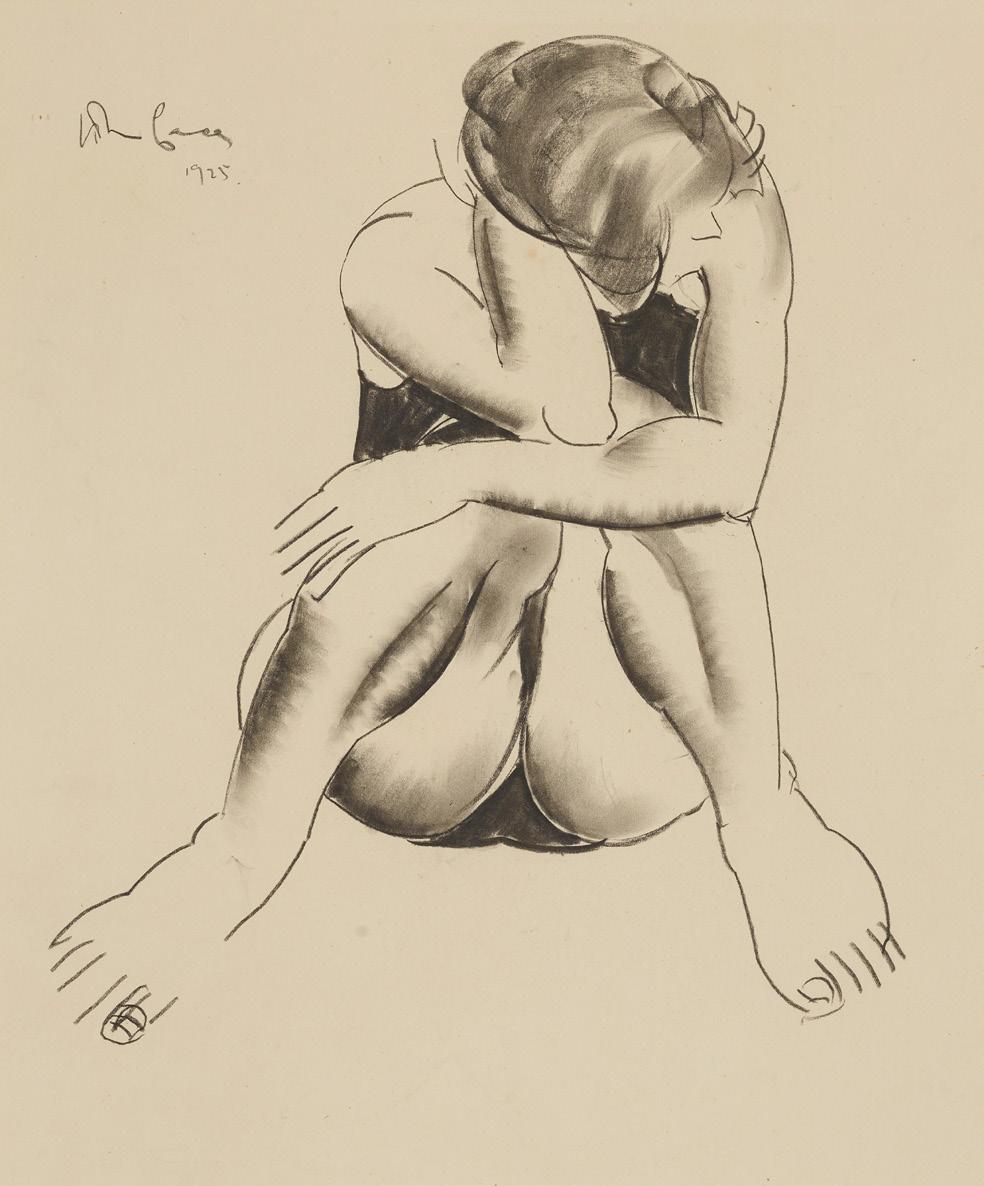
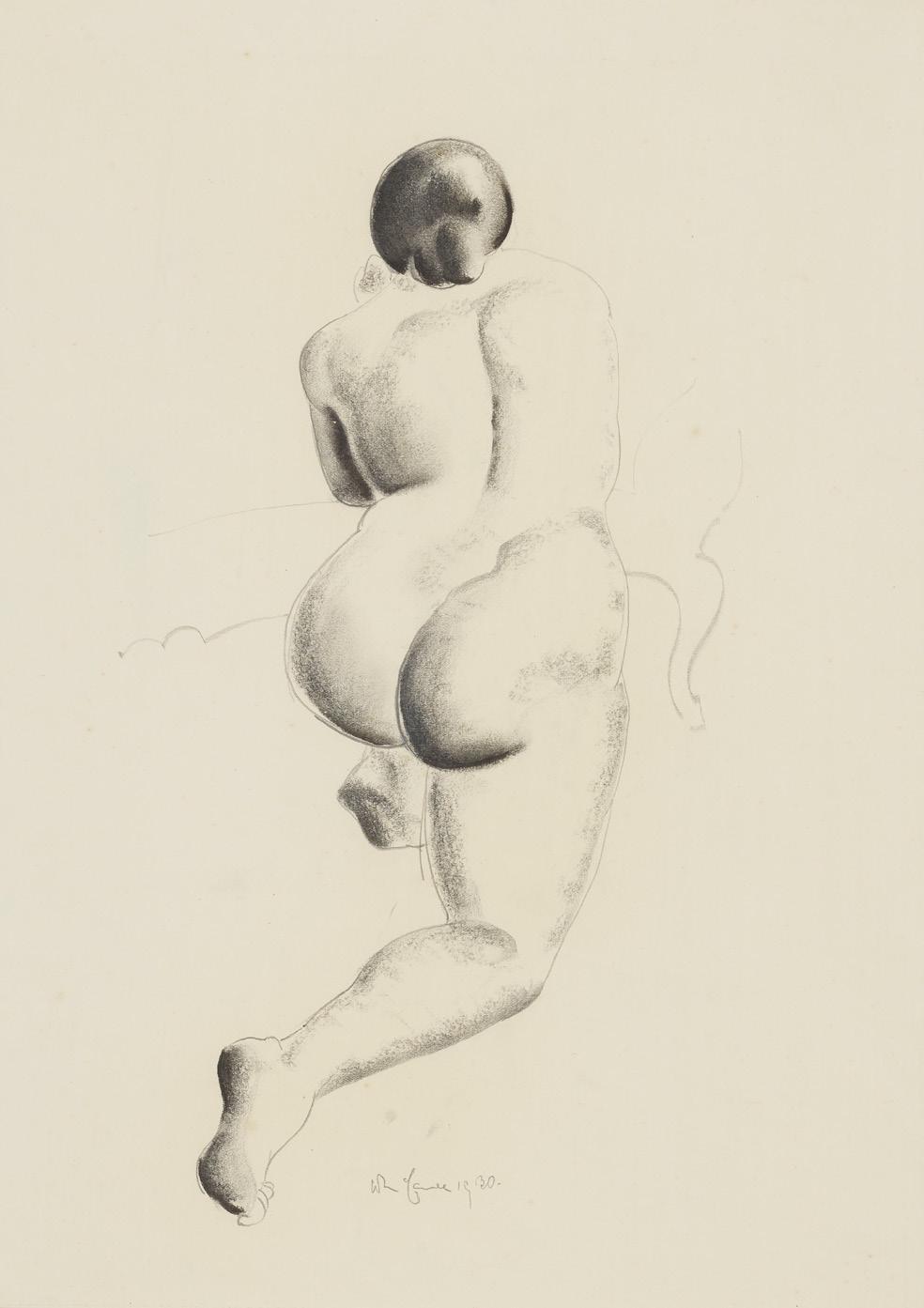
39cm x 32cm (15.5in x 12.5in)
Provenance: The Artist’s widow
£800-1,200
130
101 Other fees apply in addition to the hammer price: see the ‘Buyer’s Guide’ section on page 2
Robert Brough: An International Aberdonian
In around 1900 a young Aberdonian artist named Robert Brough arrived in London. A rising star whose recent paintings had prompted a media frenzy, Brough felt compelled to relocate to the English capital to further develop his artistic career. Chelsea was the beating heart of London’s art world; accordingly, Brough took a lease at Rossetti Studios in Flood Street.
Despite his youth, Brough already had the experience and credentials to mark him as an artist of consequence. He had trained in Paris at the Académie Julian, where in 1894 he shared lodgings with the Scottish Colourist S. J. Peploe (1871-1935), and following this spent a period working in Brittany, inspired by Paul Gauguin (1848-1903). He was charmed by the traditional way of life of the Breton people, and by the distinctive quality of light and vivid colouring of the landscape.
Both Gauguin and Brough assimilated the tenets of the Synthesist movement, a painting style which prioritised the use of flat planes of harmonious colour and of rhythmic, pattern-inflected composition in favour of naturalistic representation. Brough’s Brittany work firmly acknowledges Syntheticism but is tempered by an observational grounding, owing to his fascination with the Breton peoples’ lives and customs. His paintings from this period constitute a sensitive record of a traditional people, rendered with an innovatively modern, almost postImpressionist eye.
Jennifer Melville observed that ‘In Breton Women Sitting on a Beach Brough sets the silhouettes created by [the] local costumes against a glowing pink sand - coming as close to Gauguin’s flat patterns as in any work’. (Jennifer Melville, Robert Brough, Aberdeen Art Gallery, 1995, p.21)
Upon returning to Aberdeen in 1894, Brough began to earn a living as a portrait artist. He soon attracted commissions from notable families in the area, particularly those involved with the arts. His style retained the compositional brilliance of his earlier work, but his technique became increasingly dynamic and ‘sweeping’ owing to his confident application of licks of oil pigment.
Sweet Violets dates to 1897, when Brough was establishing himself as an accomplished society portraitist, and is one of the artist’s masterpieces. His characteristically flamboyant brushwork delineates the elegant profile and fashionable attire of his subject, Barbara Staples, whom Brough had secured permission to paint after a meeting in Aberdeen. Affixed under Staples’ spectacular hat is a delicate patterned veil, through which her pink lips and cheeks are visible. She holds aloft a jar of violets, with their purple hues reflected at her throat and cuffs, inviting comparison between the beauty of the sitter and the flowers she holds. Sweet Violets and a companion painting titled Fantaisie en Folie (now in the Tate collection) implement a similar palette and portray their sitter in profile against a plain background, which Thomas Cooper
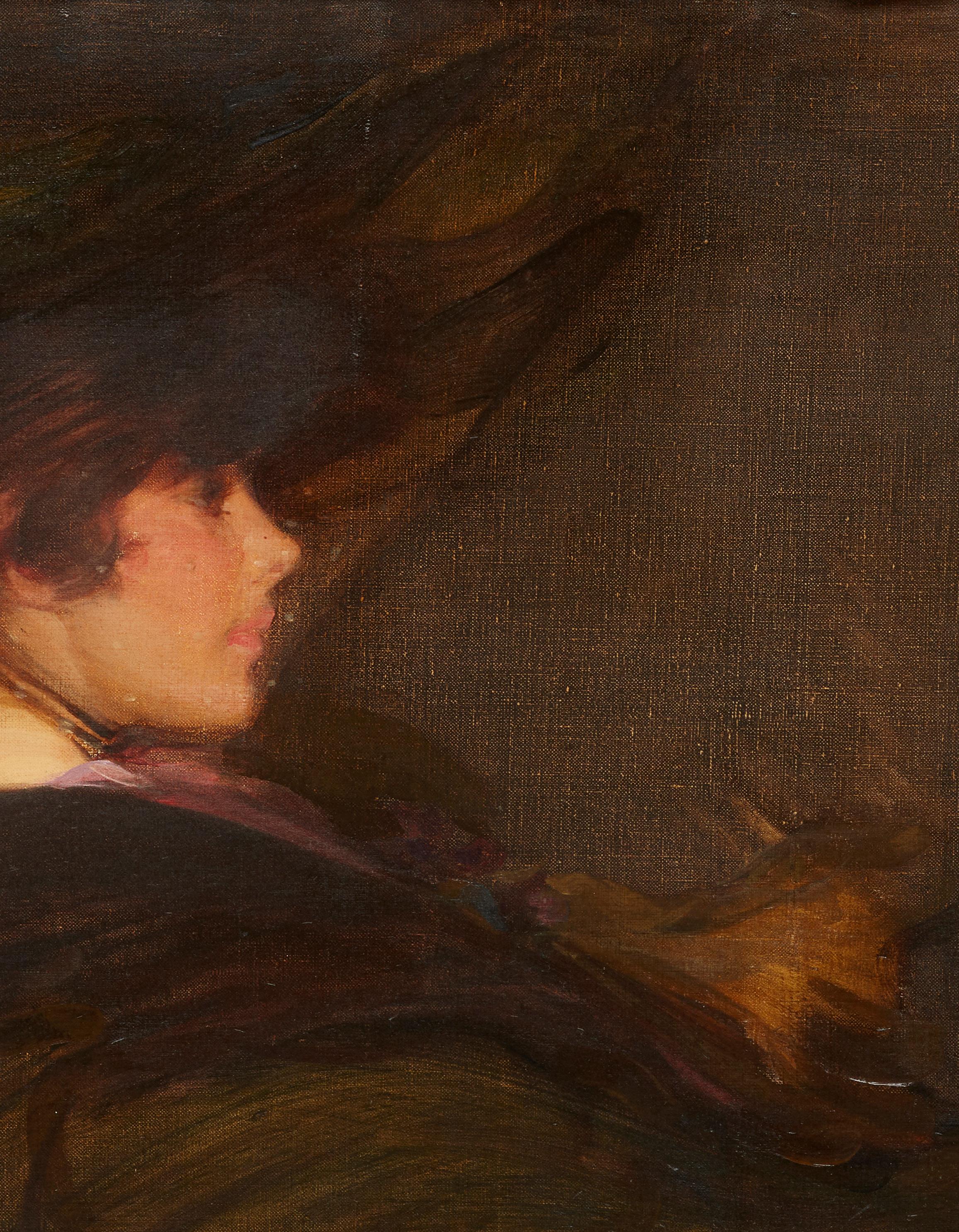
suggests may have been informed by John Singer Sargent’s Madame Gautreau Drinking a Toast (1882-1883). (Thomas Cooper, ‘A Monstrous Imagining of Matter and Spirit: Robert Brough’s Fantaisie en Folie (1897)’, Immediations, Courtauld Institute of Art on-line journal, vol.4, no.3, 2018, accessed 10 May 2023) Brough’s companion portraits were exhibited widely to exceptional acclaim, rendering the young artist something of a critical phenomenon.
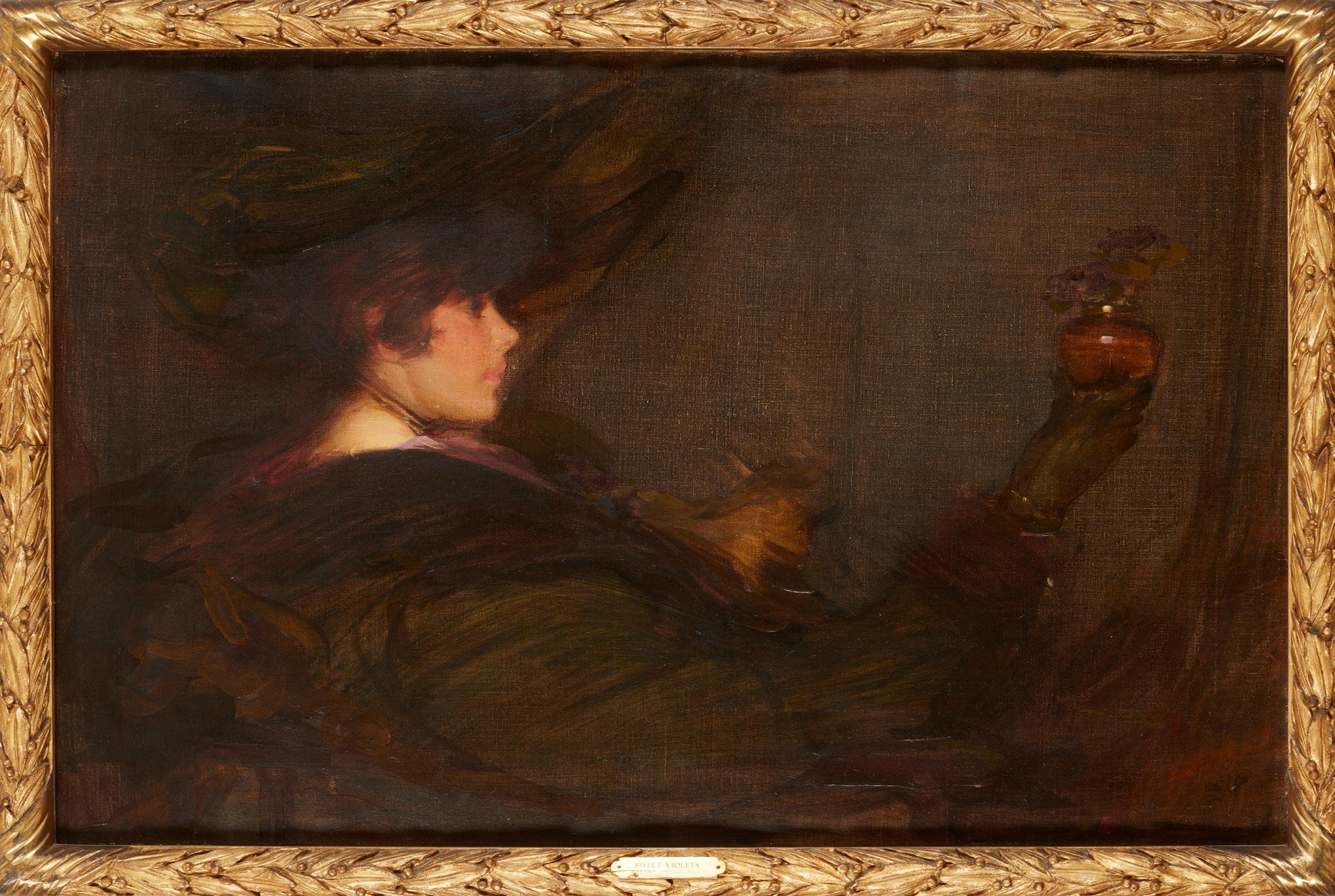
Sweet Violets was acquired by Alexander Ogsten and hung in his home at Ardoe House, Aberdeen, for many years. So enamoured was Ogsten with the painting that he declined the many offers he received for it - including those made by Barbara Staples’ husband. Eventually the portrait was exhibited in a Munich gallery in 1960, where Staples’ family were able to purchase the picture and return it to the family. They, in turn, refused to accept any offer that was made for it, and for a long time it remained a family treasure. In the 1990s an article appeared in Country Life magazine searching for Brough’s lost masterpiece, and the Staples family responded explaining that the portrait was in their collection, and that the sitter was their grandmother. In 1995 Sweet Violets was included in Aberdeen Art Gallery’s Brough exhibition, after which it was loaned to, and ultimately purchased by, the present vendor.
R.A., A.R.S.A. (SCOTTISH 1872-1905)
SWEET VIOLETS
Oil on canvas
68.5cm x 104cm (27in x 41in)
Exhibited: Royal Glasgow Institute, Glasgow, 1897, no.149
Aberdeen Artists Society, Aberdeen, 1906, no.488
Burlington Fine Arts Club, London, 1907, no.43
Royal Scottish Academy, Edinburgh, 1926, no.335
Aberdeen Art Gallery, Aberdeen, Robert Brough ARSA, 18
February-25 March 1995, no.63, pp.50-51
Provenance: Alexander Ogston, Ardoe
Acquired from the above by the sitters’s husband and thence by family descent
Private Collection, Scotland
£100,000-150,000
The success of Sweet Violets and Fantaisie en Folie encouraged Robert Brough to move to London.
He promptly joined the Chelsea Arts Club, where he met Sargent, one of his artistic heroes. The pair became close friends, developing a mentor-protégé relationship and taking nearby Chelsea studios. Thanks in part to Sargent’s support, Brough’s painting career flourished year upon year.
132 ROBERT BROUGH
Young, ambitious, and precociously talented, Brough was on an impressive professional trajectory, yet was unable to reach the soaring heights for which he appeared to be destined on account of a tragic accident. On 20th January 1905 Brough was travelling by train from Perth to London when a major crash occurred. He suffered serious burns and died the following day, with his mother and Singer Sargent at his bedside. His life, and extraordinary potential, was thus curtailed.
Throughout his life Brough was successful and well-known; his obituary recorded that he combined ‘the dash of Sargent and the beautiful refinement of Velazquez.’ (The artist W. G. Robb quoted in an obituary in a Scottish newspaper, 1905) Despite this, his early death appears initially to have prevented him from being fully admitted to the canon of great painters in the history of Scottish art. This is largely due to the brevity of his career: relatively few artworks survive and he had less time than most to crystallise his artistic legacy. Fortunately, recent reviews of Scottish
ROBERT BROUGH R.A., A.R.S.A. (SCOTTISH 1872-1905)
BRETON WOMEN SITTING ON A BEACH
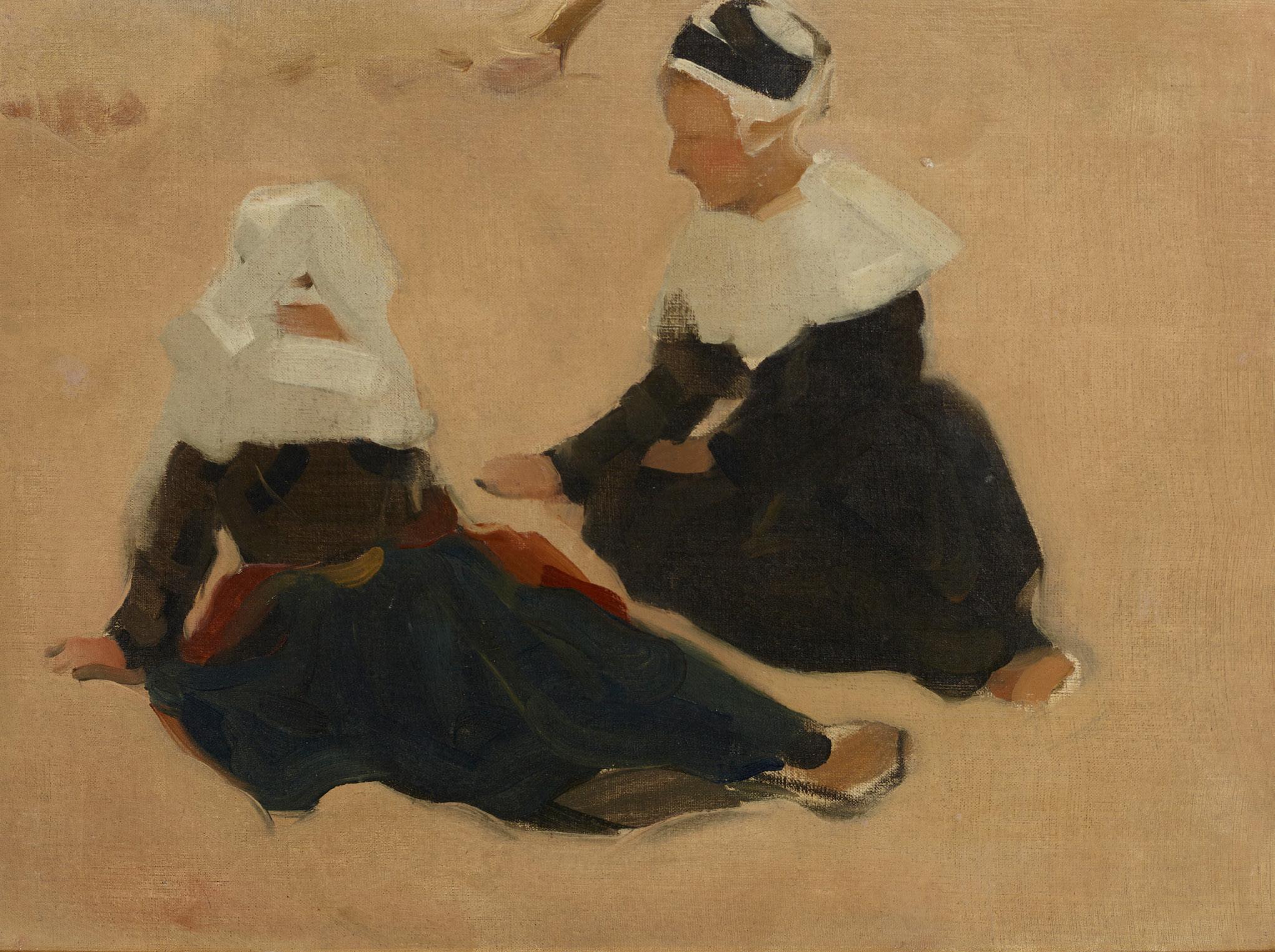
Oil on canvas laid down on board 46cm x 61cm (18in x 24in)
Provenance: Bequeathed by the Artist to John Russell Greig
His Studio sale 1905 (no.76) as ‘Brittany Peasants’, where acquired by Dr. Norah Wattie, Glasgow
Exhibited: Aberdeen Art Gallery, Aberdeen, Robert Brough ARSA, 18 February-25 March 1995, no. 38, illustrated in colour on back cover
Note: In the catalogue for the 1995 Aberdeen Art Gallery exhibition, Jennifer Melville stated: ‘In Breton Women Sitting on a Beach Brough sets the silhouettes created by such local costumes against a glowing pink sand - coming as close to Gauguin’s flat patterns as in any work.’
£25,000-35,000
painting have done much to reinstate Brough’s status as a painter of remarkable quality, who worked at the forefront of innovative artistic movements, both in Britain and in France.
Robert Brough’s artworks appear on the market infrequently, and Lyon & Turnbull is therefore particularly delighted to be offering two tour-de-force oils, both of exceptional importance and each dating to key moments in his career.
133
104
STANLEY CURSITER
C.B.E., R.S.A., R.S.W. (SCOTTISH 1887-1976)
THE BATHERS
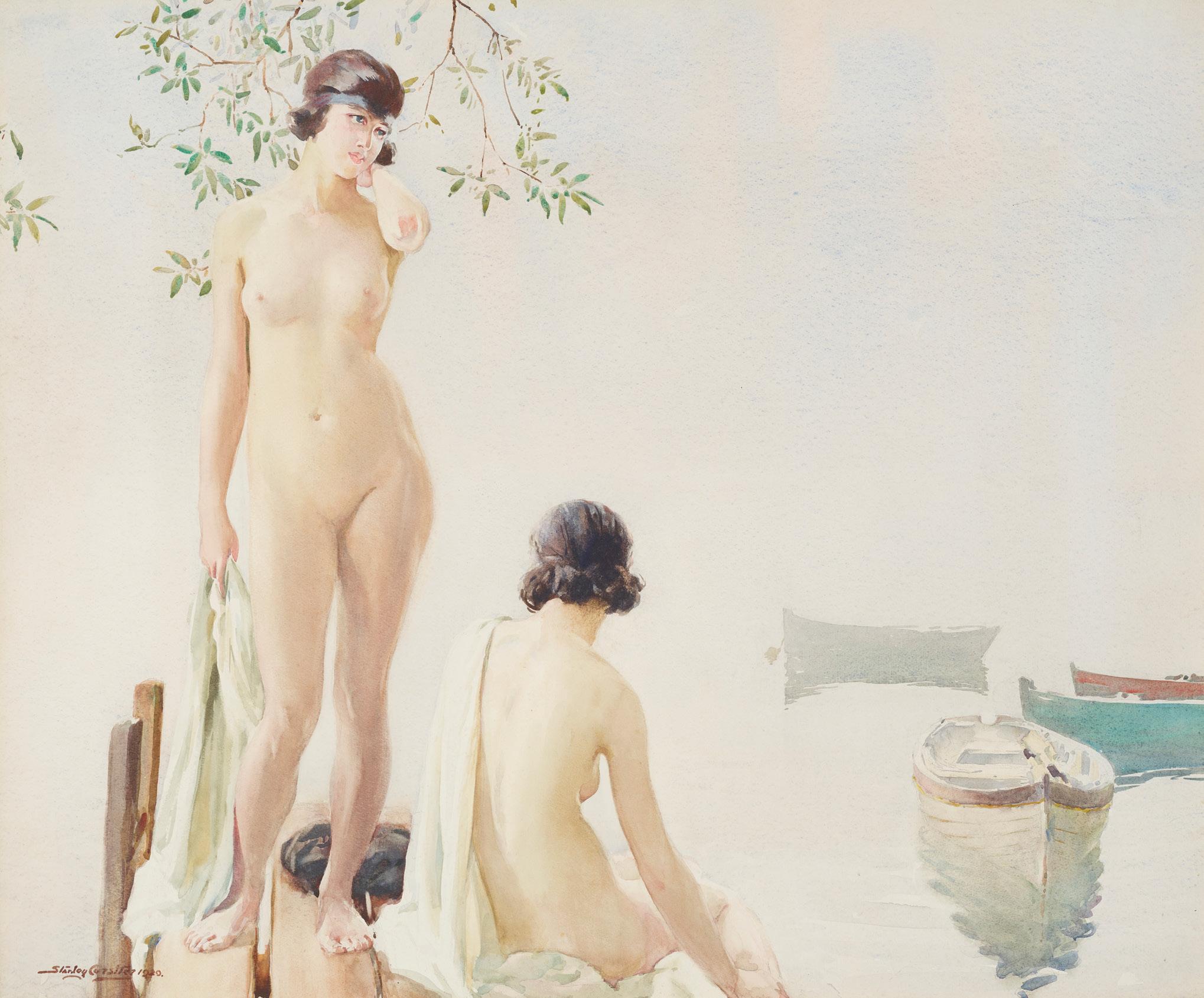
Signed and dated 1920, watercolour
49.5cm x 59.5cm (19.5in x 23.5in)
£5,000-8,000
134 §
105 Other fees apply in addition to the hammer price: see the ‘Buyer’s Guide’ section on page 2
135
ROBERT GEMMELL HUTCHISON R.B.A., R.O.I., R.S.A., R.S.W. (SCOTTISH 1860-1936)
THE GOLDFISH BOWL
Signed, oil on panel
30.5cm x 38cm (12in x 15in)
£8,000-12,000
136
ROBERT GEMMELL HUTCHISON R.B.A., R.O.I., R.S.A., R.S.W. (SCOTTISH 1860-1936)
MY LITTLE MODEL
Signed, oil on board
43cm x 31cm (17in x 12.25in)
Provenance: J. Noel Johnston, Montrose

Exhibited: The Montrose Natural History Antiquarian Society, Montrose, Art Exhibition of Subjects of Montrose and District
Note: J. Noel Johnston (d.1937) was a Montrose-based businessman, philanthropist and collector. He was a Director of the Montrose Laundry Co. Ltd, a President of the local Cricket Club, a benefactor of Montrose’s Soup Kitchen and sat on the Montrose Royal Infirmary Board; he presented two paintings of the town by John Carr (18341912) to what is now known as Angus Alive, one in 1929 and the other in 1930.
£8,000-12,000
106 Other fees apply in addition to the hammer price: see the ‘Buyer’s Guide’ section on page 2

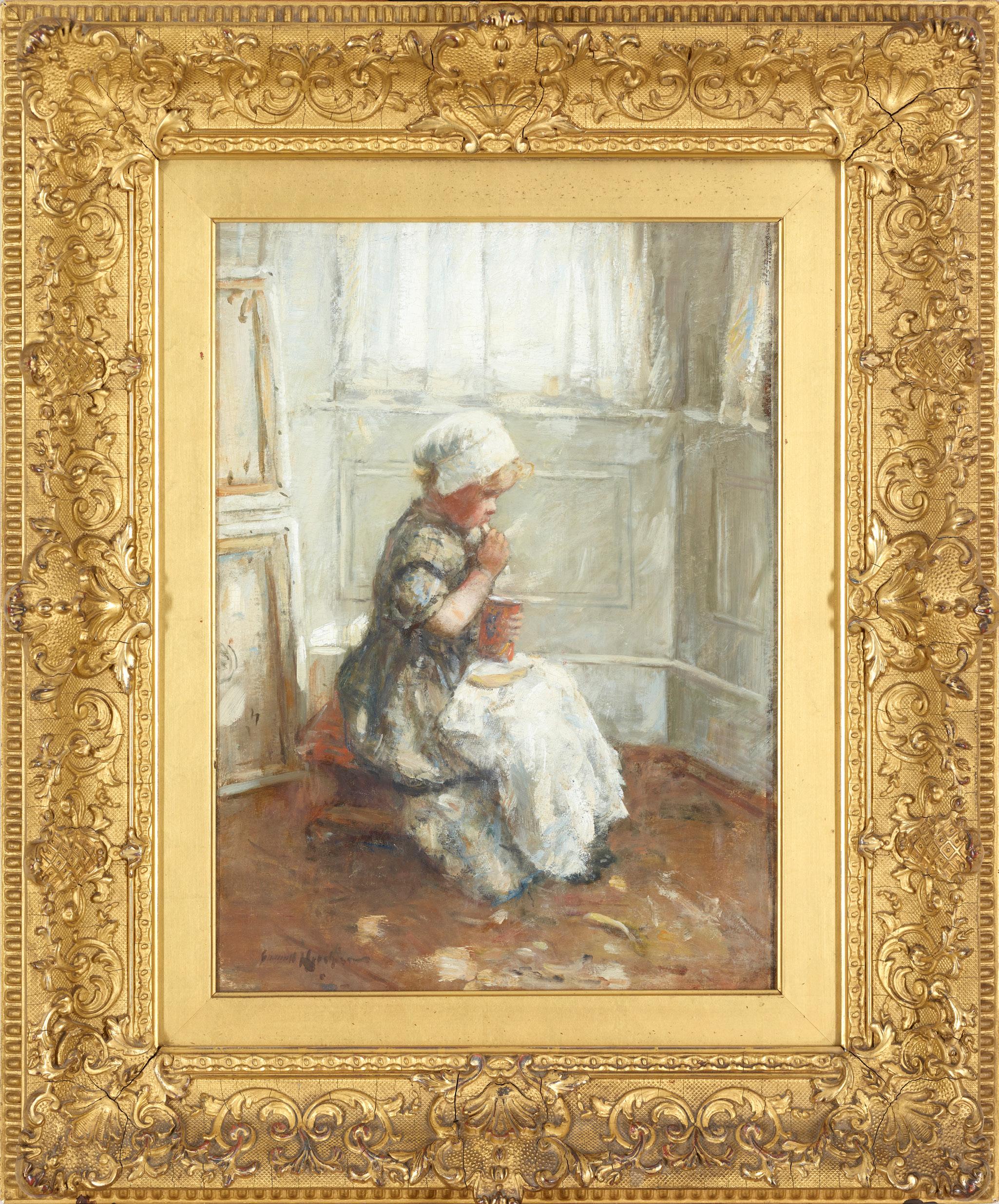
107
James McBey: A Man of Many Talents
James McBey was a remarkable man whose talent, industriousness and commercial sense liberated him from the confines of a difficult early life. He was a devoted traveller and the exotic locations he visited - and the people he encountered there – influenced his work profoundly. This interesting group charts the artist’s journey from self-taught printmaker to established etcher, painter and watercolourist. McBey is now regarded as a leading figure in the revival of British etching in the early twentieth-century, and as one of Scotland’s most celebrated twentieth-century artists.
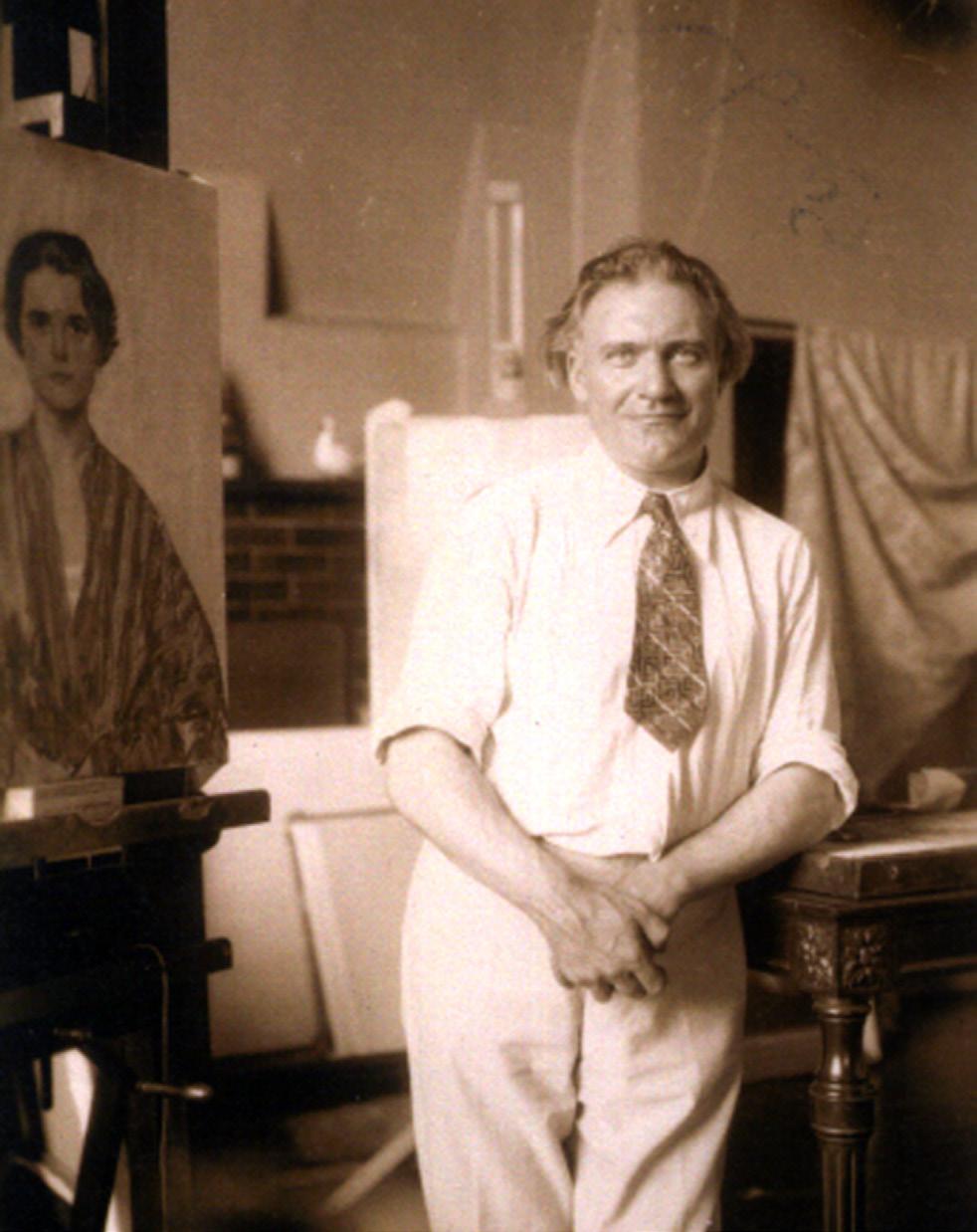
McBey was born and raised a few miles north of Aberdeen in Newburgh, the illegitimate child of an impoverished mother who was blind and severely depressed. His artistic talent won him accolades at school, but by the time he was fifteen the need to support his mother impelled him to take up work as a clerk at a local bank. In his spare time he cultivated his artistic knowledge and skills by working his way through the art books in the local public library, and focussed on teaching himself to etch which, relative to oil painting, required a more modest arsenal of equipment. McBey’s earliest proofs were made at home (and in secret, for it was considered ‘frivolous’ to be an artist) and were etched into plumber’s copper with a darning needle and printed using a domestic mangle. By the time he was 27 he had produced enough work to hold a small exhibition with John Kesson in Aberdeen. Yet as McBey’s creativity flourished, his mother’s condition declined. Following her tragic death by suicide, he departed their tenement flat and moved to London to pursue art full-time.
McBey’s etchings proved incredibly popular with London audiences. His career break came with an exhibition at the Goupil Gallery, where he sold seventy-seven prints, and his most in-demand compositions were those inspired by travels abroad. He had first experienced the benefits of new visual and art-historical stimuli while travelling in the Netherlands in 1910, where he painted, drew, and studied Rembrandt’s etchings in the Rijksmuseum. Visits to Morocco and Spain
followed shortly thereafter, and McBey amassed a significant body of work depicting Spanish bull-fighting rings. The thrilling, theatrical atmosphere of the ring is captured in The Ovation to the Matador (c.1911), an interesting early example of watercolour painting from McBey, wherein a bull-fighter in traditional attire presents himself triumphantly. The crowd he faces is unseen, but their jubilant reception is made evident by the matador’s raised arms and delighted expression. McBey adjusted this composition for a dynamic etching of the same title, which evidences his mastery of intaglio to evoke varied qualities of light and shadow. Spain would prove to be a continuing source of inspiration. A Brave Bull, San Sebastian (1932) post-dates the etching market crash which compelled McBey to predominantly work in watercolour and oil paint.
During World War One McBey initially was sent to Rouen with the Army Printing and Stationery Office, but in 1917 was appointed an official war artist, and was commissioned with an Expeditionary Force to the Middle East. During a reconnaissance in the Sinai Desert he produced a celebrated series of etchings, including Strange Signals, which capture the heat of the climate and the intrepid nature of the explorers.
108
James McBey beside his portrait of Frances Gripper, 1920s. Photograph presented in 1988 by Mrs Marguerite McBey to Aberdeen Art Gallery. © Aberdeen City Council
137 §
JAMES MCBEY (SCOTTISH 1883-1959)
HALF-LENGTH PORTRAIT OF FRANCES GRIPPER
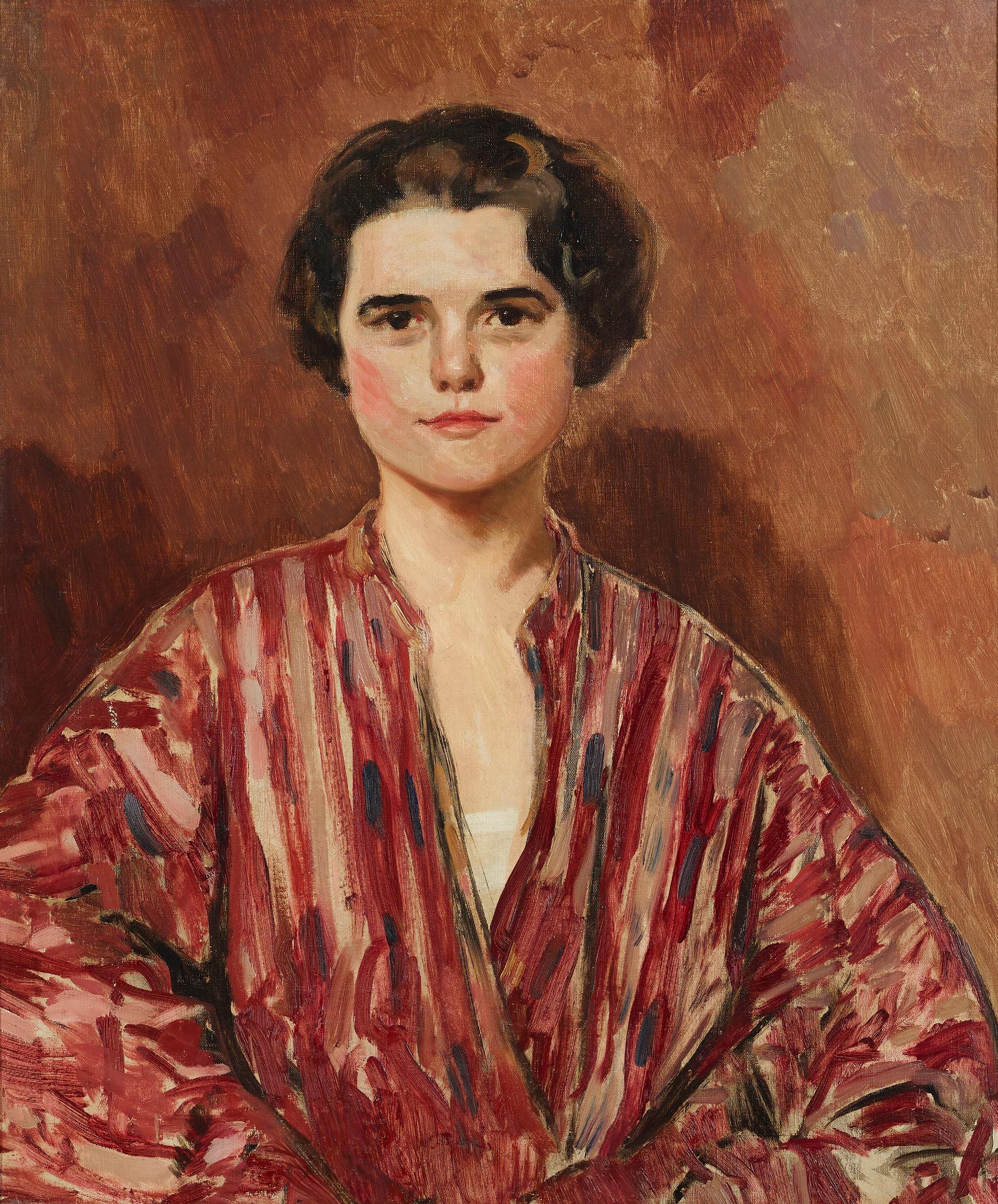
Oil on canvas
71cm x 59cm (28in x 23.25in)
Provenance: Private Collection, USA
£3,000-5,000
109
By the age of 30 McBey had become an established and indemand artist. He was now a member of the leisured class, and enjoyed all the social benefits this entailed - particularly the opportunity to mix with eligible young women. McBey was charismatic, humorous and dashingly handsome, and maintained numerous affairs throughout his life, with the objects of his affection also often serving as artistic muses. One of his most intoxicating affairs was initiated in 1928, when he encountered an American named Frances Gripper. The pair travelled around Scotland and Paris together, and McBey produced several paintings of Gripper. In this exquisite portrait (c.1929) McBey expresses the intensity of his passion in the frenzied brushwork and rich raspberry palette, which is reflected across Gripper’s robe and to her flushed cheeks and lips. McBey conveys her beauty and impish personality, as well as the intimacy shared by the couple in her easy bearing, steady eye contact and selfassured smile. McBey proposed to Gripper in 1929, but she returned to her fiancé in the States. She would continue to preoccupy McBey’s thoughts for years to come.
Perhaps it was this incident that compelled McBey to leave Britain for America. With the assistance of art critic and friend Duncan Macdonald, McBey arrived in Chicago in late 1929 to hold an exhibition. Co-inciding with the Wall Street Crash, the show was not a commercial success, but McBey did make connections with several important American collectors whose support would later prove invaluable. In 1930 he established a studio in Philadelphia, and a diary entry from the 3rd December of that year records that at a dinner he first met Marguerite Loeb, a Sorbonne-educated tobacco heiress with exceptional connections in the art world; she had studied book-binding in 1920s Paris, where
JAMES MCBEY (SCOTTISH 1883-1959)
HALF-LENGTH PORTRAIT OF HORTENSE LOEB
Signed and dated 6 July 1931, oil on canvas
71cm x 61cm (28in x 24in)
£2,000-3,000
she and artist Oskar Kokoschka had been lovers, and afterwards moved to New York where she established a photography studio on West 57th Street. Early in 1931, they travelled to Bermuda with Marguerite’s mother Hortense, and on the boat back to New York, James proposed to Marguerite. On Friday 13th March 1931, three months after the couple had first met, they were wed.
This portrait of Hortense Loeb, Marguerite’s mother, was made shortly after the marriage. The McBeys sailed for England immediately after their wedding, and this portrait may therefore either have been based on studies McBey made while still within the States, or perhaps was made from life during a visit from Hortense. The portrait is rendered with affection, and the subject appears entirely at ease. The ‘July 1931’ accords with her summer-y attire, and she wears a fashionable halter top, which, owing to the 1930s trend for sun tans, were all the rage. McBey’s linear brushwork eloquently describes the interaction of light with his subject, recalling his technical experience as a printmaker: many of his etchings use striation lines to indicate light sources. The deft, pared-back handling of shadow to the background and across Hortense’s dress is also characteristic of an artist used to working with intaglio.
McBey was remarkably industrious. Martin Hardie, who would compile McBey’s catalogue raisonné, recalled following a stay in Venice ‘...never have I known anyone with such untiring energy and passion for work. It began at dawn… at night he would be out again in a gondola working on a copper plate by the light of three tallow candles in an old tin… I have known a day’s bag of an oil sketch, a brace of watercolours, several pen studies and an etching.’
138 §
110 Other fees apply in addition to the hammer price: see the ‘Buyer’s Guide’ section on page 2

JAMES
MCBEY (SCOTTISH 1883-1959)
OVATION TO THE MATADOR
Signed and numbered XIII in pen to margin, etching from an edition of 30
26.5cm x 17cm (10.5in x 6.75in)
£1,000-2,000
JAMES MCBEY (SCOTTISH 1883-1959) A BRAVE BULL, SAN SEBASTIAN
Signed, inscribed and dated ‘San Sebastian 4 September 1932’, pen and ink and watercolour

27cm x 38cm (10.5in x 15in)
Provenance: P & D Colnaghi & Co. Ltd, London
Exhibited: Walker Art Gallery, Liverpool, 1936
£1,500-2,000
139 §
JAMES MCBEY (SCOTTISH 1883-1959) STRANGE SIGNALS
Signed and numbered XVIII in pen to margin, etching, from a numbered edition of 76 plus three adittional proofs 23cm x 39.5cm (9in x 15.5in)
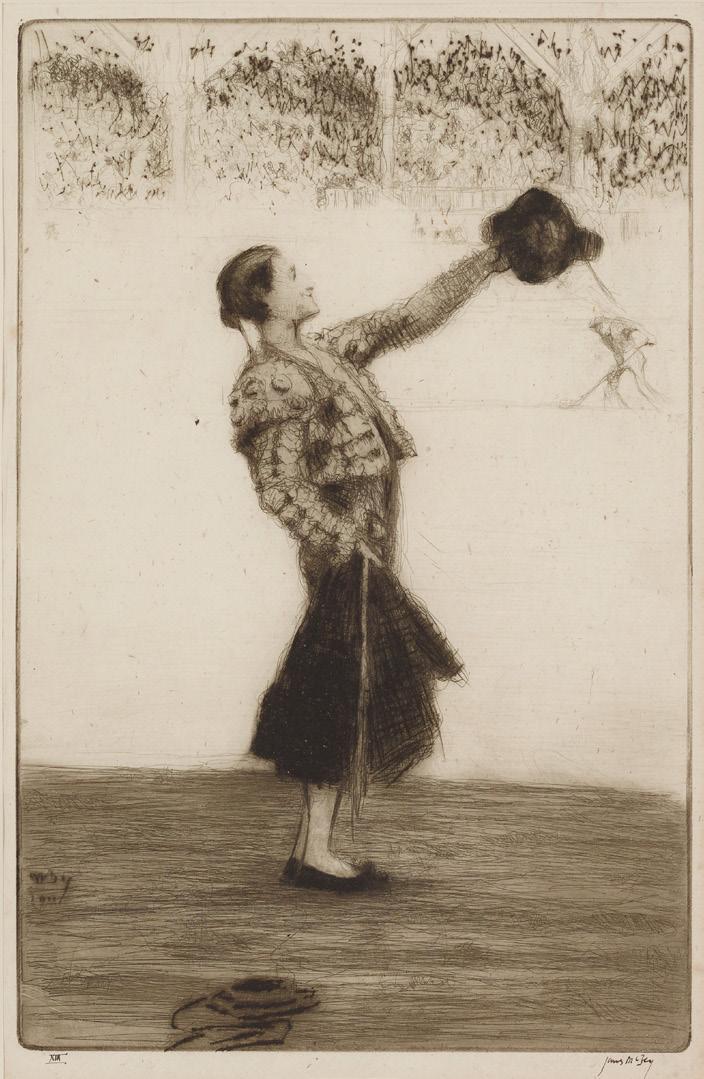

Literature: Martin Hardie, Etchings and Dry Points from 1902-1924 by James McBey, P.& D. Colnalghi & Co. Ltd, London, 1925, no.186
£1,000-2,000
142 §
JAMES
MCBEY (SCOTTISH 1883-1959)
OVATION TO THE MATADOR
Signed, pen and ink and watercolour
46.5cm x 30.5cm (18.25in x 12in)
Provenance: Allinson Gallery, USA
Note: This work dates from c.1911
£2,000-3,000
141 §
140 §
112 Other fees apply in addition to the hammer price: see the ‘Buyer’s Guide’ section on page 2
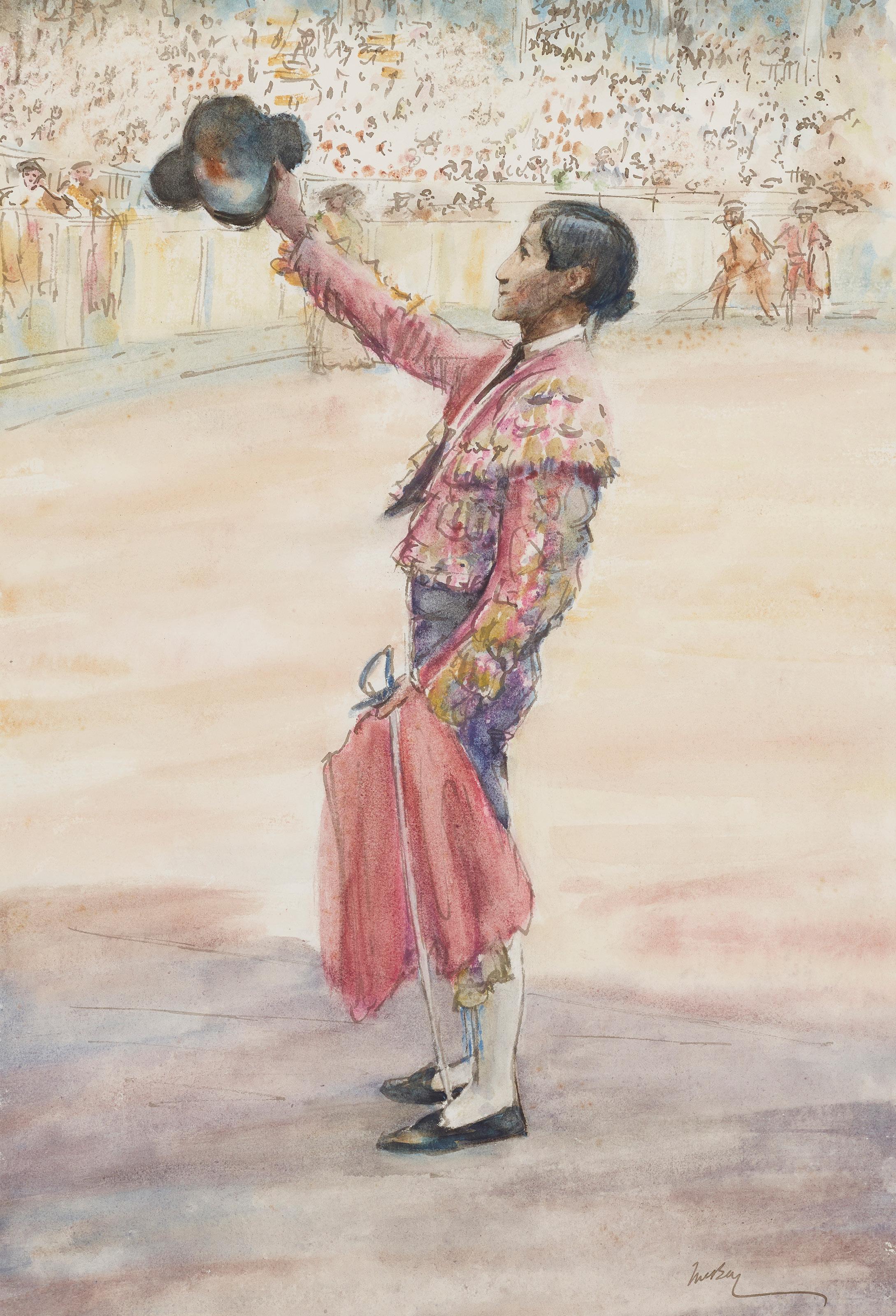
143 §
JAMES MCBEY (SCOTTISH 1883-1959)
ON THE GARELOCH HELENSBURGH
Signed, inscribed and dated ‘To Stuart Black 12 August 1924’, oil on canvas
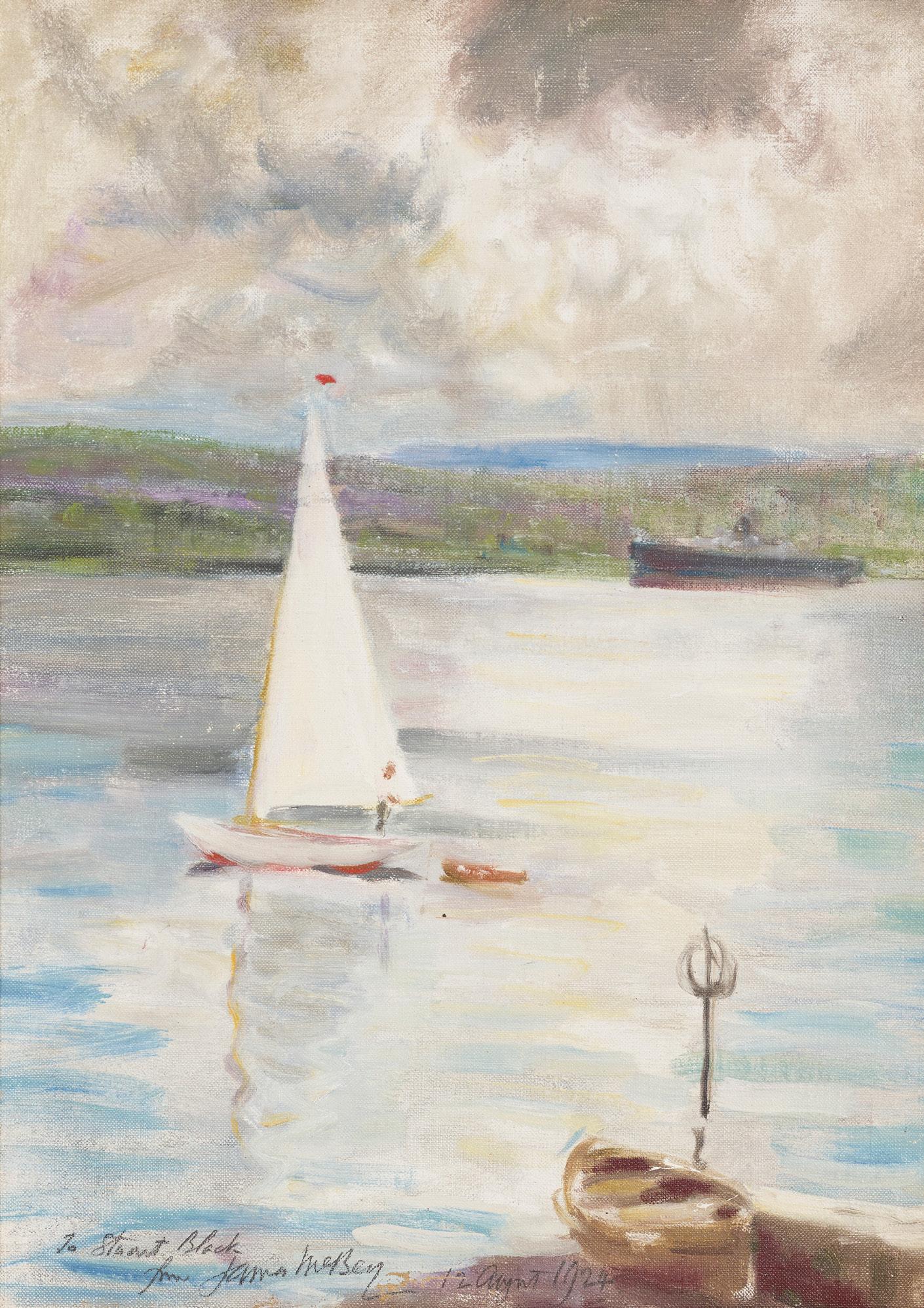
38cm x 28cm (125in x 11in)
£2,000-3,000
Stuart Black was born in Glasgow in 1877 and had a passion for sailing yachts. He was the first owner of ‘Ceres’, a Gareloch One Design Class and presented a trophy in his name which was competed for annually in Gareloch racing from 1924 until 1936. In September 1930 his Fife-designed yacht ‘Coral’ was in the the British team for the America’s Cup, held at the Seawanhaka Yacht Club, but the hosts had a clean sweep in the races.
114 Other fees apply in addition to the hammer price: see the ‘Buyer’s Guide’ section on page 2
144 §
IAN FLEMING
R.S.A., R.S.W., R.G.I., L.L.D. (SCOTTISH 1906-1990)
FINDOCHTY
Signed, signed, inscribed with title and dated 1962/85 verso, oil on board
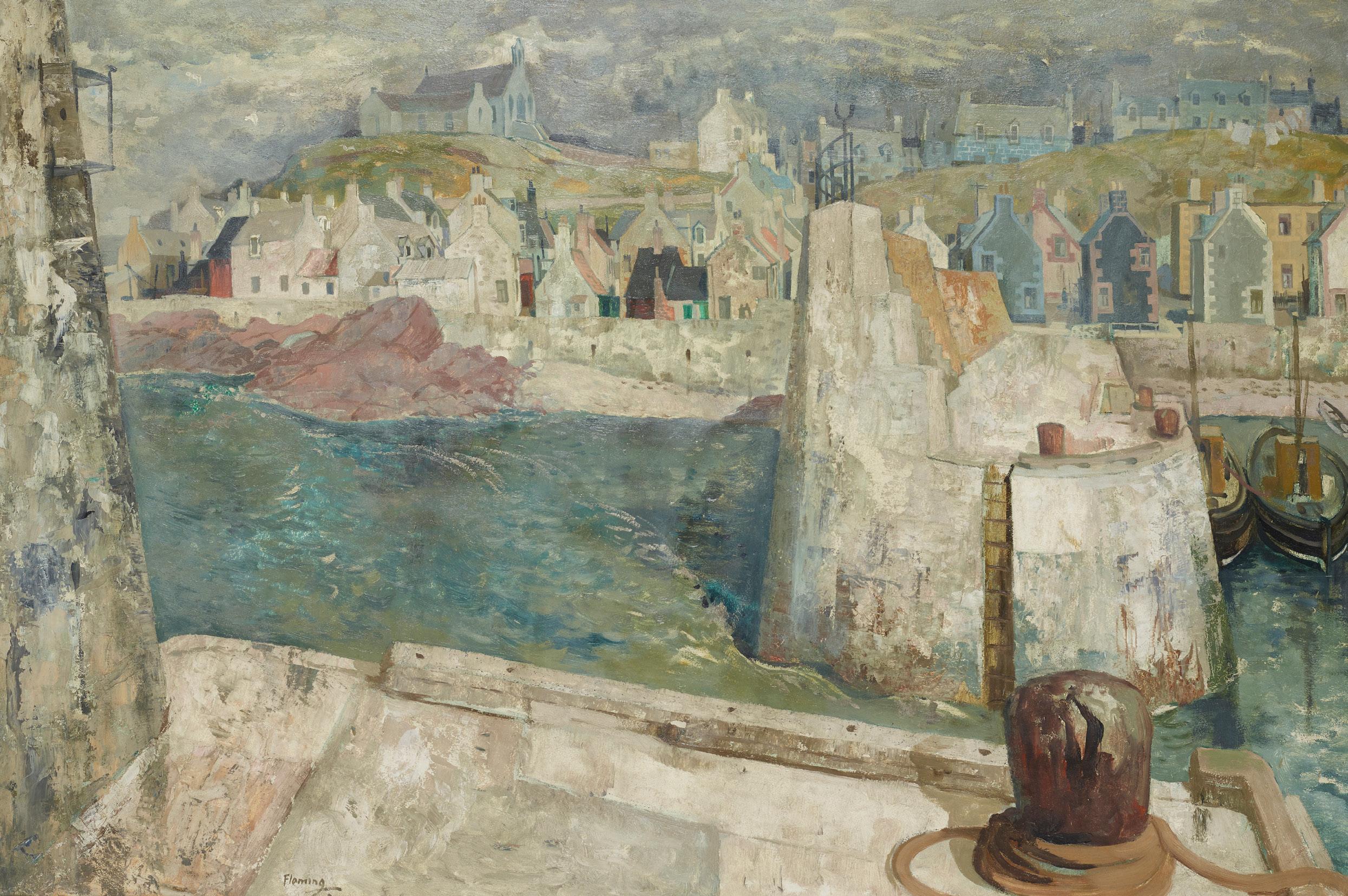
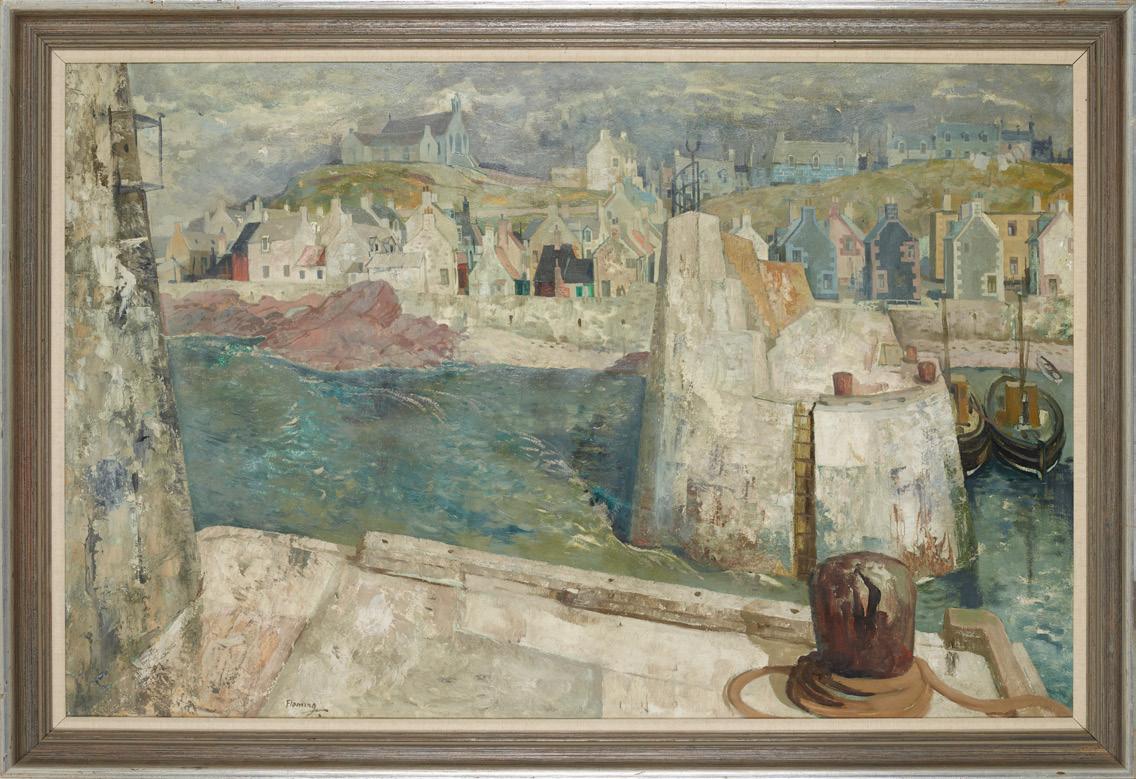
76cm x 117cm (30in x 46in)
Provenance: The Fine Art Society Ltd, March 1989 (EF1/3)
£4,000-6,000
115
145
EDWARD ARTHUR WALTON
R.S.A., R.S.W., R.W.S. (SCOTTISH 1860-1922)
CERES VILLAGE GREEN
Signed, inscribed on contemporary label verso, oil on canvas
63.5cm x 81cm (25in x 32in)

£7,000-10,000
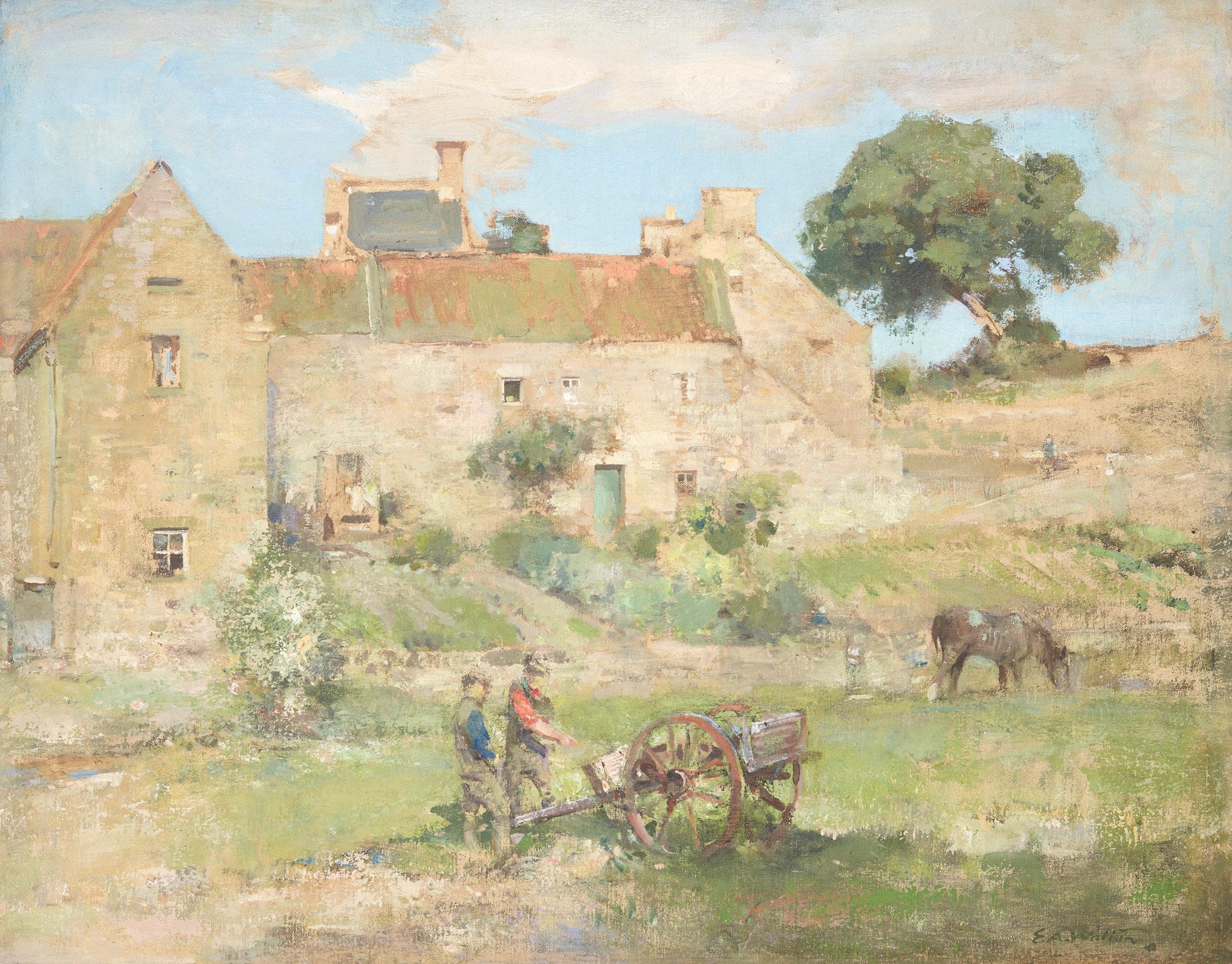
116 Other fees apply in addition to the hammer price: see the ‘Buyer’s Guide’ section on page 2
146 §
ALBERTO MORROCCO R.S.A., R.S.W., R.P., R.G.I., L.L.D. (SCOTTISH 1917-1998)
SELF-PORTRAIT
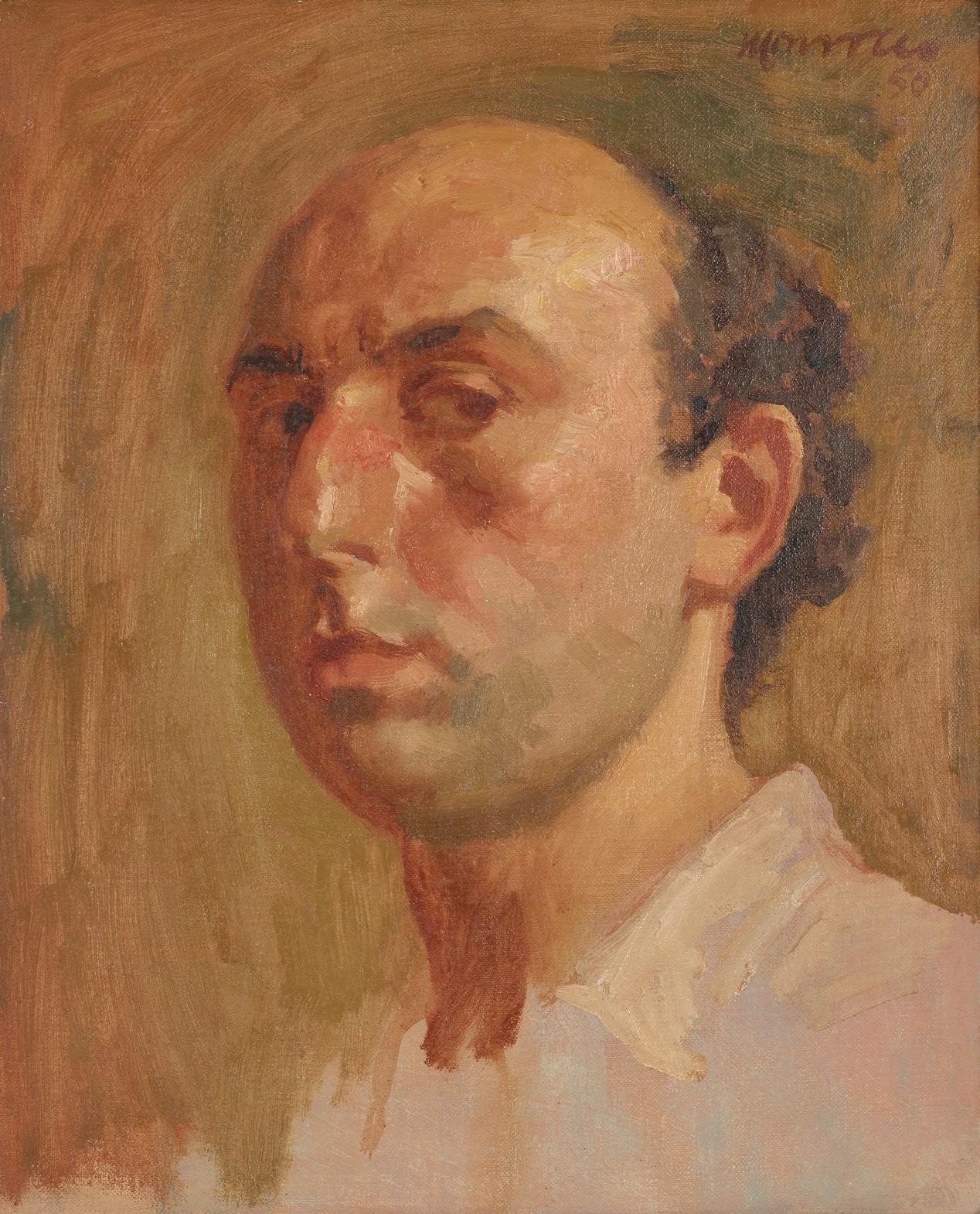
Signed and dated ‘50, oil on canvasboard
41cm x 33cm (16in x 13in)
Provenance: Christie’s South Kensington, British, Victorian and Scottish Paintings, 7 March 2002, lot 177
£3,000-5,000
147 §
JAMES COWIE R.S.A., L.L.D. (SCOTTISH 1886-1956)
STUDY OF A SCHOOLGIRL

Signed, pencil on buff paper
48cm x 20cm (19in x 8in)
Provenance: Forrest McKay, Edinburgh, 1990 Bourne Fine Art, Edinburgh
£2,000-3,000
117 Other fees apply in addition to the hammer price: see the ‘Buyer’s Guide’ section on page 2
From Paris to Glasgow: A Creative Friendship
John Duncan Fergusson and Margaret Morris first met Martha Lawrence Grant (1916-96) when the latter attended Morris’s dance classes in Glasgow in the 1930s. She became a vital figure in Margaret Morris Movement (MMM) and was in the process of establishing an MMM school in Aberdeen when World War Two began. At that point, Fergusson was primarily based in Paris, whilst Morris spent most of her time in London; the conflict resulted in their move to 4 Clouston Street, Glasgow.
Fergus and Meg, as they were affectionately known, galvanised the city’s art scene. They were founder members of the New Art Club in 1940, which aimed to stimulate debate and to create affordable exhibiting opportunities. Two years later, Fergusson became founding President of the Club’s successor, the New Scottish Group, which staged eight exhibitions of its members’ work between 1943 and 1956.
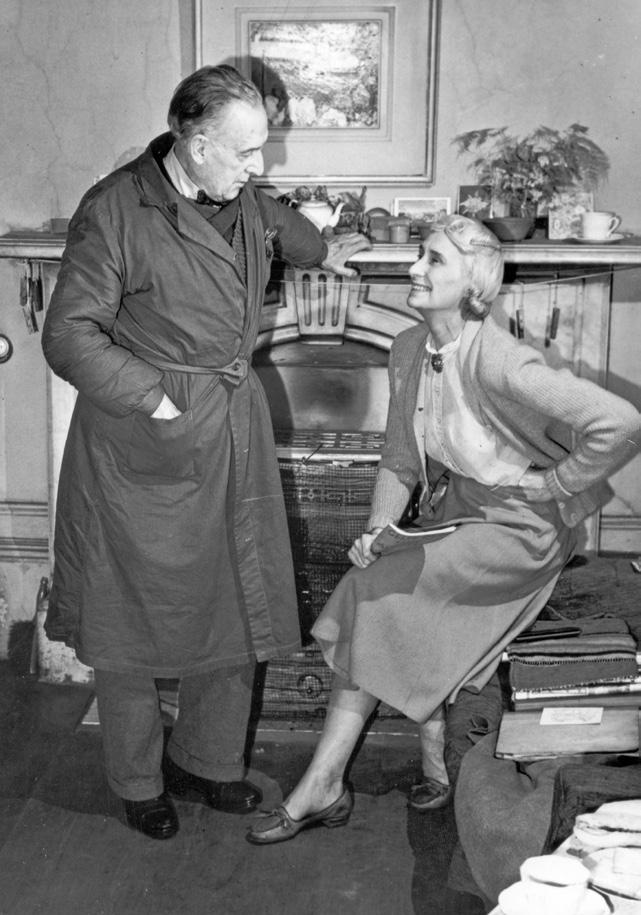
It is believed that Martha met James Fullarton Arnott (1914-82) through the New Art Club. James was an Assistant Lecturer in the English Department at the University of Glasgow, where he was to become Emeritus Professor of Drama. The couple formed a lifelong creative friendship with Fergus and Meg and were married in 1945. Their son Alan was born in 1948 and he has recalled:
The impact of Fergus and Meg on the artistic life of postwar Glasgow, and indeed Scotland, was immense. Painters, sculptors, potters, designers, dancers, actors and musicians all thrived in the atmosphere of post-war Glasgow. While Meg and Fergus provided the artistic inspiration, Mum and Dad provided backing, encouragement and support.
During James’s illustrious career, he devised the Drama course at the re-opened Royal Scottish Academy of Music and Drama (RSAMD) and in 1966 was appointed the first Head of the Drama Department at the University of Glasgow.
Martha helped to establish and run the RSAMD Library, as well as designing and creating costumes for Academy and University productions.
With his knowledge of arts funding and art world contacts, James provided vital support in Meg’s launching of the Celtic Ballet, Scottish National Ballet and Scottish Ballet companies. In her turn, Martha taught and danced at MMM Summer Schools and sat for Fergus, not least sharing modelling duties with Meg for his Glasgow-era masterpiece Danu, Mother of the Gods of 1952, now in The Fergusson Gallery, Perth.
John Duncan Fergusson and Margaret Morris in their flat at 4 Clouston Street, Glasgow - Courtesy of Perth Art Gallery, Culture Perth & Kinross
118
148 §
JOHN DUNCAN FERGUSSON R.B.A. (SCOTTISH 1874-1961)
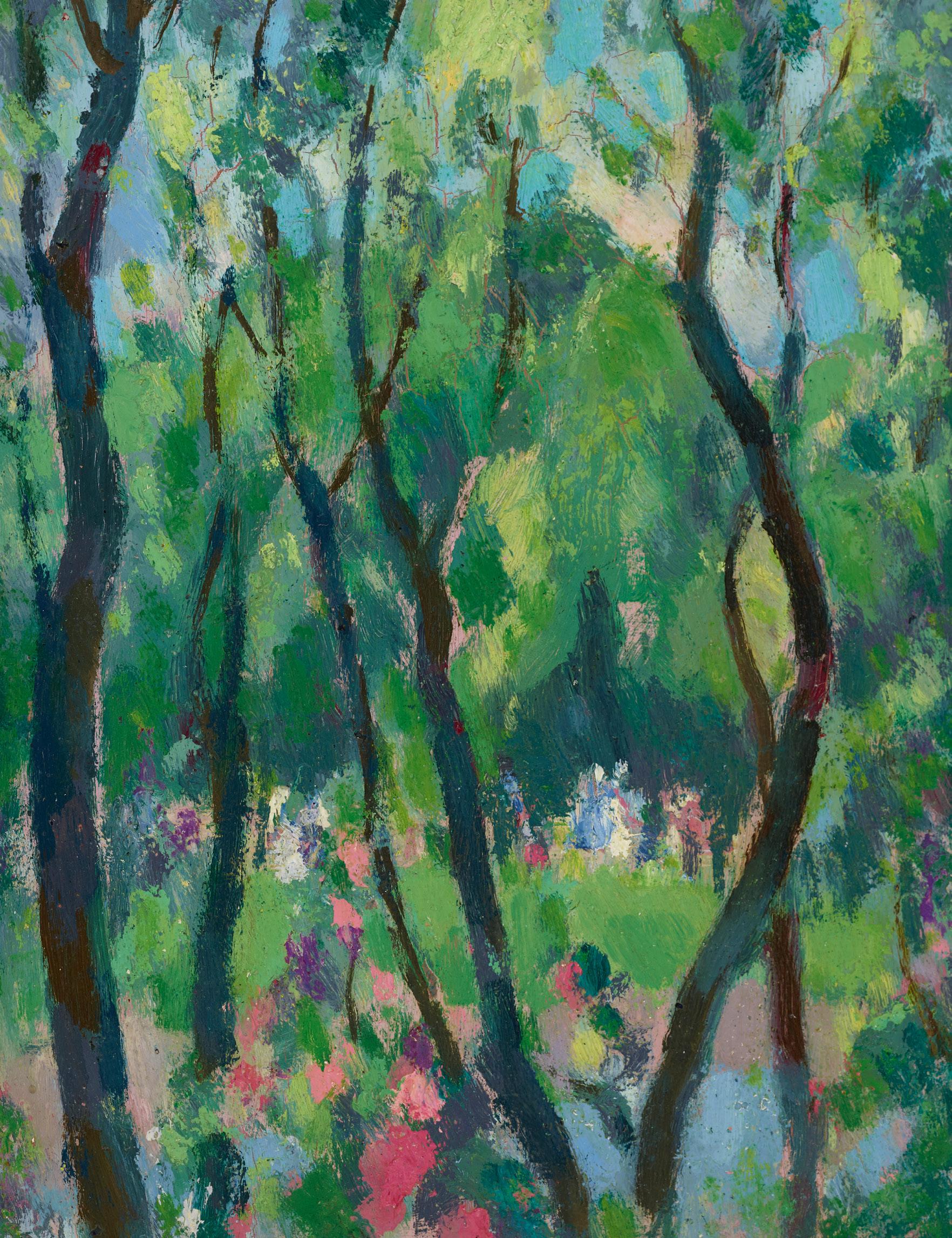
KELVIN VALLEY

Signed, titled and dated 1942 verso, oil on board 25cm x 19cm (9.75 x 7.5in)
Provenance: Given by Margaret Morris to Martha Arnott in 1967 and thence by descent to the present owner £15,000-20,000
119 Other fees apply in addition to the hammer price: see the ‘Buyer’s Guide’ section on page 2
Alan has further explained:
We holidayed in the South of France with them both in the 50s and with Meg in the 60s. They lived in Glasgow (in the West End) and were regular visitors to our houses in Saltcoats and then Glasgow – and we frequently visited them.
Following Fergus’s death in 1961, Meg established the J. D. Fergusson Art Foundation to secure his legacy and to support living artists. Martha and James were founding committee members and Alan succeeded James on the committee in 1983. The Foundation’s aims were achieved with the opening of The Fergusson Gallery in Perth in 1992 and the launch of the J. D. Fergusson Arts Award Trust in 1995.

Supper Dance and Kelvin Valley pay testament to this creative friendship. Both were given to the Arnotts by Meg in the 1960s and are beautiful examples from key periods in Fergus’s career. In 1907, he took the momentous decision to move from Edinburgh to Paris, which he described as ‘simply a place of freedom’. He immersed himself in the artistic, intellectual and social life of the French capital and made his reputation as a leading artist of the twentieth century during the six years he lived there before World War One. He particularly revelled in its bustling café and restaurant scene and Supper Dance is a beautifully accomplished image of the fashionable clientele whom Fergus enjoyed capturing in images of elegance and movement. His fluid draughtsmanship is clear in passages such as the realisation of the female dancer’s gown, whilst a lively composition leads the eye from the champagne in the foreground, to the dancing couple, to another observed in intimate conversation in the background.
Kelvin Valley is a jewel of a painting, in which Fergus pays homage to the city which was the location for the final chapter of his international career. The Clouston Street flat overlooked Glasgow’s Botanic Gardens and was joined, via the River Kelvin, to Kelvingrove Park; these green spaces provided inspiration for the artist’s late, lyrical landscapes. He developed a distinct ‘Glasgow palette’ characterised by high-toned shades of green and pink, which were delicately and deftly applied to their supports in a gentle yet confident finale to the images of Princes Street Gardens, the Scottish Highlands and the South of France which preceded them.
JOHN DUNCAN FERGUSSON
R.B.A. (SCOTTISH 1874-1961)
SUPPER DANCE
Inscribed by Margaret Morris ‘J. D. Fergusson / Early Café drawing 1902 / with love & blessings / from Meg & Fergus / Glasgow May 1965’ on the backboard, watercolour, brush and ink on paper 45cm x 31cm (17.75in x 12.25in)
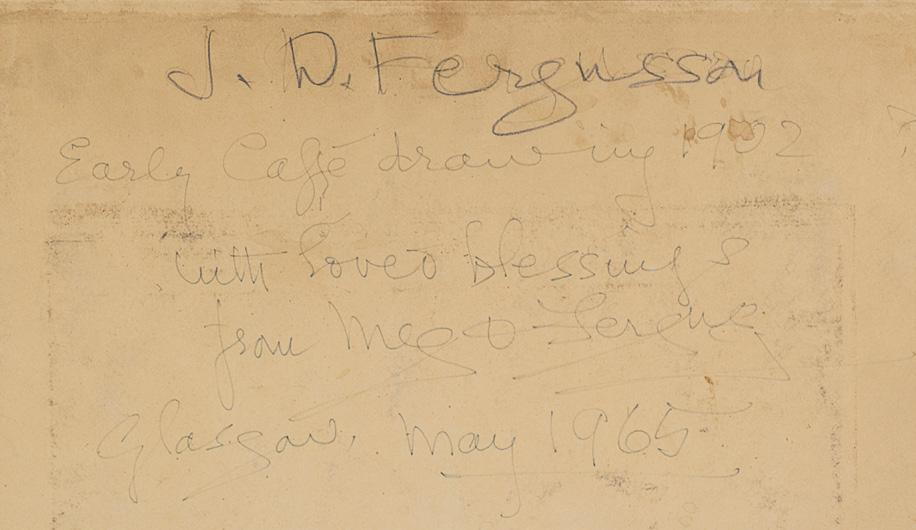
Provenance: Given by Margaret Morris to James and Martha Arnott in 1965 and thence by descent to the present owner
Exhibited: The Fine Art Society Ltd, London, John Duncan Fergusson (1874-1961): A Centenary Exhibition, 10 September-4 October 1974 and tour to Kelvingrove Art Gallery and Museum, Glasgow and The Fine Art Society Ltd, Edinburgh , no.114
The Scottish Arts Council Gallery, Edinburgh, The Need to Draw: 20thCentury Scottish Artists at Work, 22 November-14 December 1975, no.22 Scottish National Gallery of Modern Art, Edinburgh, The Scottish Colourist Series: J. D. Fergusson, 7 December 2013-15 June 2014
Literature: Jean Geddes and Margaret Morris, Café Drawings in Edwardian Paris from the Sketch-books of J. D. Fergusson, Blackie, Glasgow, 1974, repr. b/w p. 25
£10,000-15,000
As Alan has concluded:
Fergus was a lovely man. He treated children the same as everyone else and encouraged me to draw. Meg was full of life and energy and retained the strength and grace of a 20-year-old. There was great love and generosity of spirit amongst us all.
149 §
120 Other fees apply in addition to the hammer price: see the ‘Buyer’s Guide’ section on page 2

150 §
JOHN DUNCAN FERGUSSON
R.B.A. (SCOTTISH 1874-1961)
NUDE AMONG CUSHIONS
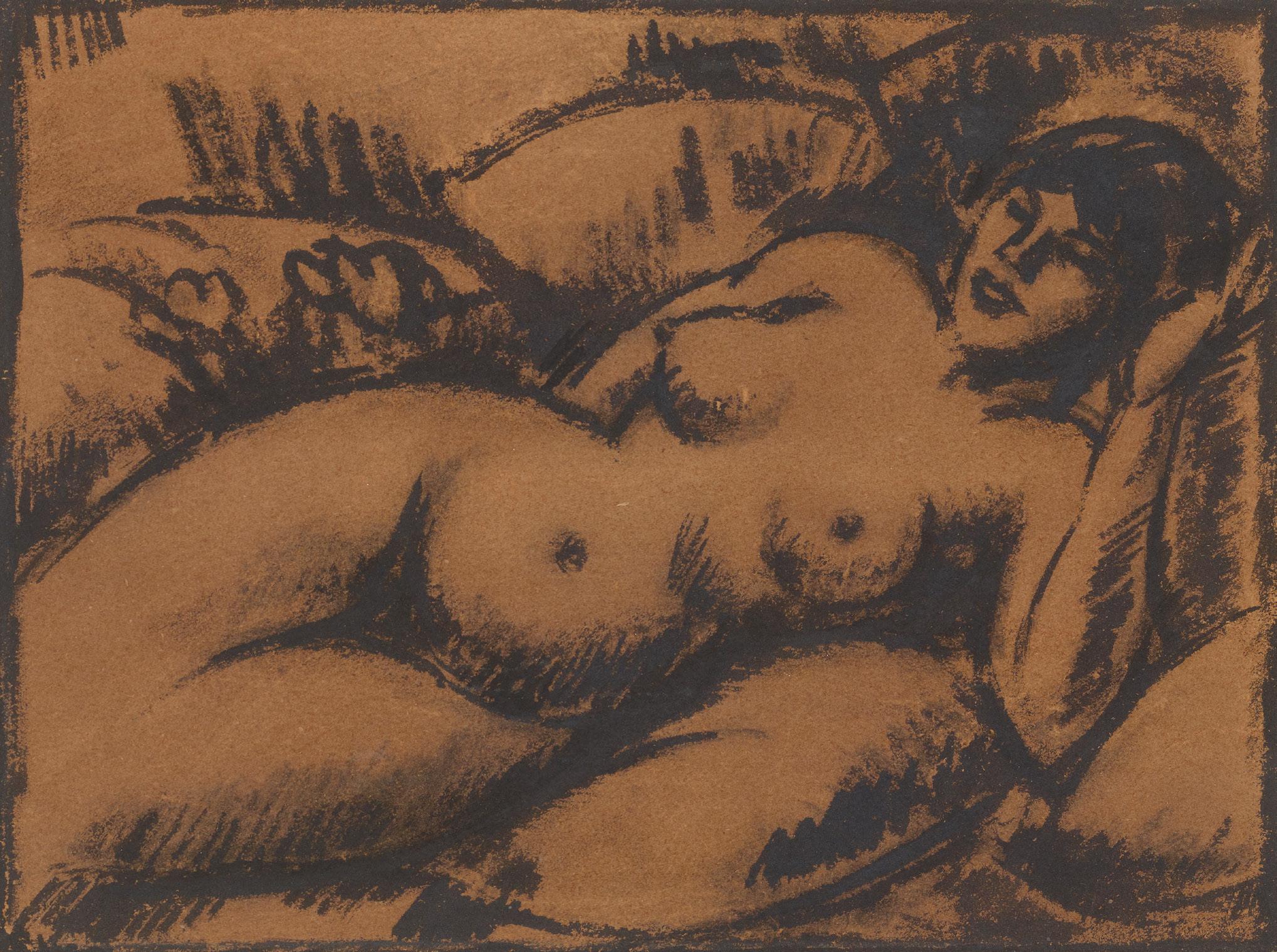
Mixed media on brown paper
24.5cm x 33cm (9.5in x 13in)
Provenance: The Leicester Galleries, London from where acquired by Rod Steiger in 1965
His sale, Sotheby’s Gleneagles, Scottish & Sporting Pictures & Sculpture, 27 August 2003, lot 1214
Exhibited: The Leicester Galleries, London, J.D. Fergusson, December 1965, no.22
£6,000-8,000
122 Other fees apply in addition to the hammer price: see the ‘Buyer’s Guide’ section on page 2
JOHN DUNCAN FERGUSSON R.B.A. (SCOTTISH 1874-1961)
CAFE SCENE, PARIS
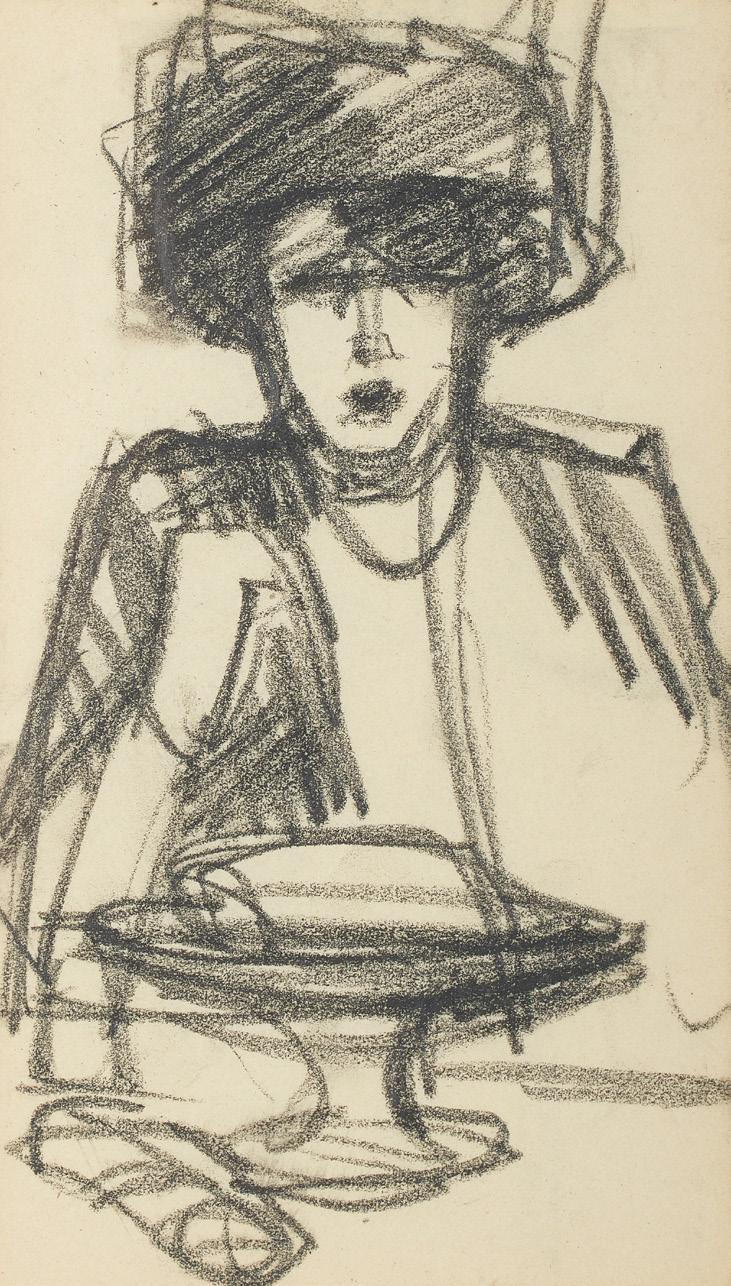
Signed and dated 1972 by Margaret Morris Fergusson on the exhibition label verso, conté
20cm x 12cm (8in x 4.75in)
Provenance: Purchased from Compass Gallery, Glasgow by David Walker in 1972 and thence by descent to the Executors of the Late Mrs Anne Walker
Exhibited: Compass Gallery, Glasgow, J. D. Fergusson: One Man Exhibition, 17 June-13 July 1972, no. 45
£1,000-1,500
JAMES WATTERSTON HERALD (SCOTTISH 1859-1914) TRAFALGAR SQUARE
Signed with initials, pastel
31cm x 38cm (12.25in x 15in)
Provenance: Purchased from the Artist by Edward Arthur Walton
Note: According to Camilla Uytman, E. A. Walton’s grand-daughter, he acquired this work for £5 on learning of Herald’s poverty and depressed state.
£2,000-3,000
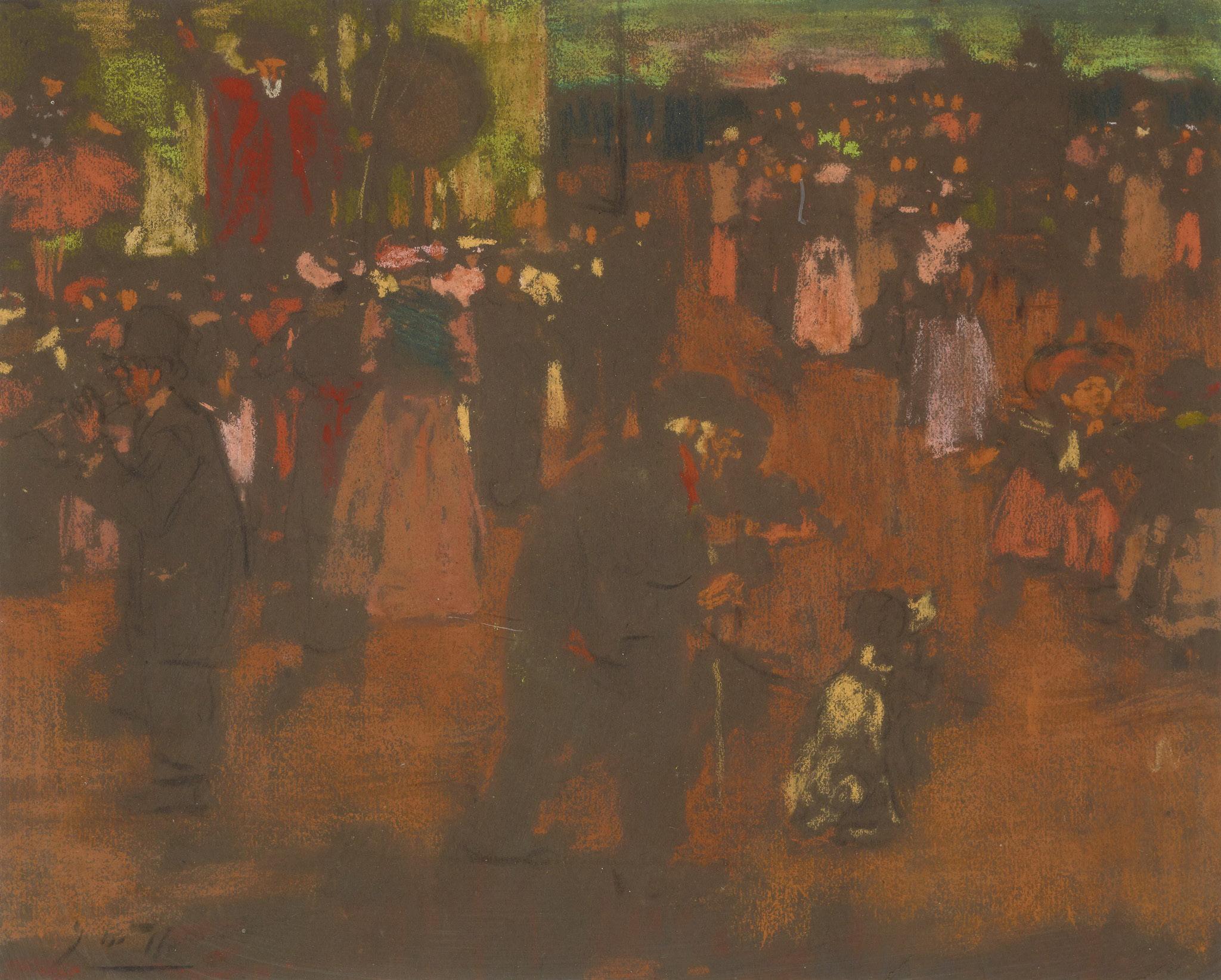
152
§
151
123
Whilst serving in World War One, Cadell wrote to his fellow Scottish Colourist S. J. Peploe:
When the War is over I shall go to the Hebrides, recover some virtues I have lost. There is something marvellous about those western seas. Oh, Iona. We must all go together. (quoted in Alice Strang et al, S. J. Peploe, National Galleries of Scotland, Edinburgh, 2012, p.24)
True to his word, Cadell introduced Peploe to the Hebridean island, off Scotland’s west coast, in 1920 and they returned there most summers for the rest of their lives. Cadell first visited Iona in 1912, possibly because it was owned by his friend Ivar Campbell’s uncle, the 9th Duke of Argyll. He may also have been encouraged to do so by the fact that his friend John Duncan began painting there in 1903, followed by James Paterson and William Caldwell Crawford.

As Alice Strang has explained:
Iona has many attractions for the artist…It is low-lying, so the light reflected from the surrounding sea intensifies the colours of the white sand beaches and the green of its pastures. The light shining through the shallow waters at the edge of the shore creates brilliant colours of emerald green, blue and violet. In addition, the light and weather change frequently, as the prevailing winds cause a quick succession of cloudy then clear intervals. Iona is known for its geological diversity and there is a wide variation of colours in its rock formations; the red granite of the Ross of Mull is easily visible across the Sound on the east coast, as is the mountain of Ben More. There are also numerous views beyond Iona, particularly from the north end towards Staffa and the Treshnish Islands. On the island itself the main architectural features are the Abbey, the Nunnery and related buildings, the village and scattered crofts.’ (Alice Strang, F. C. B. Cadell, National Galleries of Scotland, Edinburgh, 2011, p.77)
Cadell photographed by Ion Harrison outside Cnoc cùil Phàil, Iona, 1932. Courtesy National Library of Scotland, Edinburgh
‘Oh Iona, we must all go together’: An Island of Inspiration
153
FRANCIS CAMPBELL BOILEAU CADELL R.S.A., R.S.W. (SCOTTISH 1883-1937)
AUCHABHAICH CROFT, IONA (NIGHTFALL IONA)
Signed, oil on board
38cm x 45cm (15in x 17.5in)
Provenance: T. & R. Annan & Sons Ltd, Glasgow Private Collection, Glasgow
Literature: Philip MacLeod Coupe, Paintings of Iona: Cadell and Peploe, privately published 2014, repr.col. p. 46, pl. 28 £20,000-30,000
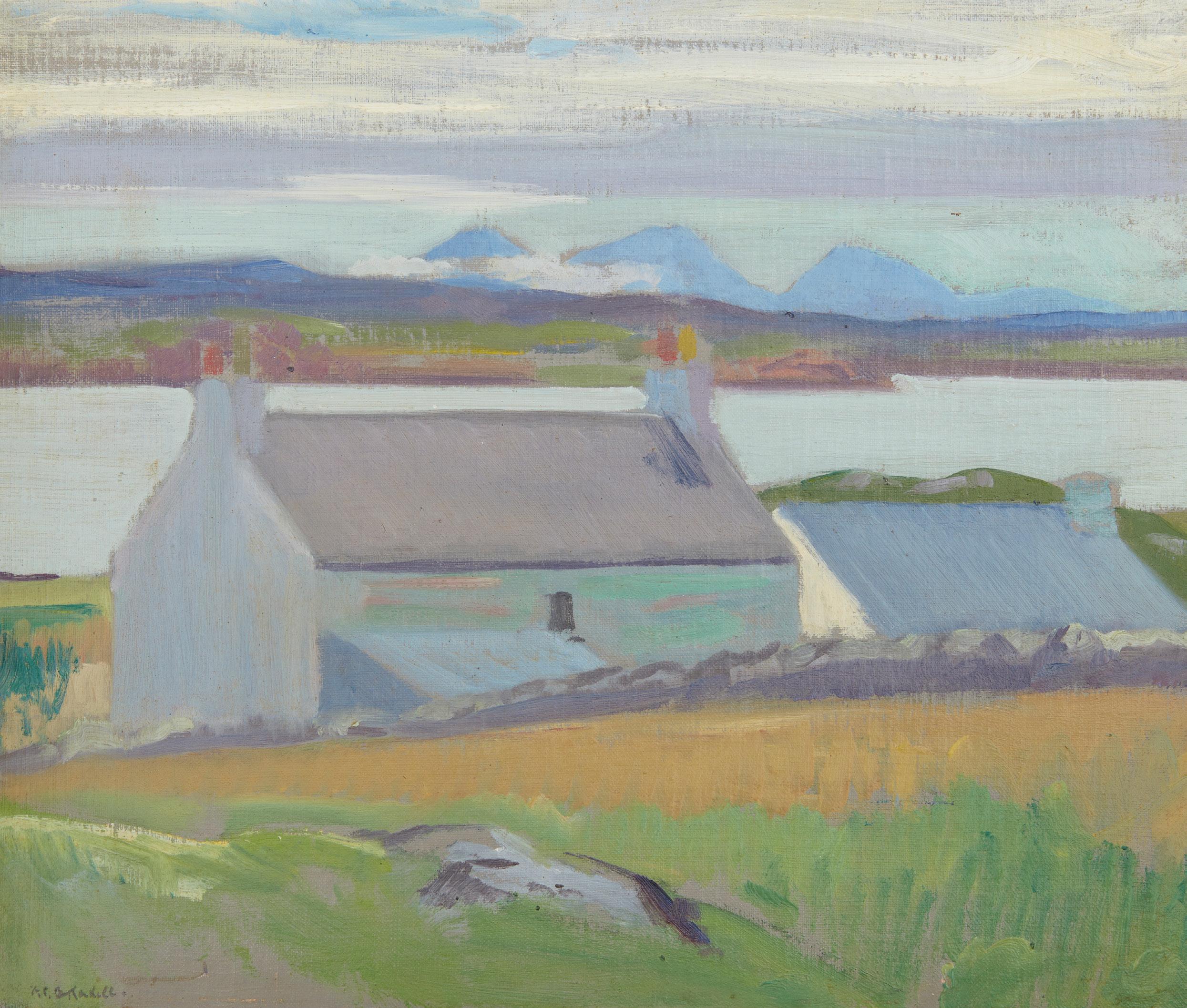
125 Other fees apply in addition to the hammer price: see the ‘Buyer’s Guide’ section on page 2
Note: MacLeod Coupe also illustrates in his book a photo of the existing cottage in 2009 with a view of the Ross of Mull and the Paps of Jura in the distance.


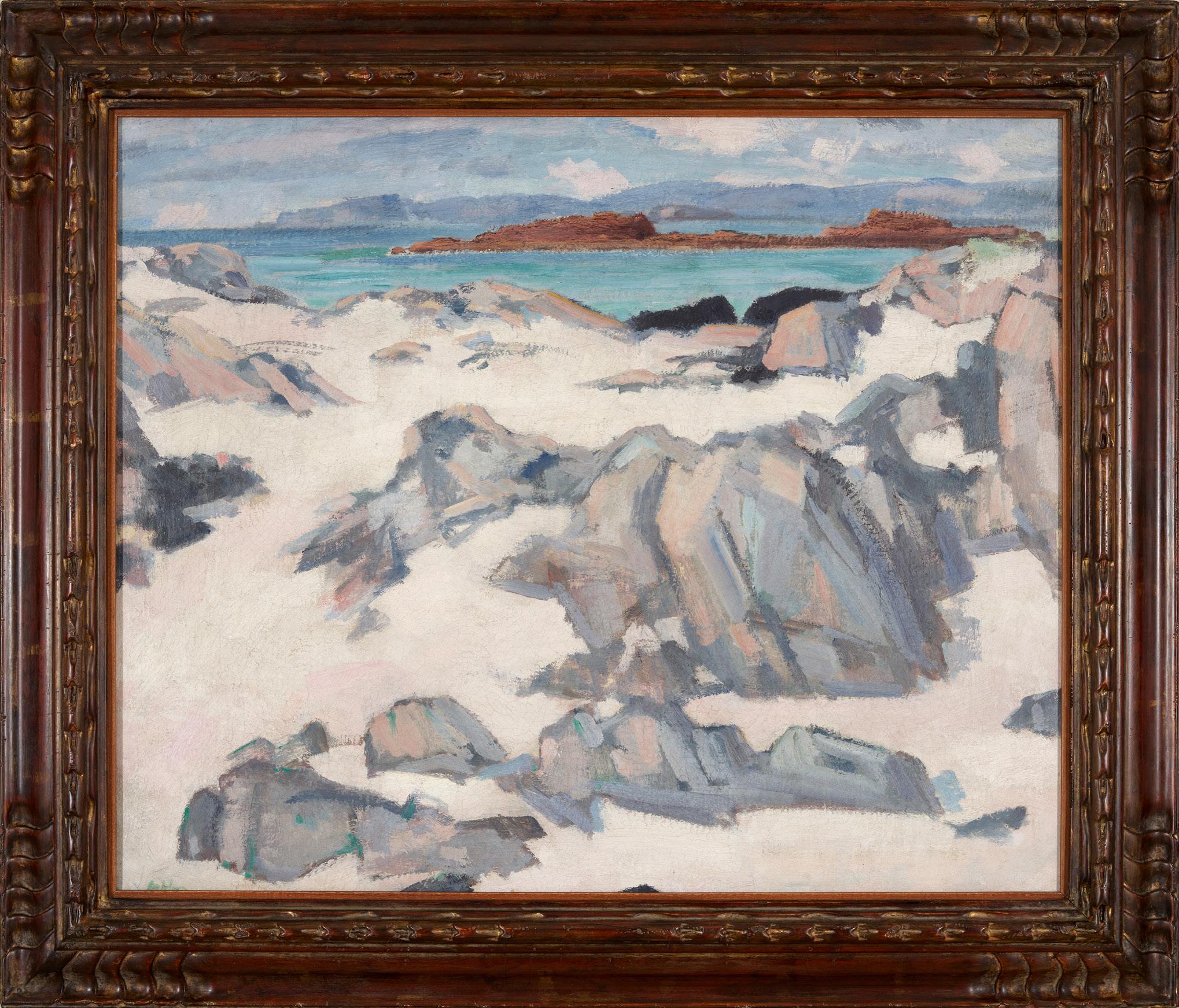
R.S.A.
TRESHNISH POINT FROM COWS ROCK
Signed, oil on canvas, with another painting verso showing Peploe’s sons with a cricket bat 51cm x 61cm (20in x 24in)
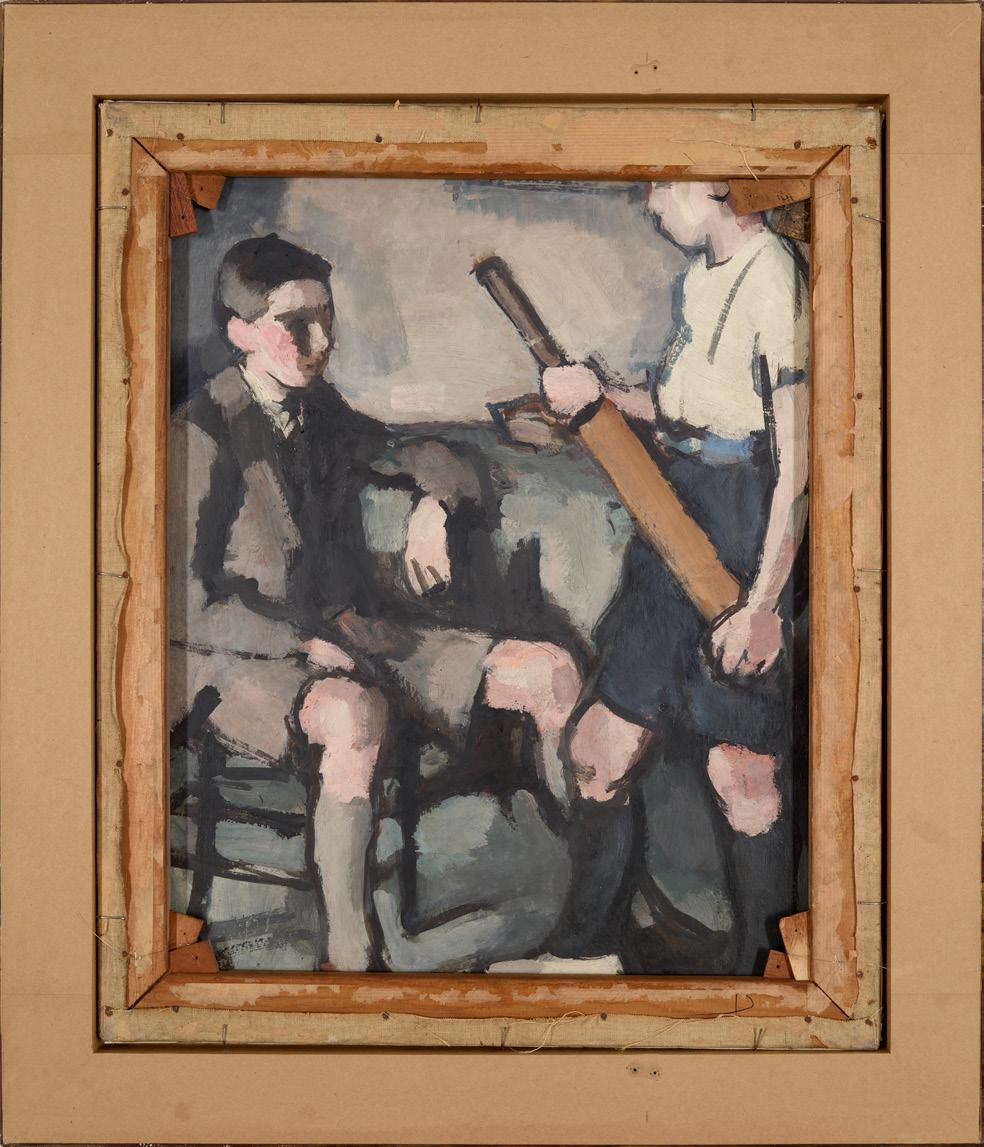
£50,000-70,000
In 1903 Duncan moved to Edinburgh from America, where he had been teaching art at the Chicago Institute. A visit to Iona helped him to plan for the future and ‘he started by making a vow to devote his time to the realisation of spiritual art and to gather the crops of his imagination rather than let them rot in untended fields.’ (John Kemplay, The Paintings of John Duncan A Scottish Symbolist, Rohnert Park, 1994, p.43). Duncan played a key role in the Celtic Revival which blossomed in the 1890s and Iona provided the setting for some of his most important Symbolist works, which celebrated Celtic mythology; it was also where he is reported to have encountered Gaelic fairy-folk for the first time. Such was the inspiration that the island afforded Duncan, that he was to work there, on and off for forty years, often at the same time as Cadell and Peploe.
Duncan’s Cathedral Rock from the North End of Iona shows a view made famous by the more well-known images of the scene by his Scottish Colourist friends. Cathedral Rock is
part of the headland at the extreme north-east corner of the island and is the location of some of its most dramatic geology. The view shown is out to Eilean Annraidh, Staffa and Mull.
Auchabhaich Croft first appears in Cadell’s Register of Pictures (Private Collection on long-loan to the National Galleries of Scotland) in 1914 (work no.30), presumably painted during his trip to the island the preceding year. It is one of the crofts situated north of the village and Cadell was to paint it on many occasions, not least as it was not far from Cnoc cùil Phàil, the croft on which he most frequently stayed after the War. The buildings depicted nestled within Auchabhaich Croft, Iona still exist, albeit extended in various directions. A T. & R. Annan & Sons Ltd label on the painting’s reverse gives it the title ‘Nightfall Iona’ and the image appears to capture the gentle light of the gloaming, as evening falls over the peaceful scene with its reach to the Paps of Jura in the distance.
154
SAMUEL JOHN PEPLOE
(SCOTTISH 1871-1935)
127 Other fees apply in addition to the hammer price: see the ‘Buyer’s Guide’ section on page 2
Mull from Iona leads the eye from a patchwork quilt of fields across the Sound to the neighbouring island, with particular attention paid to the tumult of weather conditions played out across the sky. This painting formerly belonged to Cadell’s great patron, the shipowner George W. Service, who holidayed on Iona. He reportedly donned a tartan dress jacket for the night of his annual purchase of work by Cadell and appears regularly in the artist’s Register of Pictures from 1913 until 1927.
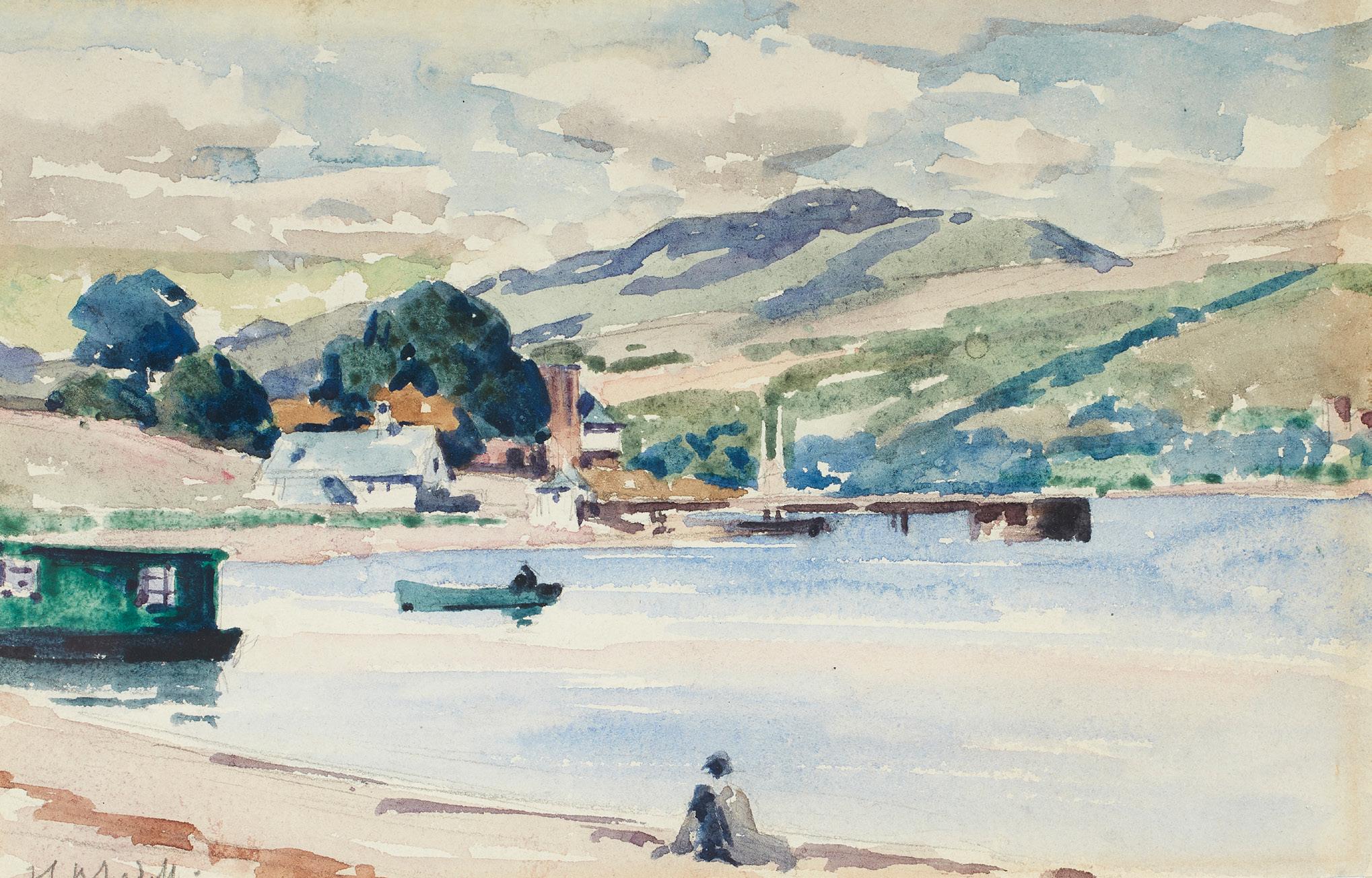
Service would often make multiple acquisitions at a time, usually but not exclusively images of Iona, commissioned portraits of some of his children and supported the artist’s sales in exhibitions such as those mounted by the Society of Eight in Edinburgh. His support sometimes formed the backbone of Cadell’s income, for example when he purchased fourteen works in 1921 for a total of £725, which was 40% of Cadell’s recorded total sales of £1,786 for the year. Two years after Cadell’s death, Mull from Iona was one of three works lent by Service to the landmark Exhibition of Scottish Art mounted at the Royal Academy of Arts in London.
155
FRANCIS CAMPBELL BOILEAU CADELL R.S.A., R.S.W. (SCOTTISH 1883-1937)
THE JETTY
Signed, watercolour
14cm x 22cm (5.5in x 8.75in)
£5,000-7,000
Peploe was nearly fifty years old when he first painted on Iona. He was thus able to approach its visual possibilities with the experience of a mature artist and was particularly drawn to the natural beauty of the north end and the views from it. Treshnish Point from Cows Rock was painted in this area; its dramatic composition sees the beach and protruding rocks occupy all but the upper fifth of the image. Peploe’s technique uses the materiality of oil paint to convey a sense of the texture of sand and weathered rocks, around which inviting paths meander. Between the alluring blue of the sea and the active sky can be glimpsed the west end of Eilean Annraidh in the middle distance and Treshnish Point on the horizon. A closely related painting by Peploe, Iona, Grey Day, is in the collection of Aberdeen Art Gallery and Museums.
128
156
JOHN DUNCAN R.S.A, R.S.W. (SCOTTISH 1866-1945)

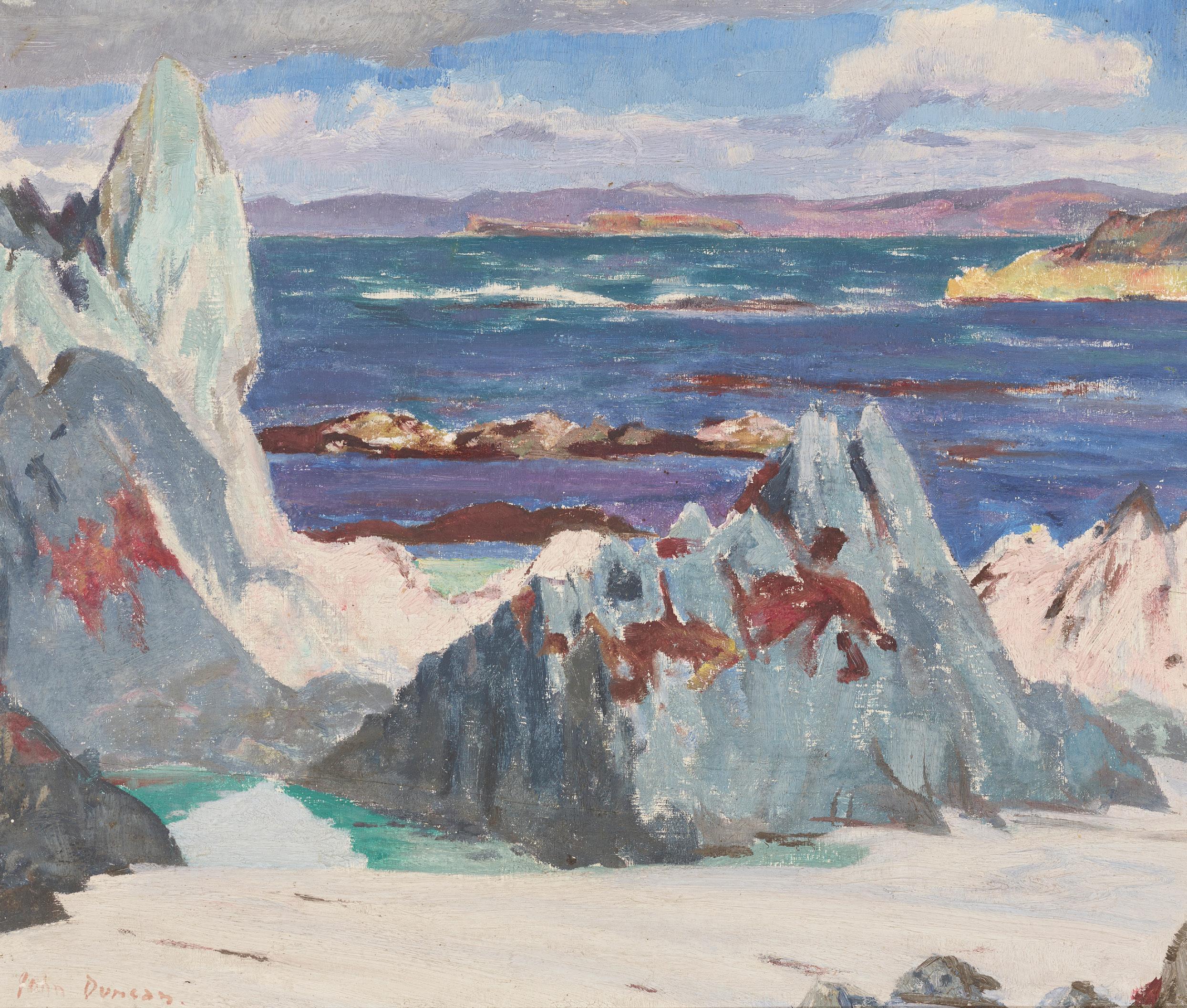
CATHEDRAL ROCK, NORTH END, IONA
Signed, oil on board
38cm x 46cm (15in x 18in)
£1,500-2,000
Other fees apply in addition to the hammer price: see the ‘Buyer’s Guide’ section on page 2 129
Mull from Iona in the catalogue for the Exhibition of Scottish Art held at the Royal Academy of Arts, London in 1939
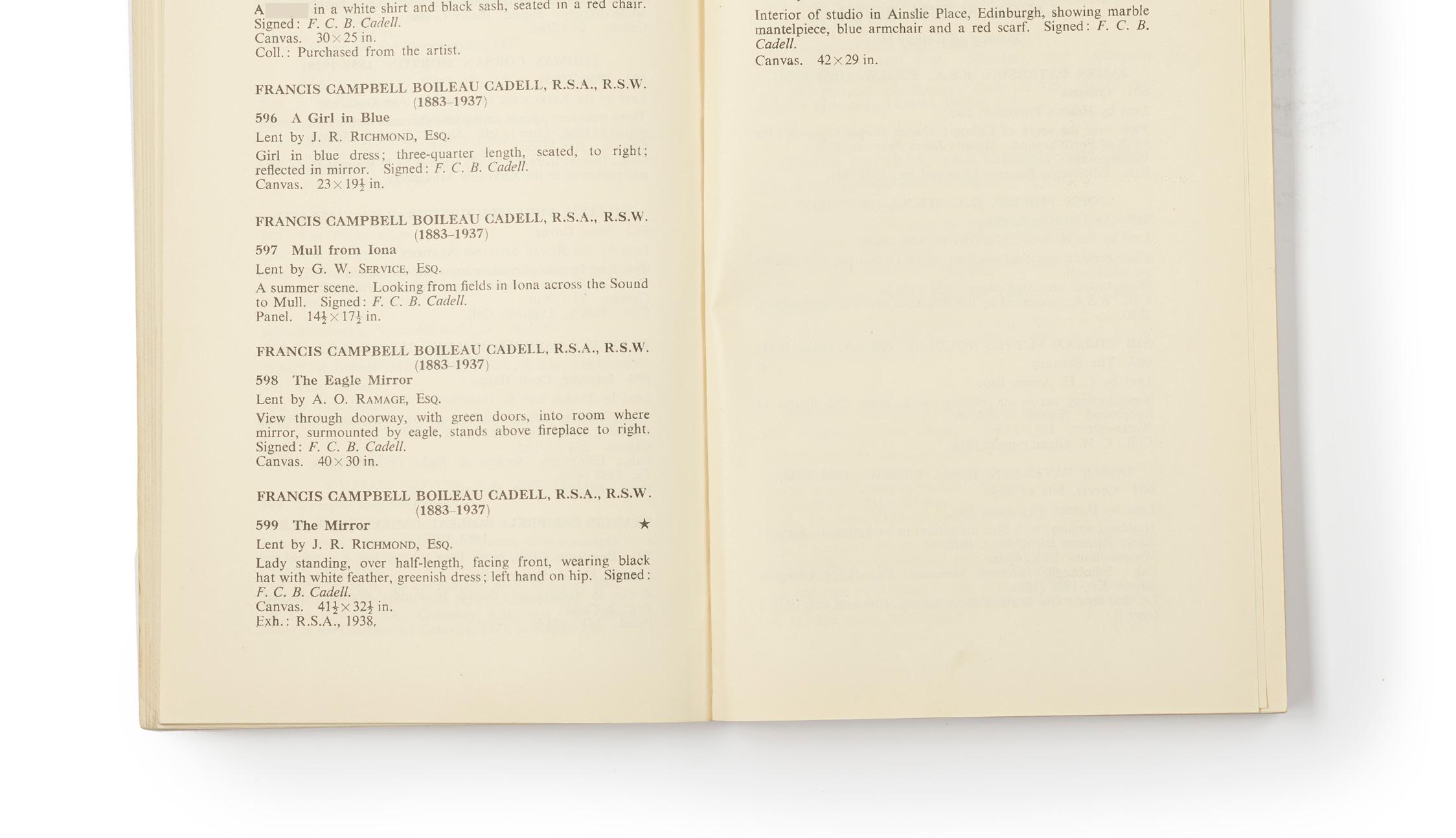
157
FRANCIS CAMPBELL BOILEAU CADELL R.S.A., R.S.W. (SCOTTISH 1883-1937)
MULL FROM IONA
Signed, inscribed verso ‘G. W. Service’, oil on board 37cm x 44.5cm (14.75in x 17.5in)
Provenance: George W. Service, Glasgow Lyon & Turnbull, Edinburgh, Fine Paintings, 3 December 2008, lot 128, where acquired by the present owner
Exhibited: Royal Academy of Arts, London, Exhibition of Scottish Art, 6 January-11 March 1939, no. 597 (lent by George Service, incorrectly catalogued as pastel)
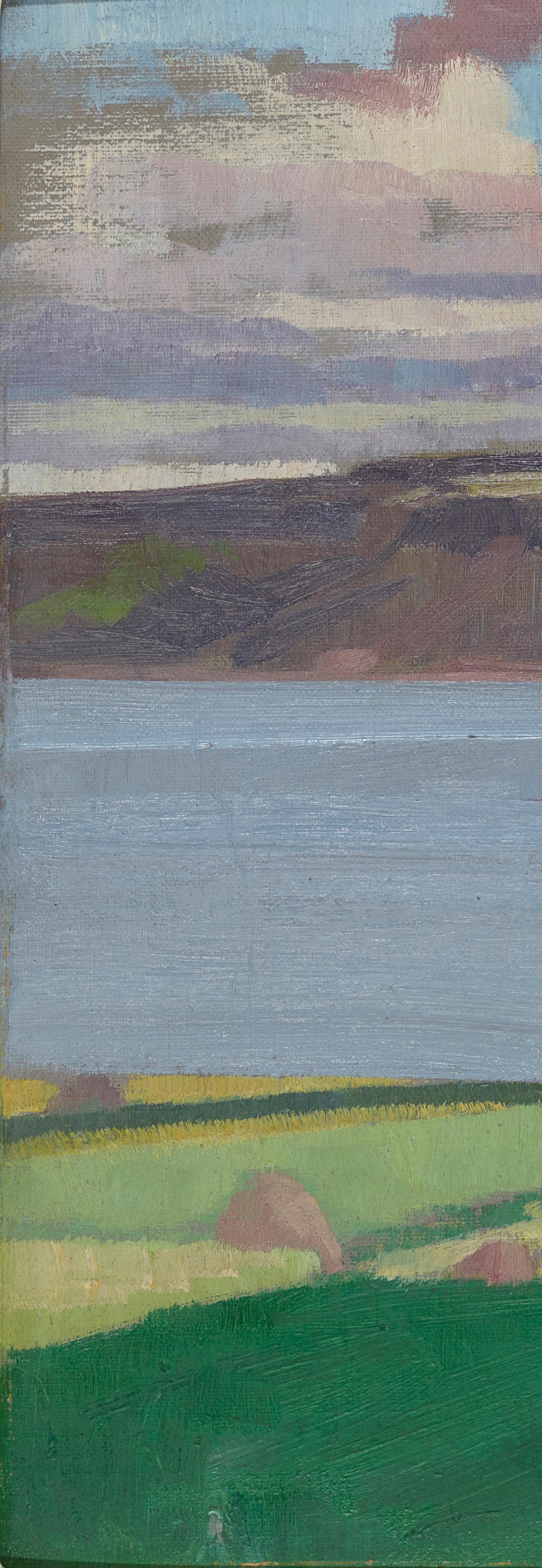
Note: This painting was one of eight works by Cadell shown in the landmark exhibition of Scottish art held at the Royal Academy of Arts in London in 1939; it was one of three lent by the shipowner George Service. Its entry in the catalogue read: ‘A summer scene. Looking from fields in Iona across the Sound to Mull.’
£20,000-30,000
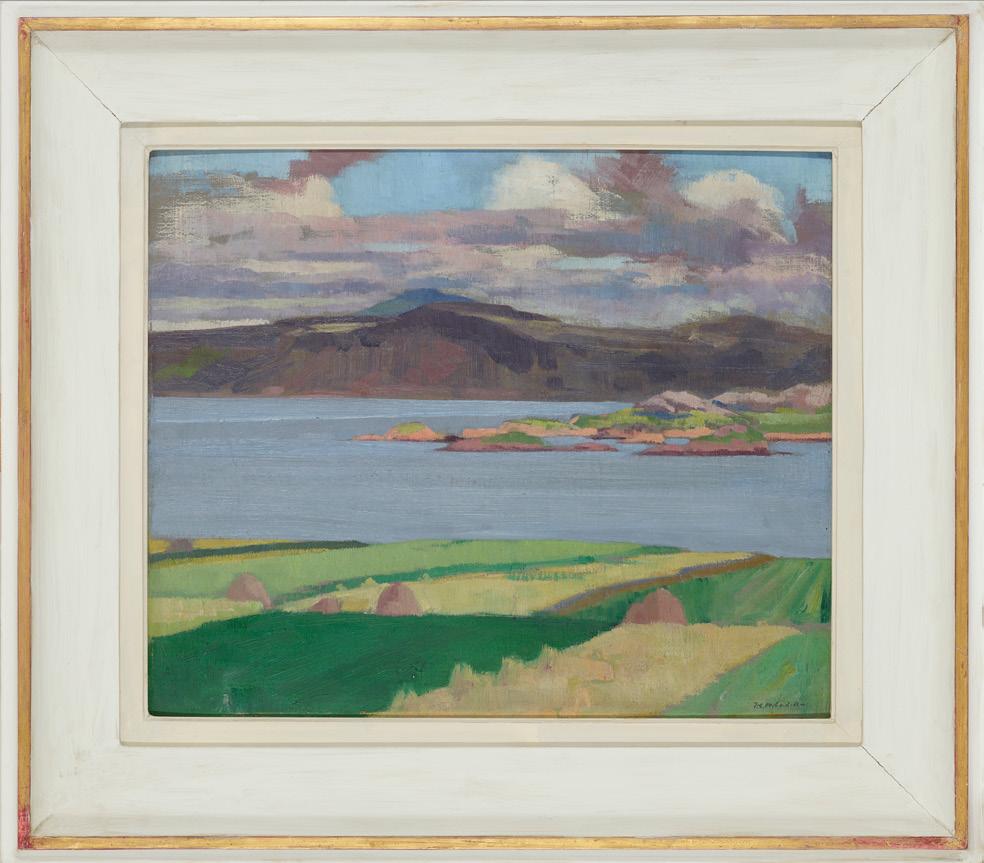
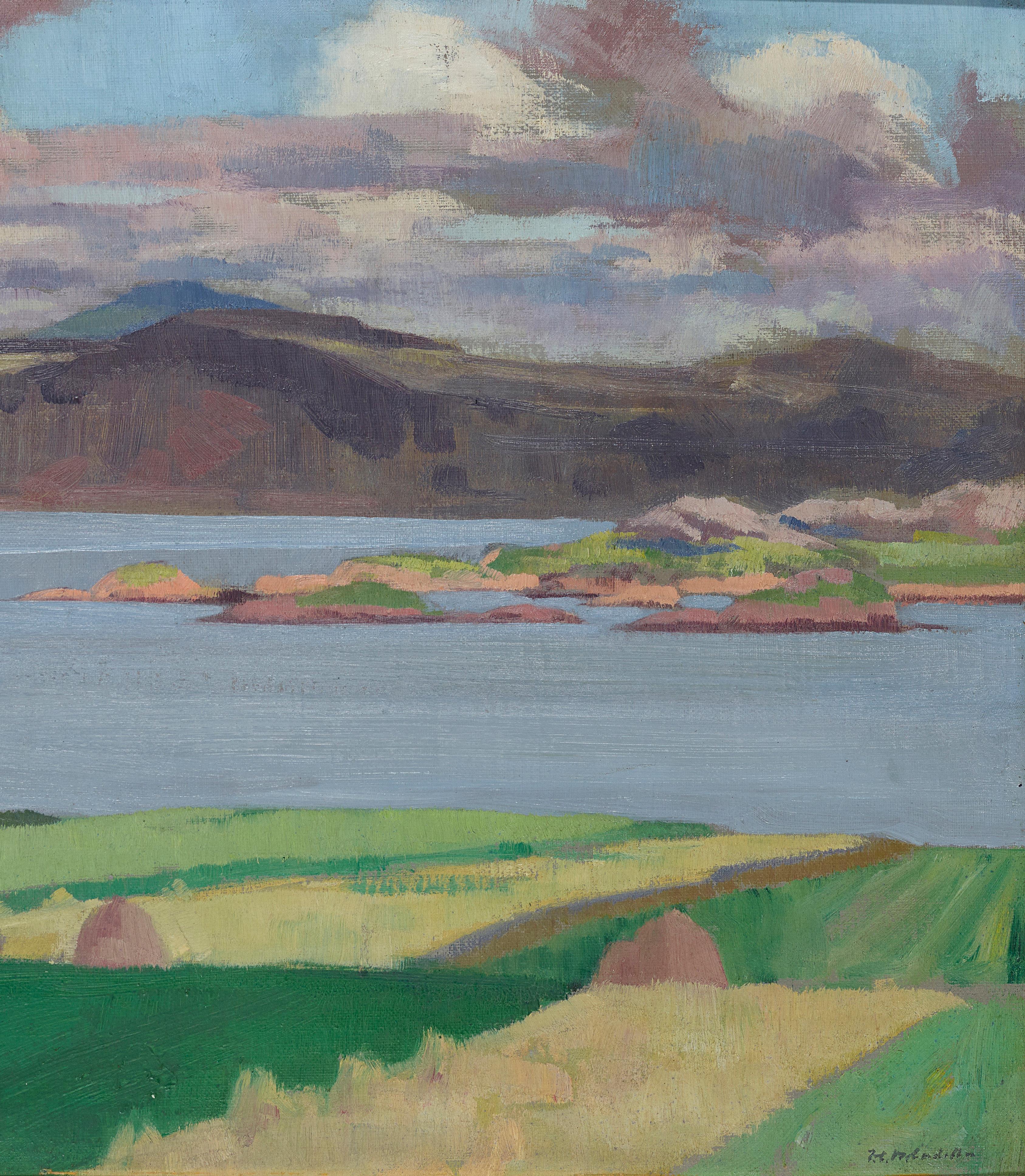
131
Tulips, Fruit & a Blue Jug: F. C. B. Cadell’s Symbols of Beauty

F. C. B. Cadell, like his fellow Scottish Colourist and close friend S. J. Peploe, was a master of the still life genre. As seen in Still Life (The Tulip) and Still Life with Tulips, he created images of arresting beauty by way of carefully chosen, arranged and depicted props, including favoured and highly-coloured flowers, fruit and ceramics.
These paintings illustrate the significant development in Cadell’s practice after demobilisation and moving to 6 Ainslie Place in Edinburgh’s Georgian New Town in 1920. Moreover, it was with works from this period that he established his reputation as one of Scotland’s most important artists of the twentieth century. Cadell decorated and furnished his magnificent quarters with aplomb and celebrated its interiors and objects d’art in images characterised by a new firmer technique, flatter rendering of form and use of saturated colour.
As Alice Strang has explained:
This marked change is thought to have been encouraged by Cadell’s new surroundings, by his close collaboration with Peploe immediately after the war, by his interest in the Art Deco movement, and possibly in response to the squalor of the trenches. (Alice Strang, F. C. B. Cadell, National Galleries of Scotland, Edinburgh, 2011, p.40)
Cadell and Peploe had met in Edinburgh by 1909 and these two paintings pay testament to the closeness of their friendship, especially in the early 1920s; Peploe lived a short distance away from Ainslie Place, in India Street. At this time both were drawn to the visual possibilities of tulips, the only flower which continues to grow after being cut. This phenomenon gives rise to the graceful arabesques of their stems which Cadell depicted so deftly. The forms of the flower heads, the layering of their petals and the dense colouring of their leaves also provided an inspiring source of silhouette, colour and markmaking.
158
FRANCIS CAMPBELL BOILEAU CADELL
R.S.A., R.S.W. (SCOTTISH 1883-1937)
STILL LIFE WITH TULIPS
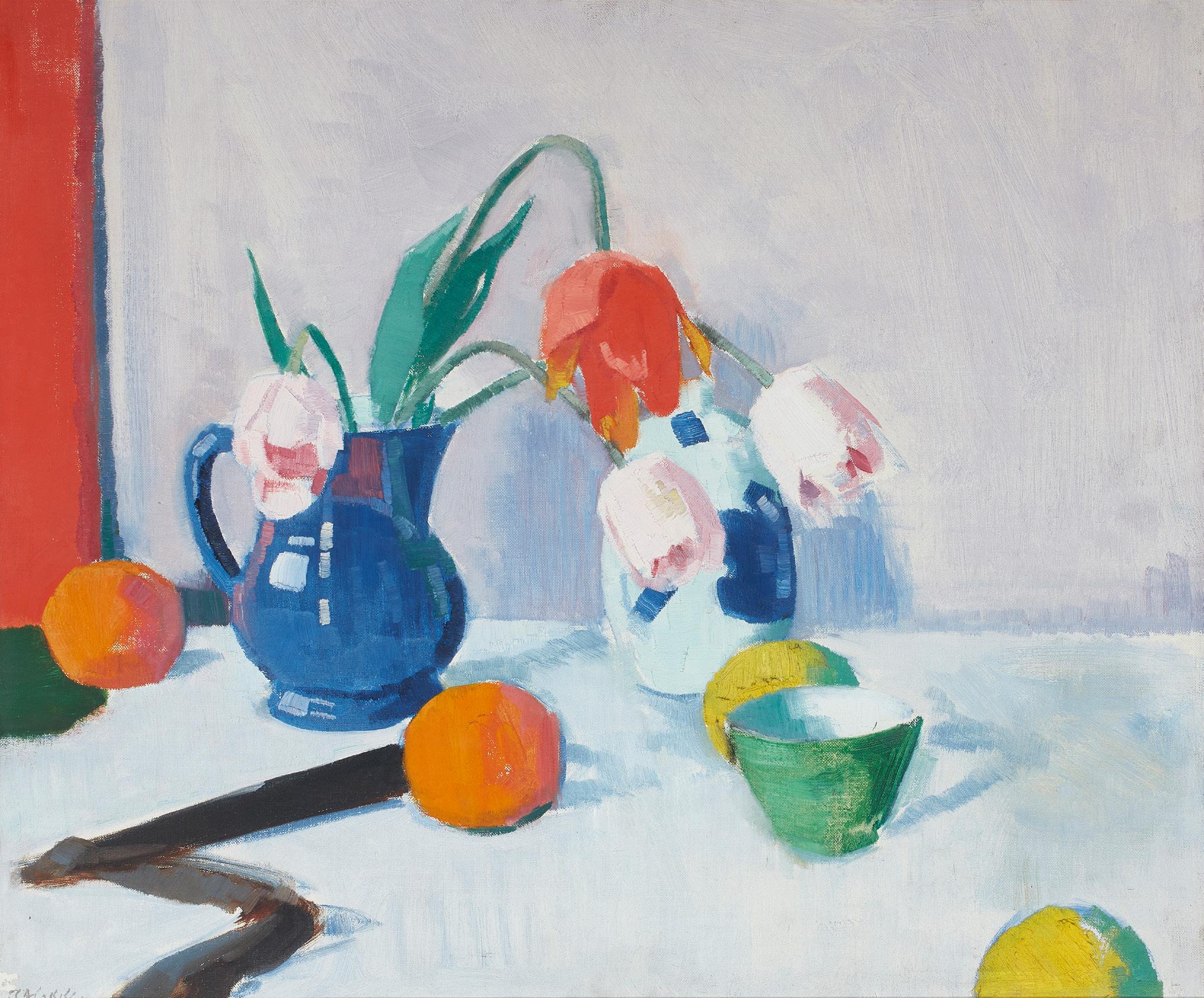
Signed, inscribed verso, oil on canvas
51cm x 61cm (20in x 24in)
Provenance: Acquired in 1943 from Dowell’s Ltd, Edinburgh and thence by descent to the Executors of the Late Mrs Anne Walker
£100,000-150,000
133
The earlier Still Life (The Tulip) is an image of extraordinary modernity; its tight handling, brilliant palette and suppression of volume embody the Art Deco style before the exhibition from which that term was derived was mounted in Paris in 1925. It may be set before a wall on the ground floor of Ainslie Place, which Cadell is known to have painted dark blue, green and brown above a light grey floor. The internal framing device around the jug is believed to be an empty white frame, of the type which Cadell often used for the presentation of his work. The cropped, asymmetric composition sets up a striking relationship between tulip head and fruit, whose brilliant colour stands out against the dark background and tabletop.
As Strang has continued:
There are precedents in Art Deco painting and the lacquer work of Jean Dunand, but these still lifes are really Cadell’s own creation and count among the most remarkable paintings in British art of the period. (Strang, op.cit., p.41)
A label on its reverse reveals that Still Life (The Tulip) was included in the key exhibition, Paintings by S. J. Peploe, F. C. B. Cadell and Leslie Hunter (working title Three Scottish Artists) held at the Leicester Galleries in London in 1923. It was organised by A. J. McNeill Reid, son of the Glasgow-based dealer Alexander Reid and did much to secure the artists’ standing in the English art world. Cadell showed thirty works, of which he recorded the sale of five, for a total of £180, all to Alexander Reid, in his Register of Pictures (1923 no.s 8-12, Private Collection on long-loan to the National Galleries of Scotland).

Cadell’s register reveals that tulip still lifes were a popular subject during the early 1920s. One first appears in 1921 (no.12) as selling to A. J. McNeill Reid for £80, whilst ‘Tulips’ sold in 1923 to Alexander Reid for £40 (no.8); by 1924 prices had fallen to £8:8:0, for an oil sold at J&R Edmiston, Glasgow (no.9) and £2:0:0 for another of the same title at Dowell’s Ltd, Edinburgh. Two years later however, the market had improved and Cadell recorded the sale of White Tulips for £30 (no.25).
The slightly later Still Life with Tulips bears a price of £65 on its reverse and overflows with Cadell’s confidence and sophistication. He now revels in the reflective glaze and voluptuous qualities of the blue jug, this time set against the lilac walls of the first floor at Ainslie Place. A tablecloth and black fan with winding ribbon (a prop which Peploe also favoured) add to a sense of a cultured lifestyle. Spatial layering is complex and successful, from the cropping of the lemon in the foreground suggesting the wider space existing beyond the confines of the canvas, to the progression of green tea bowl, to lemon to blue and white oriental vase. Tulip heads are seen straight on and in profile, stems and petals overlap each other and their companions, whilst shadow is subtly implied by way of clearly visible brushstrokes. The lighting is soft, the palette combines gentle tones with pure brilliance and each item contributes to an overall sense of balance.
Still Life (The Tulip) and Still Life with Tulips date from the most successful period in Cadell’s career, which began with his arrival at Ainslie Place and ended with his departure in 1931. They show how he used simple still life props as symbols of beauty when creating paintings which are as stunning now as they were when they were created a century ago.
134
The Leicester Galleries 1923 exhibition label on the reverse of Still Life (The Tulip)
159
FRANCIS CAMPBELL BOILEAU CADELL
R.S.A., R.S.W. (SCOTTISH 1883-1937)
STILL LIFE (THE TULIP)
Signed, signed and inscribed verso, oil on board 36cm x 43cm (14in x 17in)
Provenance: Acquired by Mrs R A Workman from the 1923 Leicester Galleries exhibition Portland Gallery, London Private Collection, U.K.
Exhibited: The Leicester Galleries, London, Paintings by S. J. Peploe, F. C. B. Cadell and Leslie Hunter, January 1923, no.38 (as ‘Tulips’)
£60,000-80,000
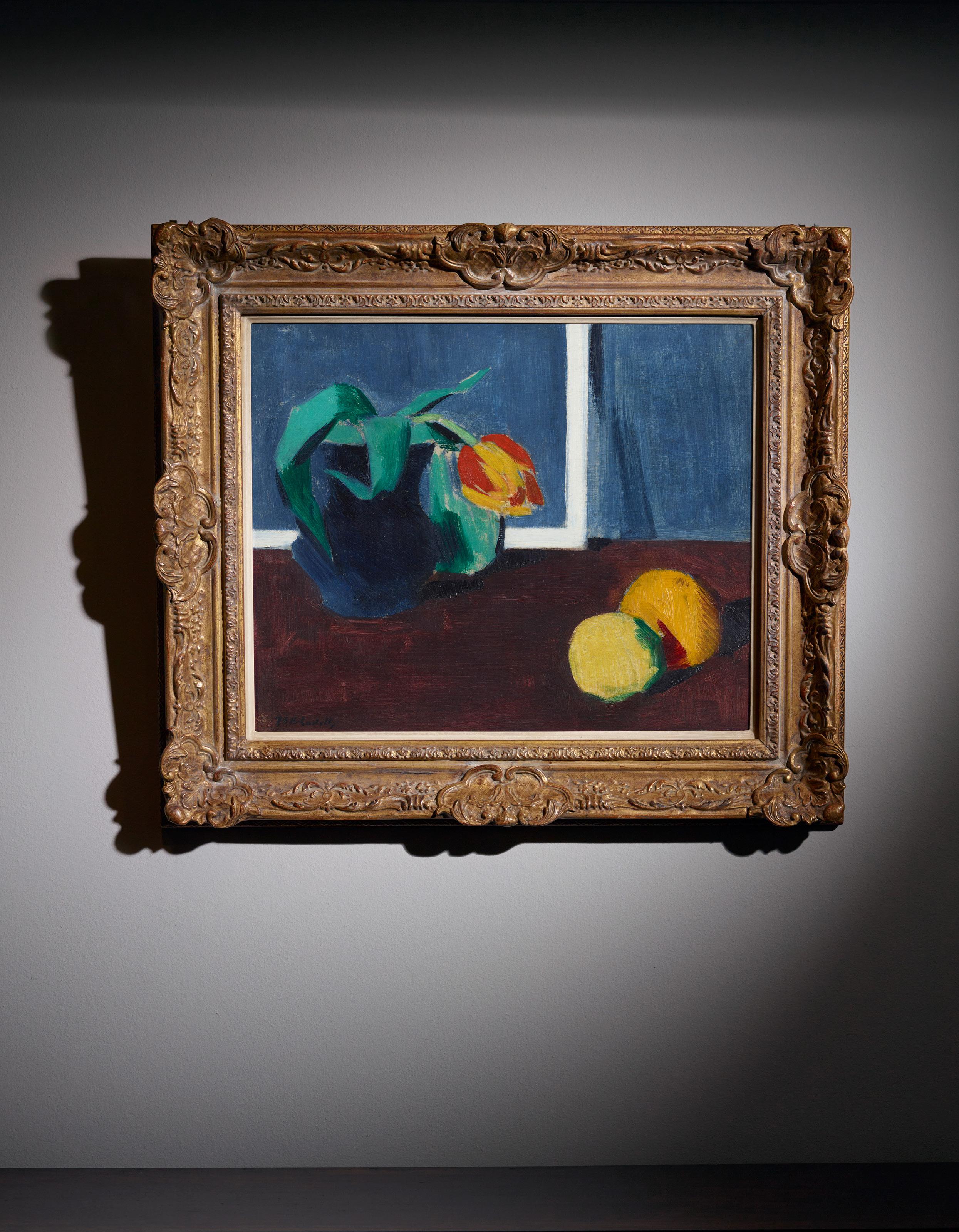
135
In 1929, Peploe declared ‘There is so much in mere objects, flowers, leaves, jugs, what not – colours, forms, relation – I can never see mystery coming to an end.’ This reveals the inspiration he found in the still life genre throughout his distinguished career, as can be seen in Still Life with Roses
As Roger Billcliffe has explained:
Peploe set himself as a target the perfect still-life painting… His temperament made him ideally suited to the task. His calm reasoning and thoughtful manner enabled him to make a careful analysis of the problems which face the still-life painter and he set about resolving them in a series of works which includes many of his most satisfying paintings. (Roger Billcliffe, The Scottish Colourists, London, 1989, p.51)
This lyrical painting is likely to have been created in Peploe’s studio at 54 Shandwick Place in Edinburgh’s West End, which he occupied from 1918 until 1934. His niece, Margery Porter, recalled visiting him there:
How well I recollect my Mother and myself climbing those steep stairs and arriving panting at the top to ring his bell in fear and trembling lest our climb had been in vain. But usually he would usher us in wearing a white painting coat and a crownless hat… The studio was a large one, round which I would prowl entranced, after strict warnings not to disturb the still-life group which would almost inevitably be covering the table. My uncle would arrange and re-arrange these groups for perhaps three days before he was satisfied that the balance and construction were perfect, then he would paint them quite rapidly. (quoted in Alice Strang et al, S. J. Peploe, Edinburgh 2012, p.23)
Peploe assembled a cast of objects which recur in his paintings like trusted friends, often crowned by the roses with which he is particularly associated and which he would often buy from the flower and fruit stalls of Princes Street; they were able to hold their shape long enough to satisfy his painstaking working process. The length of patterned fabric, be-ribboned black fan and platter in Still Life with Roses were all familiars by which he strove to create images of beauty and balance.
The depiction of stems in water, seen through glass, was a painterly challenge from which Peploe did not shy away. Indeed, as can be seen here, it was often a way in which to show his mastery of applying oil paint to canvas in order to convey reflection, transparency and refraction. Works of this period show a relaxing of his technique from the tight control of the early 1920s, to a freer and more expressive approach to depicting form and light. Black and white provide the structural basis of the composition and a contrast to the decorative qualities and rich colour of other passages. Viewed from above and at an angle, Peploe seamlessly leads the eye from foreground to background, with particular attention paid to the variegated tones of the flower heads, their petals realised in thick, short brushstrokes.
Peploe exhibited and sold still lifes regularly throughout his career and it is for his achievements in this genre that he is most celebrated as one of Scotland’s leading artists of the twentieth century.
136 Other fees apply in addition to the hammer price: see the ‘Buyer’s Guide’ section on page 2
160
SAMUEL JOHN PEPLOE R.S.A. (SCOTTISH 1871-1935)
STILL LIFE WITH ROSES
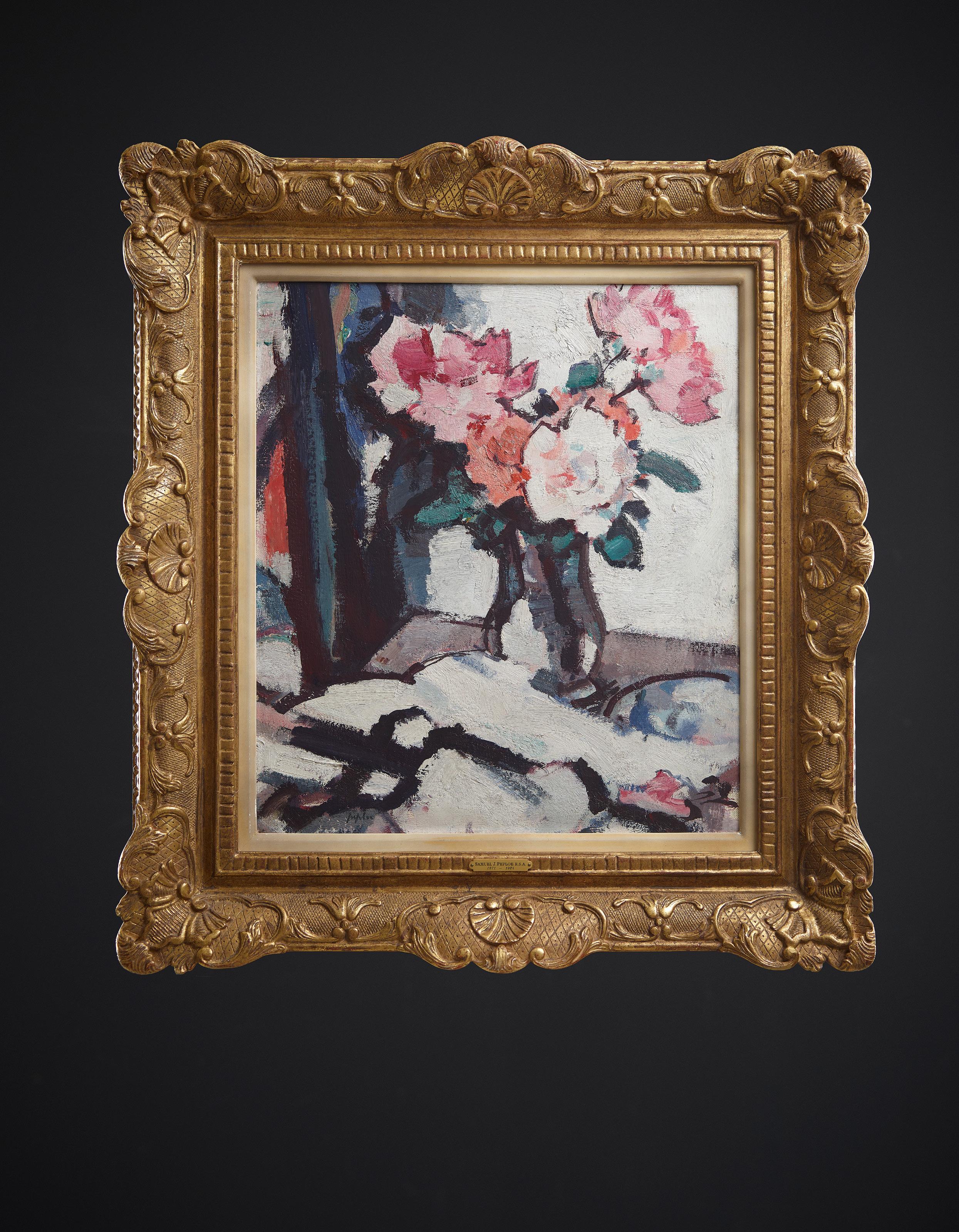
Signed, oil on canvas
46cm x 40.5cm (18in x 16in)
Provenance: MacConnal-Mason & Son Ltd, London
£100,000-150,000
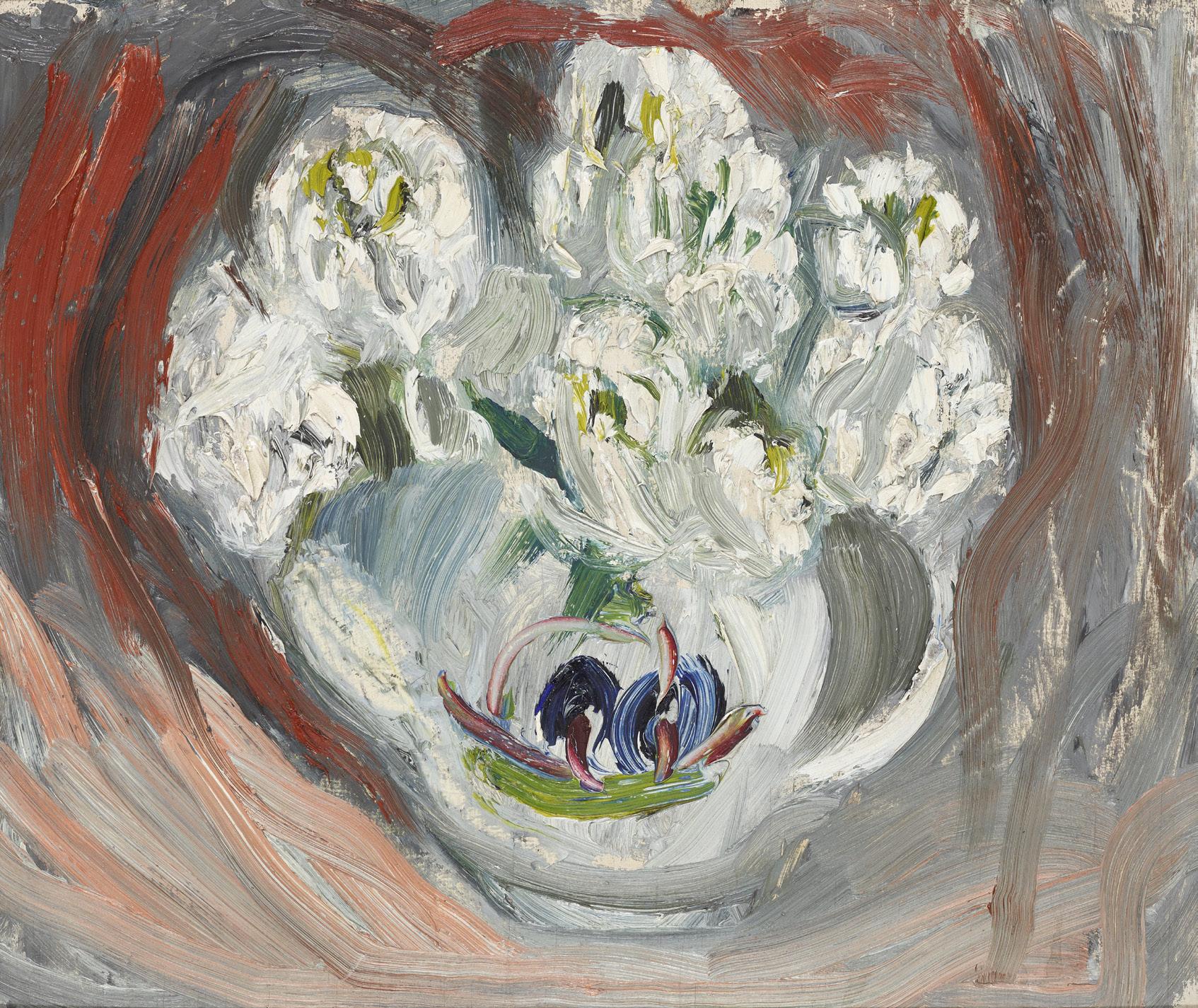 161 §
161 §
138
ANNE REDPATH O.B.E., R.S.A., A.R.A., L.L.D., A.R.W.S., R.O.I., R.B.A. (SCOTTISH 1895-1965) WHITE CYCLAMEN Oil on board 28cm x 33cm (11in x 13in) £4,000-6,000
162 §

ANNE REDPATH O.B.E., R.S.A., A.R.A., L.L.D., A.R.W.S., R.O.I., R.B.A. (SCOTTISH 1895-1965)
STILL LIFE WITH ASPIDISTRA
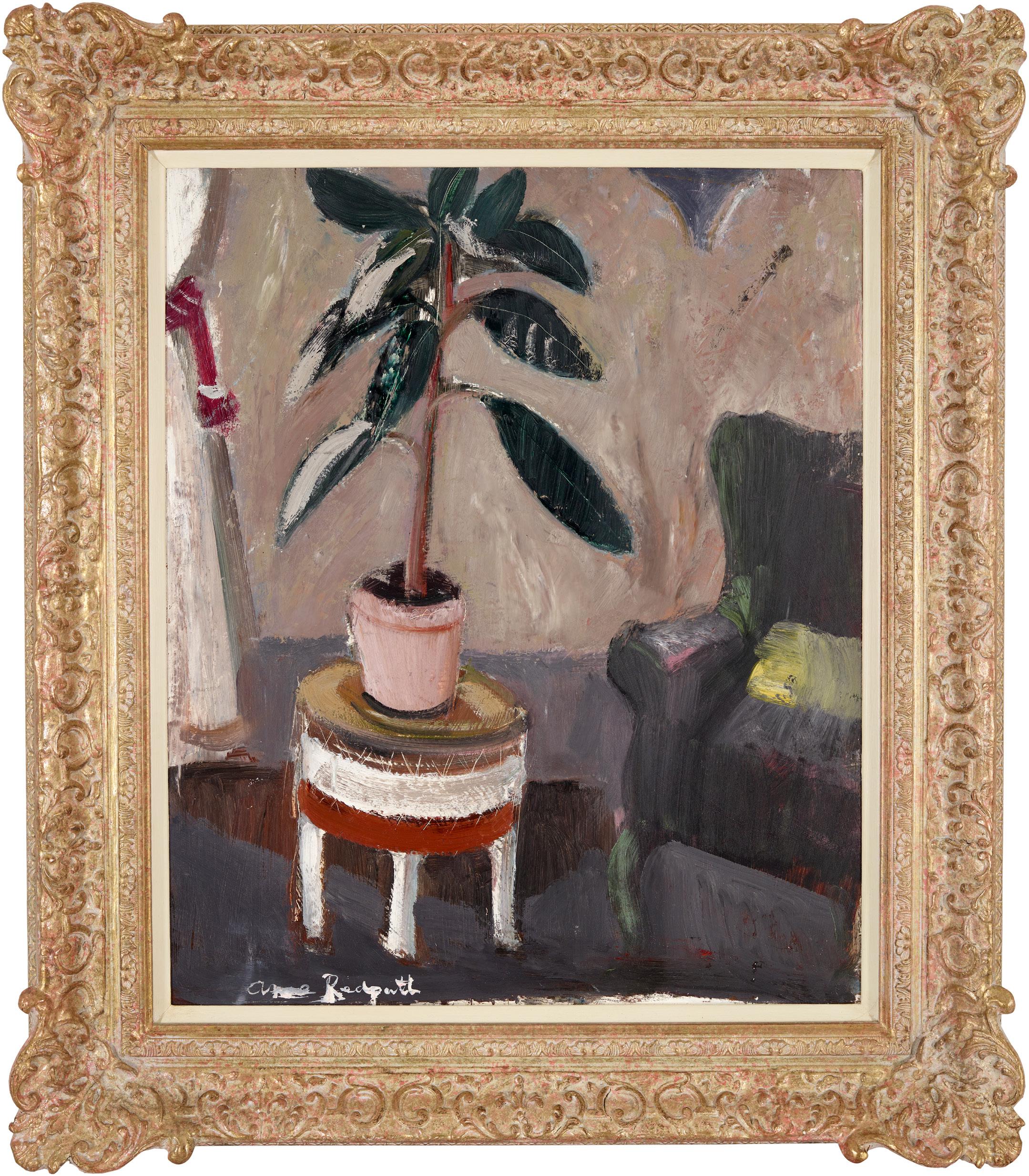
Signed, oil on board
61cm x 51cm (24in x 20in)
£10,000-15,000
139 Other fees apply in addition to the hammer price: see the ‘Buyer’s Guide’ section on page 2
From Townhead to Catterline: Joan Eardley’s Sense of Place
& People
The Townhead district of Glasgow and the fishing village of Catterline, on the north-east coast of Scotland, provided the locations and communities which inspired much of Joan Eardley’s oeuvre, revealing her deep sense of place and people in works which have secured her a leading place in British art history.

As Fiona Pearson has explained:
Eardley was a strong, passionate painter who was totally engaged in depicting the life forces around her, everything from children to nature… Eardley’s deep love of humanity was manifest in images of the resilience of the human spirit among the poor, the old and the very young…[She reminds…] Scots of lost tenement communities and the wild natural beauty of the landscape. (Fiona Pearson, Joan Eardley, National Galleries of Scotland, Edinburgh, 2007, pp.8-9)
In 1953 Eardley moved into a studio at 204 St James Road in Townhead, above a scrap-metal merchant’s premises. The area was of mixed residential and light industrial use, was rundown and overcrowded, yet she was drawn to its vibrancy, declaring:
I like the friendliness of the back streets. Life is at its most uninhibited here. Dilapidation is often more interesting to a painter as is anything that has been used and lived with – whether it be an ivy-covered cottage, a broken farm-cart or an old tenement. (As quoted in Patrick Elliott and Anne Galastro, Joan Eardley: A Sense of Place, National Galleries of Scotland, Edinburgh, 2016, p.14).
Eardley became a familiar figure sketching and photographing in the streets, drawn to the games and squabbles of the neighbourhood’s children and to evidence of lives lived in and amongst its decaying architecture. She worked spontaneously, at speed and often on the modest scale afforded by pocket sketchbooks, using larger sheets, chalks and pastels when developing imagery on return to her studio.
Works such as Children Playing Marbles show how Eardley instinctively empathised with childhood emotions, as a group of youngsters are absorbed in the drama of a competitive game. In The Blue Pinafore a child is caught in moment of contemplation. Her facial expression is depicted with tenderness and her unselfconscious pose speaks of innocence, whilst the thick application of pastel –sometimes highly coloured – signifies form and the artist’s energetic technique.
As Eardley became known in Townhead, so her natural rapport with the local children developed and some came to her studio to sit for her. She recalled:
Most of them I get on with…some interest me much more as characters… they don’t need much encouragement: they don’t pose…they are
completely uninhibited and they just behave as they would among themselves…They just let out all their life and energy they haven’t been able to at school. (As quoted in Elliott and Galastro, op.cit., p.48)
The studio works could be more considered, as seen in Studies of Amanda and Portrait Study Boy with Blue Trousers shows the ease at which she put her sitters, a whirlwind of lines applied over colour fields to define his features, his gap-toothed smile revealing his age and good humour. As a son of Eardley’s dealer, Bill Macaulay of The Scottish Gallery in Edinburgh, Eardley will have known the boy well.
Two Children is a particularly resolved and successful work. Skilful layering and blending of multi-coloured pastels focus attention on the children’s faces, their overlapping pose suggesting the intimacy of siblings. Eardley’s gestural technique communicates the patterning of their clothing, which gives way to free form markmaking.
Ginger is a dignified yet tender portrait. Executed with oil on board, the boy looks directly at the artist (and by extension the viewer). As Christopher Andreae has written about such works:
They were portraits not caricatures. She had too much rapport with them for such distortion. And direct, daily experience of them actually meant she knew them well and painted them in their world…she [did not]…let sentimentalism sift sugar over her understanding of these kids.
(Christopher Andreae, Joan Eardley, Farnham 2013, p. 127)
140
Joan Eardley in her studio at 204 St James Road, Townhead, Glasgow, 1950s. Photograph by Audrey Walker. Joan Eardley Archive, National Galleries of Scotland: Presented by the Artist’s Sister Pat Black in 1987

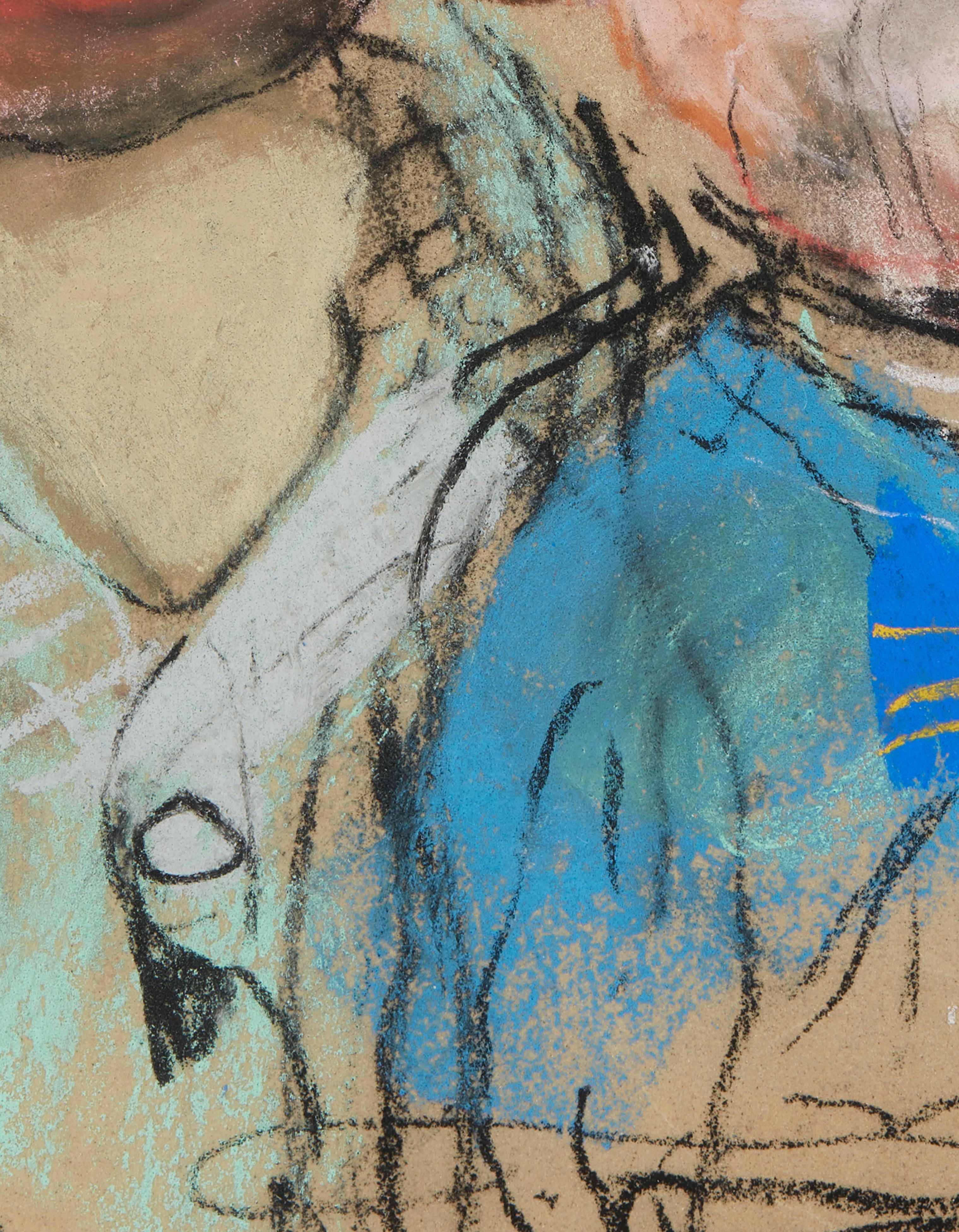

Eardley’s first visited Catterline in 1951 and the village became a new stimulus where she could depict the immensities of nature in the open air, painting and sketching ‘on the spot’ in all seasons, weather conditions and times of day.
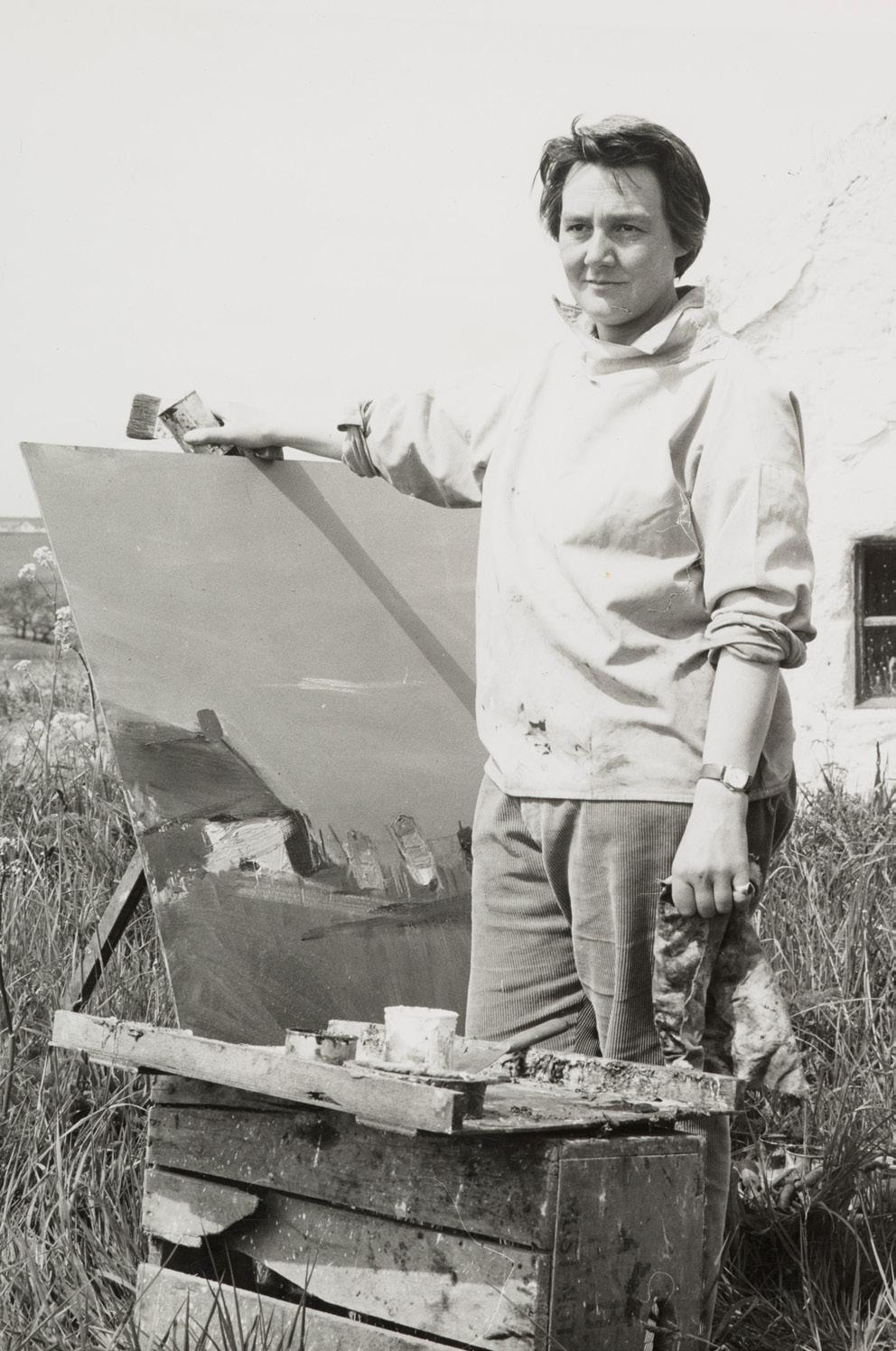
As Patrick Elliott has explained Catterline was not a picturesque Highland village…but a working harbour with boats, fishing nets and fields of wheat, barley and oats. People may be absent from Eardley’s Catterline paintings, but their presence is felt.’ (Patrick Elliott and Anne Galastro, Joan Eardley: A Sense of Place, Edinburgh 2016, p.10)
Eardley made frequent painting trips to Catterline between 1952 and 1954, before renting the small cottage at No. 1 South Row. She thereafter split her time between Glasgow and the village. Whilst keeping No.1 as a store, Eardley went on to purchase No. 18 South Row in 1959. Her relationship with the immediate area deepened and in 1961 Eardley declared:
When I’m painting in the north-east I hardly ever move out of the village…I find that the more I know of the place, or of one particular spot, the more I find to paint…I don’t think I’m painting what I feel about scenery, certainly not scenery with a name; because that is the north-east, just vast wastes, vast seas, vast areas of cliff…well – you’ve just go to paint it.’ (As quoted in Elliott and Galastro, op.cit., p.11)
As revealed in Haystack and Gate, Eardley was finely attuned to the turn of the seasons, the farming calendar and varying lighting conditions. She captured the ripening of the crops, their harvesting and the fecund forms of the resultant stacks. Here one is positioned at the centre of a composition based on thickly painted passages in which the higgledy-piggledy gate and fence are picked out in rich detail.
Eardley gave Footsteps in the Snow, The Row, Catterline to her grandmother’s housekeeper, Mrs McLusky in 1963. Mrs McLusky later explained that it had been made at daybreak after a fresh fall of snow. The footprints are those of the artist leaving No.1 South Row and finding the place from which to paint the scene. The cottage was the last in a row of ten and has been described thus:
No.1 was…the most exposed and southerly cottage in the village, at the least favoured end of the least favoured row, half as desirable as a coal shed…while there were a few bits of furniture in it when Eardley moved it, it seems to have had no permanent recent resident. It suited Eardley perfectly. (Elliott and Galastro, ibid., p.39).
The low vantage point means the cottage nestles above swathes of snow and beneath a sky in which dawn is advancing. Touches of colour bring out features such as the window frames and areas of weathering on the gable end. The interior painted on the work’s reverse provides a glimpse into its interior, showing the artist’s kettle set upon a gas stove. On receiving the painting, Mrs McLusky pointed out that it was unsigned, whereupon Eardley wrote her name in pencil at the lower right.
The Sea No.5 is a bravura example of Eardley’s heroic efforts to express the movement and power of the sea at Catterline, albeit on an intimate scale. She turned to this subject in earnest after moving to No. 18 South Row, which had a spectacular view down to the bay and the ever-changing state of the North Sea.
Patrick Elliott has continued:
The worse the weather, the more Eardley wanted to paint on the beach… Her ear was attuned to the noise of the crashing waves: she could judge, from her bed, if it would be worth painting. If she was in Glasgow and heard reports of north-easterly gales brewing off the east coast, she would happily pack her bags and head north. (Elliott and Galastro, ibid., p.119)
Painted in 1963, not long before Eardley’s premature death, the elongated horizontal format of The Sea No. 5 mirrors the artist’s experience of the scene before her. Mere glimpses of the beach are visible as Eardley focussed on the sheer power of the natural phenomenon playing out in front of her easel. The highly-charged gestural and abstract technique was informed by European Tachiste painting and American Abstract Expressionism, placing Eardley at the cutting-edge of post-war British art.
143
Joan Eardley painting beside No.1 South Row, Catterline, June 1961. Photograph by Audrey Walker. Joan Eardley Archive, National Galleries of Scotland: Presented by the Artist’s Sister Pat Black in 1987

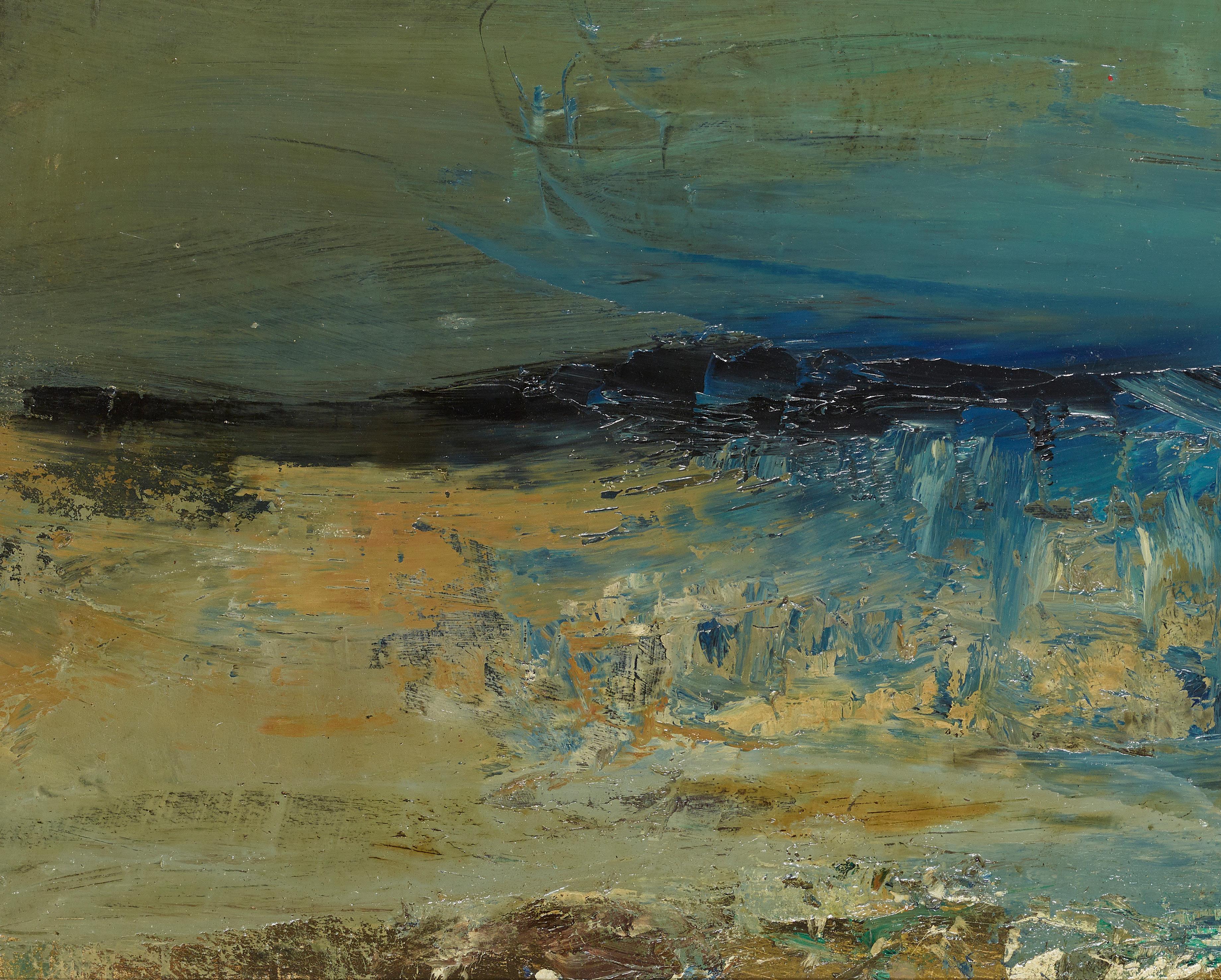
144
163 §
JOAN EARDLEY R.S.A. (SCOTTISH 1921-1963)
THE SEA NO.5
Signed and dated ‘63 verso, oil on board 30cm x 69.5cm (11.75in x 27.5in)

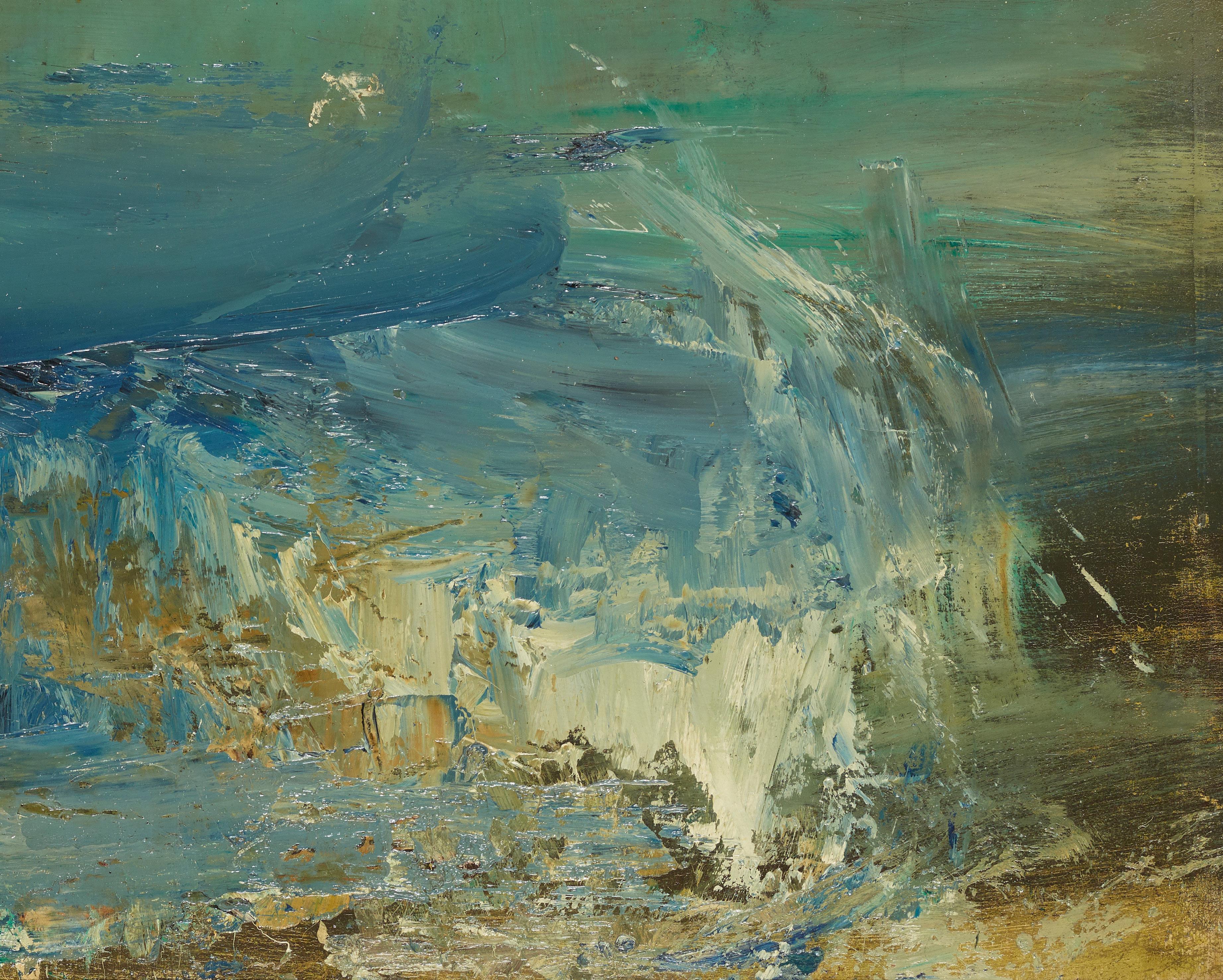
Provenance: Roland, Browse and Delbanco, London
Acquired by the great-aunt of the present owner £20,000-30,000

145 Other fees apply in addition to the hammer price: see the ‘Buyer’s Guide’ section on page 2
R.S.A.
With
JOAN
R.S.A. (SCOTTISH 1921-1963)
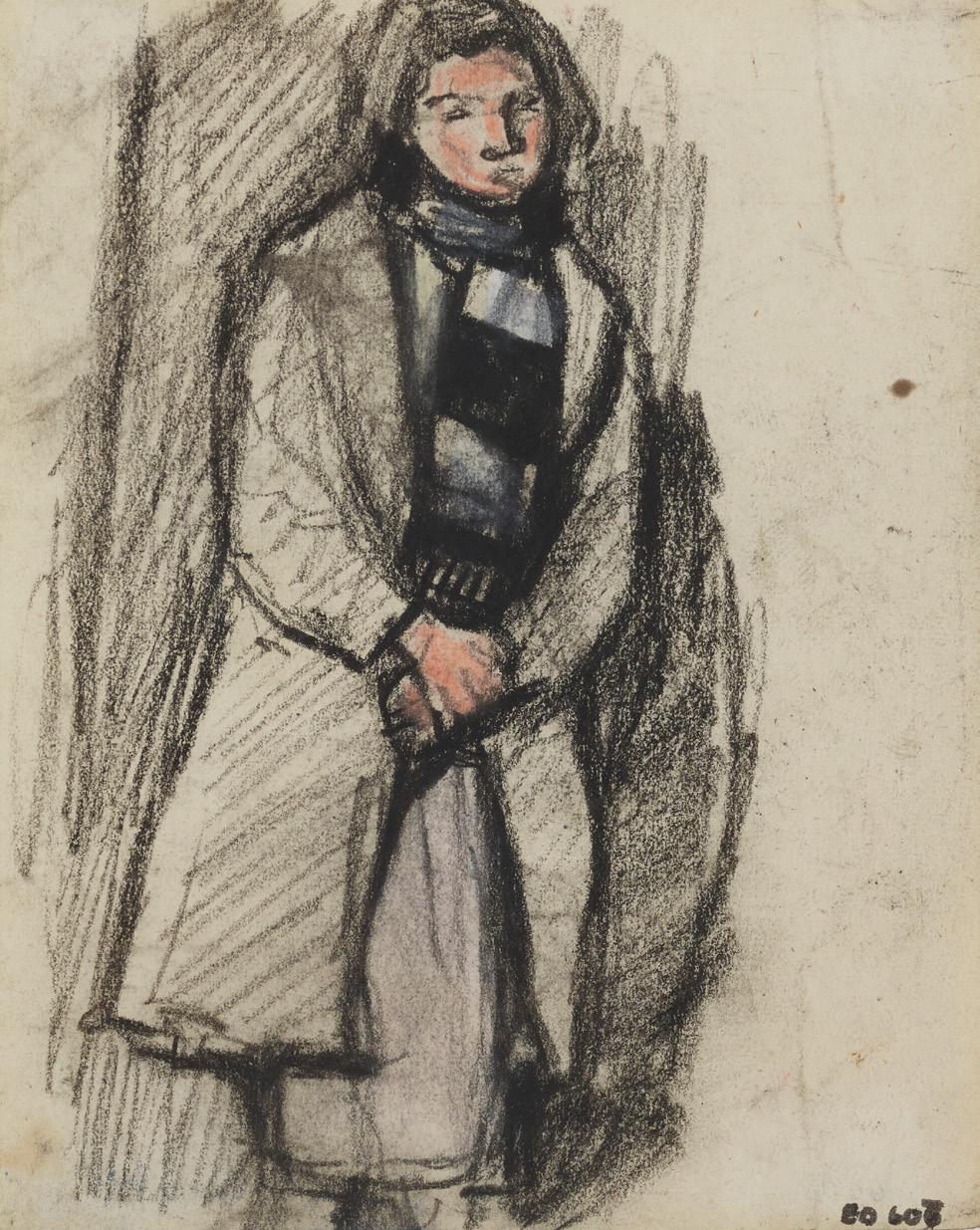
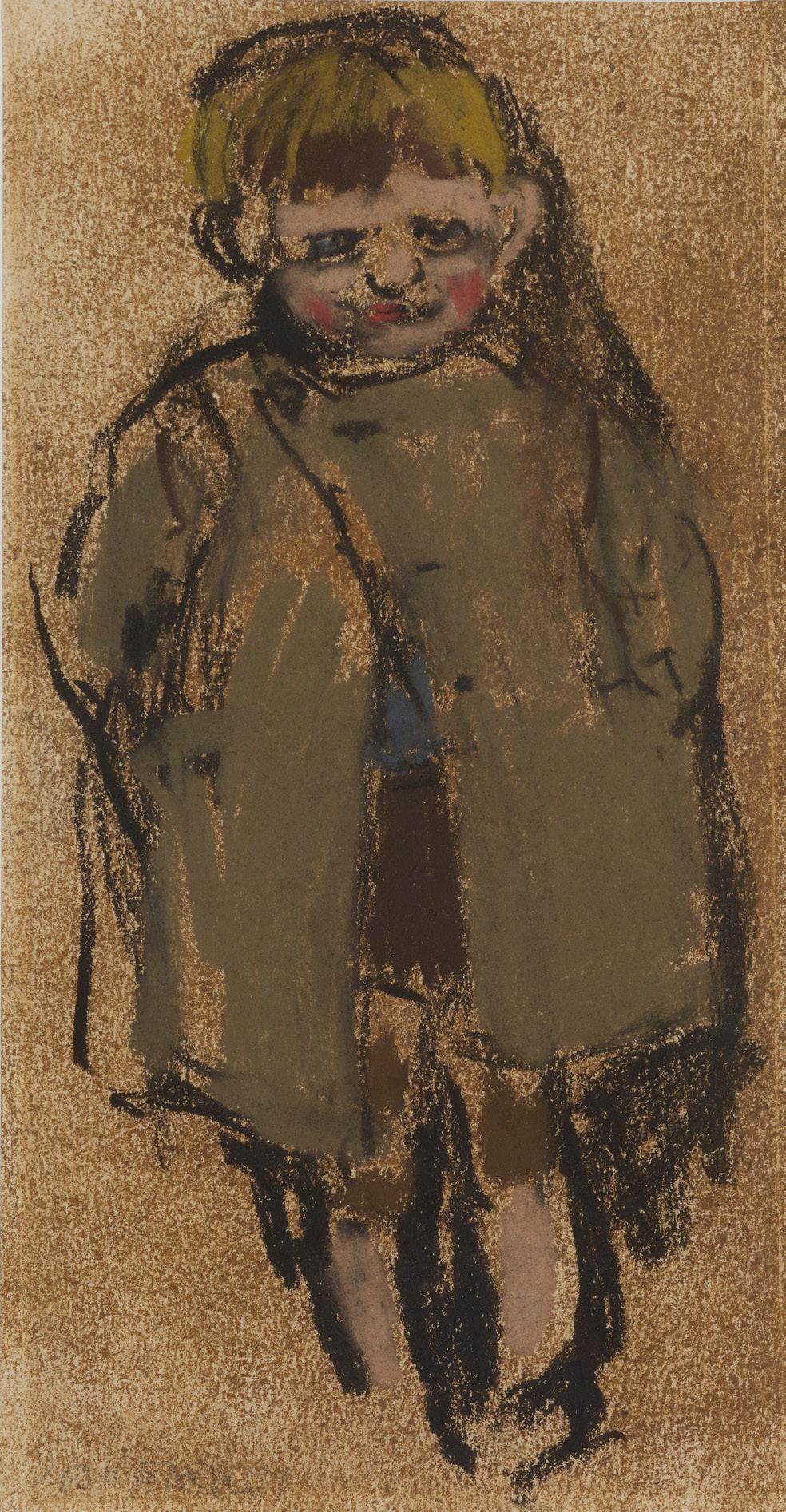
A GLASGOW
Signed,
19cm
Provenance:
164 §
EARDLEY
BOY
pastel
x 10cm (7.5in x 4in)
Bourne Fine Art, Edinburgh £4,000-6,000
165 §
JOAN EARDLEY
(SCOTTISH 1921-1963) THE GOSSIP
the Artist’s Estate Inventory Number ED607 lower right, pastel 12.5cm x 10cm (5in x 4in)
146
Provenance: Mercury Gallery, London where acquired by the present owner’s aunt in 1992 £3,000-5,000
166 §
JOAN EARDLEY
R.S.A. (SCOTTISH 1921-1963)
CHILDREN PLAYING MARBLES
With the Artist’s Estate Inventory
Number ED958, watercolour
28cm x 28cm (11in x 11in)
Provenance: The Artist’s Estate Private Collection, Scotland Duncan R. Miller Fine Arts, London
Exhibited: The Scottish Gallery, Edinburgh, Joan Eardley, Paintings, Watercolours, Pastels and Drawings, 1988, no.11
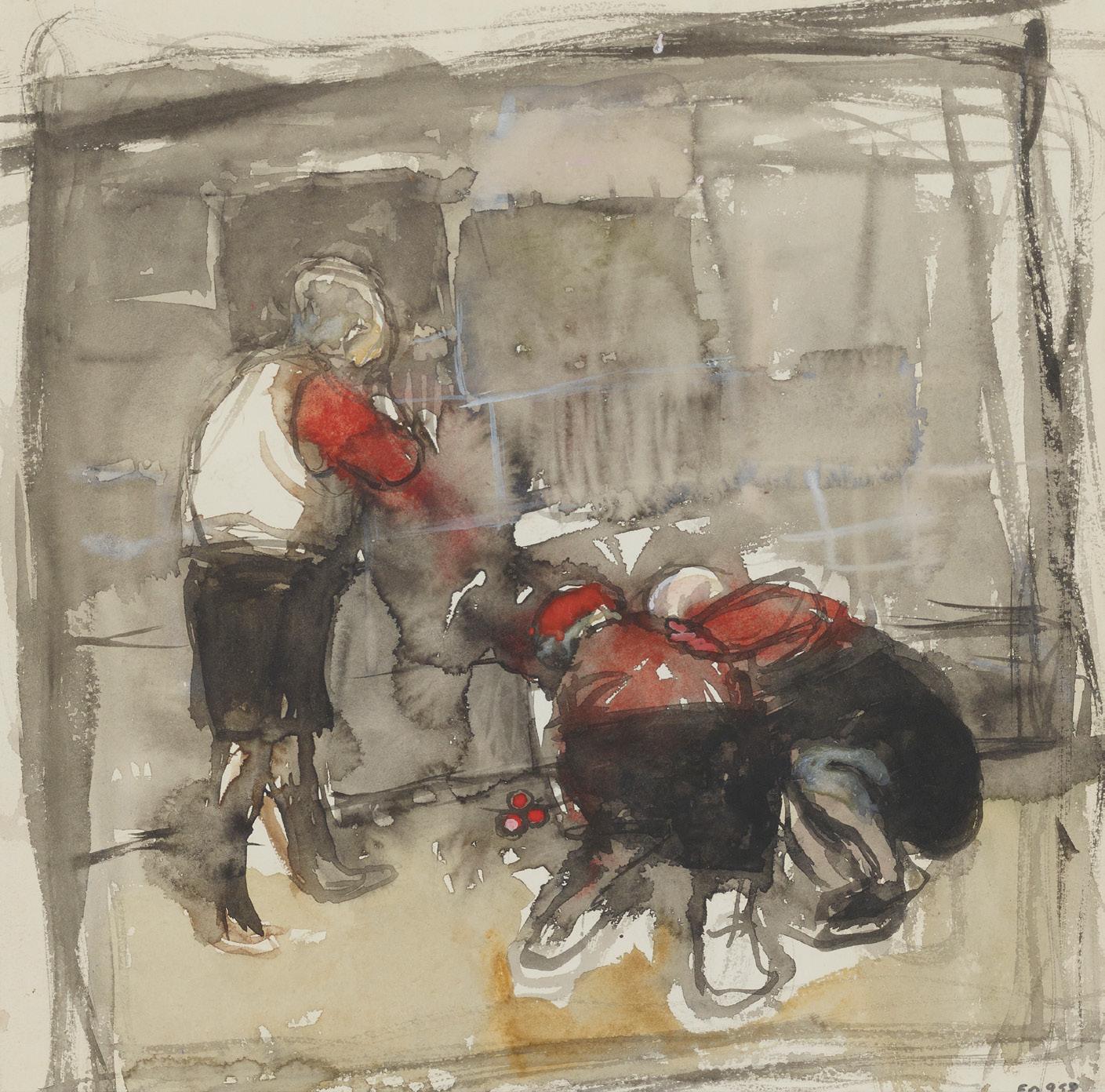

£8,000-12,000
167 §
JOAN EARDLEY
R.S.A. (SCOTTISH 1921-1963)
THE BLUE PINAFORE
Signed, pastel
14.5cm x 10cm (5.75in x 4in)
Provenance: Acquired in 1955 from The Scottish Gallery, Edinburgh and thence by descent to the Executors of the Late Mrs Anne Walker
£3,000-5,000
147 Other fees apply in addition to the hammer price: see the ‘Buyer’s Guide’ section on page 2
168 §
JOAN EARDLEY R.S.A. (SCOTTISH 1921-1963)
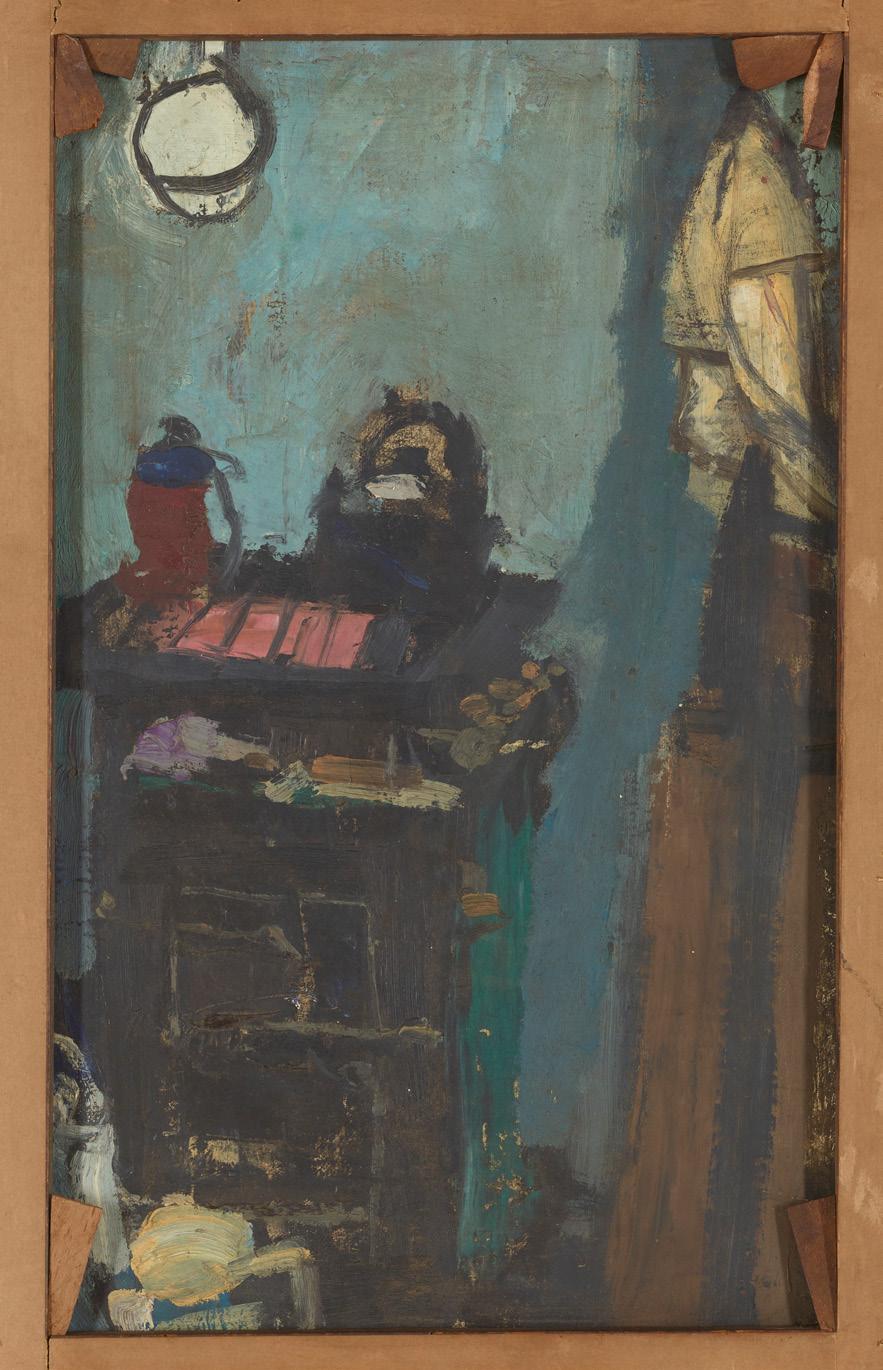
FOOTSTEPS IN THE SNOW, THE ROW, CATTERLINE
Signed, oil on canvas, with another painting of a ‘Kitchen with Stove’ verso
36cm x 53.5cm (14in x 21in)
Provenance: Given by the Artist to Mrs McLusky in 1963
Acquired from the above by McEwan Gallery, Ballater in 1980

Acquired from the above by Dr Mackenzie in 1980 and thence by family descent to the present owner
£15,000-20,000
148 Other fees apply in addition to the hammer price: see the ‘Buyer’s Guide’ section on page 2
169 §
JOAN EARDLEY R.S.A. (SCOTTISH 1921-1963)
TWO CHILDREN
Pastel on brown paper
25.5cm x 20cm (10in x 8in)
Exhibited: Royal Scottish Academy, Edinburgh, Joan Eardley, 6 November 2007-13 January 2008
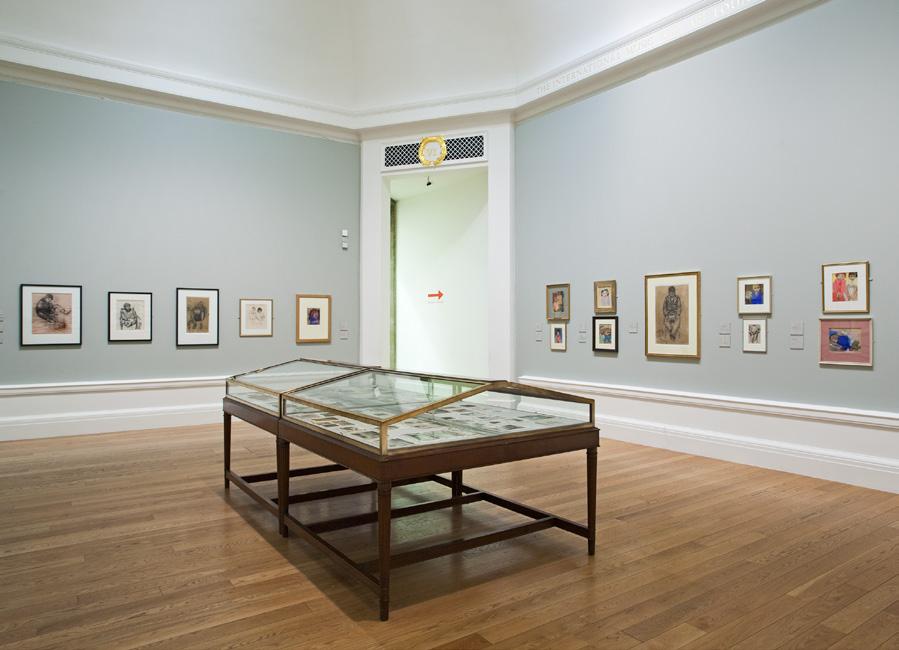
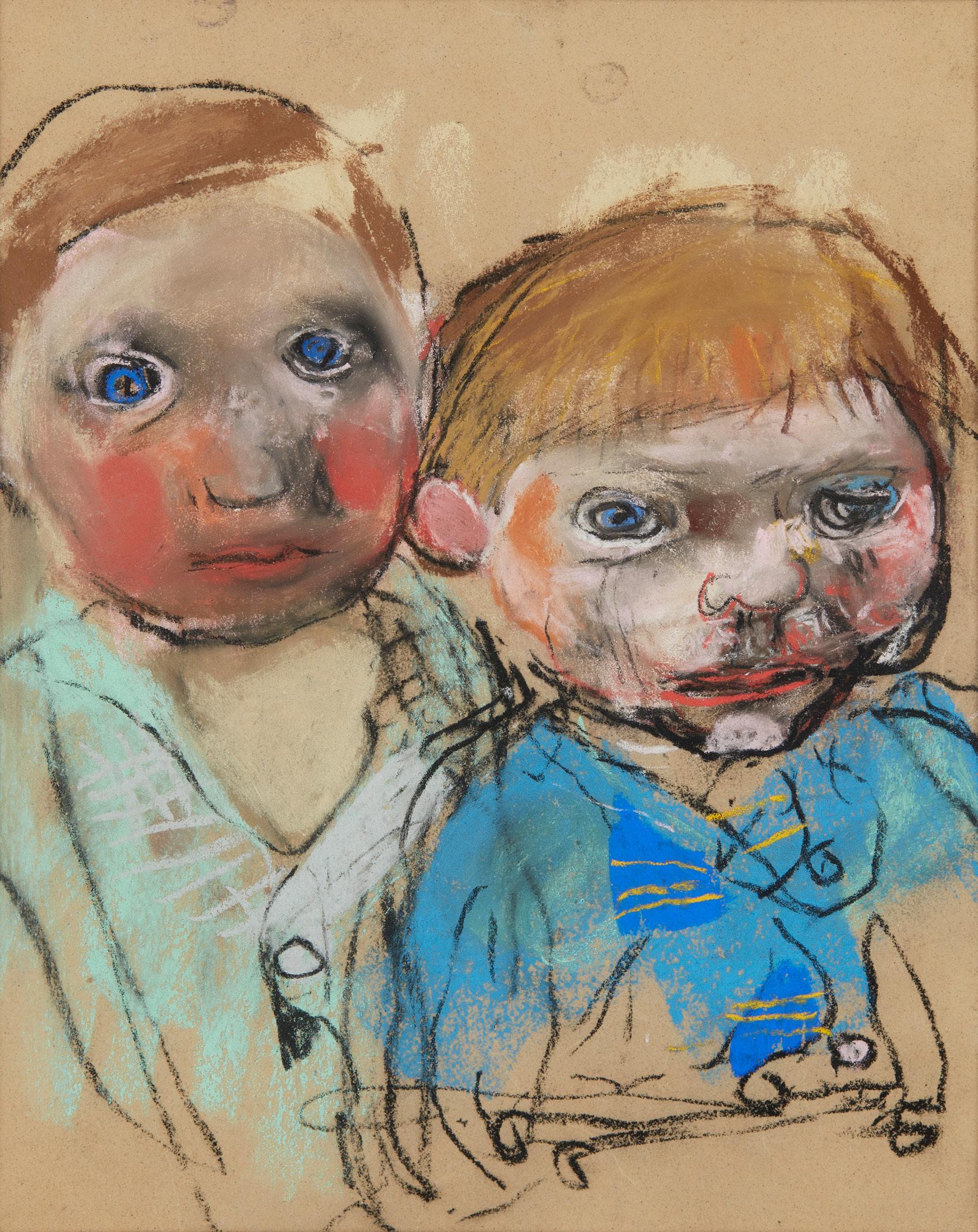
£20,000-30,000
Two Children in the National Galleries of Scotland Joan Eardley exhibition, Royal Scottish Academy, Edinburgh, 2007-08 (right-hand wall, left-hand quartet, lower right) © Antonia Reeve
149
170 §
JOAN EARDLEY R.S.A. (SCOTTISH 1921-1963)
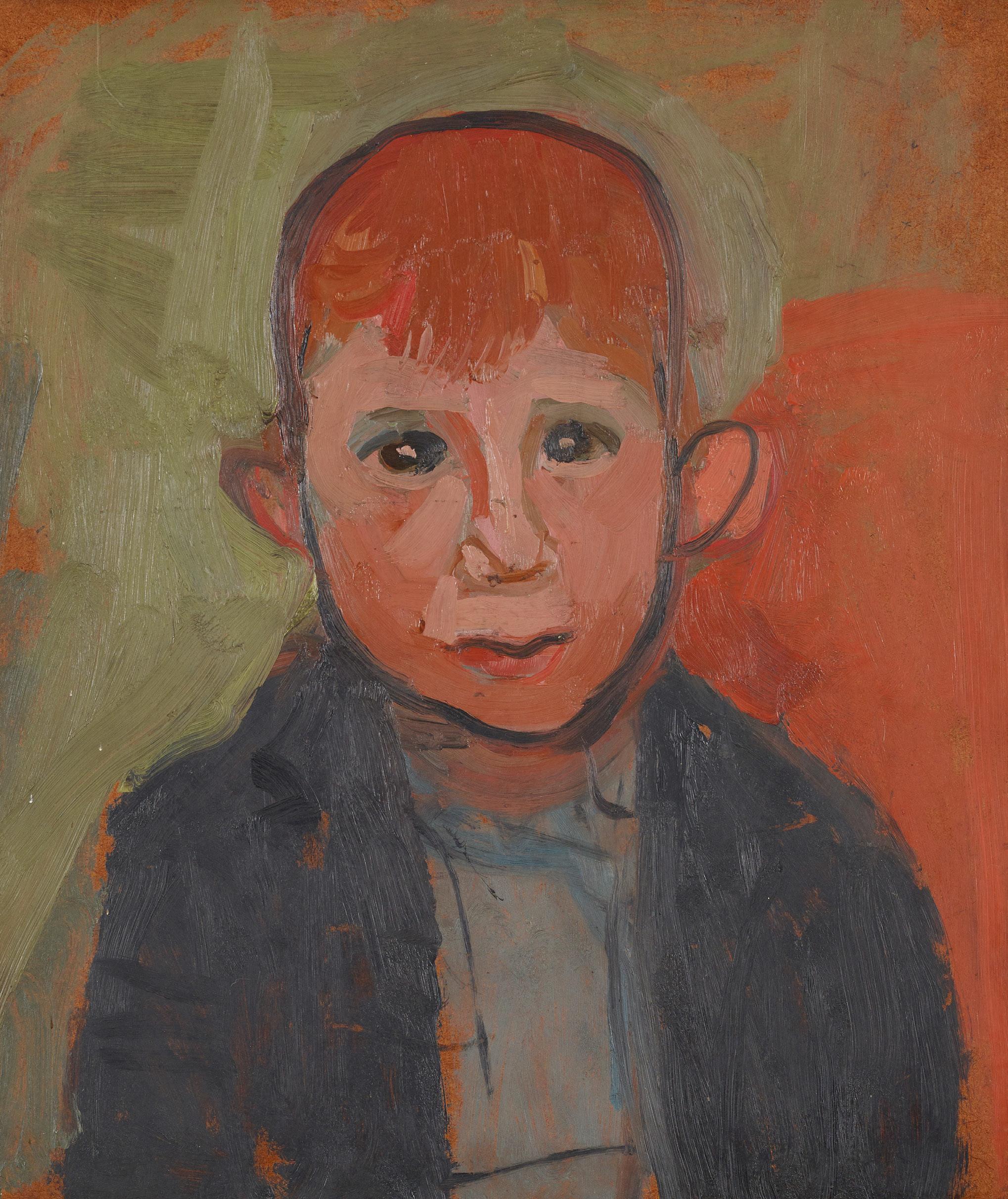
GINGER
With the Artist’s Estate Inventory Number EE30 verso, oil on board 43cm x 37cm (17in x 14.5in)
Provenance: Roland, Browse and Delbanco, London £15,000-20,000
150 Other fees apply in addition to the hammer price: see the ‘Buyer’s Guide’ section on page 2
171 §
JOAN EARDLEY R.S.A. (SCOTTISH 1921-1963)
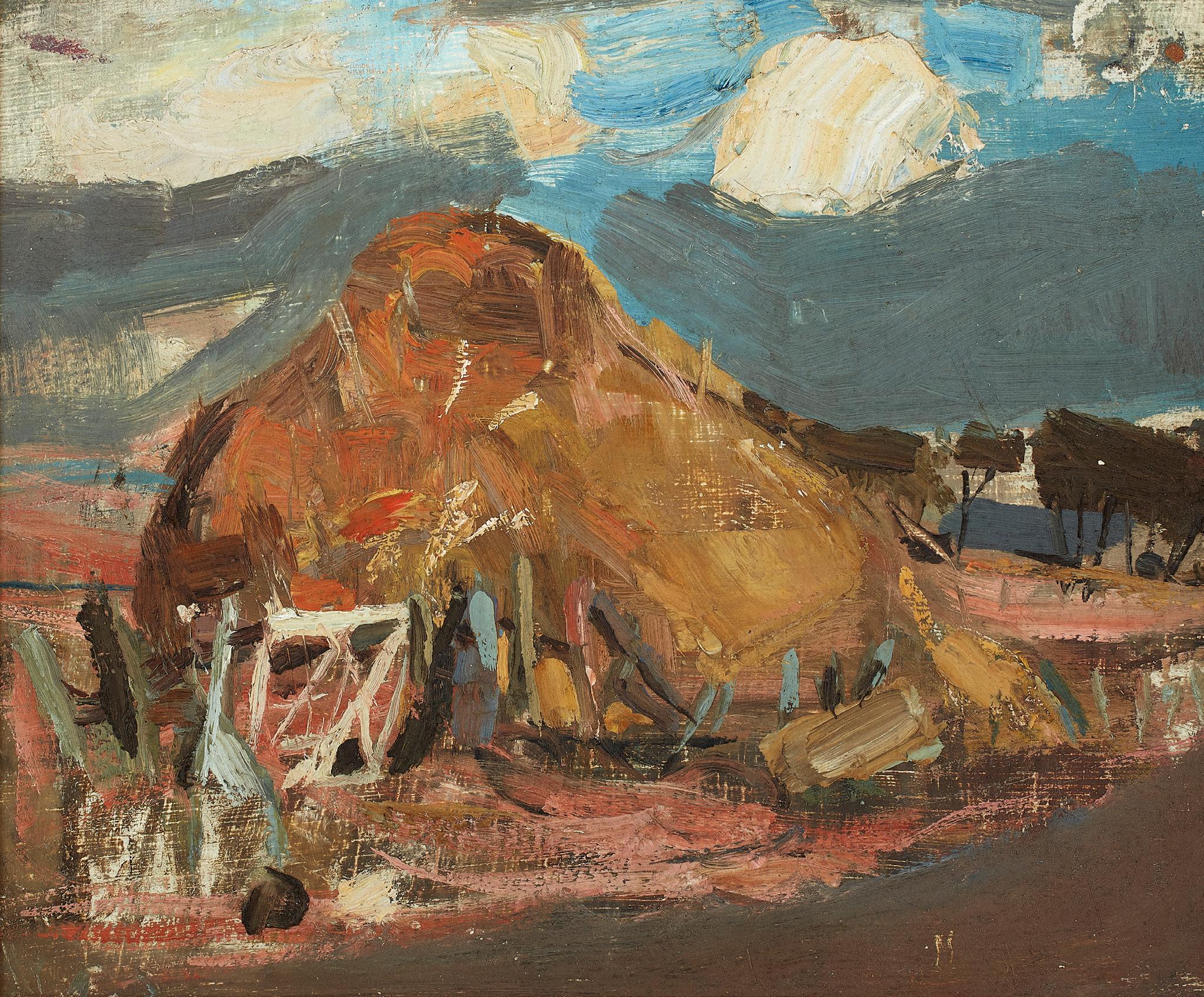
HAYSTACK AND GATE
With the Artist’s Estate Inventory Number EE239 verso, oil on board 19cm x 23cm (7.5in x 9in)
Exhibited: Cyril Gerber Fine Art, Glasgow, March 1985, no.15
£7,000-10,000
151
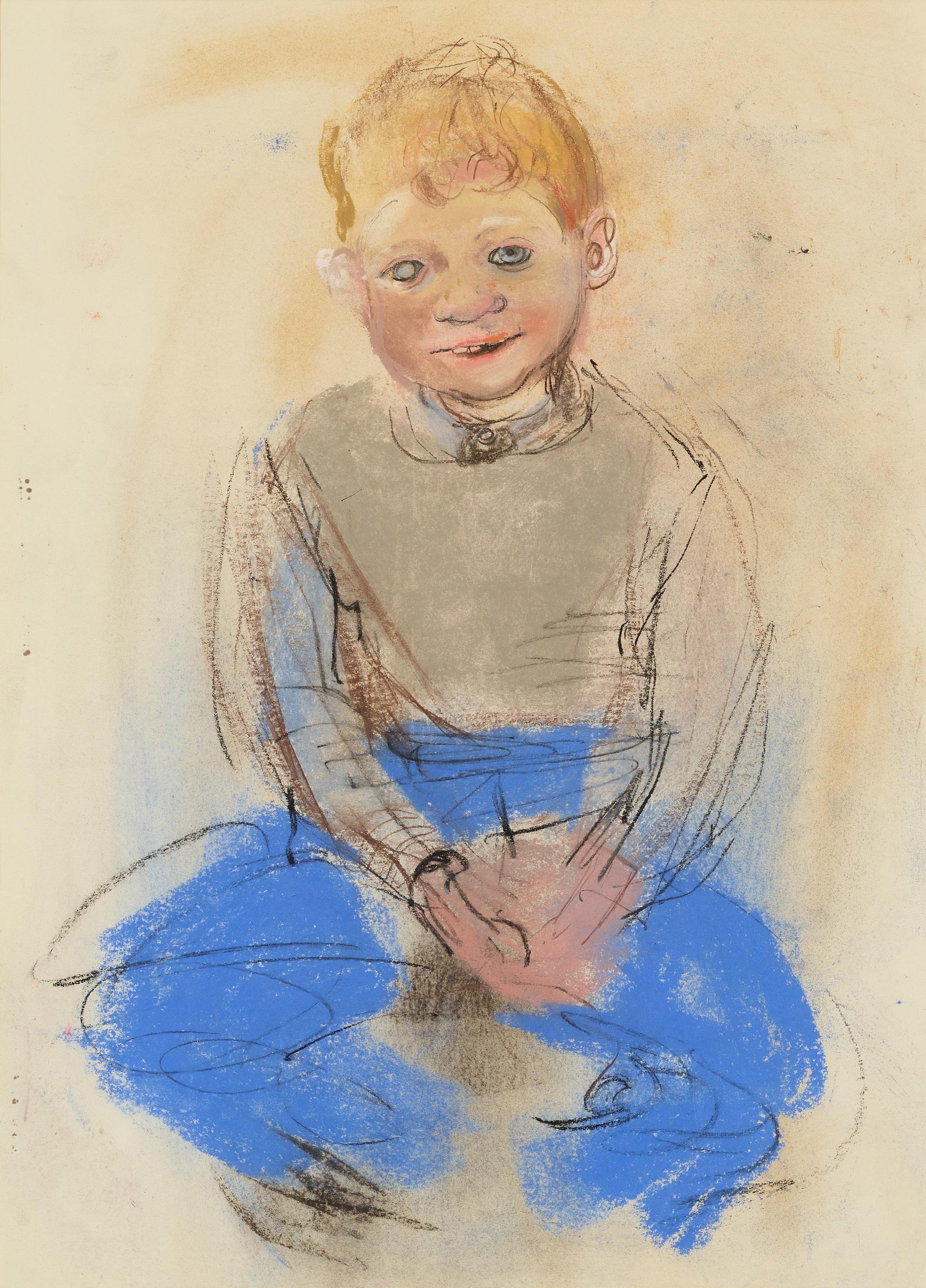
152 Other fees apply in addition to the hammer price: see the ‘Buyer’s Guide’ section on page 2
JOAN EARDLEY R.S.A. (SCOTTISH 1921-1963)
BOY WITH BLUE TROUSERS
Pastel
45cm x 33cm (17.75in x 13in)
Provenance: William ‘Bill’ Macaulay and thence by descent Private Collection, USA
Exhibited: The Scottish Gallery, Joan Eardley in Context, 6 August-5 September 2015, no.16
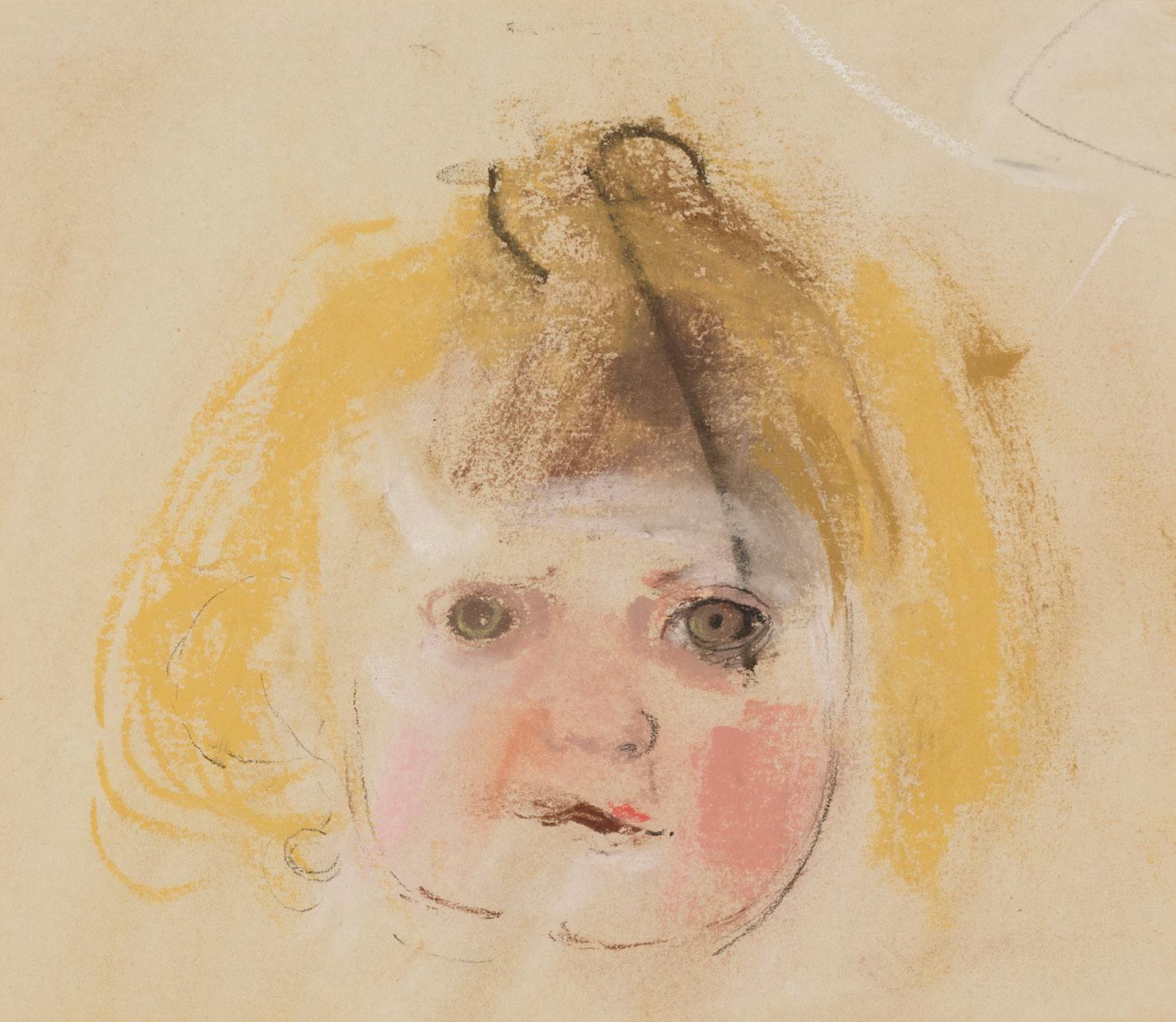
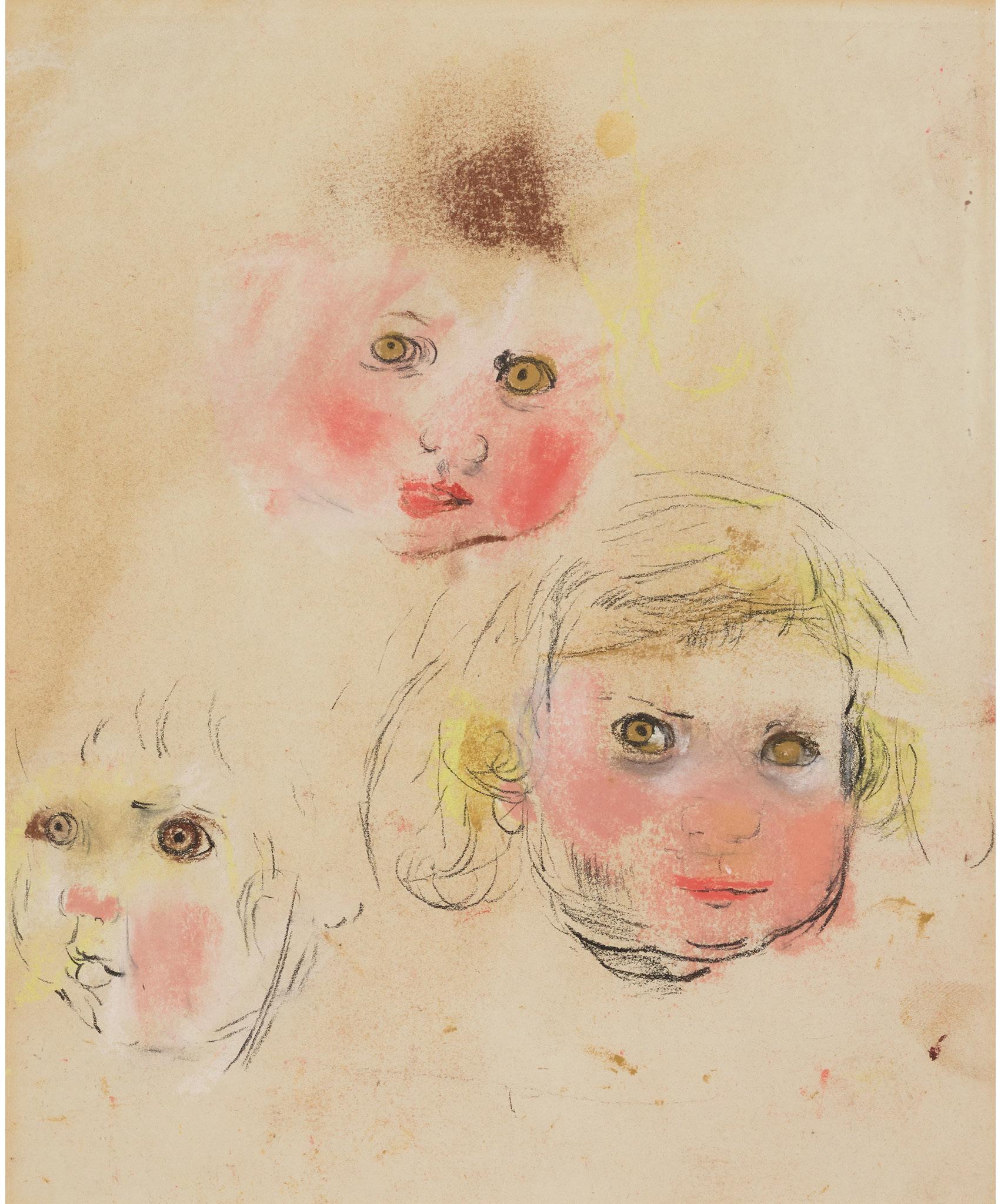
Note: This is a portrait of Martin Macaulay and is one of several studies of the five children of William ‘Bill’ Macaulay, Senior Partner of The Scottish Gallery, Edinburgh, which Eardley executed in 1960.
£10,000-15,000
JOAN EARDLEY R.S.A. (SCOTTISH 1921-1963)
PORTRAIT STUDY
Pastel on coloured paper
16cm x 18.5cm (6.25in x 7.25in) £3,000-5,000
174 §
JOAN EARDLEY R.S.A. (SCOTTISH 1921-1963)
STUDIES OF AMANDA
Pastel on coloured paper
25.5cm x 20.5cm (10in x 8in)
Exhibited: Mercury Gallery Ltd, Edinburgh
£6,000-8,000
§
172
153
173 §
175 § JOAN EARDLEY
R.S.A. (SCOTTISH 1921-1963)
FIR TREES PERTHSHIRE
Ink, watercolour and gouache
54cm x 71cm (21.25in x 28in)
Provenance: Acquired from The Scottish Gallery, Edinburgh in 2014 by the present owner
Exhibited: The Scottish Gallery, Edinburgh, Joan Eardley, January-February 1984, no. 7
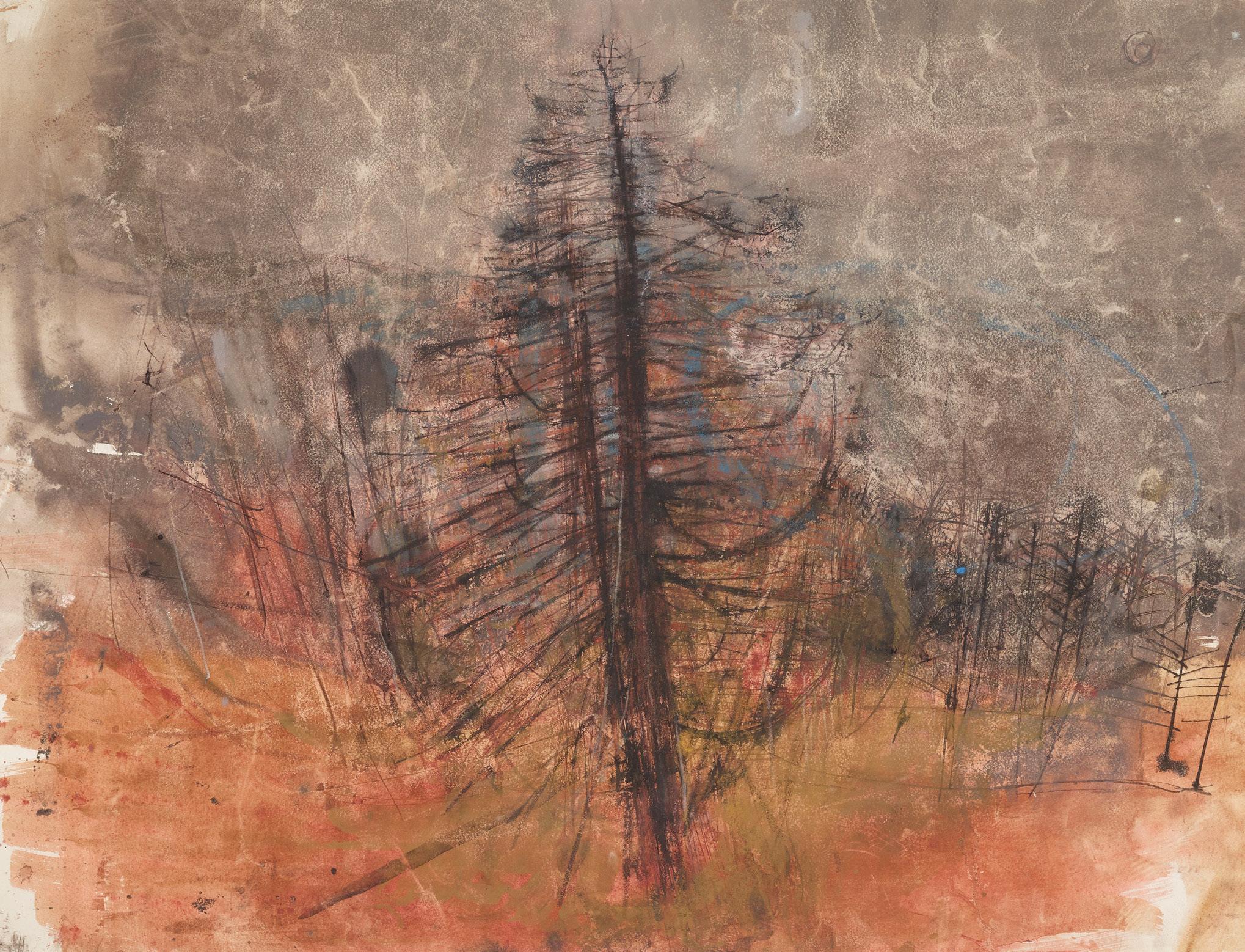
The Scottish Gallery, Edinburgh, Modern Masters 11, January-February 2014, no.13
£7,000-10,000
154
John Maclauchlan Milne painted In Tuscany during the Spring of 1930, when he stayed in the Hotel La Cisterna in San Gimignano. Dundee’s The Evening Telegraph reported on 17 April 1930 that ‘at present [Maclauchlan Milne] is working in the north of Italy’. He began to exhibit his Tuscan works the following year, including at the Royal Scottish Academy, with the Society of Scottish Artists and in his solo exhibition at The Independent Gallery in London in March 1931. This featured Spring-Time, San Gimignano, sold by Lyon & Turnbull on 28 November 2006, which resulted from the same Tuscan excursion. The Evening Telegraph reviewed the exhibition on 4 March 1931 stating: ‘Mr Milne spent a considerable time in Italy last year, instead of going, as he usually does, to Provence for the subjects of his landscapes and the result is one or two landscapes executed in North Italy which for composition and colour rank with the best works Mr Milne has produced.’
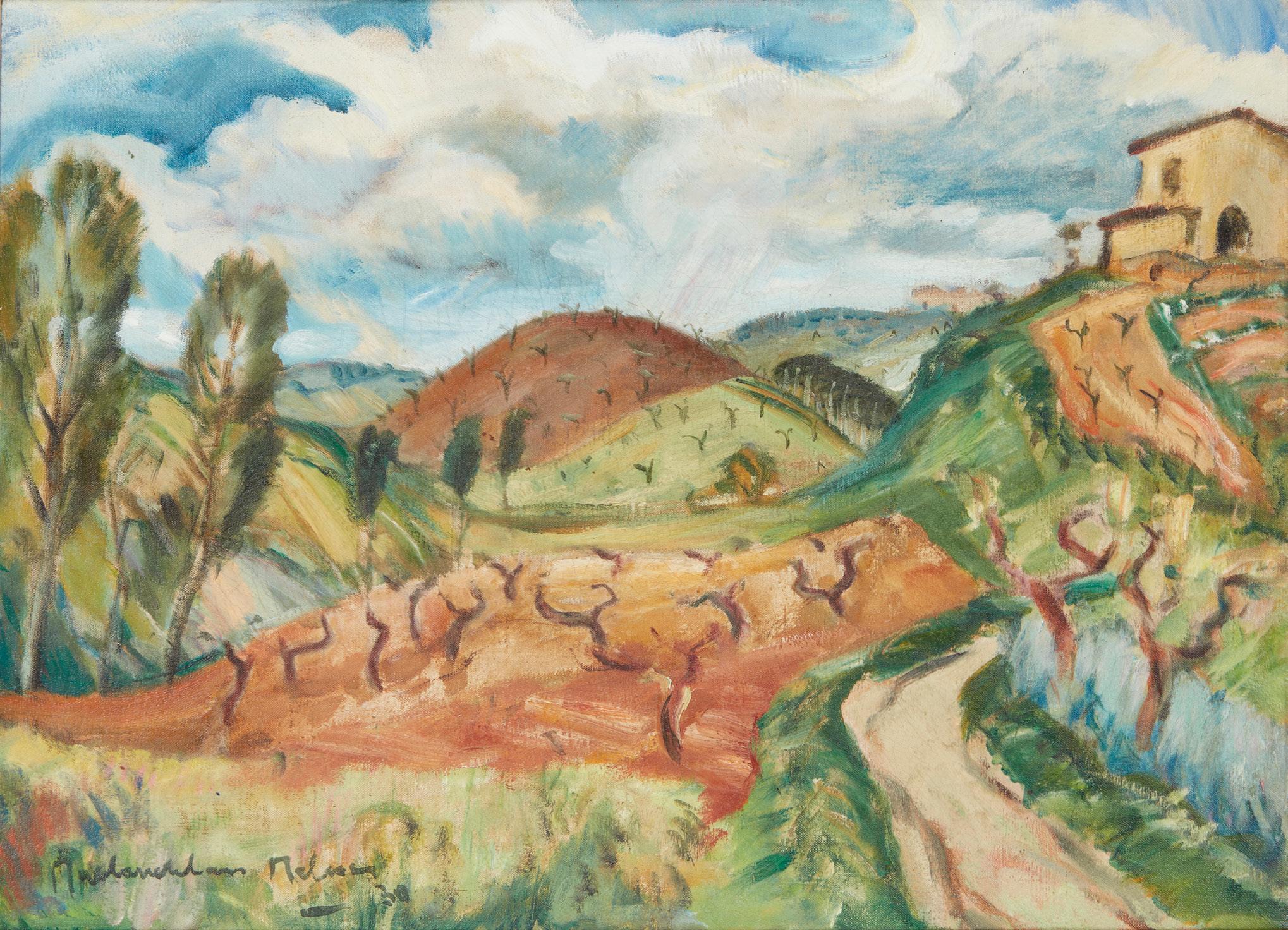
We are very grateful to Maurice N. Millar, author of ‘The Missing Colourist: The Search for John Maclauchlan Milne RSA’, for his research into this painting.
§ JOHN MACLAUCHLAN MILNE R.S.A. (SCOTTISH 1885-1957) IN TUSCANY
Signed and dated ‘30, oil on canvas 48cm x 61cm (18in x 24in)
Provenance: T. & R. Annan & Sons Ltd, Glasgow
Sotheby’s Gleneagles, Scottish & Sporting Pictures & Sculpture, 28 August 2002, lot 1092
John Green Fine Art, Glasgow from whom acquired by the present owner
Literature: Maurice N. Millar, The Missing Colourist: The Search for John Maclauchlan Milne RSA, privately published 2002, repr.col. p.85 £10,000-15,000
155 Other fees apply in addition to the hammer price: see the ‘Buyer’s Guide’ section on page 2
176
177 § JOHN CUNNINGHAM (SCOTTISH 1927-2000)

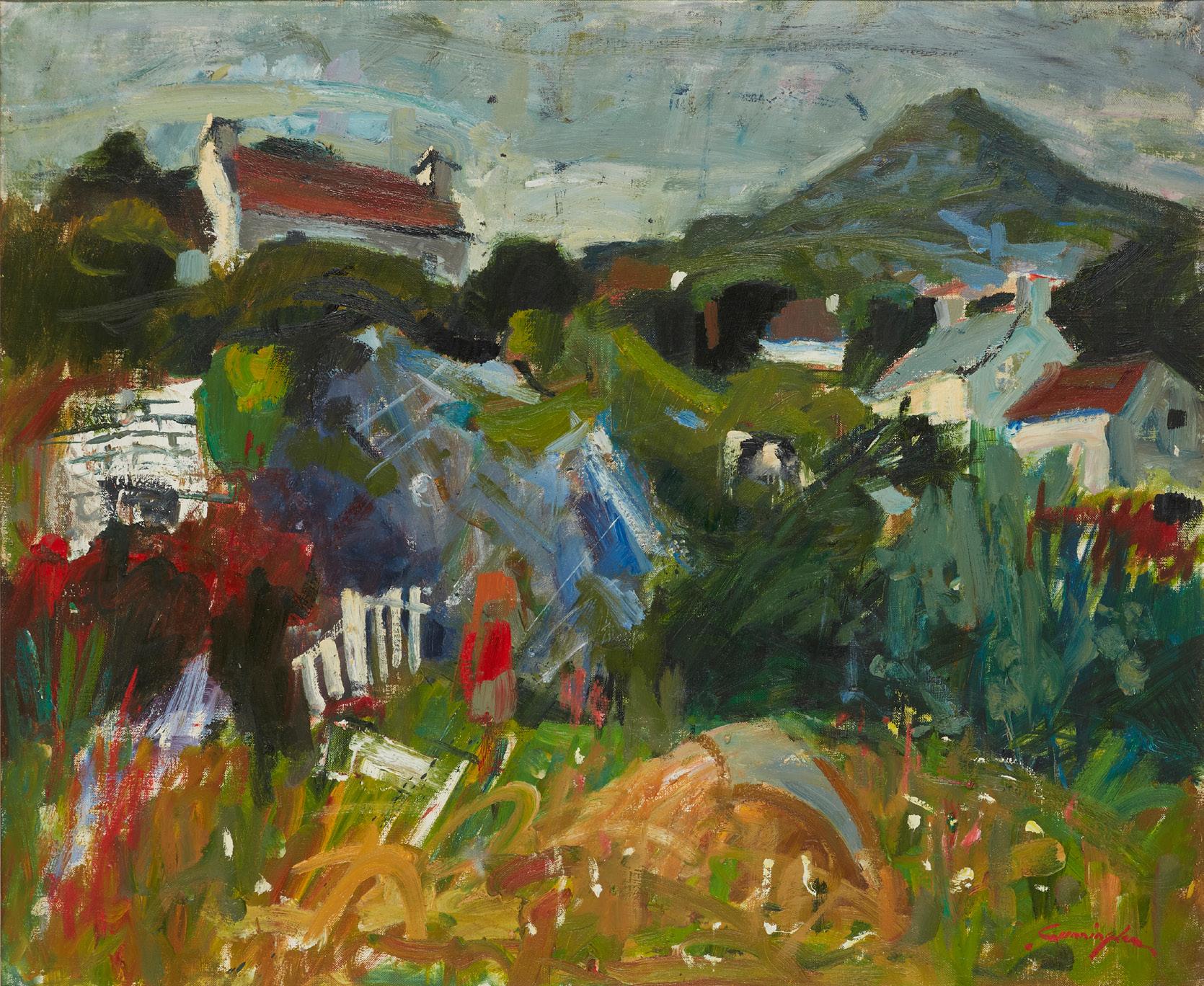
COLONSAY
Signed, oil on board
25.5cm x 51cm (10in x 20in)
£2,000-3,000
178 § JOHN CUNNINGHAM (SCOTTISH 1927-2000)
THE WHITE PICKET FENCE
Signed lower right, oil on canvas
63.5cm x 76cm (25in x 30in)
£1,500-2,500
156 Other fees apply in addition to the hammer price: see the ‘Buyer’s Guide’ section on page 2
179 §
JOHN HOUSTON R.S.A., R.S.W., S.S.A. (SCOTTISH 1930-2008) POPPIES

Signed, oil on canvas
51cm x 41cm (20in x 16in)
£2,000-3,000

157
180 §
ALAN DAVIE C.B.E., R.A., H.R.S.A. (SCOTTISH 1920-2014)
MASK FOR THE PHANTOM OPUS 0.565M
Signed, inscribed and dated ‘Sept ‘65’ verso, oil on canvas
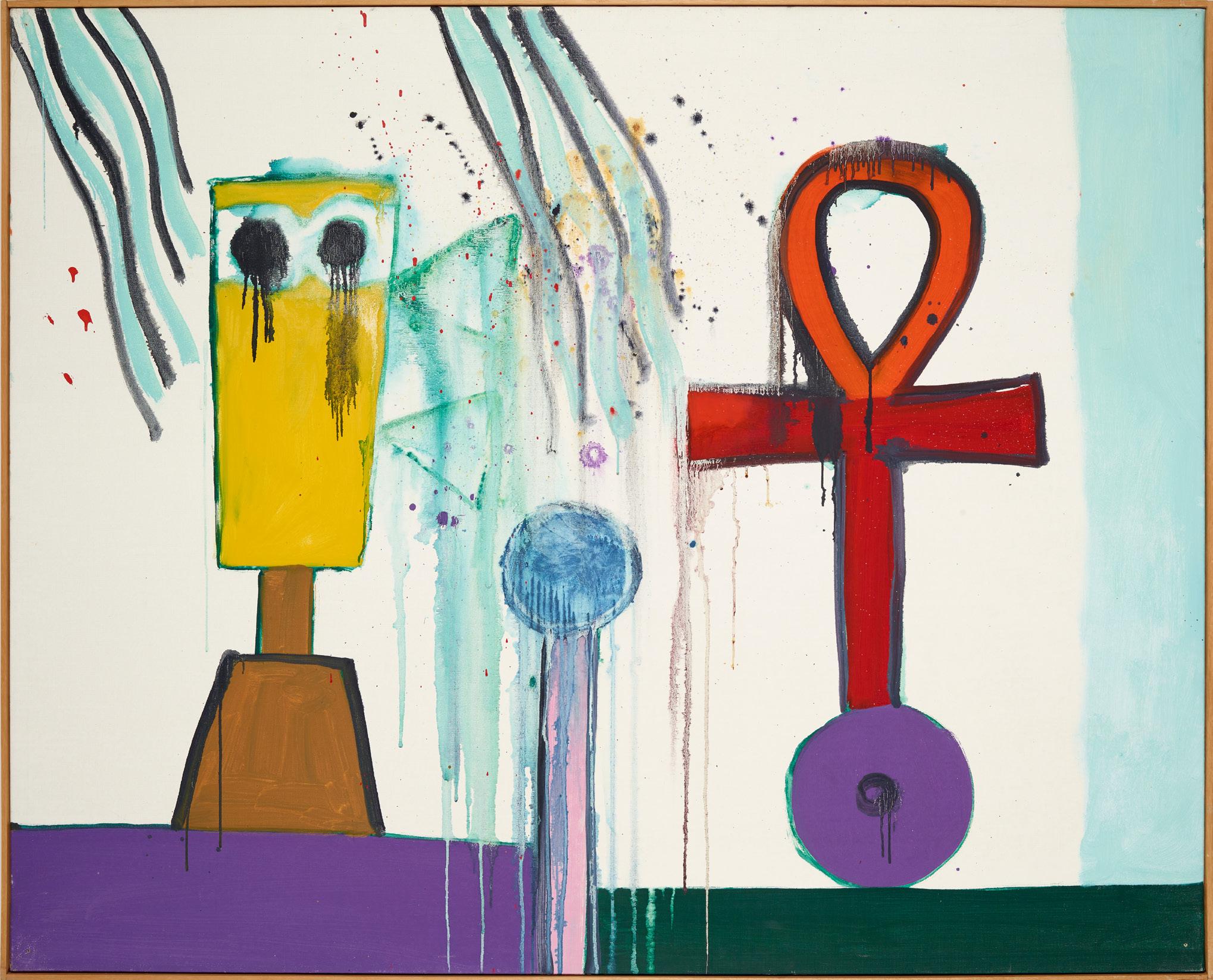
122cm x 152.5cm (40in x 60in)
Provenance: Gimpel Fils, London (GF10144)
£15,000-20,000
158 Other fees apply in addition to the hammer price: see the ‘Buyer’s Guide’ section on page 2
INDEX OF ARTISTS
Adam, Joseph Denovan 111, 112
Adam, Patrick William 126
Allan, Robert Weir 30
Alison, Henry Young 123
Armour, Mary Nicol Neill 86
Bain, Donald 88
Black, Andrew 7
Bough, Sam 11, 108
Breanski Senior, Alfred De 63, 120
Bromley Blacklock, Thomas 54
Brough, Robert 132, 133
Cadell, Francis Campbell Boileau 153, 155, 157, 158, 159
Cameron, Sir David Young 46, 47, 66
Cassie, James 19
Cordiner, Charles 28
Coventry, Robert McGown 9
Cowie, James 78, 147
Cranstoun, James Hall 18
Crawhall, Joseph 80
Cunningham, John 90, 177, 178
Cursiter, Stanley 134
Davie, Alan 180
Docharty, Alexander Brownlie 65
Donald, John Milne 27
Duncan, John 156
Eadie, Robert 32
Eardley, Joan 163, 164, 165, 166, 167, 168, 169, 170, 171, 172, 173, 174, 175
Faed, John 105
Farquharson, David 121, 122
Farquharson, Joseph 119
Fergusson, Christian Jane 79
Fergusson, John Duncan 148, 149, 150, 151
Fleming, Ian 144
Flint, Sir William Russell 59, 60, 61, 62
Frazer, William Miller 25
Fulton, David 51, 97
Gauld, David 38, 69, 95, 116, 127
Gavin, Robert 124
Gibson, William Alfred 92
Giles, James 40
Hardie, Charles Martin 12
Henderson, Joseph 20, 113, 114, 115
Henderson, Joseph Morris 67
Henry, George 8
Herald, James Watterston 31, 77, 152
Horlor, George William 109
Hornel, Edward Atkinson 35
Houston, George 1, 6, 41, 50, 70, 71, 94
Houston, John 89, 179
Hunter, Colin 72
Hunter, George Leslie 84
Hutchison, Robert Gemmell 21, 43, 44, 53, 98, 135, 136
Hutchison, William Oliphant 125
Keppie, John 45
Knox, John 99
Lamond, William Bradley 2
Macaulay Stevenson, Robert 117
Mackie, Charles Hodge 52
McBey, James 137, 138, 139, 140, 141, 142, 143
McCance, William 131
McCulloch, Horatio 68, 101
McGhie, John 3, 15
McGregor, Robert 42
GLOSSARY OF CATALOGUING TERMS
The following expressions with their accompanying explanations are used by Lyon & Turnbull as standard cataloguing practice.
Our use of these expressions does not take account of the condition of the lot or the extent of any restoration.
Buyers are recommended to to inspect the property themselves. Written condition reports are usually available on request.
Dimensions are given height before width.

Names or Recognised Designation of an Artist without any Qualification
In our opinion a work by the artist
Attributed to…
In our opinion probably a work by the artist in whole or in part
Studio of… / Workshop of…
In our opinion a work executed in the studio or workshop of the artist, possibly under their supervision
McTaggart, William 22
Michie, David 83
Milne, John Maclauchlan 57, 176
Mitchell, John Campbell 5
Morrison, James 91
Morrocco, Alberto 146
Morrocco, Leon 87
Mouncey, William 17
Murray, John Reid 37
Nasmyth, Alexander 106, 107
Noble, James Campbell 16, 93
Noble, John Sargeant 110
Park, Stuart 13, 33, 34
Paterson, James 58, 75, 76, 118
Paton, Waller Hugh 49
Patrick, James McIntosh 23, 24, 56, 96
Peploe, Samuel John 154, 160
Redpath, Anne 85, 161, 162
Reid, Archibald David 36
Robertson, Eric Harald Macbeth 128, 129, 130
Scott, Tom 48, 55
Smellie, John 82
Smith, George 64
Steell, Gourlay 104
Sticks, George Blackie 29
Stuart, Charles 26
Taylor, Ernest Archibald 81
Thomson Of Duddingston, Rev. John 100
Walton, Edward Arthur 14, 145
Watson , William 39
Wells, William Page Atkinson 73, 74
Wilkie, Sir David 102, 103
Wright, James 4
Wright, Margaret Isobel 10
Circle of…
In our opinion work of the period of the artist and showing their influence
Follower of…
In our opinion a work executed in the artist’s style, but not necessarily by a pupil
Manner of…
In our opinion a work executed in the artist’s style but of a later date
Signed… / Dated… / Inscribed… /
In our opinion the work has been signed/dated/inscribed by the artist Bears Signature… / Date… / Inscription… /
In our opinion the signature/ date/inscription appears to be by a hand other than that of the artist
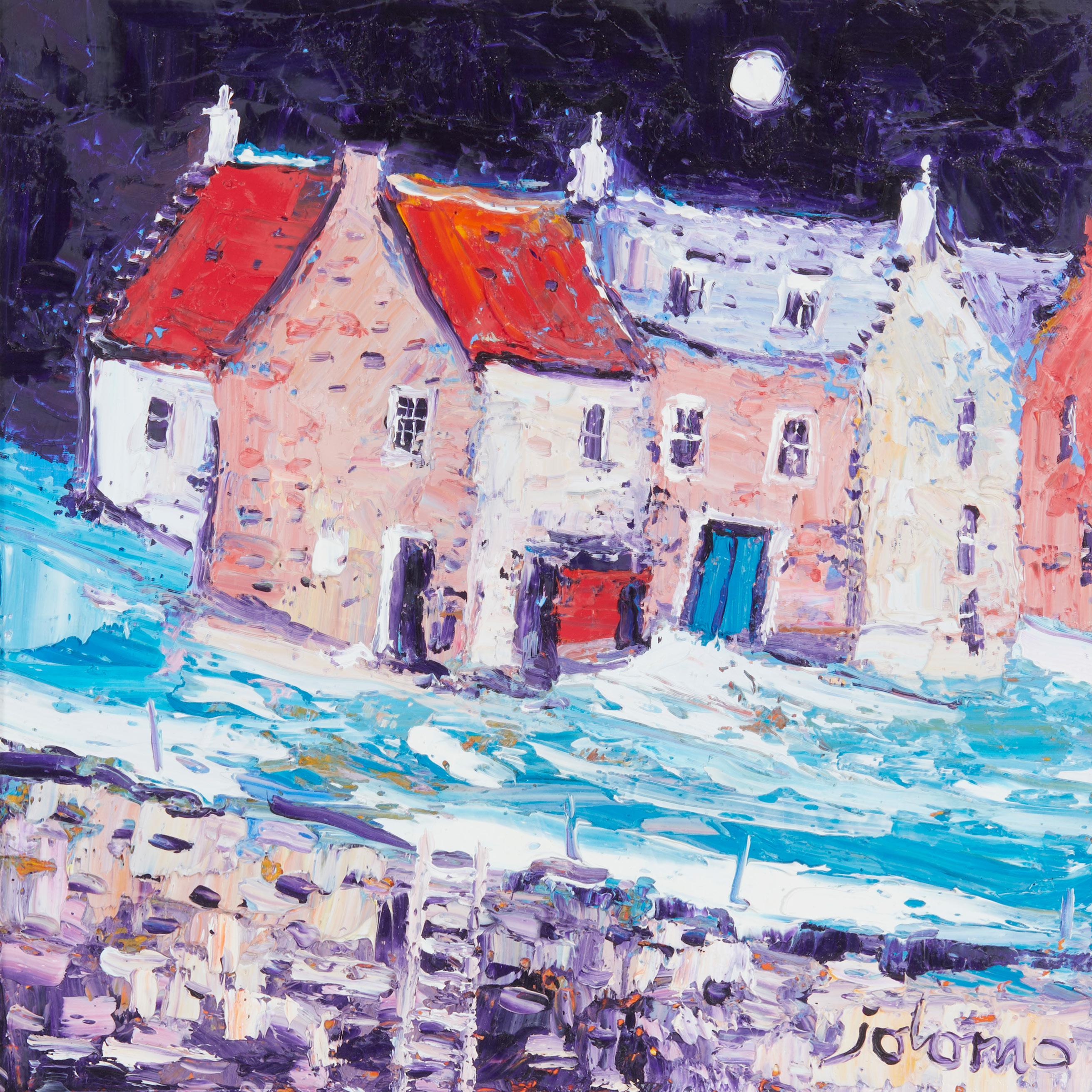
PAINTINGS & WORKS ON PAPER AUCTION 28 JUNE LIVE ONLINE For more information please contact Chantal de Prez | 0131 557 8844 chantal.deprez@lyonandturnbull.com JOHN LOWRIE MORRISON (JOLOMO) O.B.E. (SCOTTISH 1948-) CRAIL MOON - 2010 Signed lower right, oil on canvas 24cm x 24cm (9.5in x 9.5in) £1,200-1,800

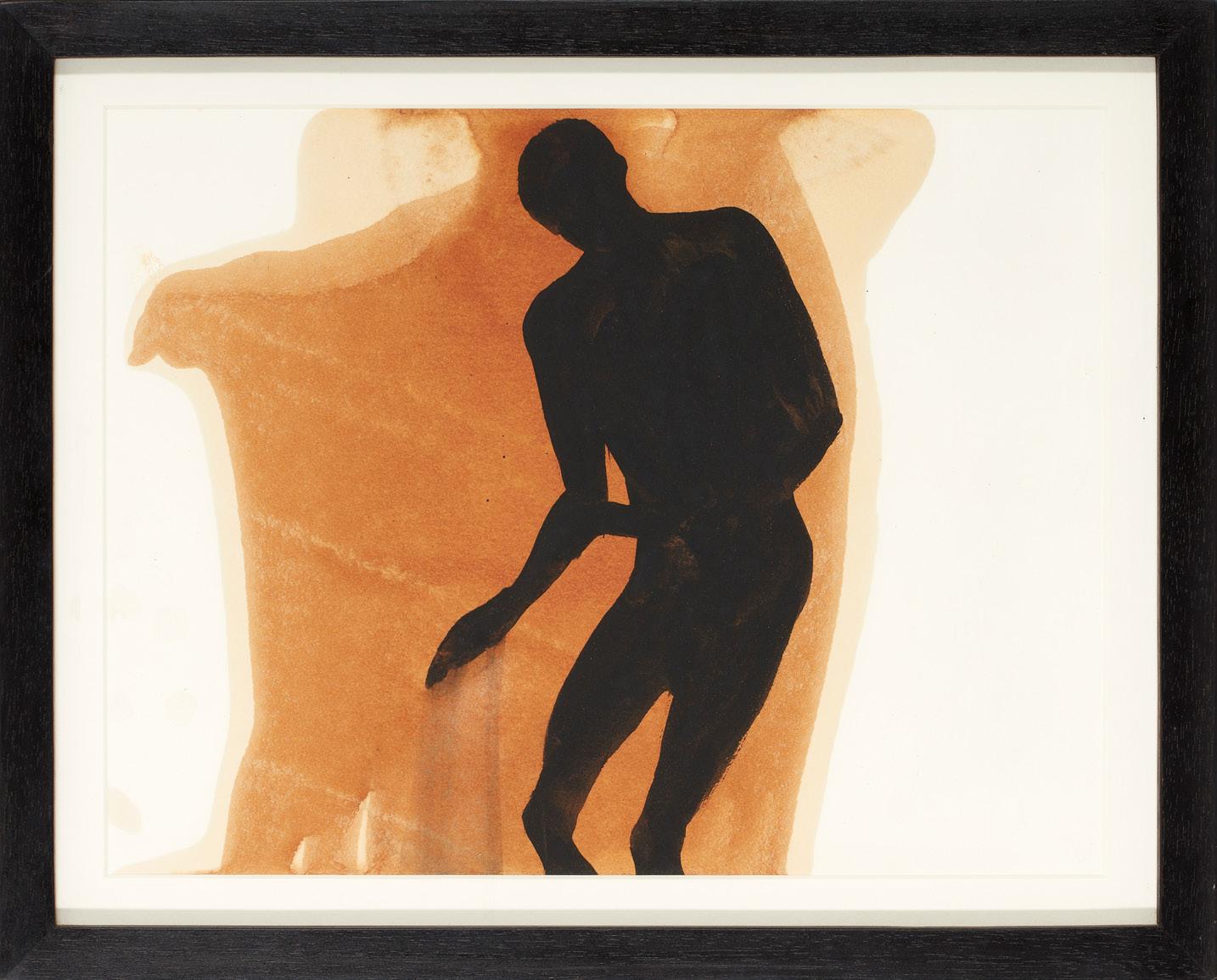
AUCTION 16 AUGUST | LIVE IN EDINBURGH & ONLINE | OPEN FOR CONSIGNMENTS For more information please contact Carly Shearer | 0131 557 8844 carly.shearer@lyonandturnbull.com
ANTONY GORMLEY O.B.E., R.A. (BRITISH 1950-)
(MALE FORM) Watercolour 28cm x 36.75cm (11in x 14.5in) £6,000-8,000
SIR
UNTITLED
SAM
(AMERICAN 1984 - ) UNTITLED (VENICE RAIN, ROPE 6) 2013

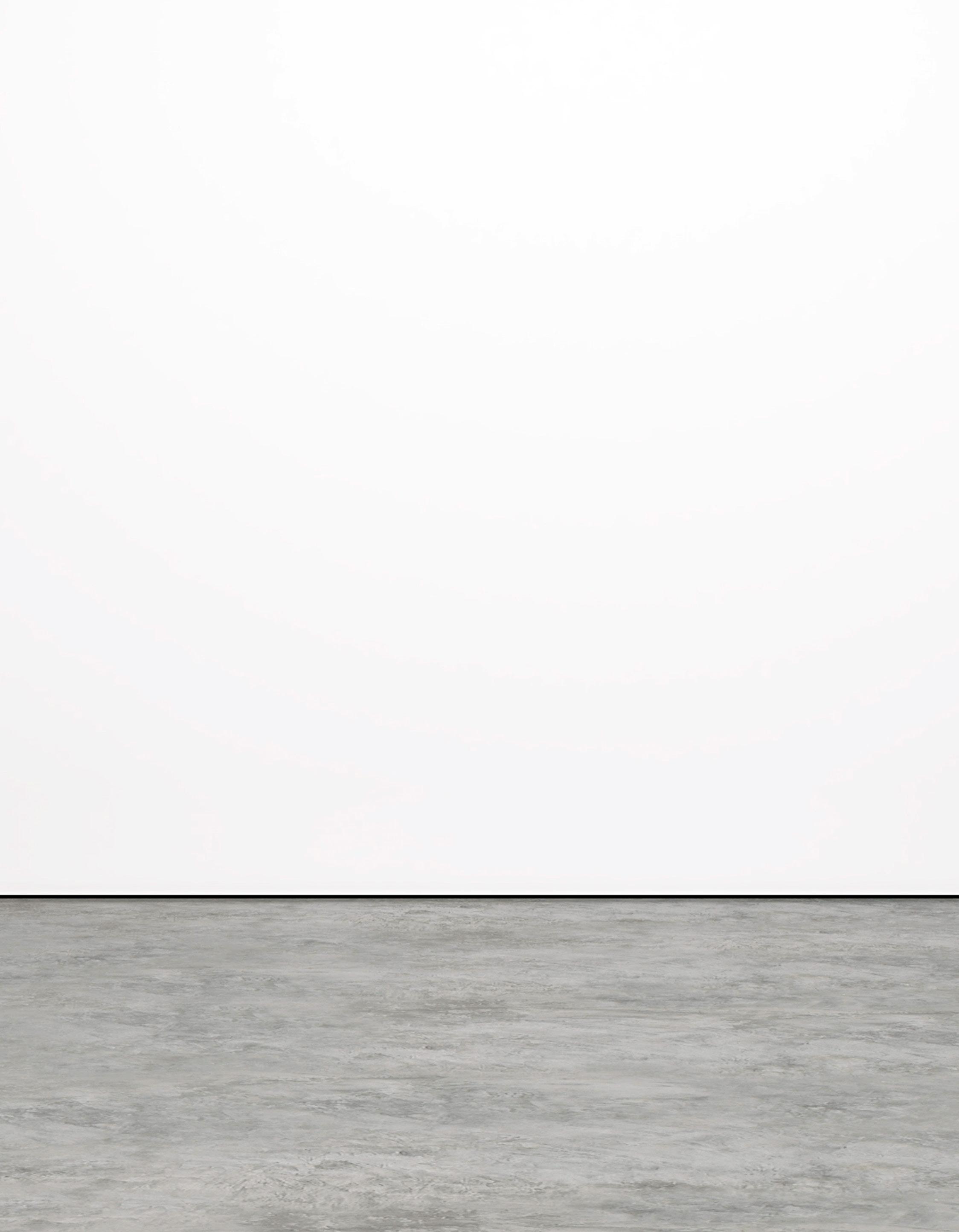
Fabric dye on rope and canvas
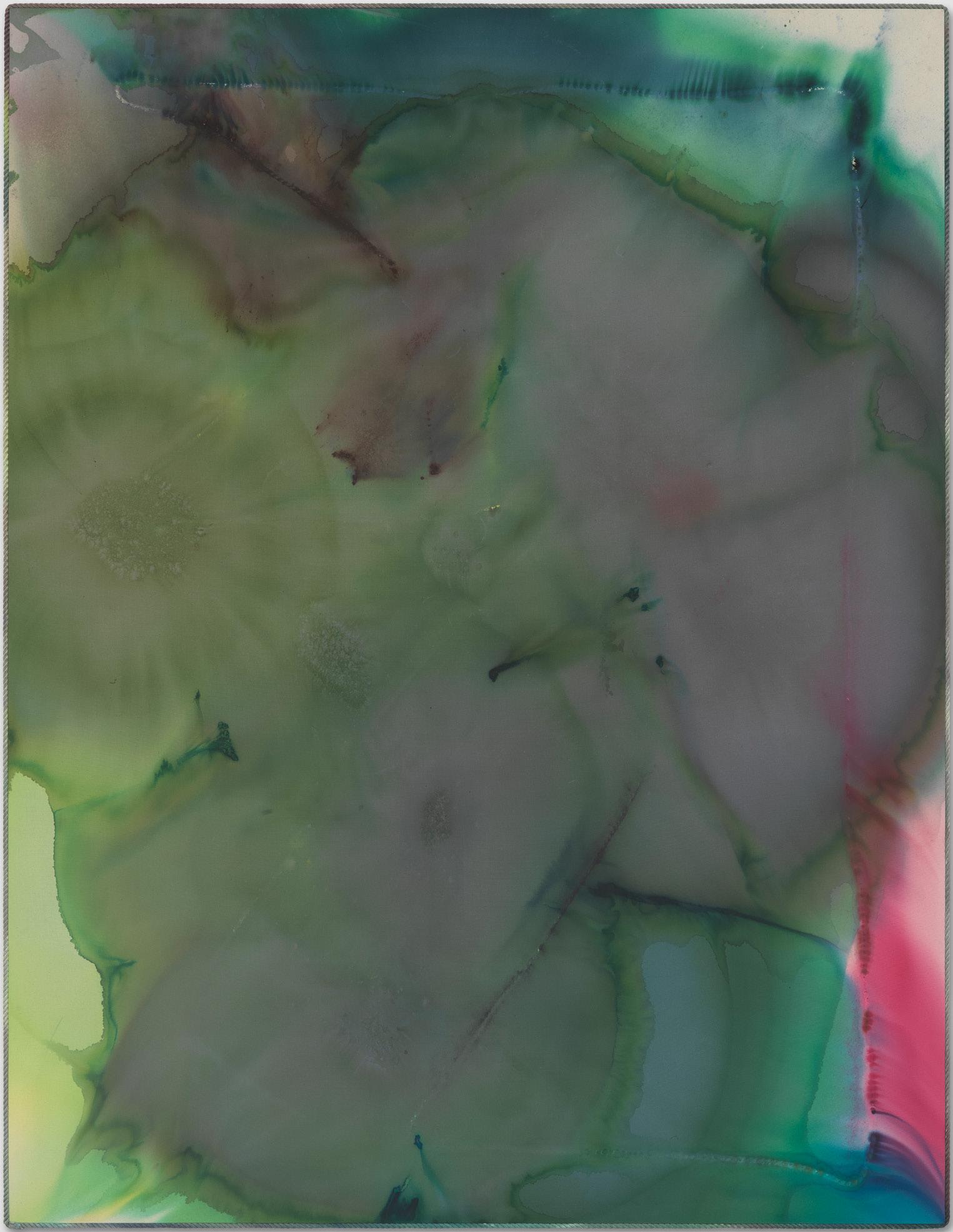
276.9cm x 208.3cm
(109in x 82in)
£7,000-10,000 + fees
ART FROM 1890 TO NOW For more information please contact Simon Hucker | 0207 930 9115 simon.hucker@lyonandturnbull.com AUCTION 26 OCTOBER 2023 MALL GALLERIES, LONDON & LIVE ONLINE OPEN FOR CONSIGNMENTS
FALLS
MODERN & POST-WAR ART, DESIGN & STUDIO CERAMICS
AUCTION 27 OCTOBER 2023
MALL GALLERIES, LONDON & LIVE ONLINE
OPEN FOR CONSIGNMENTS
For more information please contact Philip Smith | 0207 930 9115 philip.smith@lyonandturnbull.com
bronze mounted on a slate base 80.5cm high, 89cm wide (31 3/4in high, 35in wide)
Sold for £22,680 (inc fees) 28 April 2023
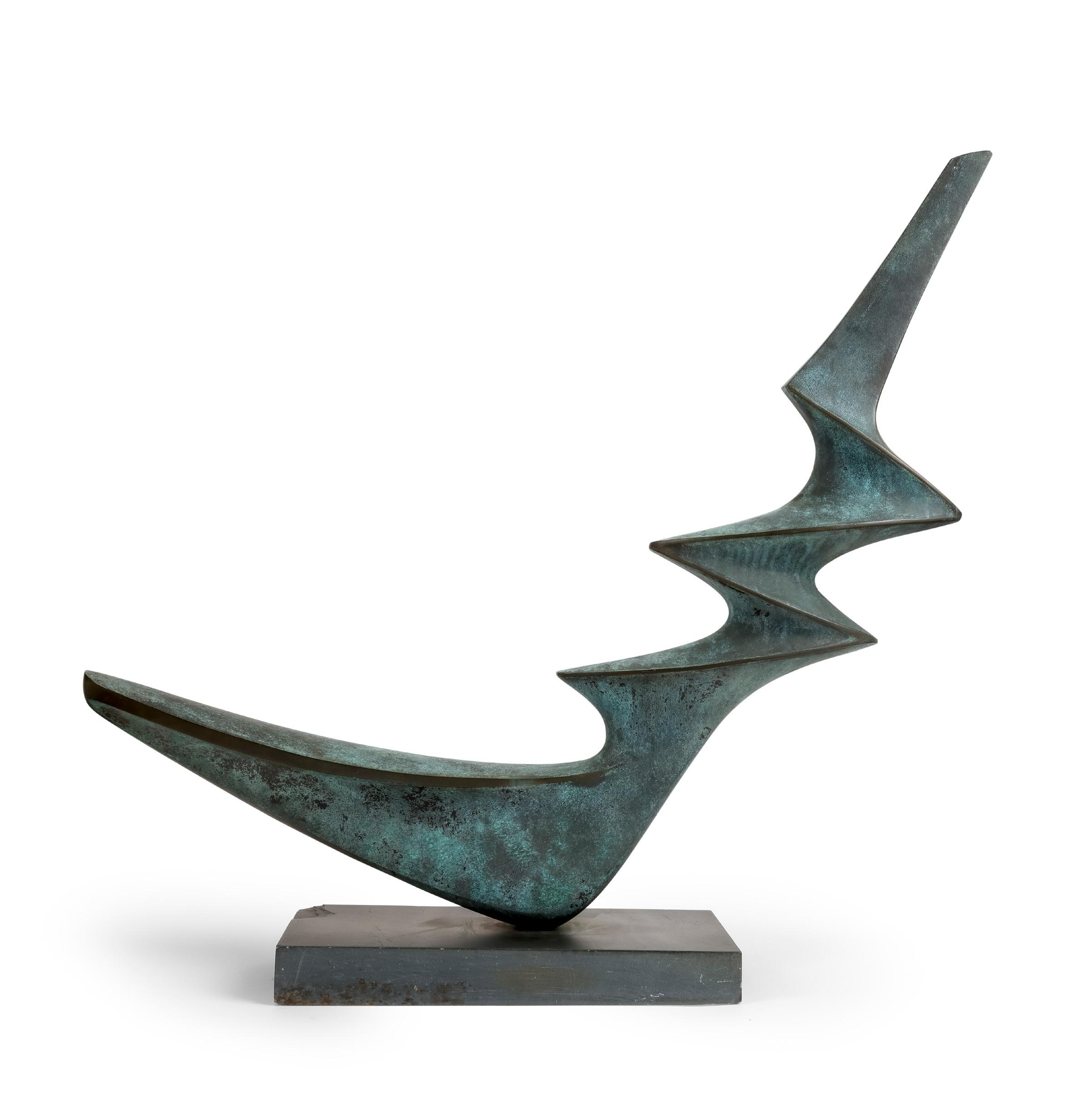 DENIS MITCHELL (BRITISH 1912-1993) PROBUS, 1971
DENIS MITCHELL (BRITISH 1912-1993) PROBUS, 1971
CONDITIONS OF SALE
FOR BUYERS (UK)
These Conditions of Sale and the Saleroom Notices as well as specific Catalogue terms, set out the terms on which we offer the Lots listed in this Catalogue for sale. By registering to bid and/or by bidding at auction You agree to these terms, we recommend that You read them carefully before doing so. You will find a list of definitions and a glossary at the end providing explanations for the meanings of the words and expressions used. Special terms may be used in Catalogue descriptions of particular classes of items (Books, Jewellery, Paintings, Guns, Firearms, etc.) in which case the descriptions must be interpreted in accordance with any glossary appearing in the Catalogue. These notices and terms will also form part of our terms and conditions of sales.
In these Conditions the words “Us”, “Our”, “We” etc. refers to Lyon & Turnbull Ltd, the singular includes the plural and vice versa as appropriate. “You”, “Your” means the Buyer. Lyon & Turnbull Ltd. acts as agent for the Seller. Lyon & Turnbull Ltd. acts as agent for the Seller. On occasion where Lyon & Turnbull Ltd. own a lot in part or full the property will be identified in the catalogue with the symbol (��) next to its lot number.
A. BEFORE THE SALE 1. DESCRIPTIONS OF LOTS
Whilst we seek to describe Lots accurately, it may be impractical for us to carry out exhaustive due diligence on each Lot. Prospective Buyers are given ample opportunities to view and inspect before any sale and they (and any independent experts on their behalf) must satisfy themselves as to the accuracy of any description applied to a Lot. Prospective Buyers also bid on the understanding that, inevitably, representations or statements by us as to authorship, genuineness, origin, date, age, provenance, condition or Estimated selling price involve matters of opinion. We undertake that any such opinion shall be honestly and reasonably held and only accept liability for opinions given negligently or fraudulently. Subject to the foregoing neither we the Auctioneer or our employees or agents accept liability for the correctness of such opinions and no warranties, whether relating to description, condition or quality of Lots, express, implied or statutory, are given. Please note that photographs/ images provided may not be fully representative of the condition of the Lot and should not be relied upon as indicative of the overall condition of the Lot. All dimensions and weights are approximate only.
2. OUR RESPONSIBILITY FOR OUR DESCRIPTION OF LOTS
We do not provide any guarantee in relation to the nature of a Lot apart from our authenticity warranty contained in paragraph E.2 and to the extent provided below.
(a) Condition Reports: Condition Reports are provided on our Website or upon request. The absence of a report does not imply that a Lot is without imperfections. Large numbers of such requests are received shortly before each sale and department specialists and administration will endeavour to respond to all requests although we offer no guarantee. Any statement in relation to the Lot is merely an expression of opinion of the Seller or us and should not be relied upon as an inducement to bid on the Lot. Lots are available for inspection prior to the sale and You are strongly advised to examine any Lot in which You are interested prior to the sale. Our Condition Reports are not prepared by professional conservators, restorers or engineers. Our Condition Report does not form any contract between us and the Buyer. The Condition Reports do not affect the Buyer’s obligations in any way.
(b) Estimates: Estimates are placed on each Lot to help Buyers gauge the sums involved for the purchase of a particular Lot. Estimates do not include the Buyer’s Premium or VAT. Estimates are a matter of opinion and prepared in advance. Estimates may be subject to change and are for guidance only and should not be relied upon.
(c) Catalogue Alterations: Lot descriptions and Estimates are prepared in advance of the sale and may be subject to change. Any alterations will be announced on the Catalogue alteration sheet, made available prior to the sale. It is the responsibility of the Buyer to make themselves aware to any alterations which may have occurred.
3. WITHDRAWAL
Lyon & Turnbull may, at its discretion, withdraw any Lot at any time prior to or during the sale of the Lot. Lyon & Turnbull has no liability to You for any decision to withdraw.
4. JEWELLERY, CLOCKS & OTHER ITEMS
(a) Jewellery:
(i) Coloured gemstones (such as rubies, sapphires and emeralds) may have been treated to enhance their look, through methods such as heating and oiling. These methods are accepted practice but may make the gemstone less strong and/or require special care in future.
(ii) All types of gemstones may have been improved by some method. You may request a gemmological report for any Lot which does not have a report if the request is made to us at least
three weeks before the date of the sale and You pay the fee for the report in advance of receiving said report.
(iii) We do not obtain a gemmological report for every gemstone sold in our sales. Where we do get gemmological reports from internationally accepted gemmological laboratories, such reports may be described in the Sale Particulars. Reports will describe any improvement or treatment only if we request that they do so, but will confirm when no improvement or treatment has been made. Because of differences in approach and technology, laboratories may not agree whether a particular gemstone has been treated, the amount of treatment or whether treatment is permanent. The gemmological laboratories will only report on the improvements or treatments known to the laboratories at the date of the report.
(iv) For jewellery sales, all Estimates are based on the information in any gemmological report or, if no gemmological report is available, You should assume that the gemstones may have been treated or enhanced.
(b) Clocks & Watches: All Lots are sold “as seen”, and the absence of any reference to the condition of a clock or watch does not imply the Lot is in good condition and without defects, repairs or restorations. Most clocks and watches will have been repaired during their normal lifetime and may now incorporate additional/newer parts. Furthermore, we make no representation or warranty that any clock or watch is in working order. As clocks and watches often contain fine and complex mechanisms, Buyers should be aware that a general service, change of battery or further repair work, for which the Buyer is solely responsible, may be necessary. Buyers should also be aware that we cannot guarantee a watch will remain waterproof if the back is removed. Buyers should be aware that the importing watches such as Rolex, Frank Muller and Corum into the United States is highly restricted. These watches cannot be shipped to the USA and only imported personally. Clocks may be sold without pendulums, weights or keys.
(c) Alcohol: may only be sold to persons aged of 18 years and over. By registering to bid, You affirm that You are at least that age. All collections must be signed for by a person over the age of 18. We Reserve the right to ask for ID from the person collecting. Buyers of alcohol must make appropriate allowances for natural variations of ullages, conditions of corks and wine. We can provide no guarantees as to how the alcohol may have been stored. There is always a risk of cork failure and allowance by the Buyer must be made. Alcohol is sold “as is” and quality of the alcohol is entirely at the risk of the Buyer and no warranties are given.
(d) Books-Collation: If on collation any named item in the sale Catalogue proves defective, in text or illustration the Buyer may reject the Lot provided he returns it within 21 days of the sale stating the defect in writing. This, however, shall not apply in the case of unnamed items, periodicals, autographed letters, music M.M.S., maps, drawings nor in respect of damage to bindings, stains, foxing, marginal worm holes or other defects not affecting the completeness of the text nor in respect of Defects mentioned in the Catalogue, or at the time of sale, nor in respect of Lots sold for less than £300.
(e) Electrical Goods: are sold as “works of art” only and if bought for use must be checked over for compliance with safety regulations by a qualified electrician first. Use of such goods is entirely at the risk of the Buyer and no warranties as to safety of the goods are given.
(f) Upholstered items: are sold as “works of art” only and if bought for use must be checked over for compliance with safety regulations (items manufactured prior to 1950 are exempt from any regulations). Use of such goods is entirely at the risk of the Buyer and no warranties as to safety of the goods are given. We provide no guarantee as to the originality of any wood/material contained within the item.
B. REGISTERING TO BID
1. NEW BIDDERS
(a) If this is Your first time bidding at Lyon & Turnbull or You are a returning Bidder who has not bought anything from us within the last two years You must register at least 48 hours before an auction to give us enough time to process and approve Your registration. We may, at our discretion, decline to permit You to register as a Bidder. You will be asked for the following:
(i) Individuals: Photo identification (driving licence, national identity card or passport) and, if not shown on the ID document, proof of Your current address (for example, a current utility bill or bank statement)
(ii) Corporate clients: Your Certificate of Incorporation or equivalent document(s) showing Your name and registered address together with documentary proof of directors and beneficial owners, and;
(iii) Trusts, partnerships, offshore companies and other business structures please contact us directly in advance to discuss requirements.
(b) We may also ask You to provide a financial reference and/or a deposit to allow You to bid. For help, please contact our Finance Department on +44(0)131 557 8844.
2. RETURNING BIDDERS
We may at our discretion ask You for current identification as described in paragraph B.1.(a) above, a finance
164
22.3
reference or a deposit as a condition of allowing You to bid. If You have not bought anything from us in the last two years, or if You want to spend more than on previous occasions, please contact our Finance Department on +44(0)131 557 8844.
3. FAILURE TO PROVIDE THE RIGHT DOCUMENTS
If in our opinion You do not satisfy our Bidder identification and registration procedures including, but not limited to, completing any anti-money laundering and/or anti-terrorism financing checks we may require to our satisfaction, we may refuse to register You to bid, and if You make a successful bid, we may cancel the contract between You and the Seller.
4. BIDDING ON BEHALF OF ANOTHER PERSON
(a) As an authorised Bidder: If You are bidding on behalf of another person, that person will need to complete the registration requirements above before You can bid, and supply a signed letter authorising You to bid for him/ her.
(b) As agent for an undisclosed principal: If You are bidding as an agent for an undisclosed principle (the ultimate Buyer(s)) You accept personal liability to pay the Purchase Price and all other sums due, unless it has been agreed in writing with us before commencement of the auction that the Bidder is acting as an agent on behalf of a named third party acceptable to us and we will seek payment from the named third party.
5. BIDDING IN PERSON
If You wish to bid in the saleroom You must register for a numbered bidding paddle before You begin bidding. Please ensure You bring photo identification with You to allow us to verify Your registration.
6. BIDDING SERVICES
The bidding services described below are a free service offered as a convenience to our clients and we are not responsible for any error (human or otherwise), omission or breakdown in providing these services.
(a) Phone bids
Your request for this service must be made no later than 12 hours prior to the auction. We will accept bids by telephone for Lots only if our staff are available to take the bids. If You need to bid in a language other than English You should arrange this Well before the auction. We do not accept liability for failure to do so or for errors and omissions in connections.
(b) Internet Bids
For certain auctions we will accept bids over the internet. For more information please visit our Website. We will use reasonable efforts to carry out online bids and do not accept liability for equipment failure, inability to access the internet or software malfunctions related to execution of online bids/ live
bidding.
(c) Written Bids
While prospective Buyers are strongly advised to attend the auction and are always responsible for any decision to bid for a particular Lot and shall be assumed to have carefully inspected and satisfied themselves as to its condition we shall, if so instructed, clearly and in writing execute bids on their behalf. Neither the Auctioneer nor our employees nor agents shall be responsible for any failure to do so. Where two or more commission bids at the same level are recorded we Reserve the right in our absolute discretion to prefer the first bid so made. Bids must be expressed in the currency of the saleroom. The Auctioneer will take reasonable steps to carry out written bids at the lowest possible price, taking into account the Reserve. If You make a written bid on a Lot which does not have a Reserve and there is no higher bid than Yours, we will bid on Your behalf at around 50% of the lower Estimate or, if lower, the amount of Your bid.
C. DURING THE SALE
1. ADMISSION TO OUR AUCTIONS
We shall have the right at our discretion, to refuse admission to our premises or attendance at our auctions by any person. We may refuse admission at any time before, during or after the auction.
2. RESERVES
Unless indicated by an insert symbol (∆), all Lots in this Catalogue are offered subject to a Reserve. A Reserve is the confidential Hammer Price established between us and the Seller. The Reserve is generally set at a percentage of the low Estimate and will not exceed the low Estimate for the Lot.
3. AUCTIONEER’S DISCRETION
The maker of the highest bid accepted by the Auctioneer conducting the sale shall be the Buyer and any dispute shall be settled at the Auctioneer’s absolute discretion. The Auctioneer may move the bidding backwards of forwards in any way he or she may decide or change the order of the Lots. The Auctioneer may also; refuse any bid, withdraw any Lot, divide any Lot or combine any two or more Lots, reopen or continuing bidding even after the hammer has fallen.
4. BIDDING
The Auctioneer accepts bids from:
(a) Bidders in the saleroom;
(b) Telephone Bidders, and internet Bidders through Lyon & Turnbull Live or any other online bidding platform we have chosen to list on and;
(c) Written bids (also known as absentee bids or commission bids) left with us by a Bidder before the auction.
5. BIDDING INCREMENTS
Bidding increments shall be at the Auctioneer’s sole discretion.
6. CURRENCY CONVERTER
The saleroom video screens and bidding platforms may show bids in some other major currencies as Well as sterling. Any conversion is for guidance only and we cannot be bound be any rate of exchange used. We are not responsible for any error (human or otherwise) omission or breakdown in providing these services.
7. SUCCESSFUL BIDS
Unless the Auctioneer decides to use their discretion as set out above, when the Auctioneer’s hammer falls, we have accepted the last bid. This means a contract for sale has been formed between the Seller and the successful Bidder. We will issue an invoice only to the registered Bidder who made the successful bid. While we send out invoices by post/or email after the auction, we do not accept responsibility for telling You whether or not Your bid was successful. If You have bid by written bid, You should contact us by telephone or in person as soon as possible after the auction to get details of the outcome of our bid to avoid having to pay unnecessary storage charges.
8. RELEVANT LEGISLATION
You agree that when bidding in any of our sales that You will strictly comply with all relevant legislation including local laws and regulations in force at the time of the sale for the relevant saleroom location.
D. THE BUYER’S PREMIUM, TAXES AND ARTIST’S RESALE ROYALTY
1. THE PURCHASE PRICE
For each Lot purchased a Buyer’s Premium of 26% of the Hammer Price of each Lot up to and including £20,000, plus 25% from £20,001 to £500,000, plus 20% from £500,001 thereafter. VAT at the appropriate rate is charged on the Buyer’s Premium. No VAT is payable on the Hammer Price or premium for printed books or unframed maps bought at auction. Live online bidding may be subject to an additional premium (level dependent on the live bidding service provider chosen). This additional premium is subject to VAT at the appropriate rate as above.
2. VALUE ADDED TAX
Value Added Tax is charged at the appropriate rate prevailing by law at the date of sale and is payable by Buyers of relevant Lots.
(a) Lots affixed with (†): Value Added Tax on the Hammer Price is imposed by law on all items affixed with a dagger
(†). This imposition of VAT maybe because the Seller is registered for VAT within the European Union and is not operating under a Margin Scheme.
(b) Lots affixed with (*): A reduced rate of Value Added Tax on the Hammer Price of 5% is payable. This indicates that a Lot has been imported from outwit the European Union. This reduced rate is applicable to Antique
items.
(c) Lots affixed with [Ω]: Standard rate of Value Added Tax on the Hammer Price and premium is payable. This applies to items that have been imported from outwit the European Union and do not fall within the reduced rate category outlined above.
3. ARTIST’S RESALE ROYALTY (DROIT DE SUITE)
This symbol § indicates works which may be subject to the Droit de Suite or Artist’s Resale Right, which took effect in the United Kingdom on 14th February 2006. We are required to collect a royalty payment for all qualifying works of art. Under new legislation which came into effect on 1st January 2012 this applies to living artists and artists who have died in the last 70 years. This royalty will be charged to the Buyer on the Hammer Price and in addition to the Buyer’s Premium. It will not apply to works where the Hammer Price is less than €1,000 (euros). The charge for works of art sold at and above €1,000 (euros) and below €50,000 (euros) is 4%. For items selling above €50,000 (euros), charges are calculated on a sliding scale. All royalty charges are paid to the Design and Artists Copyright Society (‘DACS’) and no handling costs or additional fees are retained by the Auctioneer. Resale royalties are not subject to VAT. Please note that the royalty payment is calculated on the rate of exchange at the European Central Bank on the date of the sale. More information on Droit de Suite is available at www.dacs.org.uk.
E. WARRANTIES
1. SELLER’S WARRANTIES
For each Lot, the Seller gives a warranty that the Seller;
(a) Is the owner of the Lot or a joint owner of the Lot acting with the permission of the other co-owners, or if the Sellers is not the owner of or a joint owner of the Lot, has the permission of the owner to sell the Lot, or the right to do so in law, and;
(b) Had the right to transfer ownership of the Lot to the Buyer without any restrictions or claims by anyone else. If either other above warranties are incorrect, the Seller shall not have to pay more than the Purchase Price (as defined in the glossary) paid by You to us. The Seller will not be responsible to You for any reason for loss of profits or business, expected savings, loss of opportunity or interest, costs, damages, other damages or expense. The Seller gives no warranty in relation to any Lot other than as set out above and, as far as the Seller is allowed by law, all warranties from the Seller to You, and all obligations upon the Seller which may be added to this agreement by law, are excluded.
2. AUTHENTICITY GUARANTEE
We guarantee that the authorship, period, or origin (collectively,
165
“Authorship”) of each Lot in this Catalogue is as stated in the BOLD or CAPITALISED type heading in the Catalogue description of the Lot, as amended by oral or written saleroom notes or announcements. We make no warranties whatsoever, whether express or implied, with respect to any material in the Catalogue other than that appearing in the Bold or Capitalised heading and subject to the exclusions below.
In the event we, in our reasonable opinion, deem that the conditions of the authenticity guarantee have been satisfied, it shall refund to the original purchaser of the Lot the Hammer Price and applicable Buyer’s Premium paid for the Lot by the original purchaser. This Guarantee does not apply if:
(a) The Catalogue description was in accordance with the opinion(s) of generally accepted scholar(s) and expert(s) at the date of the sale, or the Catalogue description indicated that there was a conflict of such opinions; or
(b) the only method of establishing that the Authorship was not as described in the Bold or Capitalised heading at the date of the sale would have been by means or processes not then generally available or accepted; unreasonably expensive or impractical to use; or likely (in our reasonable opinion) to have caused damage to the Lot or likely to have caused loss of value to the Lot; or
(c) There has been no material loss in value of the Lot from its value had it been in accordance with its description in the Bold or Capitalised type heading. This Guarantee is provided for a period of one year from the date of the relevant auction, is solely for the benefit of the original purchaser of the Lot at the auction and may not be transferred to any third party. To be able to claim under this Authenticity Guarantee, the original purchaser of the Lot must:
(a) notify us in writing within one month of receiving any information that causes the original purchaser of record to dispute the accuracy of the Bold or Capitalised type heading, specifying the Lot number, date of the auction at which it was purchased and the reasons for such dispute; and
(b) return the Lot to our registered office in the same condition as at the date of sale to the original purchaser of record and be able to transfer good title to the Lot, free from any third party claims arising after the date of such sale.
We have discretion to waive any of the above requirements. We may require the original purchaser of the Lot to obtain, at the original purchaser of Lot’s cost, the reports of two independent and recognised experts in the field. The reports must be mutually acceptable to us and the original purchaser of the Lot. We shall not be bound by any reports produced by the original purchaser of the Lot, and Reserves the
right to seek additional expert advice at its own expense. It is specifically understood and agreed that the rescission of a sale and the refund of the original Purchase Price paid (the successful Hammer Price, plus the Buyer’s Premium) is exclusive and in lieu of any other remedy which might otherwise be available as a matter of law. Lyon & Turnbull and the Seller shall not be liable for any incidental or consequential damages incurred or claimed, including without limitation, loss of profits or interest.
3. YOUR WARRANTIES
(a) You warrant that the funds used for settlement are not connected with any criminal activities, including tax evasion and You are neither; under investigation, have been charged with or convicted of money laundering, terrorist activities or other crimes.
(b) Where You are bidding on behalf of another person You warrant that:
(i) You have conducted appropriate customer due diligence on the ultimate Buyer(s) of the Lot(s) in accordance with all relevant anti-money laundering legislation, consent to us relying on this due diligence, and You will retain for a period of not less than five years the documentation evidencing the due diligence. You will make such documentation promptly available for immediate inspection by a third party auditor upon our written request to do so;
(ii) The arrangements between You and the ultimate Buyer(s) in relation to the Lot or otherwise do not, in whole or in part, facilitate tax crimes, and;
(iii) You do not know, and have no reason to suspect that the funds used for settlement are connected with the proceeds of any criminal activity, including tax evasion, or that the ultimate Buyer(s) are under investigation or have been charged with or convicted of money-laundering, terrorist activities, or other crimes.
F. PAYMENT
1. MAKING PAYMENT
(a) Within 7 days of a Lot being sold You will pay to us the Total Amount Due in cash or by such other method as is agreed by us. We accept cash, bank transfer (details on request), debit cards and Visa or MasterCard credit cards. Please note that we do not accept cash payments over £5,000 per Buyer per year.
(b) Any payments by You to us can be applied by us towards any sums owing by You to us howsoever incurred and without agreement by You or Your agent, whether express or implied.
(c) We will only accept payment from the registered Bidder. Once issued, we cannot change the Buyer’s name on an invoice or re-issue the invoice in a different name.
(d) The ownership of any Lots purchased shall not pass to You until You have made payment in full to us
of the Total Amount Due. The risk in and the responsibility for the Lot will transfer to You from whichever is the earlier of the following:
(i) When You collect the Lot; or
(ii) At the end of the 30th day following the date of the auction, or, if earlier, the date the Lot is taken into care by a third party unless we have agreed otherwise with You in writing.
(e) You shall at Your own risk and expense take away any Lots that You have purchased and paid for not later than 7 working days following the day of the auction or upon the clearance of any cheque used for payment whichever is later. We can provide You with a list of shippers. However, we will not be responsible for the acts or omissions of carriers or packers whether or not recommended by us.
(f) No purchase can be claimed or removed until it has been paid for.
(g) It is the Buyer’s responsibility to ascertain collection procedures, particularly if the sale is not being held at our main sale room and the potential storage charges for Lots not collected by the appropriate time.
2. IN THE EVENT OF NONPAYMENT
If any Lot is not paid for in full and taken away in accordance with these Conditions or if there is any other breach of these Conditions, we, as agent for the Sellers and on their behalf, shall at our absolute discretion and without prejudice to any other rights we may have, be entitled to exercise one or more of the following rights and remedies:
(a) To proceed against You for damages for breach of contract;
(b) To rescind the contract for sale of that Lot and/or any other Lots sold by us to You;
(c) To resell the Lot(s) (by auction or private treaty) in which case You shall be responsible for any resulting deficiency in the Total Amount Due (after crediting any part payment and adding any resale costs).
(d) To remove, store and insure the Lot in the case of storage, either at our premises or elsewhere and to recover from You all costs incurred in respect thereof;
(e) To charge interest at a rate of 5% a year above the Bank of Scotland base rate from time to time on all sums outstanding for more than 7 working days after the sale;
(f) To retain that or any other Lot sold to You until You pay the Total Amount Due;
(g) To reject or ignore bids from You or Your agent at future auctions or to impose conditions before any such bids shall be accepted;
(h) To apply any proceeds of sale of other Lots due or which become due to You towards the settlement of the Total Amount Due by You and to exercise a lien over any of Your
property in our possession for any purpose until the debt due is satisfied. You will be deemed to have granted such security to us and we may retain such property as collateral security for Your obligations to us; we may decide to sell Your property in any way we think appropriate. We will use the proceeds of the sale against any amounts You owe us and we will pay any amount left from that sale to You. If there is a shortfall, You must pay us the balance; and
(i) Take any other action we see necessary or appropriate.
G. COLLECTION & STORAGE
(1) It is the Buyer’s responsibility to ascertain collection procedures, particularly if the sale is not being held at our main sale room and the potential storage charges for Lots not collected by the appropriate time. Information on collection is set out in the Catalogue and our Website
(2) Unless agreed otherwise, You must collect purchased Lots within seven days from the auction. Please note the Lots will only be released upon full payment being received.
(3) If You do not collect any Lot within seven days following the auction we can, at our discretion;
(i) Charge You storage costs at the rates set out on our Website.
(ii) Move the Lot to another location or an affiliate or third party and charge You transport and administration costs for doing so and You will be subject to the third party storage terms and pay for their fees and costs.
(iii) Sell the Lot in any way we think reasonable.
H. TRANSPORT & SHIPPING
1. TRANSPORT AND SHIPPING
We will include transport and shipping information with each invoice sent to You as well as displayed on our Website. You must make all transport and shipping arrangements.
2. EXPORT OF GOODS
Buyers intending to export goods should ascertain;
(a) Whether an export licence is required; and
(b) Whether there is any specific prohibition on importing goods of that character, e.g. items that may contain prohibited materials such as ivory or rhino horn. It is the Buyer’s sole responsibility to obtain any relevant export or import licence. The denial of any licence or any delay in obtaining licences shall neither justify the recession of any sale not any delay in making full payment for the Lot.
3. CITES: ENDANGERED PLANTS AND ANIMALS LEGISLATION
Please be aware that all Lots marked with the symbol Y may be subject to CITES regulations when exporting these items outside the EU. These regulations may be found at http:// www.defra.gov.uk/ahvla-en/imports-
166
We accept no liability for any Lots which may be subject to CITES but have not be identified as such.
I. OUR LIABILITY TO YOU
(a) We give no warranty in relation to any statement made, or information give, by us, our representatives or employees about any Lot other than as set out in the authenticity warranty and as far as we are allowed by law, all warranties and other terms which may be added to this agreement by law are exclude. The Seller’s warranties contained in paragraph E.1 are their own and we do not have a liability in relation to those warranties.
(b) (i) We are not responsible to You for any reason whether for breaking this agreement or any other matter relating to Your purchase of, or bid for, any Lot other than in the event of fraud or fraudulent misrepresentation by us other than as expressly set out in these conditions of sale; or
(ii) We do not give any representation, warranty or guarantee or assume any liability for a kind in respect of any Lot with regard to merchantability, fitness for a particular purpose, description, size, quality, condition, attribution, authenticity, rarity, importance, medium, provenance, exhibition history, literature or historical relevance, except as required by local law, any warranty of any kind is excluded by this paragraph.
(c) in particular, please be aware that our written and telephone bidding services, Lyon & Turnbull Live, Condition Reports, currency converter and saleroom video screens are free services and we are not responsible for any error (human or otherwise) omission or breakdown in these services.
(d) We have no responsibility to any person other than a Buyer in connection with the purchase of any Lot
(e) If in spite of the terms of this paragraph we are found to be liable to You for any reason, we shall not have to pay more than the Purchase Price paid by You to us. We will not be responsible for any reason for loss of profits, business, loss of opportunity or value, expected savings or interest, costs damages or expenses.
J. OTHER TERMS
1. OUR ABILITY TO CANCEL
In addition to the other rights of cancellation contained in this agreement, we can cancel the sale of a Lot if;
(i) Any of our warranties are not correct, as set out in paragraph E3,
(ii) We reasonably believe that completing the transaction is or may be unlawful; or
(iii) We reasonably believe that the sale places us or the Seller under any liability to anyone else or may damage our reputation.
2. RECORDINGS
We may videotape and record proceedings at any auction. We will keep any personal information confidential, except to the extent disclosure is required by law if You do not wish to be videotaped, You may make arrangements to bit by telephone or a written bid or bid on Lyon & Turnbull Live instead. Unless we agree otherwise in writing, You may not videotape or record proceedings at any auction.
3. COPYRIGHT
We own the copyright in respect of all images, illustrations and written material produced by or for us relating to a Lot. (Including Catalogue entries unless otherwise noted in the Catalogue) You cannot use them without our prior written permission. We do not offer any guarantee that You will gain any copyright or other reproductions to the Lot.
4. ENFORCING THIS AGREEMENT
If a court finds that any part of this agreement is not valid or is illegal or impossible to enforce, that part of the agreement will be treated as deleted and the rest of this agreement will remain in force.
5. TRANSFERRING YOUR RIGHTS AND RESPONSIBILITIES
You may not grant a security over or transfer Your rights of responsibilities under these terms on the contract of sale with the Buyer unless we have given our written permission. This agreement will be binding on Your successors or estate and anyone who takes over Your rights and responsibilities.
6. REPORTING ON WWW.LYONANDTURNBULL.COM
Details of all Lots sold by us, including Catalogue disruptions and prices, may be reported on www.lyonandturnbull. com. Sales totals are Hammer Price plus Buyer’s Premium and do not reflect any additional fees that may have been incurred. We regret we cannot agree to requests to remove these details from our Website.
7. SALE BY PRIVATE TREATY
(a) The same Conditions of Sale (Buyers) shall apply to sales by private treaty.
(b) Private treaty sales made under these Conditions are deemed to be sales by auction and subject to our agreed charges for Sellers and Buyers.
(c) We undertake to inform the Seller of any offers it receives in relation to an item prior to any Proposed Sale, excluding the normal method of commission bids.
(d) For the purposes of a private treaty sale, if a Lot is sold in any other currency than Sterling, the exchange rate is to be taken on the date of sale.
8. THIRD PARTY LIABILITY
All members of the public on our premises are there at their own risk and must note the lay-out of
the premises, safety and security arrangements. Accordingly, neither the Auctioneer nor our employees or agents shall incur liability for death or personal injury or similarly for the safety of the property of persons visiting prior to, during or after a sale.
9. DATA PROTECTION
Where we obtain any personal information about You, we shall use it in accordance with the terms of our Privacy Policy (subject to any additional specific consent(s) You may have given at the time Your information was disclosed). A copy of our Privacy Policy can be found on our Website www. lyonandturnbull.com or requested from Client Services, 33 Broughton Place, Edinburgh, EH1 3RR or by email from data enquiries@lyonandturnbull. com.
10. FORCE MAJEURE
We shall be under no liability if they shall be unable to carry out any provision of the Contract of Sale for any reason beyond their control including (without limiting the foregoing) an act of God, legislation, war, fire, flood, drought, failure of power supply, lock-out, strike or other action taken by employees in contemplation or furtherance of a dispute or owing to any inability to procure materials required for the performance of the contract.
11. LAW AND JURISDICTION
(a) Governing Law: These Conditions of Sale and all aspects of all matters, transactions or disputes to which they relate or apply shall be governed by, and interpreted in accordance with, Scots law
(b) Jurisdiction: The Buyer agrees that the Courts of Scotland are to have exclusive jurisdiction to settle all disputes arising in connection with all aspects of all matters or transactions to which these Conditions of Sale relate or apply.
K. DEFINITIONS & GLOSSARY
The following words and phrases used have (unless the context otherwise requires) the meaning to given to them below. The go Glossary is to assist You to understand words and phrases which have a specific legal meaning which You may not be familiar with.
1. DEFINITIONS
“Auctioneer” Lyon & Turnbull Ltd
(Registered in Scotland No: 191166
| Registered address: 33 Broughton Place, Edinburgh, EH1 3RR) or it’s authorised representative conducting the sale, as appropriate;
“Bidder” a person who has completed a Bidding Form
“Bidding Form” our Bidding Registration Form our Absentee Bidding Form or our Telephone Bidding Form.
Buyer” the person to whom a Lot is knocked down by the Auctioneer. The Buyer is also referred to by the words
“You” and “Your”
“Buyer’s Premium” the sum calculated on the Hammer Price at the rates stated in Catalogue.
“Catalogue” the Catalogue relating to the relevant Sale, including any representation on our Website
“Condition Report” the report on the physical condition of a Lot provided to a Bidder or potential Bidder by us on behalf of the Seller.
“Estimate” a statement of our opinion of the range within the hammer is likely to fall.
“Hammer Price” the level of bidding reached (at or above any Reserve) when the Auctioneer brings down the hammer;
“High Cumulative Value of Lot” several Lots with a total lower Estimate value of £30,000 or above;
“High Value Lot” a Lot with a lower Estimate of £30,000 or above;
“Lot” each Item offered for sale by Lyon & Turnbull;
“Purchase Price” is the aggregate of Hammer Price and any applicable Buyer’s Premium, VAT on the Hammer Price (where applicable), VAT on the Buyer’s Premium and any other applicable expenses;
“Reserve” the lowest price below which an item cannot be sold whether at auction or by private treaty;
“Sale” the auction sale at which a Lot is to be offered for sale by us.
“Seller” the person who offers the Lot for Sale. We act as agent for the Seller.
“Total Amount Due” the Hammer Price in respect of the Lot sold together with any premium, Value Added Tax or other taxes chargeable and any additional charges payable by a defaulting Buyer under these Conditions;
“VAT” value added tax at the prevailing rate at the date of the sale in the United Kingdom.
“Website” Lyon & Turnbull’s Website at www.lyonandturnbull.com
2. GLOSSARY
The following have specific legal meaning which You may not be familiar with. The following glossary is intended to give You an understanding of those expressions but is not intended to restrict their legal meanings:
“Artist’s Resale Right” the right of the creator of a work of art to receive a payment on Sales of that work subsequent to
“Knocked Down” when a Lot is sold to a Bidder, indicated by the fall of the hammer at the Sale.
“Lien” a right for the person who has possession of the Lot to retain possession of it.
“Risk” the possibility that a Lot may be lost, damaged, destroyed, stolen, or deteriorate in condition or value.
“Title” the legal and equitable right to the ownership of a Lot.
exports/cites
22.3 167
GUIDE TO BIDDING & PAYMENT
REGISTRATION

All potential buyers must register prior to placing a bid. Registration information may be submitted in person at our registration desk, by email, or on our website. Please note that first-time bidders, and those returning after an extended period, will be asked to supply the following documents in order to facilitate registration:
1 – Government issued photo ID (Passport/Driving licence)
2 – Proof of address (utility bill/bank statement).
We may, at our option, also ask you to provide a bank reference and/or deposit.
By registering for the sale, the buyer acknowledges that he or she has read, understood and accepted our Conditions of Sale.
BIDDING IN THE SALEROOM
At the Sale Registered bidders will be assigned a bidder number and given a paddle for use at the sale. Once the first bid has been placed, the auctioneer asks for higher bids in increments determined by the auctioneer. To place your bid, simply raise your paddle until the auctioneer acknowledges you. Please ensure that the auctioneer repeats your bidder number correctly when confirming the sale. If there is any doubt at this stage as to the hammer price or buyer it must be brought to the auctioneer’s attention immediately. All lots will be invoiced to the name and address given on your registration form, which is non-transferable.
BIDDING OUTSIDE THE SALEROOM BY PHONE
A limited number of telephone lines are available for bidding by phone through a Lyon & Turnbull representative. Phone lines must be reserved in advance. All bid requests must be received an hour before the sale. All telephone bids must be confirmed in writing, listing the relevant lots and appropriate number to be called. We recommend that a covering bid is also left in the event that we are unable to make the call. We cannot guarantee that lines will be available, or that we will be able to call you on the day, but will endeavour to undertake such bids to the best of our abilities. This service is available entirely at our discretion and at the bidder’s risk.
IN WRITING
Bid forms are available at the sale and/ or the back of the catalogue. These should be submitted in person, by post, or by fax as soon as possible prior to the sale and we will bid on your behalf up to the limit indicated. In the event of receiving two identical bids the first one received will take precedence All bids must be received an hour before the sale. This service is provided entirely at the bidder’s risk.
ON THE INTERNET
- ABSENTEE BIDDING
Leave a bid online through our website, call us on 0131 557 8844 or email info@lyonandturnbull.com
- BID LIVE ONLINE
Bid live online, for free, with Lyon & Turnbull Live. Just click the button from the auction calendar, sale page or any lot page online to register.
PAYMENT
Our accounts teams will continue to be available to process payments and answer queries. We will be able to accept online payments through our website and bank transfer. On-site payment facilities are available by appointment.
Payment is due within seven (7) days of the sale. Lots purchased will not be released until full payment has been received. Payment may be made by the following methods:
BANK TRANSFER
Account details are included on any invoices we issue or upon request from our accounts department.
ONLINE CREDIT OR DEBIT CARD PAYMENTS
We no longer accept card payments by phone. Please use our online payment service (provided by Opayo). You will find a link to this service in any email invoice issued or you can visit the payments section of our website.
CASH
No cash payments will be accepted for this auction.
COLLECTION OF PURCHASED LOTS
Please refer to page 2 of this catalogue.
Inside Back Cover: Lot 94
168
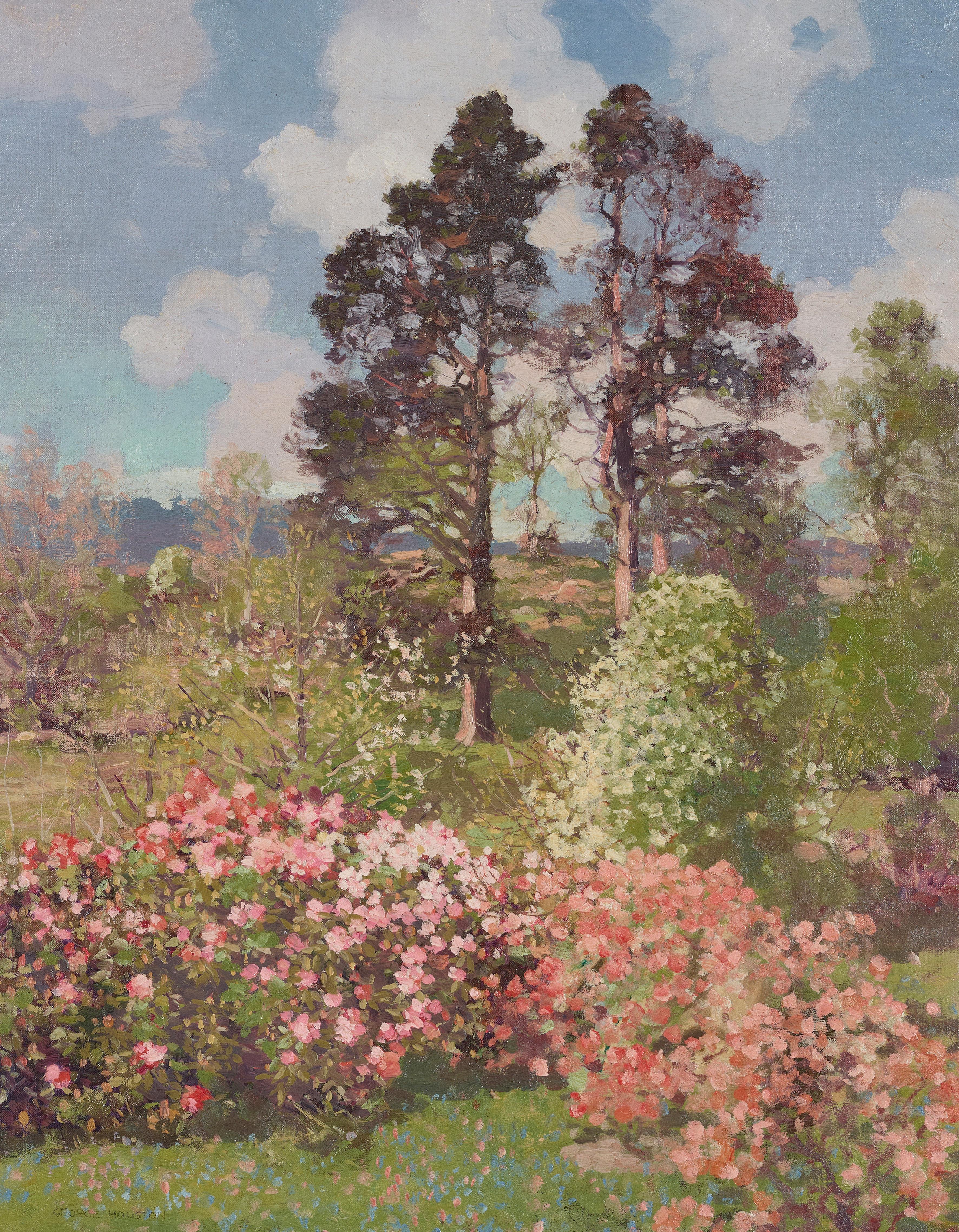

LONDON | EDINBURGH | GLASGOW LYONANDTURNBULL.COM







 Chantal de Prez Junior Specialist chantal.deprez@lyonandturnbull.com
Charlotte Cockburn Sale Administrator charlotte.cockburn@lyonandturnbull.com
Alice Strang Senior Specialist alice.strang@lyonandturnbull.com
Carly Shearer Specialist carly.shearer@lyonandturnbull.com
Chantal de Prez Junior Specialist chantal.deprez@lyonandturnbull.com
Charlotte Cockburn Sale Administrator charlotte.cockburn@lyonandturnbull.com
Alice Strang Senior Specialist alice.strang@lyonandturnbull.com
Carly Shearer Specialist carly.shearer@lyonandturnbull.com














































































 Signed, oil on canvas
61cm x 76cm (24in x 30in)
Signed, oil on canvas
61cm x 76cm (24in x 30in)





 73
74
73
74
















































































 123 § HENRY YOUNG ALISON (SCOTTISH 1889-1972)
THE BLUE HEADDRESS Signed, oil on canvas 76cm x 63.5cm (30in x 25in)
124 † ROBERT GAVIN R.S.A. (SCOTTISH 1827-1883)
With the Artist’s Trustees stamp verso, oil on canvas 61cm x 46cm (24in x 18in)
123 § HENRY YOUNG ALISON (SCOTTISH 1889-1972)
THE BLUE HEADDRESS Signed, oil on canvas 76cm x 63.5cm (30in x 25in)
124 † ROBERT GAVIN R.S.A. (SCOTTISH 1827-1883)
With the Artist’s Trustees stamp verso, oil on canvas 61cm x 46cm (24in x 18in)































































 161 §
161 §





































 DENIS MITCHELL (BRITISH 1912-1993) PROBUS, 1971
DENIS MITCHELL (BRITISH 1912-1993) PROBUS, 1971
